
©S-F/Shutterstock

Northern Ireland
An exploding food scene, hip cities and the stunning Causeway Coast: there's plenty to pull visitors to the North. When you cross from the Republic into Northern Ireland you'll notice a couple of changes: the road signs are in miles and the prices are in pounds sterling – you're in the UK. At the time of research, there was no border checkpoint and not even a sign to mark the crossing point.
Best Things to Do
Attractions, must-see attractions.
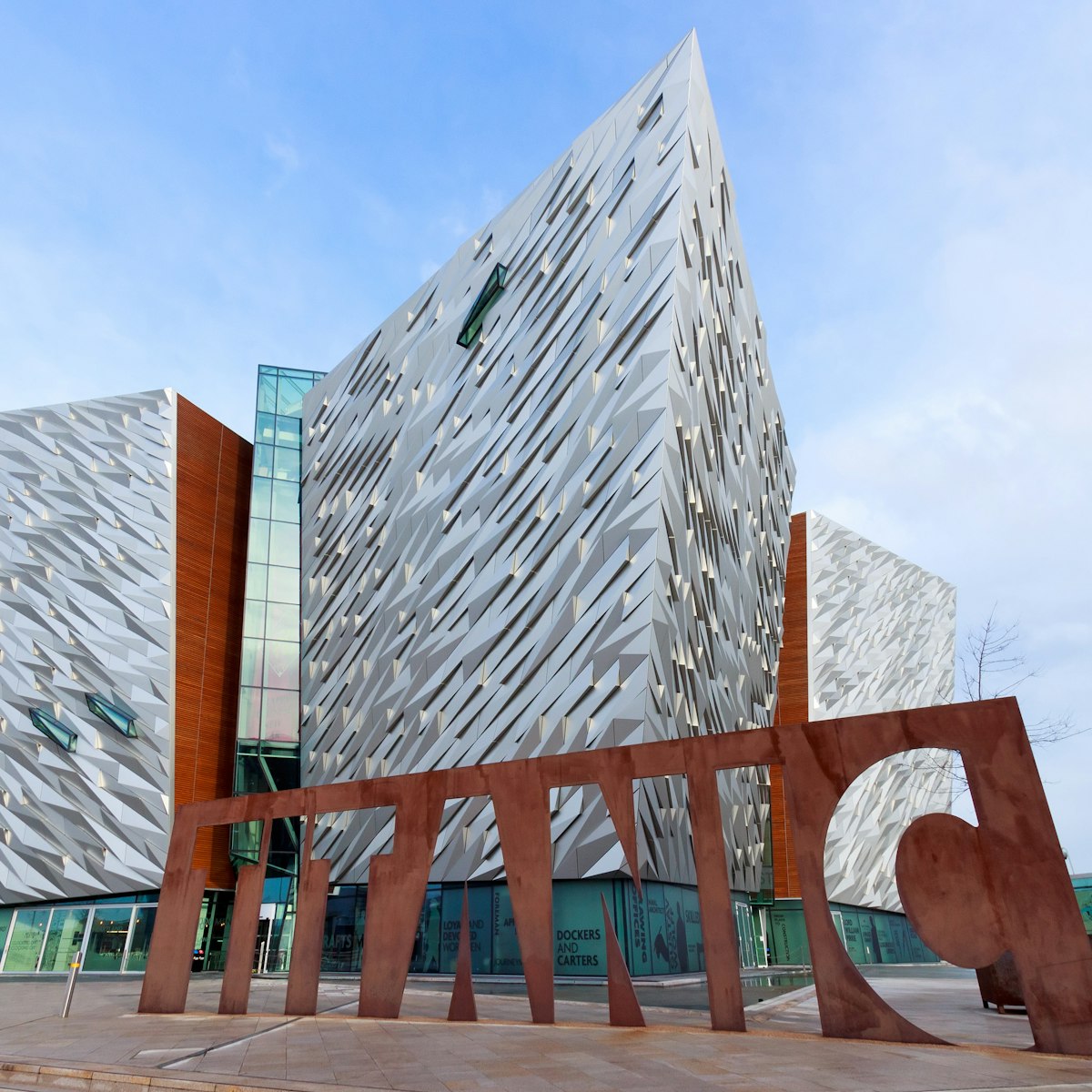
Titanic Belfast
The stunning, star-shaped Titanic Belfast is the city's number-one tourist draw. Standing majestically at the head of the slipway where the Titanic was…
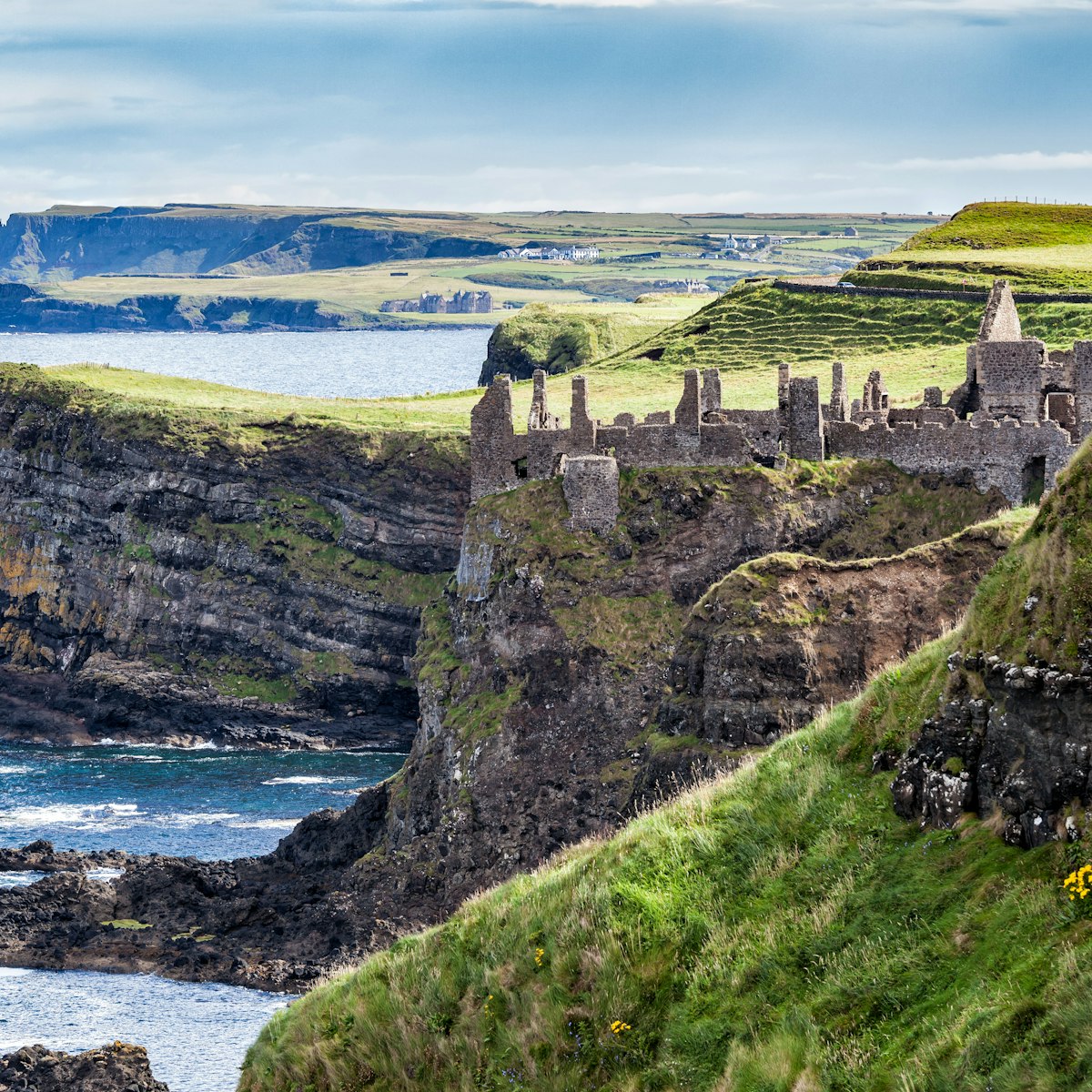
Dunluce Castle
This medieval castle ruin is perched on top of a dramatic cliffside overlooking the glorious Causeway Coast.
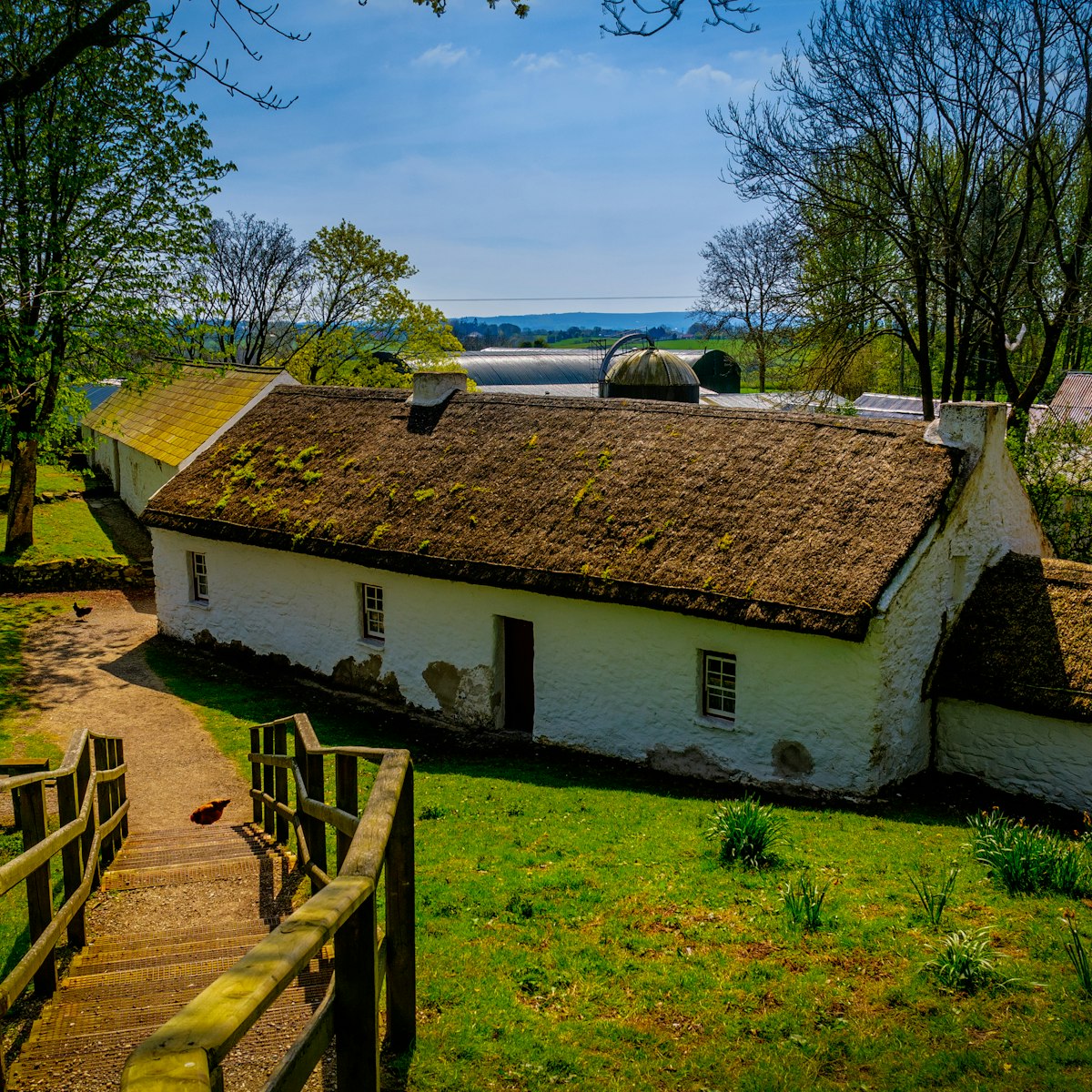
Ulster American Folk Park
Counties Fermanagh & Tyrone
In the 18th and 19th centuries more than two million Ulster people left their homes to forge a new life across the Atlantic. Their story is told here at…
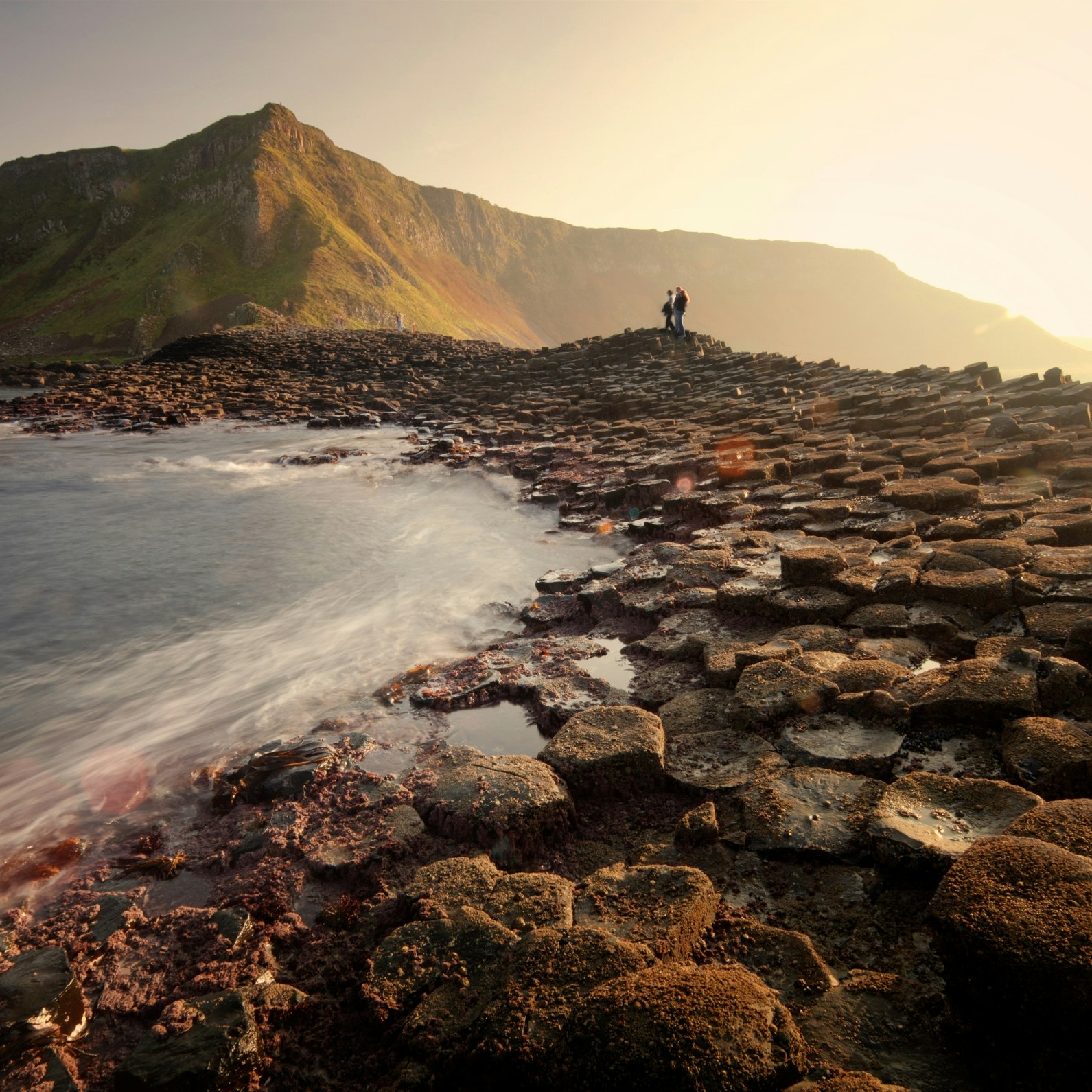
Giant’s Causeway
County Antrim
This spectacular rock formation – Northern Ireland's only Unesco World Heritage site – is one of Ireland's most impressive and atmospheric landscape…
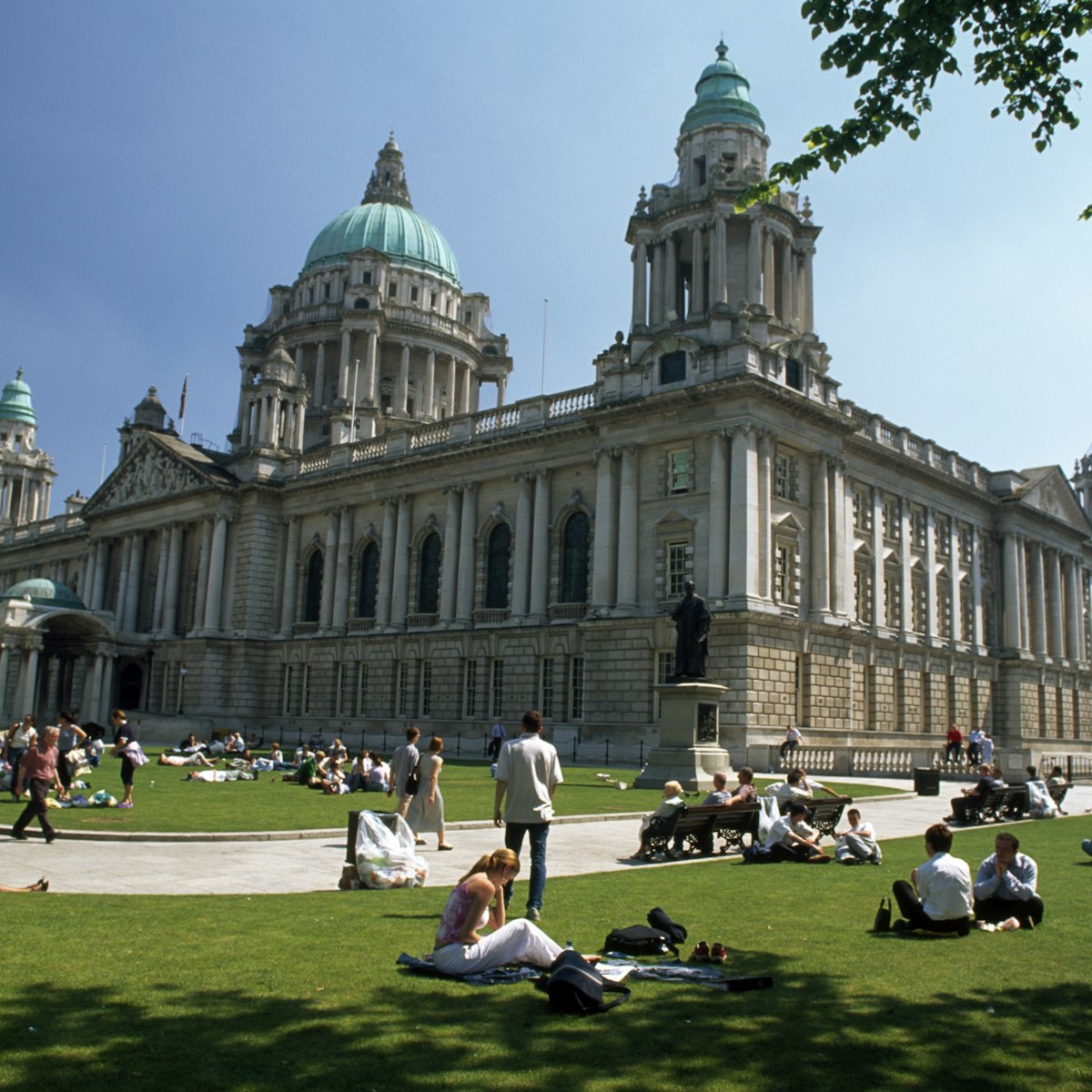
Belfast's classical Renaissance-style City Hall was built in fine, white Portland stone in 1906. Highlights of the free, 45-minute guided tour include the…
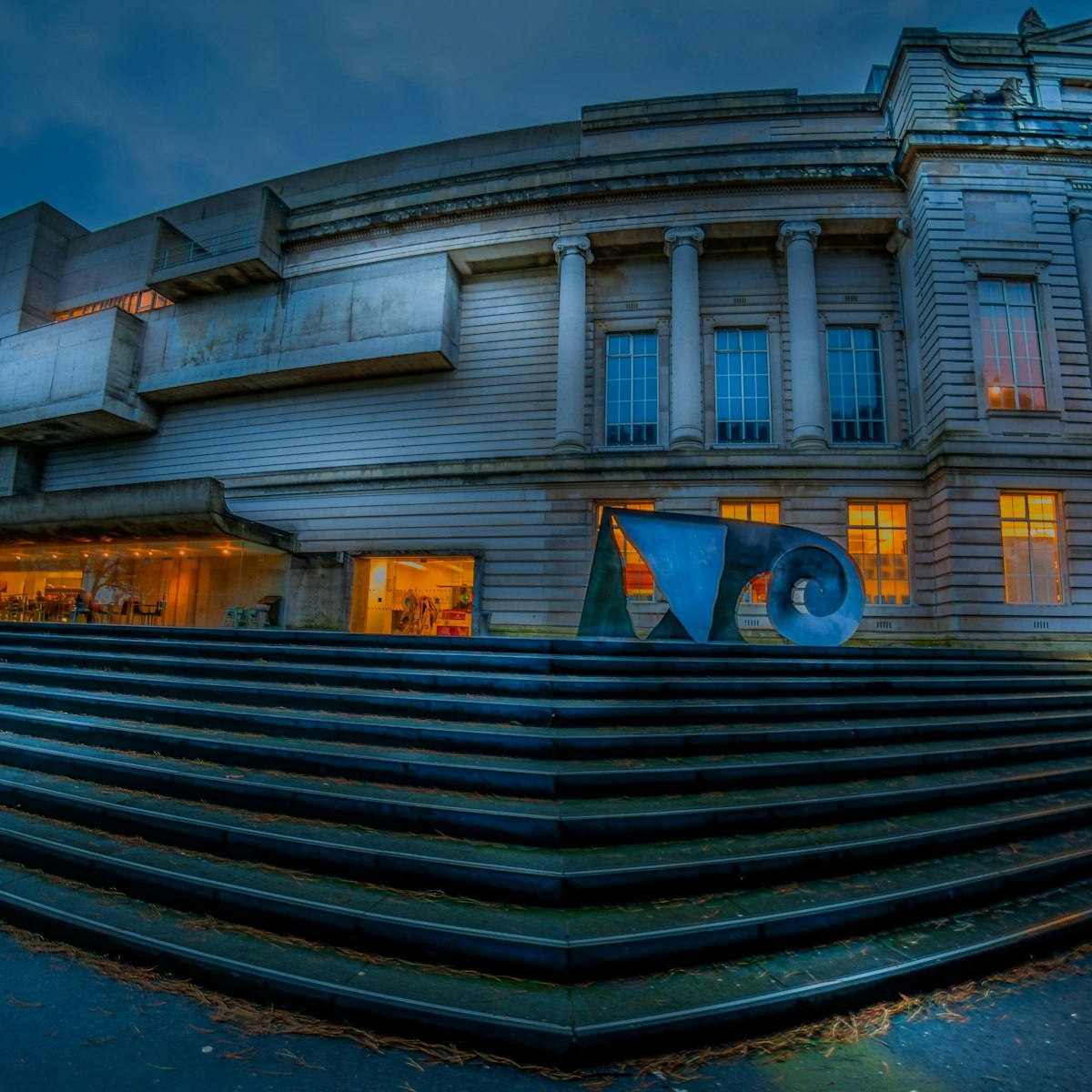
Ulster Museum
You could spend hours browsing this state-of-the-art museum, but if you're pressed for time don't miss the Armada Room, with artefacts retrieved from the…
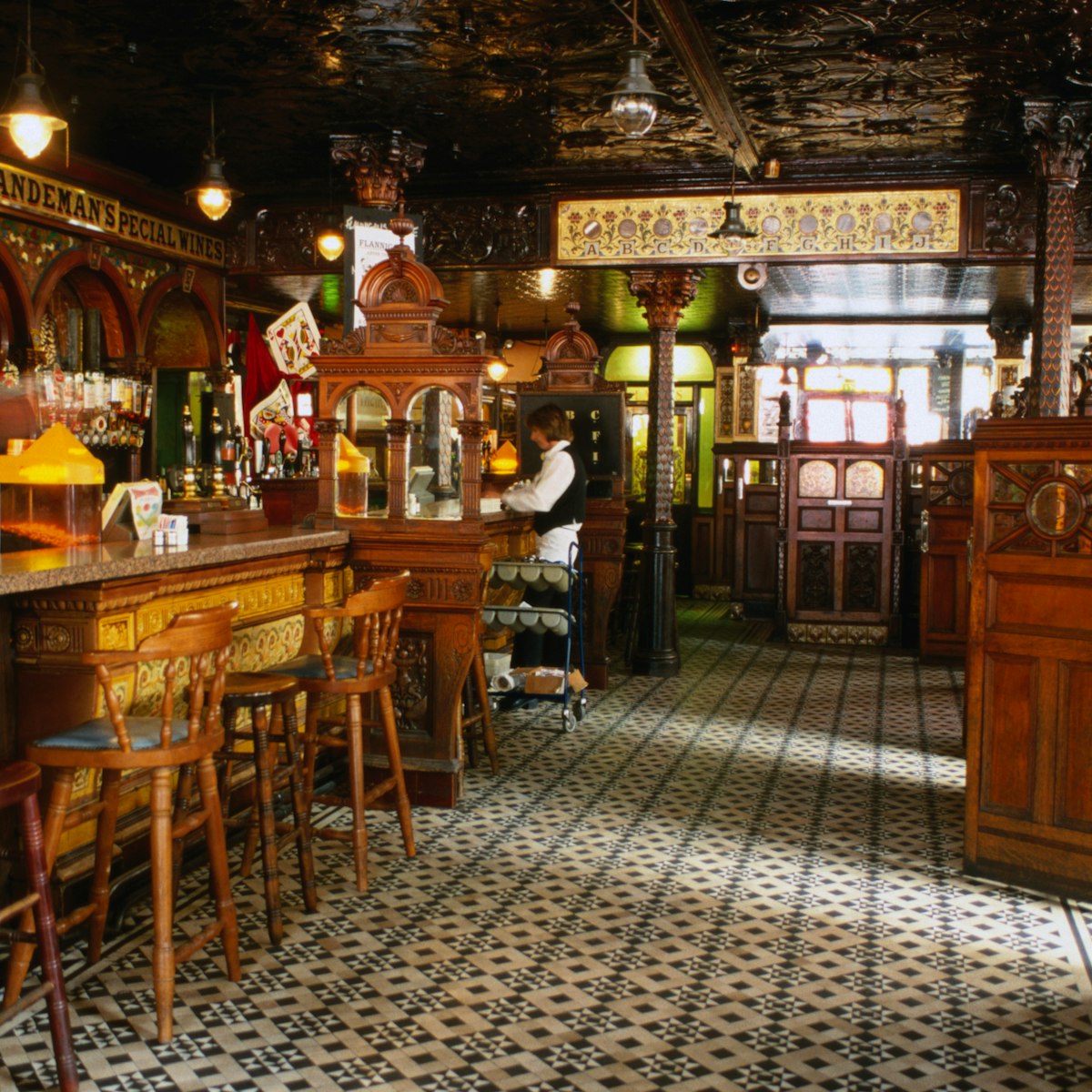
Crown Liquor Saloon
There are not many historical monuments that you can enjoy while savouring a pint of Guinness, but the National Trust's Crown Liquor Saloon is one of them…
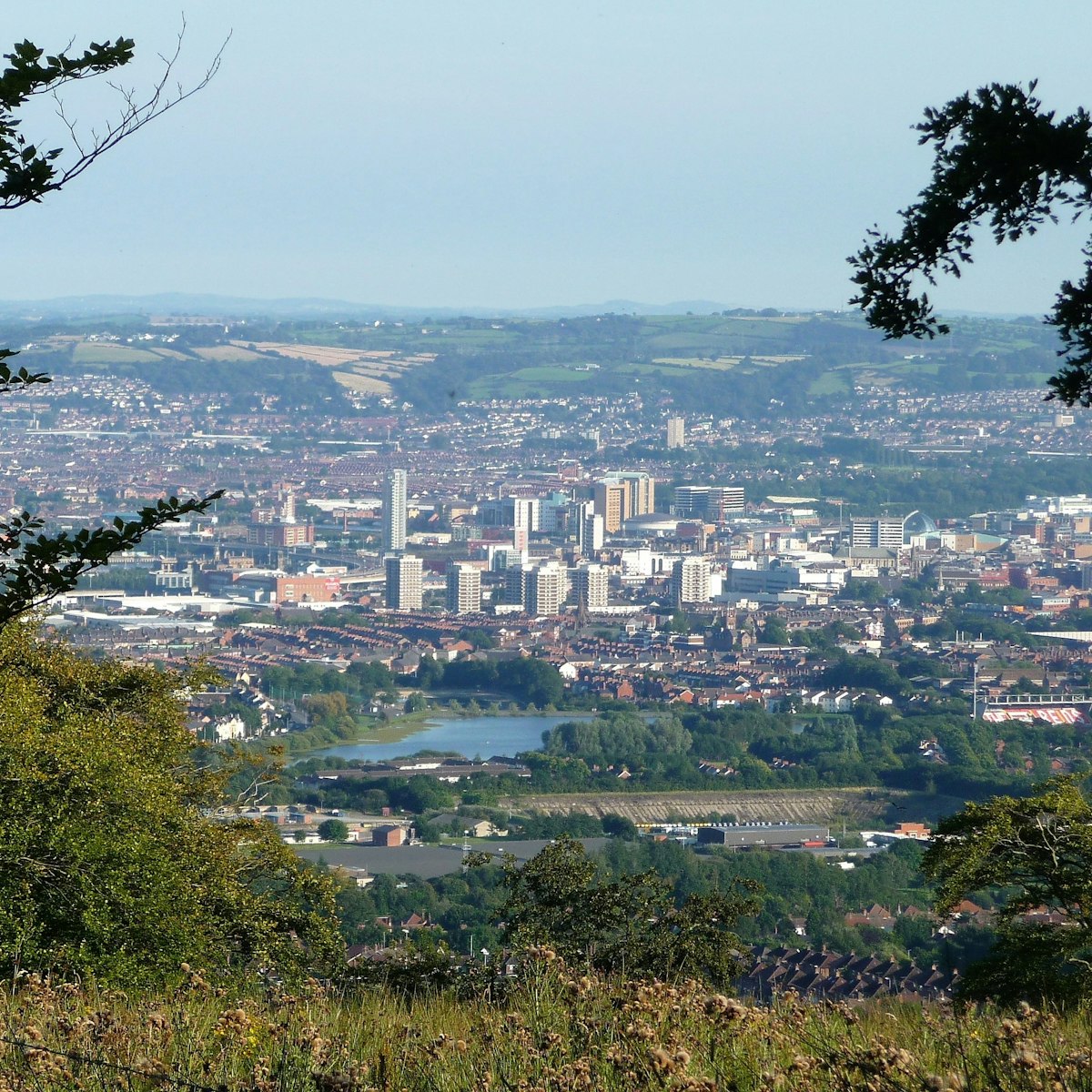
Cave Hill Country Park
The view from the summit of Cave Hill (368m) takes in the whole sprawl of the city, the docks, Belfast Lough and the Mourne Mountains – on a clear day you…
Top picks from our travel experts
10 top things to do in mythical northern ireland.

Dark Hedges
Planted by the Stuart family in the 18th century as the formal entrance to their property, these shadowy, gnarled, entwined beech trees are now among…

Glenarm Castle & Walled Garden
Glens of Antrim
Since 1750, Glenarm has been the family seat of the McDonnell family, earls of Antrim; it's currently the home of Lord and Lady Dunluce. The castle itself…

People's Gallery Murals
Derry (Londonderry)
The 12 murals that decorate the gable ends of houses along Rossville St, near Free Derry Corner, are popularly referred to as the People's Gallery. They…

Castlewellan Forest Park
County Down
Castlewellan Forest Park offers gentle walks around the castle grounds, one of the world's largest hedge mazes, the Peace Maze (entry free), and, from…

Free Derry Corner
The Free Derry Corner, where the gable end of a house painted with the famous slogan 'You are Now Entering Free Derry' still stands, is all that remains…

Old Bushmills Distillery
Bushmills is the world's oldest licensed distillery, having been given permission to produce whiskey by King James I in 1608. The whiskey is made with…

Bloody Sunday Memorial
A simple granite obelisk that commemorates the 14 civilians who were shot dead by the British Army on Bloody Sunday, 30 January 1972.

Carrickfergus Castle
The central keep of Ireland's first and finest Norman fortress was built by John de Courcy soon after his 1177 invasion of Ulster. The massive walls of…
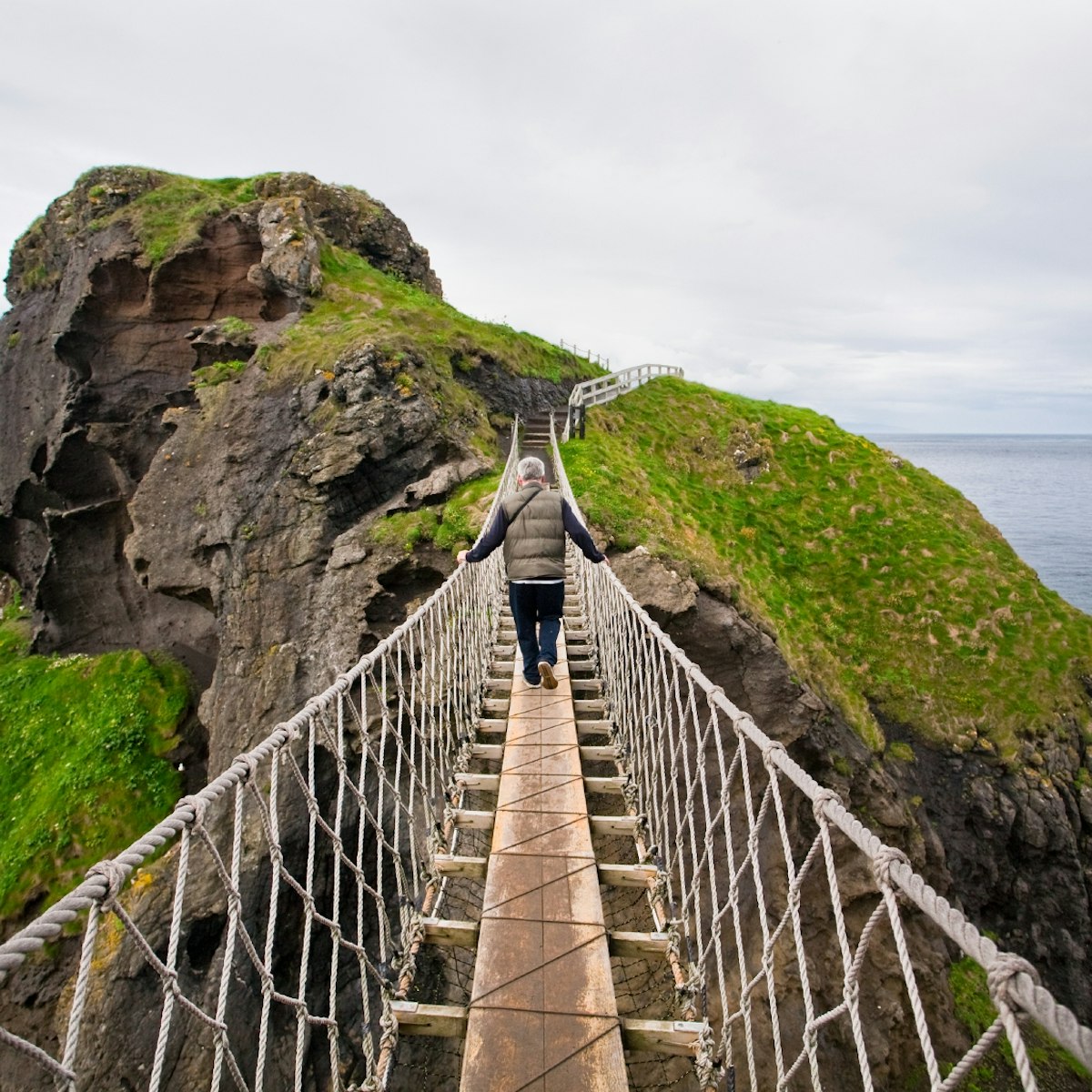
Carrick-a-Rede Rope Bridge
This 20m-long, 1m-wide bridge of wire rope spans the chasm between the sea cliffs and the little island of Carrick-a-Rede, swaying 30m above the rock…
Plan with a local
Experience the real Ireland
Let a local expert craft your dream trip.

Latest stories from Northern Ireland
Filter by interest:
- All Interests
- Adventure Travel
- Art & Culture
- Beaches, Coasts & Islands
- Food & Drink
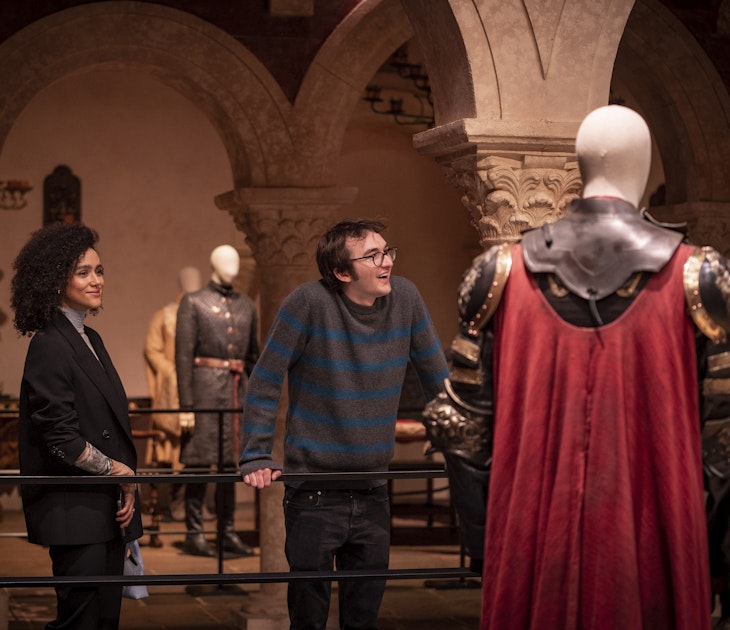
Feb 7, 2022 • 1 min read
Game of Thrones fans can continue to experience the Seven Kingdoms as a new HBO-backed Game of Thrones Studio Tour opens in Northern Ireland
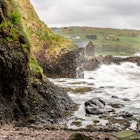
Sep 23, 2021 • 6 min read

Dec 10, 2020 • 2 min read
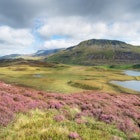
Aug 14, 2020 • 4 min read
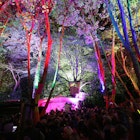
Jul 13, 2020 • 2 min read

Oct 25, 2019 • 2 min read
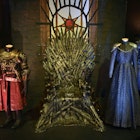
May 17, 2019 • 3 min read

May 16, 2019 • 6 min read

Apr 18, 2018 • 5 min read
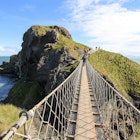
Oct 30, 2017 • 4 min read
in partnership with getyourguide
Book popular activities in Northern Ireland
Northern ireland and beyond.
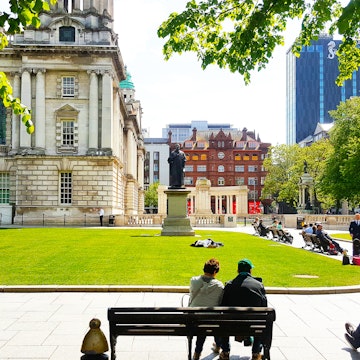

Northern Ireland Travel Guide
Your ultimate northern ireland travel guide, with tips, and things to see and things to do in northern ireland. great for first-time and returning travelers..
Founded in 1921, Northern Ireland is separate from Ireland itself and is part of the United Kingdom.
It has a population of 1.8 million. Northern Ireland is known for its beautiful forests, mountains, coasts, cliffs, and friendly locals.
In recent years, the stunning scenery has been featured in the popular HBO show Game of Thrones .
Northern Ireland is a perfect getaway for fans of the outdoors.
This Northern Ireland travel guide will help you plan your next vacation.
Popular Guides
- Things to Do in Northern Ireland
- the Giant’s Causeway
Our Highlight
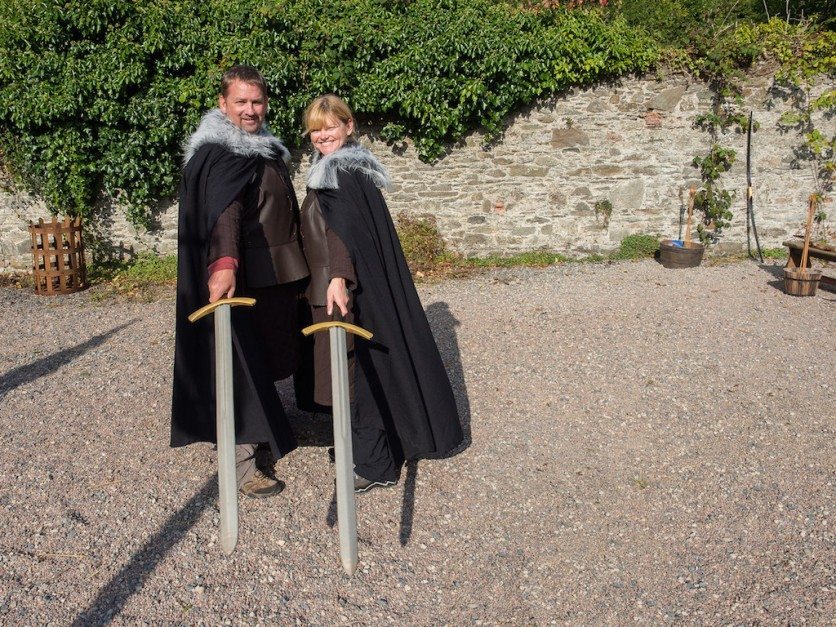
Table of contents
Table of Contents
Fast Facts about Northern Ireland
- Northern Ireland’s Power voltage is 230V at 50 Hz.
- Northern Ireland’s currency is the pound sterling and 1 pound sterling is equal to 1.25 USD.
- Renting a car is considered the best way to get around Northern Ireland, especially for those who want to visit more remote locations. All that is required is a valid US passport, be at least 21 years of age, and have had a driver’s license for at least one year prior to your trip.
- You do not need a visa to visit.
- The most popular cellular networks in North Ireland are EE, 02, and Three. Sim cards can be purchased through these networks.
- Value-added tax (VAT) comes at 23%. Tax reductions for common goods, like food, hotels, and public transportation, bring the rate down to 9%. To learn more, click here: VAT_NorthernIreland
Things to See and Do in Northern Ireland
- Speed Boat tour of Castle Ward: ride out to the tidal pools to see Europe’s highest tides. They harnessing the tidal water for hydroelectric power and you ride out to the foamy pools to ride the waves. What a thrill!
- Titanic Belfast: The world’s largest Titanic exhibit. See real-life artifacts from the Titanic, learn about the history of the ship, walk through recreated decks and cabins, get something from the souvenir shop, take a guided boat tour of the Belfast port, or choose from multiple interactive galleries. Afterward, stay for some tea and treats at the café.
- Game of Thrones Territory : Fans of the popular Game of Thrones TV show will love this trip through the show’s famous filming locations. See the real-world Westeros and explore the beautiful forests, beaches, and caves that helped make the show what it is. Choose your favorite spots from the show or take the full three-day trip.
- Check out Giant’s Causeway – whether you believe the scientific explanation or the legend of Fin McCool and the Giants Causeway, the sight of 40,000 or so pillars should not be missed.
- Visit the most photographed location in Northern Ireland – Lined with the twisted branches of beech trees which form an arch over the road, the Dark Hedges make a spectacular background for some epic photography sessions.
Northern Ireland Travel Guides
- The Dark Hedges of Northern Ireland – Tips to Visit and What you Need to Know
- 27 Best Things to Do in Northern Ireland
- The Legend of the Giant’s Causeway – Do You Believe?
Accommodation
Budget: Northern Ireland offers many hostels in the range of 20 to 40 pounds per night, depending on where you go which may include shared bathrooms.
Mid-Range: For mid-range hotels, expect to pay around 80-120 pounds each night. Northern Ireland has a variety of bed and breakfasts to choose from.
High-End: Upscale B&Bs and hotels will cost around 150 to 200 pounds per night.
Check out our favorite booking platforms Booking.com , Tripadvisor and VRBO for the best deals on accommodation.
Food: There are a variety of bars and restaurants in Northern Ireland. Ulster Fry (fried soda bread with eggs, sausage, bacon, and potatoes) is the most popular dish here. Expect to pay 5 pounds for breakfast and 10-20 pounds for lunch and dinner. Adding in any trips to cafes or bars, and 35 to 40 pounds per day is a good estimate for food.
The Best Ways to Get Around Northern Ireland
Getting to northern ireland:.
Getting to Northern Ireland: Belfast International Airport is just 18 miles from the city center and offers direct flights to and from North America. For those traveling to and from European countries, the Belfast City Airport is a great option and is just 3 miles from the city center.
Flights: You can check for the best flights to Northern Ireland on Skyscanner .
Transportation:
Bus: Buses are a cheap way to get around Northern Ireland. Tickets cost 2.4 pounds one way. For those who want to do more traveling, consider getting an all-day pass for 9 pounds (4.5 for children) or take the Rambler Bus Service to get closer to scenic routes.
Train: Translink is the main transportation system in Northern Ireland and has many places you can go. For example, travel from Belfast to Londonderry in 2 hours for just 13 pounds.
Renting a car: To rent a car in North Ireland, you must be 21 years old. Prices for car rentals start at 75 pounds per day. You can also compare prices here
When to go To Northern Ireland
June through September is the best time to visit Northern Ireland.
Although, we visited once in April and it was lovely weather.
The temperature is warmest during these months (an average of 60-65 degrees Fahrenheit), which makes it great for exploring the outdoors.
June is a good month to go if you want to avoid some of the crowds before the tourism peak occurs in July and August.
Where to Stay in Northern Ireland
Malmaison Belfast: This elegant four-star hotel is just minutes away from the motorway, Victoria Square Shopping Centre, and famous St. Anne’s Cathedral. Malmaison includes 24-hour room service, a gym, free Wi-Fi, and same-day laundry service.
City Hotel Derry: Just a mile from the Londonderry train station and minutes from the shopping center, this four-star hotel specializes in a “home away from home” feel. The hotel’s restaurant and bar, health club, free Wi-Fi, iPod docking stations, and indoor pool are included.
Dunadry Hotel : Located just 4.5 miles from the Antrim train station, this former mill house-turned four-star hotel and spa is perfect for those exploring Antrim. The hotel has stylish rooms, views of the riverside, and its own elegant restaurant, bar, heated indoor pool, gardens, and courtyard, as well as various other amenities.
What to Pack for Northern Ireland
- Layers: As Northern Ireland’s weather can be hard to predict, layers will help keep you comfortable wherever you go.
- Waterproof clothes/shoes: With so many hiking destinations, these are a must to keep your feet and clothes dry.
- Travel Backpack: With so many things to see in Northern Ireland, a travel backpack will store all your belongings comfortably without straining your back.
See our packing tips: packing tips
Northern Ireland Travel Guide: Best Booking Resources
Whenever we travel to we make sure to start with these companies. We have tried a lot of different ones over the years and all of these have consistently proven to be the best when it comes to offering great prices.
We have used every one of these personally and continue to do so.
- Booking.com : This is our go site to when comparing prices for accommodation. It usually has the cheapest prices, especially in Europe and we love their interface. Not to mention you get free cancellation and you are guaranteed the best price.
- Trip Advisor : What we like about Trip Advisor is that we can look at all the reviews and then book our accommodation. TripAdvisor is where we go when we want to compare prices with multiple accommodation providers.
- VRBO : is the main search engine we use when we are looking for a home or apartment rental. It can sometimes be cheaper than hotels and it is the best way to stay in areas that offer a more local feel.
- Hostelworld : With one of the largest databases of hostels in the world, Hostelworld is the go-to site when you are looking for budget accommodation.
- Skyscanner : This is the first place we check for flights. It consistently comes back with the cheapest and best options. It allows us to compare a lot of airlines to get the best price.
- Rome 2 Rio : If you want to see how to get somewhere by plane, train, bus, ferry or car Rome2Rio lays it all out for you as well as related costs.I love how they show it all to you on a Google Map and it works offline.
- Get Your Guide: For all your day trip and city guide needs, we use Get Your Guide. It has the world’s largest collection of things to do with more than 30,000 activities in 7500 destinations.
- World Nomads Insurance: When traveling to Italy you should always have travel insurance. We have found the best bang for your buck is by far World Nomads.
Northern Ireland Travel Guide: Related Articles
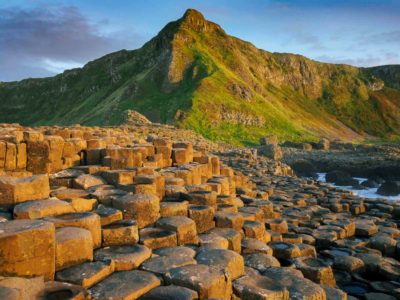
How To Visit the Giant’s Causeway in Northern Ireland
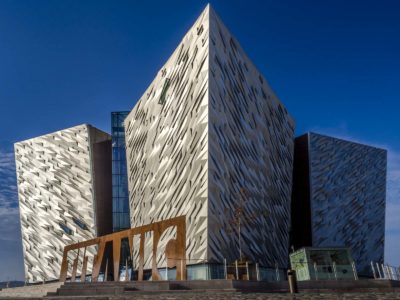
38 Best Things to Do in Belfast, Northern Ireland
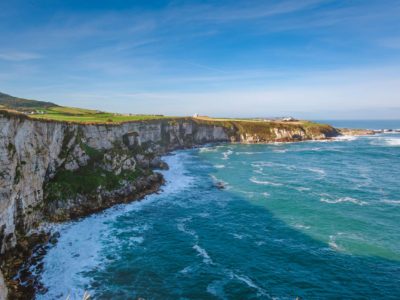
The Ultimate Causeway Coastal Route Itinerary, Northern Ireland
Things to Do in Belfast
Best Museums
Coolest Murals to See
Food to Try
Top Restaurants
Best Time to Visit
Weather & Climate
Belfast International Airport Guide
Public Transportation
Safety in Northern Ireland
48-Hour Itinerary
One Week in Northern Ireland
Touring Northern Ireland in a Week
:max_bytes(150000):strip_icc():format(webp)/reflectivemood-56a3c66b5f9b58b7d0d3ad64.png)
Feifei Cui-Paoluzzo / Getty Images
Northern Ireland has a turbulent political history and incredibly beautiful scenery. So beautiful, in fact, that there are several "Game of Thrones" filming locations across the region. Whether you want to see what Belfast has to offer, or if you're interested in gorgeous views, Northern Ireland delivers.
If you only have a week to explore the best of Northern Ireland, fear not. This complete itinerary will guide you around the area with suggestions for where to go and what to do.
Day 1 - Arriving in Belfast
The best way to arrive in Northern Ireland for your week-long vacation is to fly directly into Belfast International Airport . Most flights arrive during the day, meaning you will have enough time to pick up your rental car and make your way to Northern Ireland's capital city, Belfast . The airport is actually located near Lough Neagh and you should expect at least 30 minutes drive to the city. Have a look around the city center and maybe enjoy a drink in style at the historic Crown Liquor Saloon. Plan for an early night in order to rest up for the true Irish vacation to come.
Day 2 - Drive the Coast Road to the Giant's Causeway
Marco Bottigelli / Getty Images
Start early from Belfast and take the winding coastal road up north. You will soon reach Carrickfergus with its magnificent medieval castle. Carry on northwards via Larne, following the A2 to Bushmills and the Giant's Causeway , one of Ireland's most important sights . When you arrive it is time to stretch your legs. You have the option to take the Cliff Walk and enjoy the view of the Causeway and (if you are lucky) the Scottish coast to the Northwest. Or stroll down to the Causeway proper, a bus will take you back up again to the visitor center if you can't face the steep road back up or (even worse) the hundreds of steps up to the Cliff Walk. If you have some time drive to the Old Bushmills Distillery, tours are offered every day. Spend the night in or near Bushmills in a B&B or book ahead to stay at the classic Causeway Hotel, overlooking the 40,000 basalt columns that make up this must-see natural wonder.
Day 3 - Tour the Antrim Coast to Derry
The next day, leave the village of Bushmills and take the coastal road westwards, staying on the A2 all the time. You will soon pass Carrick-a-Rede with its incredible rope bridge, Dunluce Castle, the famous white rocks, some pretty seaside resorts, and the huge Downhill Estate with its precariously located Mussenden Temple (" Game of Thrones " fans take note—this was one of the Irish filming locations). With only a week to see Northern Ireland, keep driving on to Derry and have a walk on Derry City's historic walls . An overnight stay in or near Derry will give you an opportunity to recover.
Day 4 - Down to Omagh and Enniskillen
Alain Le Garsmeur / Getty Images
Midway through your one week in Northern Ireland, take the road south via Strabane, the A5 will bring you to Omagh. Here you can visit the quirky Ulster American Folk Park with its Irish and American homesteads and the truly impressive recreation of an emigrant ship. Then take the N32 to Enniskillen and enjoy the Lough Erne scenery, maybe taking in a boat trip to Devenish Island as well. Enniskillen usually has some lively evening entertainment in the pubs, making it a good place for an overnight stay.
Day 5 - Via Armagh to Belfast
Shaun Egan / Getty Images
With a few days left to finish your road trip tour of Northern Ireland, you might decide to visit the Marble Arch Caves or Florence Court in the morning or drive straight on. Take the N34 south and cross the border into the Republic of Ireland. A look at the round tower in Clones and at the market town of Monaghan are a good idea—as is stocking up on petrol for the lower price. From Monaghan take the N12/A3 to Armagh, the "Cathedral City". After visiting one (or indeed both) cathedrals hit the A3 and then the M1 to bring you back to Belfast. Note that the next day is optional depending on your schedule—you might want to take the A26 straight to Belfast International Airport and stay nearby if you are short on vacation time.
Day 6 - Belfast
Reading Tom / Flickr / CC BY 2.0
Unless you are already flying out today you should take a closer look at the City of Belfast and its attractions—including the celebrated Titanic museum . Or drive out to Holywood and visit the huge Ulster Folk and Transport Museum , stepping back in time. In the evening drive out towards Belfast International Airport and stay nearby to save yourself the trouble of having to make the traffic-prone drive the next day.
Day 7 - Flying Home
cuppyuppycake / Getty Images
Seven days in Ireland go too quickly! Today you will be heading back on a flight out of Belfast International Airport—have a last look at the huge Lough Neagh when taking off, with a little luck and a bit of sunny weather, you might also get splendid views of the Irish coastline, any which direction you are going!
Your Trip to Ireland: The Complete Guide
A Guide to Airports in Ireland
The 7 Best Day Trips from Belfast
The Top 10 Things to Do in County Antrim
Ireland's 20 Largest Towns and Cities
The Complete Guide to the Giant's Causeway
The 16 Most Beautiful Natural Features in the UK
Dunluce Castle: The Complete Guide
Getting Around Belfast: Guide to Public Transportation
Carrick-a-Rede: Ireland's Exhilarating Rope Bridge
The Top 20 Places to See in Ireland
10 Questions to Ask Yourself Before You Plan Your UK Trip
Belfast Guide: Planning Your Trip
Northern Ireland's Mourne Mountains: The Complete Guide
The Top 22 Things to Do in Ireland
Northern Ireland

- 2 Cities and towns
- 3 Other destinations
- 4.1 History
- 4.3 Politics
- 4.4 Climate
- 6.1 Immigration, visa, and customs requirements
- 6.2 By plane
- 6.3 By train
- 6.6 By boat
- 7.2 By bus and train
- 7.3 By bicycle
- 13 Stay safe
- 14 Stay healthy
- 16.1 Other social issues
Northern Ireland ( Irish : Tuaisceart na hÉireann , Ulster Scots: Norlin Airlann ) is part of the island of Ireland and one of the four constituent nations of the United Kingdom .
Northern Ireland has the Giant's Causeway (a world heritage site), stunning landscapes, vibrant cities, and welcoming locals interested in your own stories. The hit television series Game of Thrones was produced in Northern Ireland, which is also home to many of its filming locations.
Discover Northern Ireland is the tourist bureau.

These counties are no longer units of government in Northern Ireland, but continue to have strong local identities and to cohere as travel destinations. They're regularly abbreviated as "Co." for instance "Co. Down" is County Down.
Cities and towns
- 54.597 -5.93 1 Belfast is the capital and largest city of Northern Ireland, with the major transport hubs and the best visitor facilities. West Belfast was torn by over 30 years of paramilitary and British Military conflict, which its sights reflect. The university area is cosmopolitan and houses a good regional museum. The docks have been revitalised by the Titanic Quarter, which houses a good museum about the Titanic. Dramatic views can be had from Divis and Black Mountain.
- 54.512 -6.031 2 Lisburn was the seat of Ireland's linen industry, depicted in its museum.
- 54.66 -5.67 3 Bangor is a large coastal town, was a seaside resort. Good base for the Ards Peninsula, home to the island's largest marina and good shopping.
- 54.3499 -6.6546 4 Armagh is the ecclesiastic capital of Ireland, for both the (Anglican) Church of Ireland and the Roman Catholic Church. Nearby Navan Fort is one of the most important ancient sites in Ireland. Home to many myths and legends.
- 55.133 -6.661 5 Coleraine on the River Bann in County Londonderry, 5 km from the sea, it has an impressive history dating back to Ireland’s earliest known settlers. Coleraine today is a major gateway to the popular Causeway Coast area. Coleraine is a good shopping town and also has a major performance theatre at the University of Ulster in the town.
- 54.9958 -7.3074 6 Derry, or Londonderry ( Doire Cholmcille , "the Maiden City"), gateway to Donegal. Vibrant cultural life, intact city walls and the city where the Troubles started.
- 54.345 -7.64 7 Enniskillen is the picturesque main town of County Fermanagh, perfect for exploring the lakes around Lough Erne.
- 54.176 -6.349 8 Newry is a town that is a popular destination for shopping. Nearby is Slieve Gullion, the beautiful Mourne mountains and the attractive villages of Rostrevor and Warrenpoint. They somehow mislaid their entire castle in the back-end of a bakery.
- 54.598 -7.309 9 Omagh home to the very good Ulster American Folk Park, an outdoor museum of the story of emigration from Ulster to America in the 18th and 19th centuries.
Other destinations

- 55.24 -6.51 1 Causeway Coast in County Antrim has remarkable scenery, with the cascade of basalt columns at Giant's Causeway , the windswept bridge of Carrick-a-Rede, the Antrim glens, Dark Hedges, and wacky Gobbins. Bushmills is a venerable whiskey distillery, and there are crumbling castles, long sandy beaches and championship golf courses.
- 55.295 -6.1975 2 Rathlin Island is Northern Ireland's only inhabited offshore island, reached by a short ferry ride.
- 54.166667 -6.083333 3 Mourne Mountains are criss-crossed by tracks past woodland up to the peaks: Slieve Donard at 852 m / 2796 ft is the highest in Northern Ireland.
Northern Ireland was created in 1921 when Ireland was partitioned by the Treaty that ended the Anglo-Irish war. Most of the island became what was initially called Southern Ireland then the Irish Free State and is now the independent Republic of Ireland or Eire . But six of the nine historic counties of Ulster remained within the United Kingdom as Northern Ireland, with the other three joining the south, and the plate tectonics of this rift are still in motion. "Ulster" is thus a geographical and cultural term, and doesn't refer to the political entity of Northern Ireland. Lots of outsiders do conflate the two, but doing so in nationalist company... well, if you're lucky, you'll just be thrown out of the pub. If you're unlucky, you'll be required to stay and listen to a history lesson that begins in the 12th century.
In the souvenir tea-towel version of Irish history, there were four provinces, Leinster, Munster, Connacht and Ulster, with a High King presiding over all. In reality in the early medieval period there were about a dozen kingdoms, forever warring and recognising no overlords. The northwest was O'Neill territory, while the northeast (now Antrim) was Ulaid hence "Ulster". From the 12th century the Normans settled in southeast Ireland but never got this far. Right up to the 17th century, Gaelic nobles ruled over Donegal, Derry and Tyrone. Then the English Tudors subdued this last redoubt and began to re-shape Ulster to their liking.
They did this by "plantations" - colonisation by settlers from Great Britain, with new towns laid out and industries such as linen, and modern methods of agriculture that needed fewer hands and displaced people from the land. This had long gone on the south, the difference with the Ulster plantations was that Great Britain was now predominantly Protestant, and especially the Scottish incomers. Rural Ireland was Roman Catholic, a religion ghettoised by the Penal Laws, so sectarian tensions were added to grievances over landholding, wealth and economic opportunity. Incomers and industry were strongest in the east, so Belfast grew into a metal-bashing second Glasgow, while the rural west was little developed and impoverished even before the famine years. A cultural crack developed across Ulster, especially visible in the city that one faction called Derry and the other Londonderry.
The 19th century campaign for Irish independence escalated into "The Troubles", which by 1920 entailed guerrilla warfare by the nationalists and savage reprisals by the British. This was resolved by the Treaty, which gave Ireland a grudging partial independence, but at the price of partition. "No surrender!" - no way would the Unionists of the north consent to be ruled from Dublin, which they feared would impose a priest-ridden, backward and anti-Protestant regime. So six counties remained in the UK, while the other three Ulster counties - Monaghan, Cavan and Donegal - joined the south, as they were Catholic and nationalist to a degree that no amount of gerrymandering could overcome.
Nationalist resentment festered but the late 20th century "Troubles" were stoked by economic downturn and blatant discrimination in Northern Ireland, and the new dynamic of civil rights. Police and army deployed "to separate warring communities" were clearly acting for only one side, and became targets for violence themselves. The flashpoint was on "Bloody Sunday" in Derry in 1972, when the army opened fire on an unarmed demonstration, killing 14. British rule lost its legitimacy, the republican or nationalist cause was strengthened, and both communities waged para-military or terrorist campaigns as there was nothing to be gained from conventional politics. The death toll during these years is reckoned at 3532: roughly 1840 civilians, 1050 police and soldiers, 370 Republican paramilitaries and 160 Loyalist paramilitaries. Perhaps 47,500 were injured.
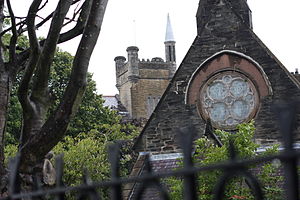
A series of short-lived political processes and peace accords came and went with no break in the violence; Belfast and Derry were scarred, with smoke rising, police patrolling in armoured cars, and army helicopters throp-thropping low. The "Good Friday Agreement" of 1998 also looked doomed when it was followed by the terrible Omagh bombing - yet after 20 years, this one has stuck. Violence dwindled, business and normal life returned, and Northern Ireland was able to re-launch itself as a tourist destination. Traffic nowadays criss-crosses from the Republic signalled only by a switch in road signs between km and miles per hour on the speed limits.
The GFA has held up for much the same reasons as the post-war French-German pact, which grew into the European Union - and that parallel is the present concern. "Don't mention the border", put both sides in each other's pockets, share power and let bygones be bygones, was the deal. But Brexit means that the Republic is now in the EU while Northern Ireland has left it - what the hell happens now? Nevertheless, the Brexit agreement has preserved the open border between Northern Ireland and the Republic of Ireland, and British and Irish citizens continue to have right of abode in each other's countries.
Most people visiting have heard of the varying allegiances of Northern Ireland's people. However, the people of Northern Ireland are friendly and warm towards visitors. You get the feeling that the people know the allegiances of each other, but it can be hard for visitors to ascertain.
Citizens can self-identify as Irish or British solely or Northern Irish. Similar divides exist in referring to places, for example the small city in the north west of the region on the banks of the River Foyle is Derry to Nationalists, while to Unionists it is Londonderry . Although Northern Irish people are British citizens from birth, they have the right to claim Irish citizenship and so may have an Irish passport in addition to or instead of a British passport.

Northern Ireland has its own devolved legislature separate from Westminster, officially known as the Northern Ireland Assembly , but often referred to by the metonym Stormont after the estate in Belfast where its seat is located. There have traditionally been two major parties in Northern Ireland politics: the Nationalist Sinn Féin , whose policy platform is generally left-wing, and the Unionist Democratic Unionist Party (DUP) , whose policy platform is generally more right-wing. Another major party is the Alliance party, which is centrist. Some matters, such as foreign affairs and defence, continue to be under the purview of Westminster.
Like the rest of Ireland and Britain, the weather here is dominated by weather systems coming in from the Atlantic, this makes for wet and windy weather. In the west, annual rainfall is 2000mm and on the east coast it is 850mm. The sun does shine too, on the Co Down coast the annual average total of sunshine is 1450 hours. The best advice is to pack wet weather gear and footwear (unless you are content to stay indoors when those are needed) and to look regularly at weather forecasts, Met Office is a good one.

English is the official language, spoken and understood everywhere, though the rapid Ulster accent may be a struggle to follow. There are many dialect words the same as Scots, such as "aye" for yes and "wee" for small. "Crack" meaning news, gossip and merriment was likewise Scots but has taken on its Irish spelling "craic". The tell-tale word is "youse" for plural you, a feature that is common throughout the island: this is otherwise only heard in Glasgow, parts of Northern England and other communities with historic links to the island of Ireland.
Irish or Gaeilge in both its standard and Ulster dialects ( Canuint Uladh ) is enjoying a revival, but is still much rarer than in the Republic. It's a Q-Celtic language akin to Scottish and Manx Gaelic, only distantly related to English, and in 2011 6% spoke it but only 0.2% used it as their everyday tongue. For a century it was shunned in the north: an Irish-speaker was either a poor Catholic potato-digger who'd failed to take the hint and push off to Liverpool, or the sort of quarrelsome (equals terrorist-suspect) nationalist who insists that Londonderry is called Derry. Irish is still only taught in Catholic schools and there are few avenues for adult learning, but it's increasingly used on signage and for official purposes, broadcast on BBC, and belatedly valued as part of Northern Ireland's culture.
Ulster Scots is an oddity - 1% spoke it according to the 2011 Census. Like Scottish Lallans it's on the cusp between being a dialect of English, a separate language, and an academic metro invention. The UK government has made unctuous pronouncements about its cultural relevance, which may be the kiss of death for its street cred, and it shares the problem of many "traditional" languages that have 27 different words for sheep-worming but need to borrow or invent words for cars, TVs and the internet. When written (which historically it wasn't) it looks like the signage at Schiphol Airport re-imagined by Hugh MacDiarmid. It seems likely to die out with the present generation.
Foreign languages are spoken by that nice couple from Hanover you sat by in the restaurant, and that student from Paris you met at the museum: they all seemed fluent in the foreign language of English. In Northern Ireland as in Great Britain, the older generation never learned (or saw the point of learning) other languages. However, the younger generations are slowly starting to see the necessity of knowing foreign languages. French has historically been quite popular among secondary students, but Spanish and German have seen a rise in popularity as well.

Immigration, visa, and customs requirements
Northern Ireland is part of the United Kingdom, so it has exactly the same entry requirements as England, Scotland and Wales.
- Citizens of the UK and Crown Dependencies can travel to Northern Ireland without a passport and have the automatic right to reside, work and take up benefits.
- Citizens of Ireland have the same entitlement as UK citizens.
- Citizens of other European Union countries do not require a visa for short visits (e.g. holiday, family visits, business meetings) but do require a visa for work or study in the UK. See Brexit for details.
- Citizens of Iceland, Liechtenstein, Norway and Switzerland have (and will probably continue to have) the same rules as for the EU.
- Citizens of Argentina, Australia, Brazil, Canada, Israel, Japan, Mexico, New Zealand, South Korea, Taiwan, the United States and Uruguay do not require a visa for visits of less than 6 months.
- Most other countries will require a visa, which can be obtained from the nearest British Embassy, High Commission or Consulate.
- There is no passport control or border check between the Republic of Ireland and Northern Ireland. However visitors must carry any relevant documents that permit them entry to the UK, such as a passport or identity card and visa.
- The UK has a Working Holidaymaker Scheme for citizens of the Commonwealth of Nations and British dependent territories. This allows residency in the UK for up to 2 years, with limited working rights.
- There are restrictions in terms of goods one can bring from elsewhere in the UK to Northern Ireland and vice versa. Importing certain goods may incur tariffs. See the Brexit article and UK government website for more information.
For more information on these requirements, see the UK government's website .
Almost all direct flights to Northern Ireland are from UK, Western Europe and the Mediterranean. There are no flights from the Republic of Ireland, as the distances are too short.
George Best Belfast City Airport ( BHD IATA ) is 2 miles east of Belfast city centre, with flights mainly from the UK. British Airways flies from London Heathrow, KLM from Amsterdam, and as of late 2023 Lufthansa from Frankfurt. All three destinations offer excellent global connections. There's a frequent bus to the city, or you can take the free shuttle bus to Sydenham railway station, see Belfast#Get in for details.
Belfast International Airport ( BFS IATA ), also known as Aldergrove, is 20 miles west of Belfast. This has several UK connections and is the main airport for flights from Europe, mostly by EasyJet, Jet2, and Ryanair. There's a bus to Belfast city centre, and another between Lisburn and Antrim for transport elsewhere in Northern Ireland; see Belfast#Get in .
City of Derry Airport ( LDY IATA ) has Ryanair flights from Liverpool and Edinburgh, and seasonally the Med. The airport is at Eglinton five miles east of Derry , with a bus to town.
Dublin Airport ( DUB IATA ) is a good option for flights beyond Europe, eg the USA, and via the Gulf states. It's north of Dublin city on the main road north, with hourly buses to Newry and Belfast.
From Dublin Connolly station the Enterprise Train runs eight times M-Sa and five on Sunday via Drogheda, Dundalk, Newry and Portadown to Belfast Lanyon Place. It doesn't serve Great Victoria Street station which is next to the Europa main bus station.
Other trains stop at several Belfast stations:
From Derry and Portrush hourly via Coleraine, Ballymena and Antrim (for Belfast International Airport) to Lanyon Place and Great Victoria Street.
From Portadown every 30 min via Lisburn and a dozen city stations, Sydenham (for Belfast City Airport) and Bangor.
From Larne hourly via Carrickfergus to Lanyon Place and Great Victoria Street.
Buses run hourly from Dublin city and airport to Belfast Europa station, taking 2 hr 20 min. There are competing operators, which holds the price down at €20 adult single and €30 return. Cross-border buses also run from Cavan and Monaghan to Armagh, Belfast and Coleraine, and from Letterkenny to Derry. Day-trip excursions from Dublin also visit Belfast.
Citylink / Ulsterbus 923 runs 2-3 times a day from Edinburgh via Glasgow, Ayr and the Cairnryan ferry to Belfast
National Express normally runs daily from London Victoria and Manchester via Cairnryan, but as of Oct 2021 this remain suspended, and they send you to Glasgow to join the Citylink - it might be easier to travel via Dublin.
The M1 / N1 / A1 links Dublin to Belfast and there are multiple other crossing points from the Republic. There are no checks, and all you see at the border is a reminder northbound that speed limits are in miles per hour. Southbound you're offered a choice of speed limits in km/h or teorainneacha luais ciliméadair san uair. It's up to you to check that you're eligible to enter the UK (see above), that you have any necessary travel documents with you, and that your car insurance or rental agreement is valid for Northern Ireland - this should be automatic on any rental from the Republic.
Foot passengers should always look for through-tickets by bus / train and ferry, as these are considerably cheaper than separate tickets.
- From Cairnryan near Stranraer in Scotland, Stena Line sail to Belfast five times a day, 2 hr 15 min.
- Also from Cairnryan, P & O Ferries sail to Larne six times a day, 2 hr.
- From Birkenhead near Liverpool, Stena Line sail daily to Belfast, 8 hr.
- From the Isle of Man , IOM Steam Packet ferries sail to Belfast 4 days a week, taking just under 3 hr.
- Ferries sail to Dublin from Birkenhead, Holyhead (this is the quickest route from England), Isle of Man and the Continent. Dublin port is connected by tunnel to the motorway north, so motorists dodge the city centre traffic and reach Northern Ireland within 3 hours.
- From Campbeltown in Scotland a foot-passenger ferry sails April-Sept to Ballycastle then onward to Islay , returning in the afternoon. It's scheduled for day excursions but you can take a one-way trip. It didn't sail in 2021 and the 2022 schedule is TBA.
- From Greenore east of Dundalk in the Republic, a ferry crosses the opening of Carlingford Lough to Greencastle in County Down. It carries vehicles but only sails in summer, see Newry#Get in for details.
- From Greencastle in County Donegal , a ferry crosses the outlet of Lough Foyle to MacGilligans Point north of Derry. It likewise carries vehicles but only sails in summer, see County Londonderry#Get in .
Inland waterways are navigable all the way from Dublin and the Shannon up to Enniskillen and the Erne lakes, though you're not allowed to sail a hired boat that far. The other canals have been lost, though work is under way to rebuild the Ulster Canal around Monaghan.

You don't need a car within Belfast or Derry, but will greatly benefit further out, such as along the Antrim glens.
Many visitors bring their own car by ferry. Car hire is best arranged at the airports, as there is little availability in the cities, even in Belfast. Check whether you're also covered to drive in the Republic - this should be automatic on rentals, and vice versa for the north if you fly into Dublin and rent from there. Cross-border motoring is easy (and the obvious way to explore Donegal), but one-way rentals such as Belfast-Dublin incur stiff drop-off charges.
Motorway or equivalent fast dual carriageways have no tolls and fan out from Belfast to Newry and Dublin, Dungannon (for Omagh), Magherafelt (for Derry), Ballymena (for Antrim coast) and Larne (for glens). Their default speed limit is 70 miles per hour (112 km/h). Other main roads are usually 60 mph (96 km/h) out of town and 30 mph (48 km/h) in built-up areas. Road signage is identical to Great Britain's. The B-roads and back lanes are often narrow and twisty, with limited places to safely overtake, and sometimes little room for oncoming traffic to pass . . . and at this point you get a fright as some mad fellow blazes past with his hair on fire. Tradesmen's white vans drive at 18 or 80 mph and nothing in between. The worst speed bandits are the motorcyclists: Northern Ireland has a tradition of on-road motorbike circuits, which are risky enough under regulated sporting conditions, let alone when some boy racer with more throttle than skill decides to show off.
Newly qualified drivers in Northern Ireland must display "R" plates (for "restricted") for one year from gaining their licence. As with "L" plate learner drivers, they're limited to 45 mph (72 km/h) on all roads, to the exasperation of other motorists.
The days of tedious security checkpoints are gone, hopefully for good, but these still occur. The police are mostly looking for known local players and for EU smuggling (eg of fuel) and aren't much interested in tourists unless reeking of alcohol. The sooner you show your documents or whatever, the sooner they can send you on your way.
By bus and train
See also Rail travel in Ireland
Much of the public transport in Northern Ireland is under the umbrella of Translink . They offer a useful travel card called iLink , which gives you unlimited bus and train travel within specified zones for a day, week, or month. The card can be topped up if you decide to extend your trip.
For those places that happen to be linked by rail, that's usually the best option. Fares are inexpensive: a standard return from Belfast to Derry was £19 in 2021, and an off-peak day-trip was £17.33. Off-peak means after 09:30, giving you several hours to explore.
Buses fan out to all the main towns, and are frequent along the Causeway Coast of Antrim, and to Bangor and the upper Ards peninsula. They're infrequent further out, and the sights of interest may be some miles out from the town: you need your own wheels for Mourne Mountains, Strangford Lough, the Antrim Glens, the Londonderry Sperrins and coast, Tyrone or the Erne lakes.
If you are considering touring in Northern Ireland, it's worth considering buying the maps and guides produced by Sustrans to accompany the national routes they have helped develop. The routes can be found on Open Cycle Map , but Sustrans' guides are helpful for nearby places to stay or visit.

- Carrick-a-Rede Bridge near Ballycastle was woven by fisherfolk to gain access to an islet with good salmon fishing. It's nowadays steel hawser not rope, but just as draughty across the chasm.
- Ulster American Folk Park is an open-air museum near Omagh in County Tyrone, depicting the story of emigration from Ulster to North America in the 18th and 19th centuries. There is an Old World section, the voyage itself, then emigrant life in the New World.
- Londonderry is a fascinating walled city and redoubt.
- Castles and mansions: Hillsborough and Newtownards have fine examples.
- Marble Arch Caves are part of the Global Geopark in the limestone terrain of Belcoo in County Fermanagh.
- Political murals are common in the "interface areas" where Protestant and Catholic neighbourhoods adjoin, so west Belfast and Derry have plenty. They're painted on gable walls of buildings and proclaim local allegiances. They come and go with political events - in 2014 one notable series in Strabane expressed solidarity with Palestine - so ask around if there are any examples worth tracking down.
- Rugby union unites all the communities and is played on an all-Ireland basis, with players from Northern Ireland and the Republic turning out for the Irish national team. (Home internationals such as the Six Nations are staged in Dublin.) Ulster Rugby are the local professional team likewise drawn from Northern Ireland and from the three RoI counties of Ulster. They play in the United Rugby Championship (formerly known as Pro-14), the predominantly Celtic league, with their home ground at Ravenhill (sponsored as Kingspan Stadium) in Belfast.
- Football - soccer - is less developed, and the quality of the domestic league is low as nearly all the top Northern Irish footballers play for English clubs. Northern Ireland has its own national team, which has seen limited success - like other middle-order nations, it hopes to benefit from the enlarged format of tournaments such the UEFA Euro finals. The top club competition is the NIFL or Danske Bank Premiership of 12 teams. Linfield FC often win it - they and the national team play at Windsor Park in Belfast. Derry City is the only Northern Ireland club to play in the Republic's League of Ireland, where the playing season is April-Oct.
- Gaelic athletic games. Gaelic Football is played in Irish communities, from parish teams to county teams. County teams that win the Ulster championship get to play in the All Ireland championship. The ancient game of hurling and the female equivalent camogie are also play.
- Golf: lots and lots of courses. The championship course is Royal Portrush , hosting the Open in 2019 and next doing so in 2025.
- Motorbike racing was a big thing in Northern Ireland in the heyday of Joey Dunlop (1952-2000), but a series of tragedies has driven audiences and sponsorship away. The NorthWest 200 and Armoy Road Races are still held near Ballymoney in summer but the Dundrod and Clady races have folded.

- Learn Irish: the language is making a comeback. An Chultúrlann in west Belfast holds regular classes for all levels of ability and has Irish books and other learning materials.
- Orange Order Parades are a piece of living history, quintessential Northern Ireland. They wear their full-fig regalia and Carsonite bowler hats and strut down the street to the shrill of fife and tuck of drum. They are of course contentious: they symbolise Protestant and unionist dominance in the north, the lyrics of their tunes are anything but inclusive, and they have drawn (and gone looking for) trouble. However they're now regulated by the Parades Commission, which vets their route and won't let them march through neighbourhoods where they'd cause offence. The marching bands nowadays equivocate about their Protestant / Unionist roots, and bandy the word "community" a lot. The summer marching season culminates on the 12th of July, a public holiday commemorating the 1690 Battle of the Boyne which cemented Protestant hegemony in Ireland for the next 200 years - and for 300 in Northern Ireland. (When the 12th is a Sunday, the marches and holiday are on Monday 13th - this next occurs in 2026.) All the main towns have parades, and Belfast's is huge. Morning parades are peaceful because everyone's sober and knows their mothers are watching. Afternoon parades are like football crowds after a day in the pub, there may be alcohol-fuelled disorder; just use your common sense to swerve clear. For the full schedule of parades see the Commission website : they regulate all such events not just the Orange Order, even antique tractor rallies.
- Money: the only official currency of Northern Ireland is the pound sterling (£). Bank of England notes are legal tender and universally accepted (beware that the "Adam Smith" English £20 ceased to be valid in 2022). The Northern Irish banks (AIB, Bank of Ireland, Danske Bank, and Ulster Bank) print their own notes, in common use here but often not accept Great Britain and internationally, so go to a bank and exchange them for Bank of England notes before leaving; any bank in the UK is required to exchange them for free. The euro (€) is accepted in border areas, with a poor exchange rate — save your euro for the Republic of Ireland and change your euro into pounds. Debit cards and credit cards from Visa and Mastercard are accepted.
- Cross-border shopping is occasionally a feature when the £ / € rate or tax difference (e.g. on fuel) becomes marked. In the early 21st century differences have been small, tending to draw shoppers in from the Republic rather than have Ulsterfolk sally out to Dundalk or Letterkenny. If you plan a cross-border trip, check ahead in case a bargain has emerged.
A popular dish is an assortment of fried food, called the "Ulster Fry". It consists of eggs, bacon, tomatoes, sausages, potato bread and soda bread. Some versions include mushrooms or baked beans. Fries are generally prepared as the name suggests, everything is fried in a pan. Traditionally lard was used, but due to health concerns, it has been replaced with oils such as rapeseed and olive. Historically, it was popular with the working class.
Northern Ireland is known for its distinctive breads including soda bread, potato farls and Veda bread.
Some shops on the north coast close to Ballycastle sell a local delicacy called dulse . This is a certain type of seaweed, usually collected, washed and sun-dried from the middle of summer through to the middle of autumn. Additionally, in August, the lamas fair is held in Ballycastle, and a traditional sweet, called "yellow man" is sold in huge quantities. As you can tell from the name, it's yellow in colour, it's also very sweet, and can get quite sticky. If you can, try to sample some yellow man, just make sure you have use of a toothbrush shortly after eating it... it'll rot your teeth!
The cuisine in Northern Ireland is similar to that in the United Kingdom and Ireland as a whole, with dishes such as fish and chips a popular fast food choice. Local dishes such as various types of stew and potato-based foods are also very popular. 'Champ' is a local speciality consisting of creamed potatoes mixed with scallions and colcannon is similar with cabbage.
As in the rest of the UK, most towns will have at least one Italian, Indian or Chinese restaurant. With the advent of the peace process, the improvements in economic conditions for many people in Northern Ireland, there has been a great increase in the number of good restaurants, especially in the larger towns such as Belfast and Derry. Indeed it would be difficult for a visitor to either of those cities not to find a fine-dining establishment to suit their tastes, and wallet.
There is a strong emphasis on local produce. Locally produced meats, cheeses and drinks can be found in any supermarket. For the real Northern Irish experience, sample Tayto brand cheese and onion flavoured crisps: these are nothing short of being a local icon and are available everywhere.
The legal drinking age in Northern Ireland is 18. Those of 16-17 may be served beer and wine with meals if accompanied by a sober adult. Pubs are normally open Su-Th until 23:00 and F Sa to 01:00, but in 2020 and 2021 they've had curtailed hours.

- Bushmills Whiskey is made in that Antrim north coast town. The distillery tours are very much on the tourist circuit as it's close to Giant's Causeway.
- Guinness: it's a Marmite thing, you either like the burnt flavour or you don't, and there's no shame in not liking it. It's just as popular in Northern Ireland as in the Republic, and the Guinness family were famously Protestant. But Guinness established such commercial dominance that other breweries struggled, and it was easier to find continental beers in Northern Ireland than anything brewed locally. Micro- and craft breweries are now appearing - they're described for individual towns so try their products, but few offer tours. One that does is Hilden in Lisburn .
- Belfast Distillery is nowadays just a retail park, recalled in several street names. There are plans to convert cells within the former Crumlin Road jail into a whiskey distillery, but in 2021 the only spirits you might encounter are the unquiet dead on the jail's "paranormal tours".
- Belfast Artisan Distillery makes gin several miles north at Newtownabbey , no tours.
- Echlinville Distillery in Kircubbin south of Newtownards produce whiskey, which first came to market in 2016; no tours.
- Niche Drinks in Derry produce a blended whiskey, but their main line is cream liqueurs, Irish coffee and the like; no tours.

Northern Ireland changed greatly with the advent of the 1998 peace agreement, though its troubles have not entirely ceased. There remains a high frequency of terrorist incidents in Northern Ireland, with the UK Home Office defining the current threat level as 'severe'. Tourists, however, are not the target of such terrorist incidents and therefore are highly unlikely to be affected. Civil unrest is more likely during the contentious 'marching season' in summer. The U.S. State Department [dead link] advises visitors to Northern Ireland to remain 'alert' during their visit and to keep themselves abreast of political developments.
Most visits to Northern Ireland, however, are trouble-free, and visitors are unlikely to visit areas at risk of violence. Northern Ireland has a significantly lower crime rate than the rest of the UK. Pickpockets and violent crime are rare so you can generally walk around the main streets of Belfast or any other city or town without fear during the day.
The Police Service of Northern Ireland (formerly the Royal Ulster Constabulary or RUC ) is the police force in Northern Ireland. Unlike the Garda Síochána in the Republic, the PSNI are routinely armed with handguns and/or long arms. The police still use heavily-armoured Land Rover vehicles; do not be concerned by this, as it doesn't mean that trouble is about to break out. There is a visible police presence in Belfast and Derry , and the police are approachable and helpful. Almost all police stations in Northern Ireland are reinforced with fencing or high, blast-proof walls. It is important to remember that there is still a necessity for this type of protection and that it is a visible reminder of the province's past.
As with most places, avoid being alone at night in urban areas. In addition, avoid wearing clothes that could identify you, correctly or not, as being from one community or the other, for example Celtic or Rangers football kits. If in doubt, do not express political viewpoints - it would be even better to act as if you either don't know about the conflict or don't care. Avoid political gatherings where possible. Many pubs have a largely cultural and political atmosphere (such as on the Falls Road, the mostly Nationalist main road in West Belfast, and the Newtownards Roads in predominantly Unionist East Belfast).
On the days around 12 July, the Orange Parades can lead to road closures and some shops may close for the day or for a few hours. The parades have been known to get a bit rowdy in certain areas but have vastly improved. Additionally, the last Saturday in August is known as "Black Saturday" which is the end of the marching season. Trouble can break out without warning, though locals or Police officers will be more than happy to advise visitors on where to avoid. The Twelfth Festival in Belfast is being re-branded as a tourist-friendly family experience and efforts are being made to enforce no-alcohol rules aimed at reducing trouble.
Stay healthy
There are no COVID-related restrictions in place in Northern Ireland; however, the government recommends the wearing of a mask in indoor public places, such as shops, cafes, pubs and venues, and in health and social care settings like hospitals and care homes.
For the most up-to-date information:
- Northern Ireland Government coronavirus portal
- Health and Social Care (HSC) Board
- Public Health Agency
To dial Northern Ireland from outside the UK or Republic (or from a "foreign" phone whilst there), dial +44 28.
From Great Britain dial the area code 028, with no country code. From within Northern Ireland, just dial the number with no country or area code.
From the Republic, dial the area code 048, with no country code; +44 28 also works but is charged at international rates. There isn't a reciprocal arrangement, so to call the Republic from Belfast it's +353 then the area code (such as 1 for Dublin) same as if you called from Belgrade.
International phone cards are widely available in large towns and cities within Northern Ireland, and phone boxes accept payment in GBP£ and Euro. You can also buy a cheap pay as you go phone from any of the phone networks.
Northern Ireland has the same mobile networks as Great Britain: EE, O2, Three and Vodafone. The towns and main highways have coverage from all of them, often with 4G, but the signal is patchy out in the country lanes. O2 has somewhat wider coverage than the others; see individual pages for details. As of Oct 2021, there's 5G in Belfast but not beyond. Wifi is widely available in public places.
Using a Northern Ireland or other British phone in the Republic may incur EU roaming charges, and vice versa for Irish phones used in the north. Areas within five miles of the border (such as Derry) pick up both countries' networks, so take care your mobile doesn't switch. The Irish carriers are eir Mobile, Three Mobile and Vodafone Mobile, so check which version of Vodafone you're on.

The province's troubled past has created a uniquely complex situation within Northern Ireland's society. Integration, or even interaction, between the two main religious groups varies hugely depending on where you are: for example, in affluent South Belfast or Bangor, those from Catholic and Protestant backgrounds live side by side, as they have for generations, whereas in West Belfast, the two communities are separated by a wall. As above, visitors are advised to avoid making political statements or taking one side over the other.
Foreign nationals claiming they are ‘Irish’ just because of an ancestor will likely be met with amusement, although this may become annoyance or anger should they then express their views related to The Troubles.
Unlike in parts of Europe, there is no social taboo associated with appearing drunk in bars or public places. Though it is advisable to avoid political conversations in general, this is particularly true when alcohol is involved. People from all backgrounds congregate in Belfast city centre to enjoy its nightlife; avoiding political discussions is an unwritten rule. Do not ask for an Irish Car Bomb or a Black and Tan in a bar - more acceptable names are an Irish Slammer or a half-and-half.
Also, Northern Irish people have a habit of gently refusing gifts or gestures you may offer them. Do not be offended, because they really mean that they like the gesture. Also, you are expected to do the same, so as not to appear slightly greedy. It is a confusing system but is not likely to get you in trouble.
Tours of Belfast often include a visit to the Peace Lines , the steel barriers that separate housing estates along sectarian lines. These are particularly visible in West Belfast. It is common for private or taxi tours to stop here and some tourists take the opportunity to write messages on the wall. It is important to remember that there is a real reason why these barriers have not been removed, and that they provide security for those living on either side of them. Messages questioning the need for these security measures, or those encouraging the residents to 'embrace peace' etc., are not appreciated by members of the community who live with the barriers on a day-to-day basis, and such behaviour is generally regarded as arrogant and patronising.
The terms which refer to the two communities in Northern Ireland have changed and 'Nationalist' or 'Unionist' are considered more neutral descriptions of people's positions. If in doubt it is best to use the term "Northern Ireland" until you are prompted to do otherwise. To refer to Ireland as a geographical whole, a reference to "the island of Ireland" or "all-Ireland" is widely understood, for example in sporting events.
Visitors might be more aware that the second city of Northern Ireland has two English-language names, "Londonderry" (official) and "Derry" (used by the local government district and on road signs in the Republic). Nationalists, and everyone in the Republic, will invariably use the name "Derry", whereas Unionists strongly prefer "Londonderry". It is wise not to question this, and if you are asked "Did you mean Derry" or "Did you mean Londonderry?" you should politely say yes.
It may all seem confusing, but Northern Irish people won't expect you to know or care about every detail of the situation and, as mentioned above, will openly welcome you to their country. Young people tend to be more open-minded about it all and are much less politically motivated than their parents or grandparents.
Other social issues
The people in Northern Ireland are generally warm and open, always ready with good conversation. Of course, being such a small, isolated country with a troubled past has also led to a decidedly lower rate in social, economic, and ethnic diversity. The majority of locals are white, more so than in other UK cities or multicultural countries like the United States or Germany. There have been some racist incidents particularly in South Belfast, which is more ethnically diverse due to its location near Queen's University. After decades of little or no immigration, some people find it hard to accept outsiders moving in, and racist attacks are usually on an immigrant's property, rather than the immigrants themselves.
Some citizens of Northern Ireland are not the most accepting when it comes to homosexuality. While a small and dwindling minority, fundamentalist Christians hold greater political sway in Northern Ireland than almost anywhere else in western Europe. Homophobic crimes are rare but still more common than in the rest of the UK and Ireland. There are virtually no examples of any gay and lesbian communities outside Central Belfast. However, parts of the capital (for example the University Quarter) are perfectly safe and accepting of gay and lesbian people, with both of Belfast's universities incorporating active LGBT societies. Same-sex marriage was legalised in 2020 and a ban on conversion therapy came in 2021.
- The Republic of Ireland is quickly reached in any direction but north; Dublin is within a day trip but deserves much longer.
- Scotland is visible across the North Channel. Glasgow especially has strong links to Ulster.
- The Isle of Man is the clod of earth that Finn McCool hurled in the general direction of his foe Bennandonner. You may have to travel via Dublin to reach it.
- Has custom banner
- Has mapframe
- Maps with non-default alignment
- Maps with non-default size
- Has map markers
- Articles with dead external links
- Has Geo parameter
- Usable regions
- Usable articles
- Region articles
- United Kingdom
- All destination articles
- Pages with maps
Navigation menu

The Perfect 3, 4 or 5 Days in Northern Ireland Itinerary
Last Updated on February 12, 2024
by Maggie Turansky
Disclaimer: This article contains affiliate links. That means if you click a link and make a purchase, we may make a small commission. As an Amazon Associate we earn from qualifying purchases. For more information, see our privacy policy.

Planning out a Northern Ireland itinerary is an excellent option for those who want to see more of this area than a simple day trip along the Causeway Coastal Route or a day or two exploring Belfast.
If you have 3, 4 or 5 days to dedicate to exploring Northern Ireland, you can see a lot of the country and experience some of the island of Ireland’s most incredible scenery and learn about the heartbreaking recent history.
If you’re planning on visiting Northern Ireland and are curious about what to see and do here, this route will help you map out up to five days of exploring this corner of the United Kingdom.
Table of Contents
How Many Days in Northern Ireland?
Before jumping into this route, you’re likely wondering how many days to spend in Northern Ireland. This can really depend on what kind of trip you’re after, however, if you’re interested in spending time in the city along with seeing the iconic natural sites, then plan to spend at least 3 days in Northern Ireland.
With 3 days, you will have the time to explore Belfast and learn about that city while also having time to get to take in the basalt columns of the Giant’s Causeway and some of the other highlights of the Antrim Coast.
However, if you have 4 days in Northern Ireland, you will have more time to take your time on the Causeway Coast and to spend time at attractions other than the Giant’s Causeway.
For those who want quite a holistic experience, then plan to spend 5 days. This will allow you to add on a visit to the city of Derry and learn about the history here.

Getting To & Around Northern Ireland
There are a range of options available for you when it comes to arriving in Northern Ireland. First and foremost, Belfast is home to its own international airport that connects it to a number of destinations within the UK, Europe and further afield.
Though flying into Belfast is certainly an option, you will find that there are far more flight options going into Dublin airport. Dublin is located only about a 2-hour drive from Belfast and there are also lots of stops along the way . The two cities are also well-connected by bus or train.
It’s worth noting that there is no hard border between Northern Ireland and the Republic of Ireland and it is likely you won’t even notice that you’ve crossed. However, if you are driving, keep in mind that speed limits in Northern Ireland are listed in miles per hour while they’re listed in kilometres per hour in the republic.
It’s also possible to arrive into Belfast via ferry from Liverpool in England and from the village of Cairnryan in Scotland.
Once in Northern Ireland, you’ll be wondering how to get around whilst there. In Belfast and Derry, you can certainly plan to get around on foot and via public transport – in fact, it’s probably easier than planning on driving.
Those venturing outside of the cities have a couple of options. The easiest and most convenient option to get around is by having your own vehicle as it will give you the flexibility to visit where you want when you want without having to reckon with bus timetables and routes. Doing a Northern Ireland road trip is easygoing, fun and incredibly scenic and generally the most recommended option.
And if you’ve decided that a Northern Ireland road trip itinerary is the choice for you, you can browse car hire options on Rentalcars.com to compare prices across major companies.
However, you can also get around regional Northern Ireland by bus and train, where applicable. For instance, there is a regional bus system connecting the sites along the coastline so it is possible to travel independently in this area even if you don’t drive.

3, 4 or 5 Days in Northern Ireland Itinerary
Without further ado, here is how to spend 3 to 5 days exploring Northern Ireland. This route is meant to be built upon each day so if you’re only seeing Northern Ireland in 3 days, then plan to spend the first 2 in Belfast before heading onto the Causeway Coast. And if you’re spending 4 days, it’s best to leave a visit to Derry for another time.
Day 1 – Belfast
Begin your time in Northern Ireland in the capital city of Belfast . Though this city has a bit of a dark reputation and something of a rough-around-the-edges vibe, it’s very much worth exploring and it has a lot to offer visitors – especially for those interested in learning more about its recent history.
On your first day in Belfast, make sure to learn as much about the history of the city as possible by embarking on a black cab tour . On these tours, you can learn about the Troubles from knowledgeable guides and also get a good feel for the geography of this divided city.
After your tour, head to Belfast City Hall and then visit the historic Crumlin Road Gaol before rounding out your day.

Where to Stay in Belfast
The Warren Belfast – Those looking for luxury will love this plush, centrally-located hotel in the heart of Belfast. They have several luxe rooms to choose from, great amenities, breakfast each morning and an unbeatable location in the Queen’s Quarter
Central Belfast Apartments: Citygate – If you’re looking for a self-catering option while visiting Belfast, then these apartments are the perfect choice. Centrally located, they have many fully-furnished flats available along with free parking for guests.
Vagabonds – Budget and solo travellers will love this cool, highly-rated hostel in Belfast. Offering both private rooms and dorms, there are also clean facilities and great common areas making it easy to meet other travellers.
Not quite what you’re looking for? Click here to browse more Belfast hotels!
Day 2 – Belfast
On day 2, it’s time to visit one of the Northern Irish capital’s top museums – the Titanic Belfast. The infamous ocean liner was actually constructed in Belfast before it embarked on its fateful 1912 journey across the Atlantic.
This iceberg-shaped museum will take you through a range of exhibits explaining all there is to know about the Titanic and the history surrounding both the construction of the ship itself and also some information about the crash and its repercussions. It’s truly a great experience to have while in Belfast. You can book tickets in advance here.
Spend the rest of your day in Belfast exploring some of the sites that you didn’t make it to the first day. For instance, you can grab a bit to eat at St George’s Market, get the views from the Victoria Square Dome or even head to CS Lewis Square to take in some statues dedicated to the late children’s author and theologian.

Day 3 – Causeway Coast
On day 3 of this trip, it’s time to head out of the city and make your way to the north of the country – to the iconic Causeway Coast. We highly recommend leaving Belfast as early as possible to make it to the Giant’s Causeway before the tour buses arrive – it takes about an hour to drive here from the capital.
If you don’t have a car, there are a number of guided tour options such as this full-day tour or this full-day tour that will pick you up from Belfast in the morning.
The Giant’s Causeway is the name for a collection of roughly 40,000 hexagonal basalt columns that were likely formed as part of an ancient volcanic eruption.
However, in Irish myth, it is said to have been formed when an Irish giant built a causeway in order to fight a Scottish giant — there are similar rock formations on the island of Staffa just off the Hebridean Isle of Mull in Scotland.
Note that the Causeway is free to enter, however, it is not free to park at the visitor’s centre or go inside unless you’ve paid for that. If you’re up for a bit of a (beautiful) walk, we recommend parking at the Salmon Rock Beach car park in the town of Portballintrae and walking to the Giant’s Causeway – that way you can visit entirely for free!

Plan to spend a couple of hours at the Giant’s Causeway as there is more here than just the rock formations. Take the time to walk on all of the trails and really take in the views of this gorgeous place. It’s a truly spectacular experience and an essential inclusion on any Northern Ireland road trip itinerary.
After visiting the Giant’s Causeway, you can take the time to take in some other sites on the Northern Ireland Coast. Head over to the town of Bushmills and tour the Bushmills distillery. You can also make your way over to some viewpoints and maybe even go on a few more walks.
If you’re only spending 3 days in Northern Ireland and want to maximise your time here, you can take in some of the other sites in this area, such as the Carrick-a-Rede rope bridge, Dunluce Castle and the Dark Hedges. However, if you are planning a 4- or 5-day itinerary, then you can take your time more at go at a slower pace.
End your day in the town of Portrush. This makes a great base in the area and the town itself is a popular seaside resort complete with its own amusement park and lovely beach. There are also plenty of pubs and restaurants to unwind in at the end of the day with a pint of Guinness and a good meal.
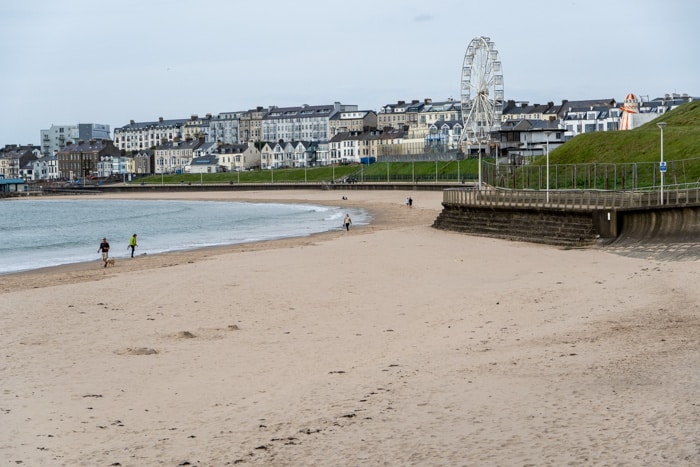
Where to Stay on the Causeway Coast
Anvershiel House – Located in the town of Portrush, this bed and breakfast is an excellent mid-range option for those exploring this part of Northern Ireland. They offer several clean and bright rooms, an excellent breakfast available in the mornings, and a location within walking distance of the beach and town centre.
Elephant Rock Hotel – Those looking for a luxury hotel while on the Causeway Coast will love this chic hotel in Portrush. Centrally located, they have a range of lovely rooms to choose from, an on-site restaurant and bar along with plenty of other great amenities.
Causeway Hotel – If you’d like to stay within a stone’s throw of the Giant’s Causeway and see it without the tour buses, then this hotel is a great option. Located adjacent to the visitor’s centre, booking a night here will also grant you free entry to the centre along with plenty of other perks.
Not quite what you’re looking for? Click here to browse more Causeway Coast hotels!
Day 4 – Causeway Coast
Those who have more time to devote to the Causeway Coast will be energised to hit the road early and start exploring again.
Start your day by touring the lovely and striking Dunluce Castle. This ruined castle is perched on striking cliffs not far at all from the town of Portrush and it makes for an excellent place to visit.
Next, you can make your way over to the Carrick-a-Rede rope bridge. This place was used as a filming location for the HBO series Game of Thrones and it is now very popular amongst visitors – so make sure to book your tickets online in advance and also to arrive relatively early if you want to beat the crowds.
You can spend a fair amount of time hiking around here and it’s worth doing this on your second day so that you don’t feel rushed.
Of course, no visit to this area of Northern Ireland is complete without heading to the Dark Hedges. Again, this was used as a filming location for Game of Thrones and it is an incredibly popular tourist attraction. It’s simply a country laneway that is lined with intertwining trees.
Keep in mind that it is definitely a lot more beautiful in the late spring and summertime when there are leaves on the trees and it can seem a bit lacklustre in the winter to about mid-May.

Day 5 – Derry
If you’ve got five days to devote to your Northern Ireland road trip, then make sure not to miss the city of Derry (Londonderry). As Northern Ireland’s second-largest city, Derry can be overlooked by visitors here, however, it has a lot to offer visitors and can provide important cultural context.
Though the city has been popularised as a destination because of the sitcom Derry Girls (you can even tour filming locations ), it doesn’t get the same amount of attention as Belfast.
Derry is a small city and you can certainly take in the majority of the sites and points of interest within the confines of a day. Take the time to walk the city walls – Derry is, in fact, the only walled city in Ireland and this is a great thing to do here.
Of course, no visit to Derry is really complete without taking the time to learn about the city’s more recent history and what life was like during the Troubles. You can visit the Bloody Sunday memorial to learn more about the 1972 massacre and you can also opt to take a walking tour of the Bogside murals with a knowledgeable local guide.
Those who want to learn even more about the city’s history will also find the Free Derry Museum interesting.
Another top Derry attraction is the Peace Bridge. The pedestrianised bridge connects the majority Unionist east side of the city to the majority Republican west side of the city and was meant to be an emblem of bridging the gap of a centuries-long political divide.

Have More Time?
If you have more time after this Northern Ireland itinerary, why not continue on from Derry into the Republic and visit County Donegal ?
If you’re coming from Northern Ireland and only have a day, then driving the Inishowen 100 is an excellent way to explore this part of northwestern Ireland. However, you could easily spend more time exploring this area, as well.
You can reach the town of Muff in County Donegal in about 15 minutes or you can drive north and take the ferry across Lough Foyle to the town of Greencastle. The latter option would also give you the opportunity to make a stop at Mussenden Temple.
For those who want to tour more of the Emerald Isle, then consider heading further south and enjoying some of (or the entirety of) the Wild Atlantic Wa y. County Donegal is absolutely gorgeous, but other highlights include Benbulben in County Sligo, Achill Island in County Mayo, Connemara in County Galway and more.

When planning a trip to Northern Ireland, you may not realise just how much this small country has to offer visitors. From vibrant and historic cities to some of the most spectacular natural scenery there is to offer in this world, spending a few days exploring Northern Ireland is never a bad idea.
Are you planning to visit Northern Ireland? Have any questions about this route? Let us know in the comments!

Related Posts:

Dublin or Belfast: Which Irish City to Visit?

The Perfect 1, 2, or 3 Days in Belfast Itinerary

7 Best Stops on the Dublin to Belfast Drive

About Maggie Turansky
Maggie is a co-founder and writer for The World Was Here First. Originally from the US, she has lived in five different countries and has travelled to dozens more, both solo and with her partner, Michael. She particularly loves exploring Spain and spending time in the Caucasus and the Baltics. Read more about Maggie
Hi, I enjoy reading your travel blogs and find them informative. Living in Northern Ireland I’d like to let you know that not only do we have an airport some 20 miles away from the city centre but there is also George Best Airport less than 2 miles from the City Centre and is great for those arriving to the city for its convenience. Also please note that St George’s market is only open from Friday to Sunday . I have seen many disappointed tourists arrive to the market on other days only to find it closed. Finally if you are travelling from Britain and have a National Trust membership this will allow free entry at the Causeway centre and other attractions – their website would provide more detail.
Thanks for those insights, Barbara!
Thank you so much Barbara Would not have thought about our N T membership. We are thinking about driving, any suggestions??
Leave a Comment Cancel reply
The ultimate guide to visiting Northern Ireland
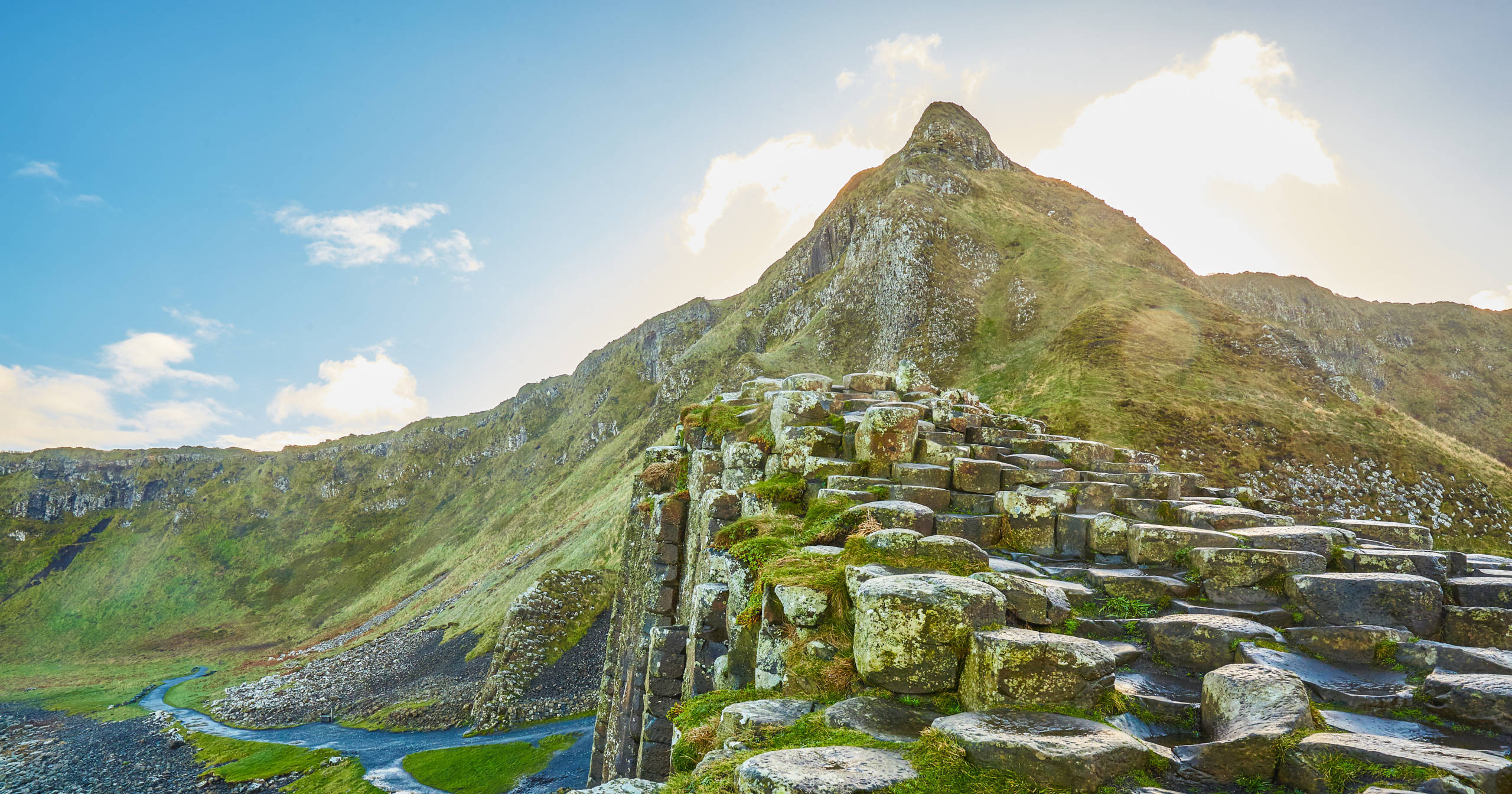
Northern Ireland is famous for many things from "Game of Thrones" locations to golf courses galore. For me, Northern Ireland packages up the best of the U.K. in a relatively bitesize area from the stunning Causeway Coast to the bustle of Belfast. There's great energy in Northern Ireland, and the area is crammed full of breathtaking sights that take you both indoors and outdoors.
Northern Ireland has 157 wet days a year, so be sure to pack for all weather. For now, prepare an Irish coffee and read our favorite Northern Ireland picks below.
Things to do
A trip to Northern Ireland should start in Belfast. It's a lively historic city with its famous Titanic Quarter, pubs, museums , hundreds of street murals, gardens and much more. A great way to get around is with hop-on hop-off sightseeing buses. Make sure you stop off and visit St George's Market -- the last surviving Victorian market in Belfast.

The Cathedral Quarter, named after St Anne's Cathedral, is the city's historic trading quarter and is packed with Victorian architecture, cobbled streets and quirky little pubs. If you are there on the weekend, Tea on The Titanic (which was built in Belfast) is well worth doing. Step back in time to a period of luxury, elegance and five-star service in the opulent Titanic Suite, which is a detailed recreation of the vessel's grand dining room.
The coast of Northern Ireland
Renting a car is a great way to discover Northern Ireland.
Read more : From Connemara to the Giant's Causeway: 9 of the most beautiful beaches in Ireland

With 334 miles of coast, a trip can take a few days to do in full with stops. Belfast is a good place to start, as an hour later, you will pass the Giant's Causeway, the Dark Hedges (as seen in "Game of Thrones") and Carrick-a-Rede Rope Bridge -- from where you can sometimes see Scotland on a clear day. Ferry companies like Stena Line have regular sailings that will transport you and your vehicle to Northern Ireland.
The white sands and azure waters of Whitepark Bay also make for a lovely stop. Rathlin, Northern Ireland's only inhabited offshore island, sits around halfway along the route and is home to an RSPB reserve with resident guillemots, razorbills and puffins.
County Armagh
Drive just an hour south of Belfast and you'll reach County Armagh, a rural gem whose charms rarely get shouted about. Known as the spiritual capital of Ireland, you can enjoy history and culture in the county's towns or venture into the unspoilt countryside and plentiful apple orchards.

Slieve Gullion Forest Park offers the unmissable opportunity to experience peaceful forest trails along with mountain views. The main six-mile trail is marked, takes you through woodlands and then to the summit of Slieve Gullion. You can also drive most of the way up. At the summit, you will find a Bronze-Age tomb and incredible views.
Dunluce Castle, County Antrim
Dunluce Castle is one of the most iconic monuments in Northern Ireland, situated rather precariously on the rugged Antrim coast. It provides a very important chapter in the history of the MacDonnells of Antrim and north-east Ulster.

This now-ruined medieval castle is reachable via a bridge connecting it to the mainland and is surrounded by steep drops on each side. You can explore the findings of archaeological digs within the cobbled streets and stone merchants' houses of the long-abandoned Dunluce town. The dramatic history of Dunluce is matched by tales of a banshee (a female spirit in Irish folklore who heralds the death of a family member) and how the castle kitchens fell into the sea one stormy night in 1639.
Tickets are $8 per adult.
If you love beaches, then make sure you make a trip to Whiterocks Beach on the north coast, awarded the prestigious Blue Flag Award multiple times with a backdrop of limestone cliffs that stretch from Curran Strand to Dunluce Castle.
Glenoe Waterfall, County Antrim
This pretty waterfall is snuggled in the hills just outside the village of Glenoe, 30 minutes from Belfast.

It's in a deep gorge and was a result of water channels that dropped 26 feet over the falls. Tiny fairy houses were added and stuck between the rocks and a tree fell on the top platform, which adds to the dramatic gushing waterfalls.
Where to stay
Belfast has two decent Radisson Rewards options: the Radisson Blu at 44,000 points (or around $96 midweek) per night and the Park Inn at 38,000 points (or around $86 midweek) per night.

If you love the outdoors and you're after something a little different, check out the family-run Finn Lough Luxury Hideaway, Enniskillen . A truly immersive staycation experience here will allow you to forge a connection with the Northern Irish countryside whilst residing in one of its Forest Domes, Suites or Lakeside Villas. The private, transparent domes are quite unique allowing you to watch the starry nights whilst horizontal on crisp, white sheets.
Forest Bubble Domes are from $409 per night.
Read more: 16 of the best hotels in Ireland
Restaurant top picks
The Muddlers Club in Belfast became the third Northern Ireland restaurant to receive a Michelin star . Named after the secret society that met there over 200 years ago, chef and owner Gareth McCaughey hand picks ingredients daily from the best of homegrown Irish produce, offering an enticing tasting menu (that caters for vegetarians and vegans) and a lunch menu, too. The open kitchen provides a sense of theatre and allows you to look on as Irish ingredients are transformed into Michelin-starred masterpieces.
The icy waters around Northern Ireland produce some great seafood. Enter Harry's Shack at Portstewart Strand, County Derry -- a rustic seafood restaurant right on the beautiful beach. Known for its spiced whitebait, fresh prawns and of course, traditional fish and chips, sunset-viewing tables are popular. It also has a garden overflowing with two acres of organic vegetables and herbs.

Bottom line
If you're traveling to the Emerald Isle and fail to go north of the border, you are definitely missing out. For such a small place, Northern Ireland has some of the most beautiful sights you will find and our bucket list of things to do keeps increasing.
If you are an adventurer, you can hike , climb and kayak to your heart's content and if you are seeking something more sedate, a serious food scene and the stunning Causeway Coast is just the tonic.
Regions of Ireland & Britain
- East Ireland
- South East Ireland
- West Ireland
- South West Ireland
- North West Ireland
- Northern Ireland
- Britain and Ireland Cities
Our Travel Stories
- The Beara Peninsula
- Kenmare Bay
- The English Lake District
- More Travel Stories
Popular for Visitors
- Top Attractions of Britain & Ireland
- Hidden Gems
- Castles & Ancient Settlements
- Irish Islands & Islets
- Planning for your Group
- Solo Travel in Ireland
- Backpacking in Ireland
Your Interests
- Breweries & Distilleries
- Irish Culture
- Irish Film Locations
- Ireland Then and Now
- Travel Photography in Ireland
- Outdoors & Activities
- City Tours of Britain & Ireland
- Golf in Ireland
- Golf in Britain & Ireland
- Walking & Hiking
- Britain & Ireland's Places of Worship
- Britain & Ireland's Historic Locations
- Britain & Ireland's Castles, Palaces & Stately Homes
- Britain & Ireland's Historic Military Sites
Useful Information
- Advice for Visitors
- Laws, Customs & Staying Safe
- Working & Volunteering in Ireland
- Getting Married in Ireland
- Ireland in 7-Day
My Ireland Tour
- Our Tour Packages
- Arrange a Private Tour
News & What's On
- News & Events

Northern Ireland Travel Guide
- Introduction
- Attractions
- Where to Stay
- Food & Drink
Northern Ireland Visitor's Guide Visitor's Guide
In peace, Northern Ireland has staked its rightful claim as one of the most beautiful, memorable and cultural regions to be found anywhere on the island of Ireland. Nowhere is Ireland's recent history more strongly felt than in the North, and any visit would be incomplete without uncovering this rich and vibrant culture.
- Northern Ireland Attractions
- Eating & Drinking
- Historical Sites
- Art & Culture
- Hiking & Biking
- Book a Vacation
Top Attractions in Northern Ireland
Natural wonders and centuries of innovation and enterprise mean today's visitors to Northern Ireland are greeted with some of the island of Ireland's most unique attractions. Until recently, years of political unrest and uncertainty saw visitor numbers to Northern Ireland fail to grow at the same rate as the rest of Ireland.
After years of peace and relative calm, the people of Northern Ireland are proud to be given the chance to show off their top attractions. Below we have created a list of the top attractions in Northern Ireland, both man-made and natural.
For more ideas on things to do in Ireland, take a look at this great website: Ireland Before You Die .
Check out Belfast hop on hop off bus tours.
1 Belfast City
Since peace returned to Belfast in the late 1990s, Northern Ireland's capital has undergone an astonishing transformation. Once tied in with sectarian violence and, perhaps cruelly, lumped in with Bosnia, Beiruit and Baghdad on the list of places for globe-trotting tourists to avoid, the city is now a modern, thriving and cosmopolitan hub of hotels, restaurants and family-friendly attractions.
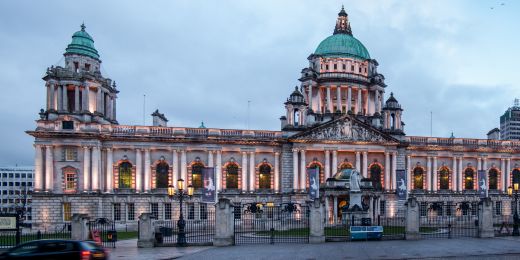
This transformation is made all the more evident in cultural representations of the region, which have at last moved beyond the all-too-predictable film and TV depictions of The Troubles with which the city become all but synonymous.
Just as Northern Ireland has garnered attention as the eye-catching backdrop to Game of Thrones, creating a sub-industry of its own comparable to "Tolkien Tourism", Belfast has gained added prominence as the location of the hit BBC drama series The Fall starring Gillian Anderson (The X Files, Hannibal) and Jamie Dornan (50 Shades of Grey).
For the best way to see Belfast City on foot, check out our Belfast City Walking Tour page .
Insider Tips
Right across the street, outside City Hall, you will find the meeting point for a free walking tour of the city which departs every day at 11:00 and 14:30.
2 The Giant's Causeway
According to Gaelic mythology, the causeway was built by the giant Fionn mac Cumhaill (Finn MacCool) so that he could reach Scotland and fight with his Scottish rival, Benandonner. As with all great rivalries, the outcome varies depending on whose version is being recounted.
More scientific data suggests that the spectacular formation is a result of an ancient volcanic fissure eruption around 50 to 60 million years ago. The 40,000 interlocking basalt columns were formed through the cooling and contracting of the resultant lava.
In 1693, the causeway began to enjoy international acclaim; Sir Richard Bulkeley, of Trinity College, mentioned the phenomenon in a paper presented to the Royal Society of London. In 1739, Susanna Drury really kick-started the global love affair with Giant's Causeway through her watercolour paintings, which were later engraved in 1743.
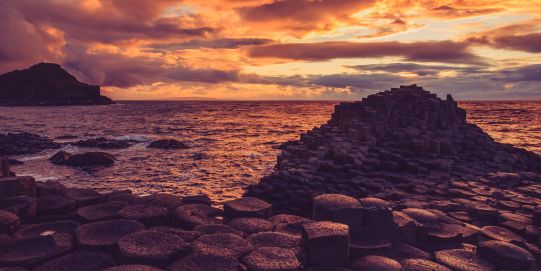
One legendary status which is not disputed, though, is the Causeway's immense pulling power as a tourist destination, with 750,000 visitors making the trip annually. Here, tourists can enjoy not only the geological feature itself, but also the modern and impressive Giant's Causeway Visitor Experience .
The walk to the Causeway itself can be a bit strenuous for those with lower mobility. Some stretches are steep and rocky. Sturdy shoes and some drinking water are recommended.
3 Derry / Londonderry
Although Derry's recent transformation is perhaps less dramatic than that of Belfast, visitors who come to Derry expecting a city still darkened by the long shadows of The Troubles will almost certainly be pleasantly surprised. In anticipation of the city's status as UK City of Culture 2013, Derry received considerable investment and underwent a rejuvenating makeover.
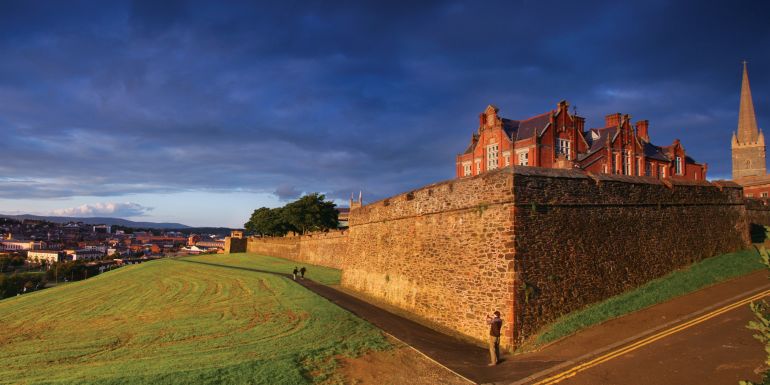
Visitors and locals alike can look to the Peace Bridge, Ebrington Square, the redeveloped waterfront and the Guildhall area as examples of a city which has shaken off its outdated stereotype, under whose weight Derry had unfairly served as a metaphor for Ulster's violent past. In the city which greets tourists so warmly today, visitors will find plenty of enjoyable diversions.
Visitors who wish to gain the fullest appreciation of this side of Derry should make time for Free Derry Corner , the Bloody Sunday Memorial , the People's Gallery Murals and the Museum of Free Derry . View the Visit Derry website for more information .
If you'd like to to see how best to explore Derry City on foot, take a look at our Derry City Walking Tour page .
If you're visiting in October, be sure to stick around for Halloween which is a major event in the city and culminates in the largest street party in Europe. Just remember to wrap up warm!
4 Titanic Belfast
The angular edifice which houses The Titanic Experience is so evocative of the transformation which Belfast has undergone in recent years that it has become almost as iconic as the ill-fated ship to whose short history this attraction is dedicated.
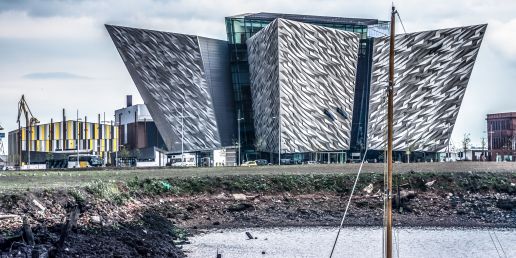
An extensive multimedia tribute to the world's most famous ocean liner, The Titanic Experience is located at the top of the slipway from which the ship made its first and only descent into the Belfast Lough and the waters of the Irish Sea beyond. Opened in 2012 for the centenary of the ship's launch and tragic demise, the museum has rapidly become Ulster's most visited tourist destination, outstripping even The Giant's Causeway .
Cleverly put together, the attraction encapsulates more than simply the scale of the ship, more even than the scale of the disaster which befell it; drawing on all the sights, sounds and smells of the age, the museum recreates all facets of this most fascinating period of history, bringing to life the experiences not only of the passengers but also of the ship workers who realized this vision of early twentieth century engineering.
While you are encouraged to take the tour of Titanic Belfast at your own pace, it is common for people to feel a bit rushed by the end. THis is mainly due to the fascinating opening section of the tour which outlines the history of Belfast City during the time the Titanic was built. Some of the best bits, like the "Shipyard Ride" and the light shows, are located towards the end of the tour.
Practical information
Tours typically last between 1.5 and 2.5 hours. You can access the Titanic Belfast in its entirety via wheelchair, with ramps and elevators located throughout. Assistance dogs are welcome and staff members are available to aid anyone with any special assistance.
Opening Hours
Titanic Belfast is open daily from 9.00am to 6pm , with final entry at 4.20pm
Admission fee
Titanic Belfast ticket prices range from £24.95 for adults and £11 for children .
5 Murals of Belfast
Although their history spans over a century, and although they began as a unionist motif, it was in the early 1980s that Belfast's iconic murals would gain the prominence that now draws tourists, when Republican depictions of the infamous hunger strike of Bobby Sands and his follow prisoners began to spread across Republican districts of the city.

For two decades, murals on both sides of the city voiced the deep divisions between communities whose differences seemed insurmountable. On the Unionist side, the imagery was chiefly militaristic, with slogans like "No Surrender" a near-constant refrain. In Republican communities, depictions drew on a more diverse palette of cultural and historical symbolism, but their message was no less clear and no less divisive.
To get the most out of a trip to Belfast and its rich history, a local tour guide is recommended.
6 Guildhall
Lording it over an open expanse of fountains and marbled stone, Guildhall rises to majestic heights to take its place on the Derry skyline. A £10m renovation in 2013 has brought the very best out of what was already a magnificent structure of stone and stained-glass. As well serving an important civic function for the city (it was the seat of the historic Bloody Sunday Inquiry headed by Lord Saville from 2000 to 2005), Guildhall has become a nexus for Derry tourism and a focal point for most visits here. View the Visit Derry website for more information .
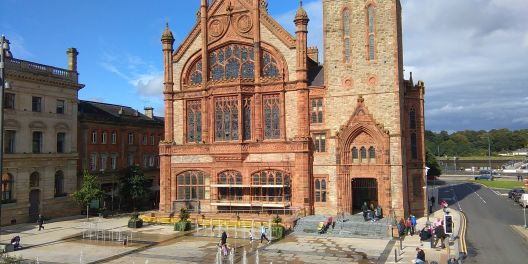
If you're are heading to Derry specifically to see the Guildhall, then be sure to call ahead and check what times are best to visit. Some days, areas of the building are closed for private functions.
7 Walled City
Ireland's first attempt at town planning, modelled in 1545 on the French town of Vitry-le-François. Visit derrywalls.com for further information. Those interested in architecture should allow time to visit St Columb's Cathedral, situated within the city walls.

A good local tour guide is recommended to get the most of this historic city and its iconic fortifications.
8 Carrick-a-Rede Rope Bridge
A handy stop-off point between The Giant's Causeway and Ballycastle, the Carrick-a-Rede rope bridge is a dizzying experience to be enjoyed or studiously avoided, depending on your head for heights. Looking like something from an Indiana Jones movie, the rope bridge conveys locals and tourists alike across the 20-metre chasm between the sea cliffs and the island of Carrick-a-Rede.
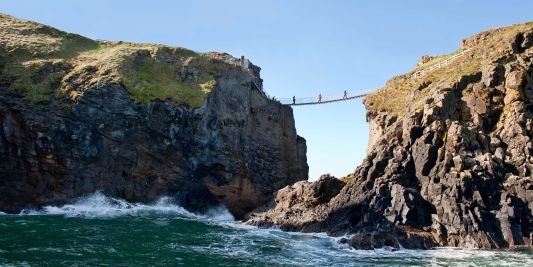
The bridge which draws visitors today is actually a stronger and safer version of the original which was put up every spring by fishermen whose nets, cast from the island's northern cliffs, would intercept migrating salmon. Today, there is a small visitor centre, a café and a car park.
The bridge itself is very sturdy and only bounces if people jump while crossing it. Take a deep breath and go for it!
9 Glenariff Waterfall Walk
Glenariff Waterfall Walk is one of a series of walks in the Glenariff Forest Park, County Antrim. The forest is laid out with pathways and steps for people to explore. It might take up to 2 hours walking to reach the payoff, the waterfall, but it is well worth the wait. The walk which leads to the waterfall is a little strenuous and is not advisable for everyone. The steps are steeper and can become slippery on approach.
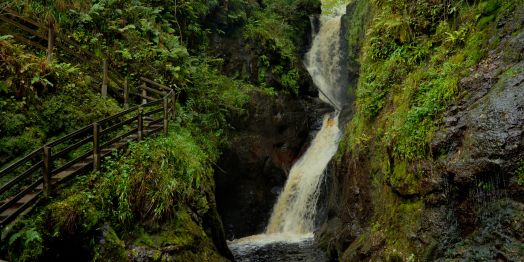
All trails are well-signposted and have clearly defined pathways. Bring sturdy shoes and a sense of adventure.
10 Ballymacdermott Court Tomb
Ballymacdermott Court Tomb, located on Ballymacdermott Mountain in County Armagh, is a megalith portal tomb. It dates from between 4000 and 2500 B.C. The tomb was excavated twice, in 1816 and 1962. The first excavation unearthed pulverised human bones in an urn while the second discovered human cremations. During the second excavation, archaeologists found that some of the stones in the tomb had been recently disturbed, locals informed them that this was caused by an American tank during World War II.
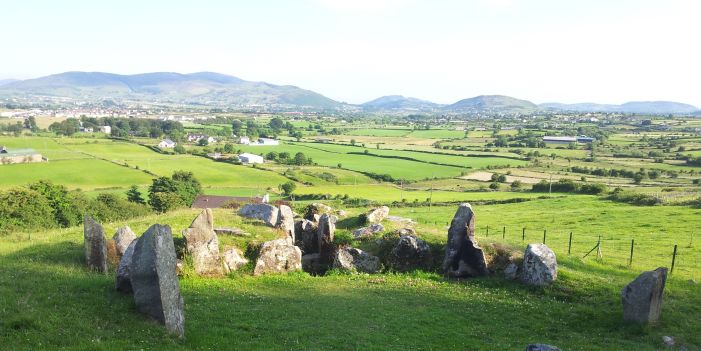
A beautiful spot but fairly exposed so be sure to wrap up on a blustery day.
11 Stairway to Heaven
The Stairway to Heaven, officially known as the Cuilcagh Mountain Trail, is a 4 and a half-mile walkway through bogland in County Fermanagh. The walkway was constructed to protect the rare blanket bog that was being eroded by walkers in the area. The walkway ascends to over 550 metres to the Cuilcagh Mountain face.
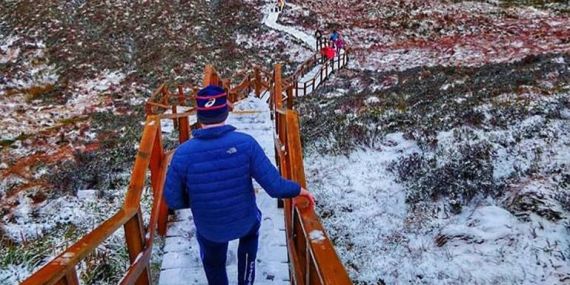
Bring cash for the carpark and a flask of something that warms the cockles while you take in the amazing views.

Getting to Northern Ireland
The easiest way to travel into Northern Ireland, if it is possible, is to aim for Belfast City. It is the capital city of Northern Ireland and is the area that all roads in the north eventually lead to. For simplicity, the following section will be mainly focusing on getting in and out of here. Think of Belfast City as the base of Northern Ireland, from there you can explore the smaller towns and villages of the region.
Arriving by Plane
From the uk and europe.
There are 3 International airports in Northern Ireland. In Londonderry, there is the City of Derry Airport and in Belfast City, there is George Best Belfast City Airport (Named after former Northern Ireland and Manchester United soccer player) and Belfast International Airport. These airports operate flights from the UK as well as Holland, Spain and Portugal.
From North America
Dublin Airport is the most convenient airport for visitors to Northern Ireland coming from the United States and Canada. You can travel to and from Dublin Airport to Belfast City in a number of ways. If you are renting a car in Dublin Airport be sure to book a Sat-Nav as well. This will come in handy to find your way out of Dublin city more than anything else. Once you find your way onto the M1 motorway the rest of the journey is pretty much plain sailing. Just remember that once you cross the border into Northern Ireland that the speed limit is read in miles per hour, whereas in the Republic it is in kilometres per hour. You can also avail of the direct bus from Dublin Airport to Belfast City via Aircoach and Expressway , this journey takes, on average, 2 hours and costs around 13 euro one-way.
Arriving by Bus
The main bus station in Belfast City is Europa Buscentre. Based in the city centre and servicing both Belfast airports and Dublin Airport. Europa Buscentre also has a route to Dublin City, which in turn connects you with the other cities in the Republic of Ireland. There is also a bus route running from Londonderry to Dublin , this route can have as much as three change overs and takes 4 hours 20 minutes.
Arriving by Train
The best way to enter Northern Ireland via train is also via Belfast City. The Dublin train runs from Connolly Station to Lanyon Place in Belfast. There is an average of eight trains per day, leaving every hour and 40 minutes, starting at 7:35 am and finishing at 8:45 pm. The quickest of these routes takes two hours and five-minutes. Dublin also acts as the change over point if you are taking the train to or from Belfast to any other city in Ireland.
Arriving by Car
If you have gotten to grips with driving in the Republic of Ireland and are crossing the border into Northern Ireland there are a few things to look out for. The roads of Northern Ireland are categorised the same as all other countries in the UK. The letter 'M' stands for motorway, the next most important roads are classed with the letter 'A', the next with the letter 'B' and so on. Both Northern Ireland and the Republic of Ireland drive on the left-hand side of the road and both use the 'Roundabout' system. The only real difference to keep in mind is that the measurement of speed in Northern Ireland is miles per hour while in the Republic it's kilometres per hour. To make it a little more tricky, the speed limit often appears on road signs as just a number in both countries.
Arriving by Ferry
There is a ferry route running between Larne, County Antrim in Northern Ireland to Cairnryan in Scotland and from Belfast City to Liverpool in England.
Getting around in Northern Ireland

Rail & Bus Services
One of the most cost-effective ways to travel around Northern Ireland is by bus. Translink is the main bus and train operator in Northern Ireland. They offer a great range of combo deal tickets and Smartcards which help lower your day to day travel cost.
Visitors can avail of the Ramblers Bus Service which is designed to make the more remote areas of Northern Ireland more accessible. If you are planning to travel around Belfast on public transport then the Belfast Visitor Pass from Translink is definitely worth a look. This gives you unlimited travel on all Metro, NI Railways and Ulsterbus services for £6.50 per day.
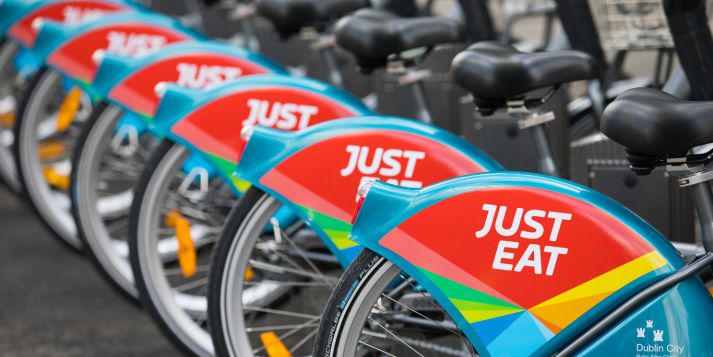
Just-Eat Bikes (Belfast only)
Belfast City runs a bike hire scheme, sponsored by the food delivery company Just Eat. It is a cost effective and quick way to get around the city. There are around 40 stations in total, each within close proximity to another.
A user must first create an account on the website , there is a £5 sign up fee which then goes towards your account as credit. You can choose from three different pricing options.
- Pay as you go: 30 minutes for £1
- Casual: 3 days for £6
- Annual: £25 per year

Taxis in Northern Ireland are broken down by classes A,B,C and D. Class A and B taxis are regular taxi cabs that can be hailed on the street or phoned from a base.
These class of taxis have an initial charge (up to 0.5 miles of £3). One mile is £3.80 and every additional mile is £1.60. Class C taxis are ones that are used chauffeur services, weddings and funerals, the above maximum fare structure does not apply to Class C taxis. Class D is Taxi Buses and again the maximum fare structure does not apply to these.
Other Regions of Ireland & Britain

Regions of Ireland & Britain
- Travelguide Homepage
- UK & Ireland Cities
Your Group & Interests
- Castles, Palaces & Stately Homes
Travel Advice
- Our Ireland Tour Packages
Adare Village and Thatched Cottages
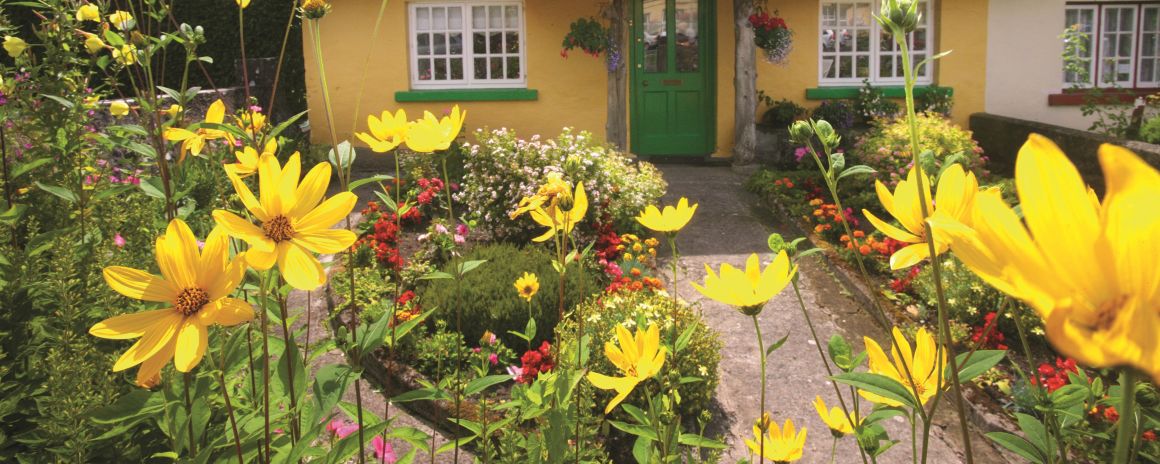
About Adare Village and Thatched Cottages
Adare is a small town in Co. Limerick, known for its quaint and colourful thatched cottages. Adare is considered to be one of Ireland's most beautiful towns so stop and take in the view. Don't forget your camera today - the perfect chance to capture the essence of old Ireland.
Explore Adare Village along the Wild Atlantic Way .
Black Taxi Tour Belfast
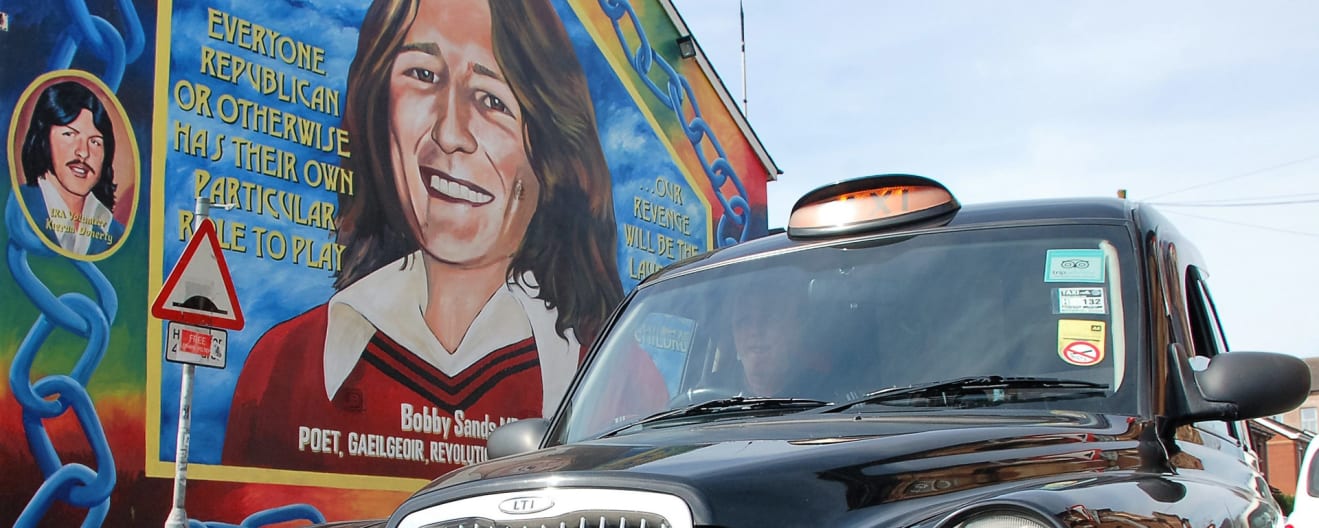
About Black Taxi Tour Belfast
Take a journey through this once troubled city. See the murals of the Loyalist Shankill Road & Nationalist Falls Road. The Troubles took their toll on the economic life of Belfast, but the past ten years of peace have returned much prosperity while the genuine friendliness of the city never left.
Blarney Woollen Mills
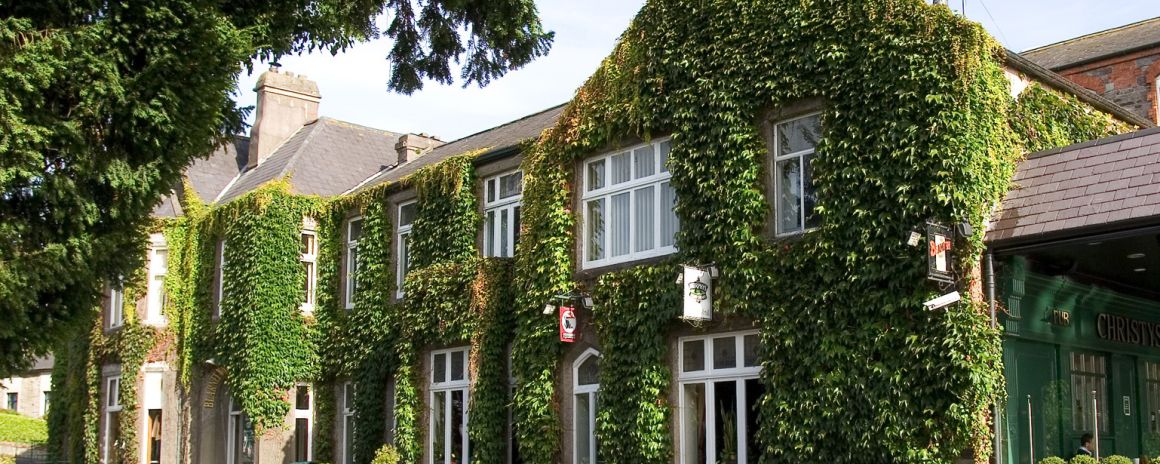
About Blarney Woollen Mills
Originally built in 1823, Blarney Woollen Mills was mainly used for the spinning and weaving of wool. After it closed in 1973, it reopened in 1975 — as an Irish heritage shop.
Visit their website...
Culloden Battlefield
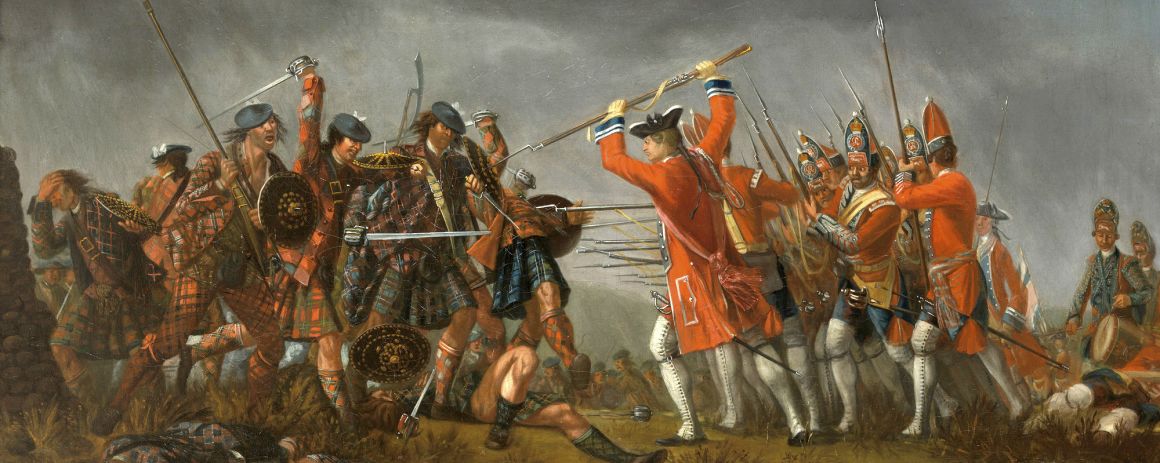
About Culloden Battlefield
The Culloden Battlefield Visitor Centre commemorates the last pitched battle fought on British soil, in April 1746. Learn more about the Jacobite intent to overthrow the House of Hanover and return the House of Stuart to the British throne.
Glenveagh Castle
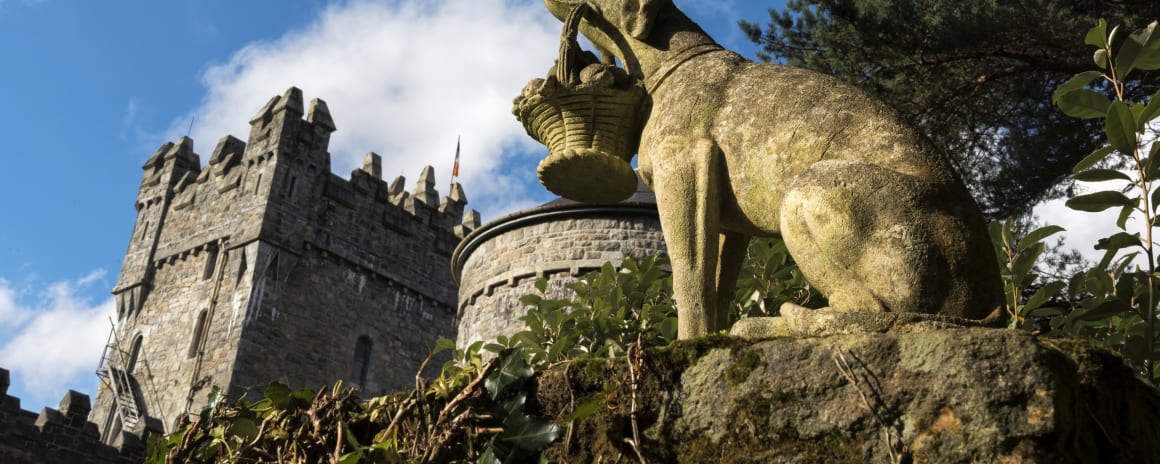
About Glenveagh Castle
Located within Glenveagh National Park, Glenveagh Castle was built by Captain John George Adair between 1870 and 1873. Having made his fortune through land speculation in America, Adair return to Ireland and began large amounts of land in County Donegal. The castle was built in the Scottish Baronial style and is surrounded by a garden and commands stunning views of the nearby mountains, lakes, woodlands and valleys.
Highland Folk Museum
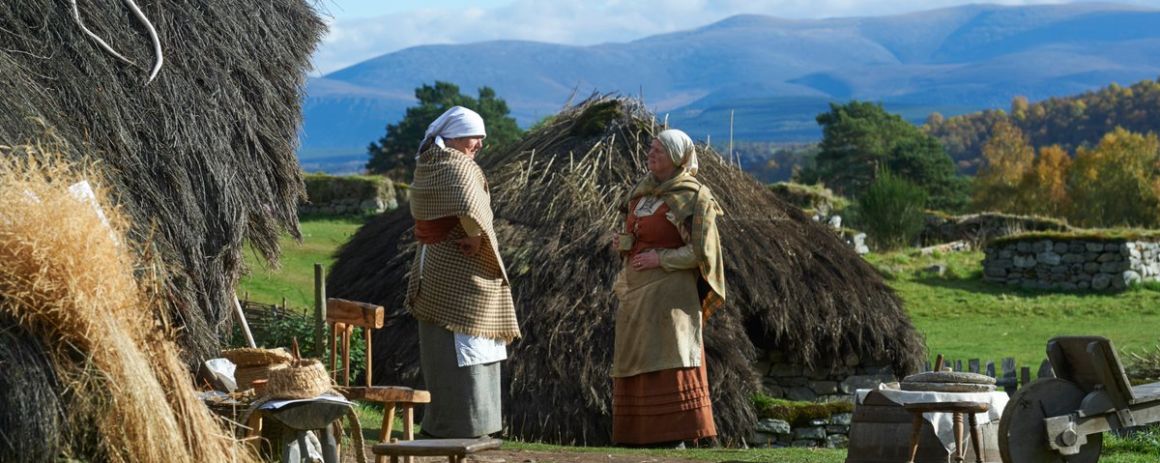
About Highland Folk Museum
About Highland Folk Museum is a museum and open-air attraction located in the Scottish Highlands. It is designed to showcase the domestic and working lives of the early highland people.
King John's Castle
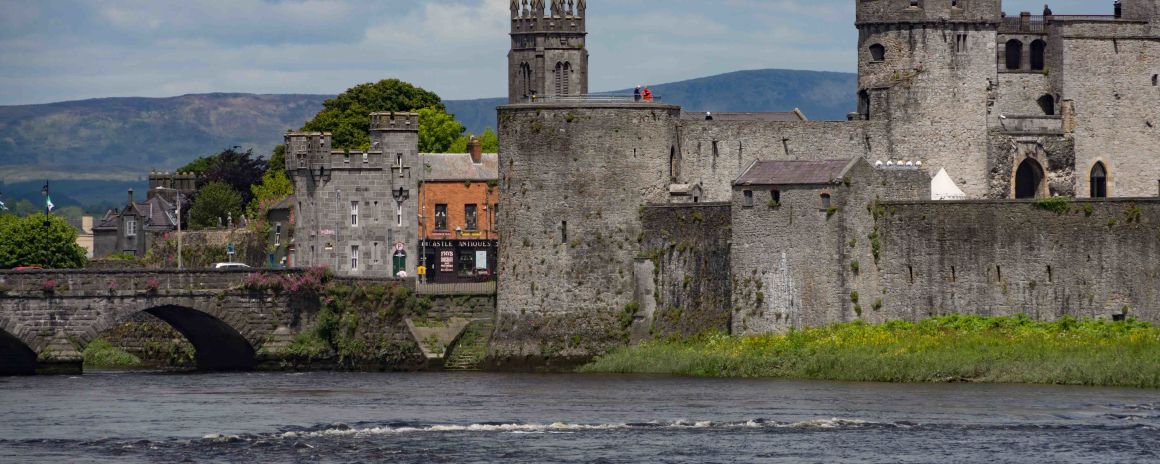
About King John's Castle
Located alongside the River Shannon in County Limerick, on King's Island. Dating back to 922, to a time when Vikings were the inhabitants of the island (Thormodr Helgason, the Viking sea-king, built the first settlement here. The castle itself was built in 1200, under the instruction of King John of England.
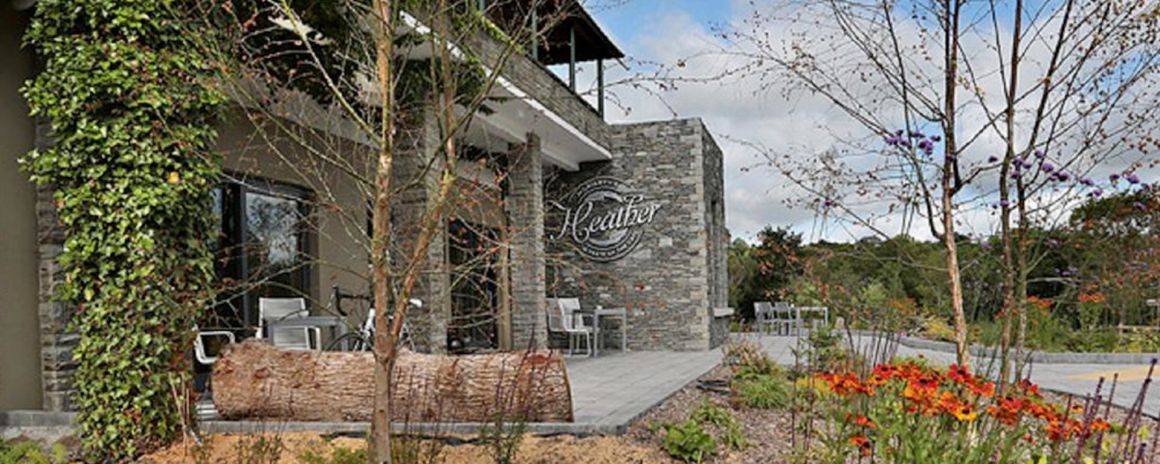
About Moriarty's
Located close to the Killarney National Park, Moriarty's is an Authentic Irish Gift Store and Restaurant. Hand crafted Irish jewellery, Waterford Crystal and classic and modern tweed fashions and furnishings are all on offer at the gift store. The restaurant is an 85 seater offering stunning views of the surrounding landscape.
Mount Congreve Gardens
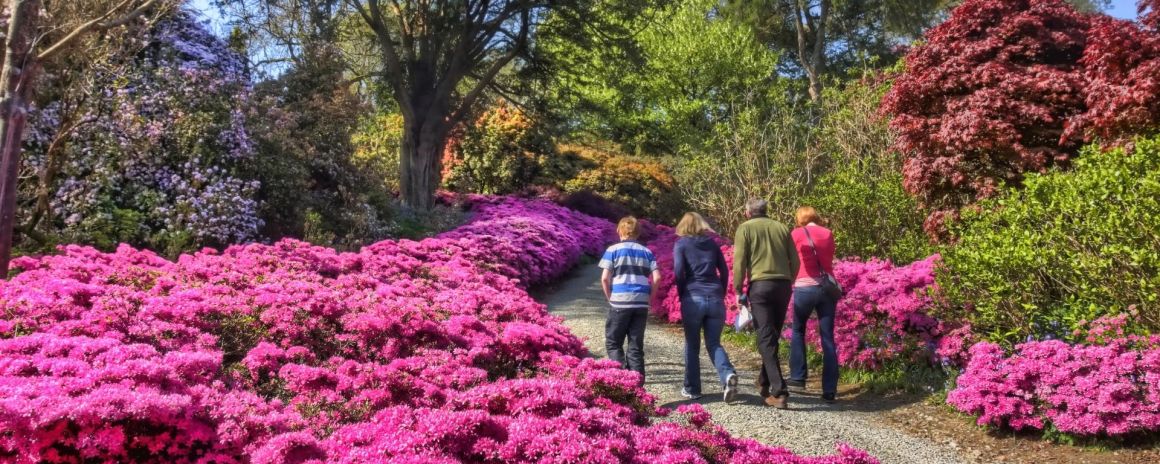
About Mount Congreve Gardens
Mount Congreve Gardens. Located in Kilmeaden, County Waterford, Mount Congreve Gardens is an 18th century Georgian estate and mansion. It was designed by the same architect that created both of Waterford's cathedrals, John Roberts.
Mount Stewart House & Gardens
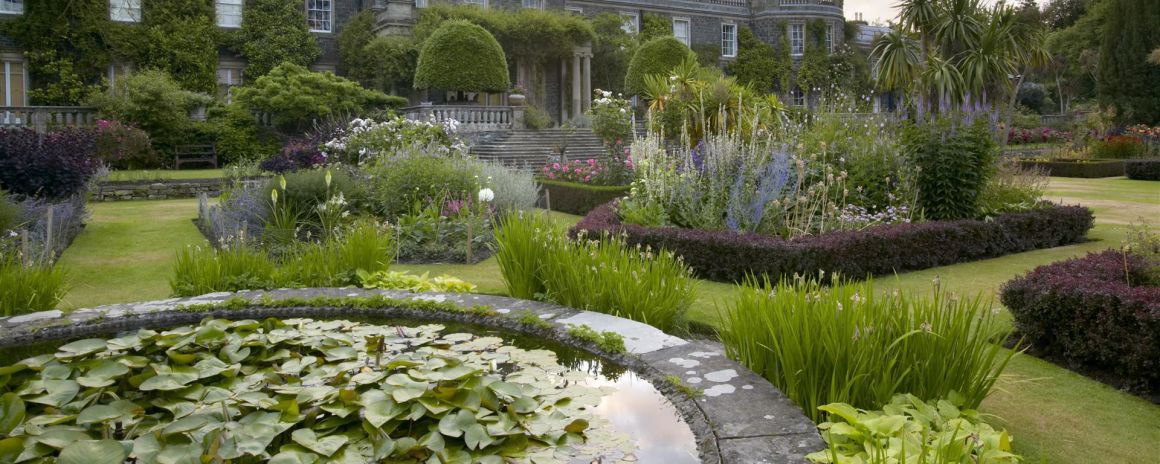
About Mount Stewart House & Gardens
Recently recognised as being one of the top 10 gardens in the world, Mount Stewart is a rich tapestry of planting plant life and stunning walking trails. The house dates back to the 19th century, and was the Irish seat of the Vane-Tempest-Stewart family.
Muckross House
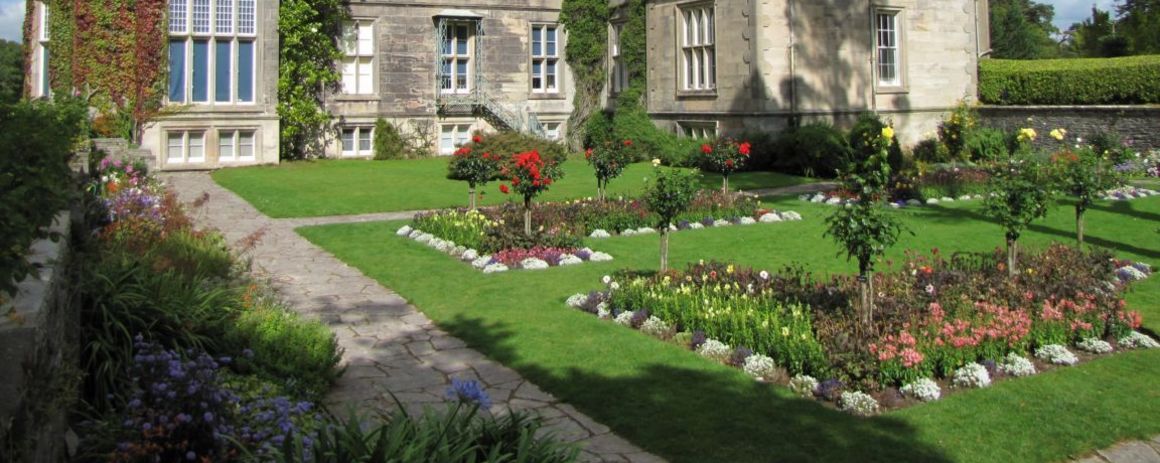
About Muckross House
Located on the grounds of the expansive and idyllic Killarney National Park. Muckross House, and its 11,000-acre grounds, was donated to the Irish state in 1932.
Muckross House Traditional Farms
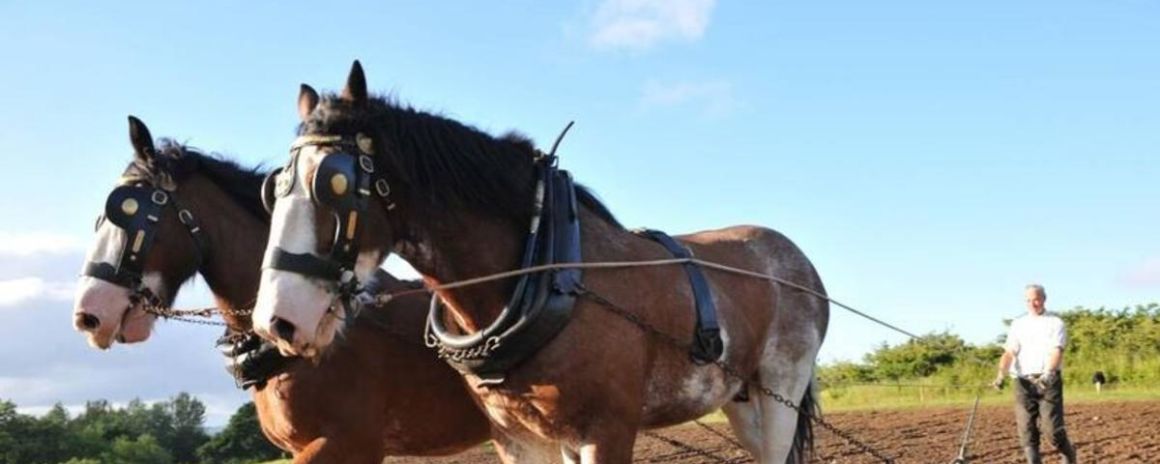
About Muckross House Traditional Farms
Located on the grounds of the picturesque Muckross House and its impeccable gardens. Take a step back in time and see the Irish farming lifestyle of the 1930s and '40s. A time when the horse was responsible for much of the labour and the weather was the be all and end all in terms of production.
The Quiet Man Museum
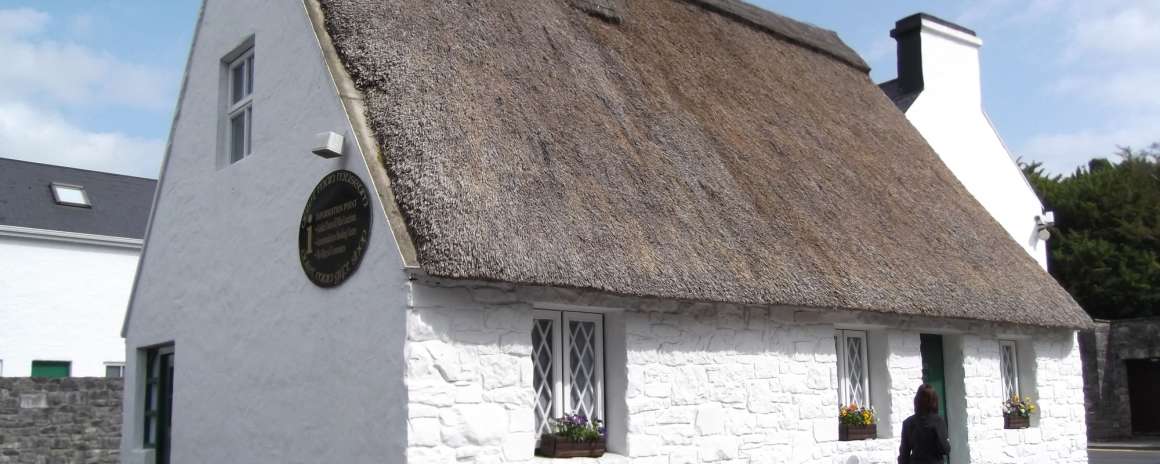
About The Quiet Man Museum
The Quiet Man Museum. A reproduction of the quaint thatched cottage from the John Wayne starring, John Ford directed movie of the same name. all costumes, artefacts and furnishings have been recreated in precise detail, to reflect the setting of the 1952 classic. Located in the picturesque village of Cong, County Mayo.
Ireland Travel Guide
As a local Irish company, we at My Ireland Tour are passionate about our country and our local community. We're thrilled that you're interested in visiting the place we call home. That's why we put together this definitive travel guide for anyone who wants to come to Ireland and discover this amazing place for themselves.
This is a completely free resource covering everything from top tourist attractions to the nearest yoga centre. We hope it helps!
Got questions?
- (US / Ca) 011 353 21 237 9006
- (EU) 00 353 21 237 9006
- [email protected]
- 5 Church Hill Carrigaline Co. Cork P43 X376 Ireland

Useful Links:
- Ireland Travelguide
- Advice & Safety
- Solo Travel
- Backpacking
You are using an outdated browser. Please upgrade your browser to improve your experience and security.

https://visitbelfast.com/
- What's On Homepage
- Art & Exhibitions
- Children’s Events
- Food & Drink
- Free Events
- History & Heritage
- Learning Experiences
- Lectures & Talks
- Markets & Fairs
- Music & Concerts
- Nature & Wildlife
- Pubs & Clubs
- Shows & Displays
- Virtual Events

- See & Do Homepage
- Arts & Entertainment
- Attractions
Green Attractions
Green spaces.
- Sightseeing Tours
- Information & Services
- Travel & Transport
Competitions

- Eat & Drink Homepage
- Afternoon Tea
- Restaurants
- Food and Drink Experiences
- Pubs and Clubs
- Visit Belfast Food & Drink Voucher

- Ideas Homepage
- Belfast Plus
- Family Friendly Belfast
- Free Things To Do in Belfast
Game of Thrones
- Titanic & Maritime
- Music in Belfast
- Embrace a Giant Spirit

- Stay Homepage
- Camping and Caravans
- Serviced Accommodation
- University Accommodation
Green Stays

- Plan Homepage
- Getting Here
- Belfast Visitor Map
- Accessibility in Belfast
Sustainable Belfast
- Getting Around Belfast
- Green Travel
- Belfast Visitor Pass
- Car Parking
- Brochures and Downloads
- Visitor Apps
Neighbourhoods
- Sign Up to Mailing List
- Visit Belfast Welcome Centre

- Offers Offers
- Neighbourhoods Neighbourhoods
- Game of Thrones Game of Thrones
- Search Enter your search above to discover things to do, events, offers and more... Close
Visit Belfast | Official Belfast Tourist Information | Trips to Belfast UK
For Belfast 2024, we’re embracing our creativity. So, come and enjoy special moments, performances and celebrations in the city. Stroll through urban street art, relax in city gardens and discover Belfast’s vibrant neighbourhoods. Then take in the sounds of the city with live music at bustling trad pubs and cool rooftop bars. Well, what are you waiting for?
Recommended for You
Belfast 2024.
Belfast 2024 celebrates the culture of our city with a wide-range of local projects, events and city initiatives.
Top 10 Family Fun Attractions in Belfast
There are plenty of attractions to see and do for the kids (and the young at heart) around…
Queen’s Arcade
Situated in the heart of Belfast city centre, Queen’s Arcade is home to a variety of luxury Boutiques…
Titanic Belfast
Titanic Belfast is the world's largest Titanic visitor experience and a must-see on any visit to Belfast and…
48 Hours in Belfast
Experience the best things to do in Belfast in 48 hours.
Hillsborough Castle and Gardens
Visit Hillsborough Castle and Gardens and discover Northern Ireland’s royal residence.
You’ve come to the right place to start planning your next trip to Belfast – we’ve lots of ideas to inspire your travels for when you are able to get in the car, bus, coach train, plane or ferry to get here.
Here, you can search for things to do and find out what’s on in Belfast and across Northern Ireland. Get information about Belfast hotels , accommodation , attractions , sightseeing tours , restaurants and bars , and be inspired by our Titanic heritage and Game of Thrones territory.
Find out about getting here and download Belfast tourist maps . Or find out about the Visit Belfast Welcome Centre where you can pick up visitor guides and book tours and events tickets.

Get the latest scoop on concerts and gigs, festivals, family events and everything else that’s happening in Belfast. Browse our events guide to discover what’s on today, what’s on this weekend, and more things to do this month.

Here in Belfast, you’ll find fascinating walking, bus and taxi tours, cultural escapes, scientific exhibitions and literary inspirations. Not to mention the superb shopping, beautiful landmarks and top class entertainment.
Eat & Drink
Eating out is one of the great pleasures in life. There’s nothing like a new city, new restaurants and new culinary experiences. For a city the size of Belfast the choice of places to eat is surprising. We offer everything from fine dining, brasseries and bistros to gastro pubs, cafes, coffee shops and some of the best fish & chips around.

Looking for a comfy place to stay? Of course you are! And you’re guaranteed to find it here in Belfast and throughout Northern Ireland. Browse ideas for places to stay, including hotels , spa resorts, hostels , camping , caravanning , serviced accommodation and university accommodation .

We’re here to help you plan your perfect trip to Belfast. From information about getting to Belfast and travelling around the city to car parking , travel tips and guides to our neighbourhoods . Download Belfast visitor maps and brochures , and discover a host of visitor apps to help plan your trip.
Belfast is taking steps to become a future proof city for generations to come. Find out how you can make your trip to Belfast and the surrounding area more sustainable.

Discover these Green Tourism accredited attractions in and around Belfast. Make new memories and have fun at one of these sustainable attractions.
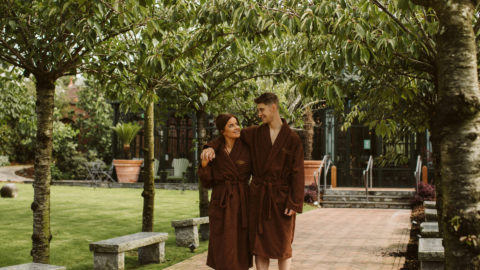
On your next visit to Belfast, why not show some love to the planet by visiting these Green Tourism accredited hotels, that are playing their part in making Belfast more sustainable.
Did you know Belfast is one of the top cities in the UK for green attractions? If you’re looking to make your visit as eco-friendly as possible, put these parks, gardens and tours at the top of your list.
Ideas and Inspiration
Check out our blog articles for some inspiration of things to do in and around Belfast.

Find hotel offers, restaurant deals and money off top visitor attractions with these unmissable offers in Belfast – all you need to plan a cheap city break!

You have to be in it to win it! Enter one of our exclusive competitions for your chance to win a trip to Belfast, festival tickets, visitor attraction experiences and nights out.
Each area of Belfast has its own character and charm, and its own unique variety of shops, restaurants, cafes, museums and attractions. Take time to discover the city’s hidden treasures in Belfast’s neighbourhoods.
Northern Ireland is the Home of Thrones. The popular TV series Game of Thrones® was filmed in Belfast and across Northern Ireland. Our rugged coast lines, historic castles and breathtaking scenery are the perfect setting for this epic story. Get the full experience and explore the filming locations with a Game of Thrones tour.

We're here to help, so if you can't find the info you're after, or you just want to ask a really odd question, then we're here for you.
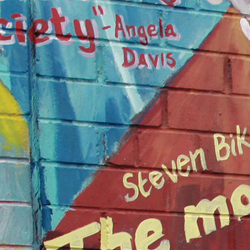
Visit Belfast Newsletter
Sign up to the Visit Belfast newsletter and receive inspiring ideas, events and offers which showcase the best of Belfast and Northern Ireland.
Ask a Question
" * " indicates required fields

Choose a date
- This Weekend
If you select a location more than 15km from the Visit Belfast Welcome Centre, your location will be set to Belfast City Centre.
Hide this tool

Northern Ireland Travel Guide
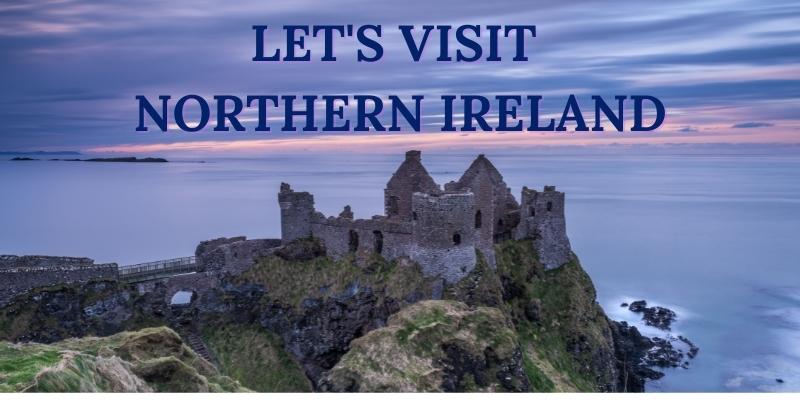
Welcome to our Northern Ireland Travel Guide where you will find links to all the travel-related posts about Northern Ireland on the website. This includes articles about itineraries, where to visit, what to see and do, best day trips, tours and tickets, books to read and lots of practical tips, resources and inspiration for your trip.
Are you planning to visit Northern Ireland either from the UK or part of a longer trip from around the world?
On this page, you will find links to all my articles about Northern Ireland including where to visit, what to see and other information to help you make the most of your trip.
For practical travel advice for visitors to anywhere in UK you will find more information on my UK travel planning page.
With a population of nearly 2 million Northern Ireland is the smallest nation in the United Kingdom.
Northern Ireland was created in 1920 when the Government of Ireland Act divided the country into two separate units. Belfast is the capital of the north and Dublin of the south. In 1949 the Independent Republic of Ireland was established in the south.
Northern Ireland has been marked by sectarian violence over the years. In recent times the political parties have been working towards compromise and a power-sharing government now governs Northern Ireland.
For more information about the history of Northern Ireland see my recommended reading section at the bottom of this page.
ITINERARIES
Tours and tickets, accommodation in northern ireland, recommended reading.
This post may contain affiliate links, which means we may receive a commission, at no extra cost to you, if you make a purchase through a link. Please see our full disclosure for further information. As an Amazon Associate, I earn from qualifying purchases.

PLACES TO VISIT IN NORTHERN IRELAND
What features on your Northern Ireland bucket list?
Is it the UNESCO World Heritage Site of the Giant’s Causeway or the Dark Hedges of Game of Thrones fame? Or perhaps you want to visit Belfast and the Titanic Museum?
Below you can find links to some of the top destinations to visit in Northern Ireland.
Start with my top 10 places to visit in Northern Ireland as a good introduction to the landmarks, places and sights to see during your visit.
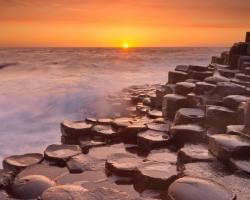
Coming soon
Read my month-by-month guide to visiting the UK which contains information about what to expect during the different seasons as well as shows/attractions and activities.
There are a number of day tours available with Get Your Guide as well as tickets to main attractions and sights. See below for further information
Travel Guide Ireland
Book your individual trip , stress-free with local travel experts
Select Month
- roughguides.com
- Travel guide
- Local Experts
- Travel Advice
- Accommodation
Plan your tailor-made trip with a local expert
Book securely with money-back guarantee
Travel stress-free with local assistance and 24/7 support
Over the past three decades, Ireland has transformed itself with quiet determination. Gone - or certainly on its way out - is the image of a conservative, introspective, rural set of nations. The infamous unrest and violence, between the Republic (Éire) and Northern Ireland (as part of the United Kingdom), have faded away. An outward-looking Ireland has stepped forward, energised by cities no longer weighed down by the Troubles.
Brief history
Facts about ireland, where to go in ireland, outdoor activities in ireland, hurling and gaelic football, the midlands: westmeath, longford, offaly and laois, belvedere house, northern westmeath, athlone and around, some history, birr castle, slieve bloom, the four provinces, in search of the authentic irish pub, travel ideas for ireland, created by local experts.

11 days / from 1944 USD
Fascinating Ireland & North Ireland
Ireland is one of the most popular destinations for tourists: its rich cultural heritage, the beautiful landscapes and the laid-back lifestyle attract many travelers. Visit the famous Giant's causeway, fascinating Cliffs of Moher, the Ring of Kerry and many more highlights.

8 days / from 732 USD
Spectacular Ireland
This itinerary will give you a chance to discover the most spectacular places in Ireland within eight days. Visit the Killarney National Park and the South West Coast of Ireland. Travel back in time during your visit on the Aran Islands and cross the region of Connemara.

6 days / from 490 USD
Game of Thrones – Northern Ireland
The Seven Kingdoms await you in this Game of Thrones adventure. The incredible landscapes of Northern Ireland make up an enchanting array of fortresses, heart-stopping cliffs and countless small villages steeped in history. A trip to the universe of Game of Thrones is about to begin!

4 days / from 415 USD
Pearls of Ireland: Cliffs of Moher, Galway and the Burren National Park
Take some time off with your family and friends and discover the most spectacular places that Ireland has to offer. In addition, we recommend you pay for the beautiful city of Dublin a visit.

5 days / from 508 USD
The West Coast and Cliffs of Moher
This itinerary discovers the most authentic parts of the Emerald Isle. The spectacular Cliffs of Moher on the west coast, the many castles and fortresses in the south, together with the breathtaking landscapes of the Wicklow Mountains National Park presents the perfect backdrop to a trip.
Of course, it's not called the Emerald Isle for nothing; among the romantic preconceptions visitors bring to Ireland, it is their expectations of the landscape that are most likely to be fulfilled. Travel to Ireland and you'll discover an uncommon geological richness and the warming effect of the Atlantic produce an astonishing diversity of terrain on this small island, which is splashed throughout with lakes and primeval bogland.
In the east, the crumpled granite of the Wicklow Hills sits in utter contrast to the horse-grazing plain of the Curragh just a few kilometres away, and in Connemara on the west coast, you can walk from beach to mountain to fen, from seaweed-strewn inlet to lily-covered lough, in a matter of hours. Coupled with the unhurried nature of rural living, this scenic array encourages leisurely investigation, especially on foot or by bicycle.
With the richest store of mythological traditions in northern Europe, the island of Ireland adds further interest to the landscape through the sacred associations of so many of its physical features – few counties do not shelter a pile of stones called “Diarmuid and Gráinne’s Bed”, where the star-crossed lovers are said to have slept together on their flight from the great warrior Fionn Mac Cumhaill. But there’s much more than the resonance of place names to this treasure chest of myths, which still has a life of its own in the tradition of storytelling. The great body of Irish literature, though much of it concerns the dysfunction of real life, is often spiked with wild, fantastical imaginings, from Swift, Sterne and Wilde through to Joyce, Flann O’Brien and Seamus Heaney. And unlikely stories and surreal comedy are integral elements of the craic , the talking therapy of Ireland’s pubs. Meanwhile, in the rich culture of traditional music, the two forms that are most likely to enrapture an audience – whether singing along or in silent appreciation – are ballads and sean-nós (“old-style” Irish-language singing), which recount tales of love, history and humour.
Many of Ireland’s mythical deities were reinvented by the Church after the tenth century as historical personages, which can make interpretation of the country’s abundance of historic sites more difficult, especially its enigmatic but awe-inspiring prehistoric tombs, stone circles and hill forts. There are few remnants of the Church itself from the so-called “Dark Ages”, when the monasteries of Ireland clung on as great centres of learning, but their elaborate craftsmanship is evident in surviving illuminated manuscripts. Stone began to be used for religious buildings only in the ninth century, and the country is strewn with fine churches, distinctive round-towers and high crosses from later periods. Doughty castles and tower houses are reminders of the unrest and oppression that followed the twelfth-century Anglo-Norman invasion, while numerous stately homes from the eighteenth and nineteenth centuries attest to the power of the Protestant Ascendancy, alongside Neoclassical institutions in the cities and Dublin’s extensive Georgian areas.
There is little vernacular architecture of note, however, thanks to centuries of subjugation as the laboratory for British colonialism. The poverty experienced by ordinary Irish people under foreign rule was not immediately righted by Independence in 1921, and for most of the twentieth century the economy continued to stagnate. The century’s final decade, however, saw a remarkable upswing in Ireland’s fortunes.
The North, though still blighted by sectarianism and gangsterism, received massive British and European investment and achieved far greater stability after the 1998 Good Friday Agreement. So rapid was the Republic’s economic growth during the 1990s that it was christened the Celtic Tiger and, for the first time since the Great Famine of the 1840s, immigration began to outstrip emigration. Greater prosperity necessitated an influx of migrant workers, mostly from Eastern Europe and Africa, which presented new challenges to the South’s Catholic homogeneity and the rigid duality of the North. Many Irish people returned from abroad, too, bringing fresh ideas and vibrancy to commerce and culture, after the authoritarianism that followed Independence. However, the global economic crisis of 2008 hit Ireland particularly severely, bringing widespread economic hardship and drastic reductions in public spending, especially in the South. For the visitor, this has meant welcome cuts in hotel and restaurant prices, but in general terms it’s still far from clear what social and cultural effects the crisis will have in the long run.
- Ireland’s landmass has a total area of 84,412 square kilometres, with its coastline stretching for 3152km. Its longest river is the Shannon (358km), largest lake Lough Neagh (387 square kilometres) and its highest point is Carrauntoohil in Kerry (1038m).
- Since 1921 the country has been divided into what is now called the Republic of Ireland, consisting of 26 counties, and Northern Ireland, subject to devolved British rule, which comprises six counties.
- The Republic of Ireland’s population is roughly 4.4 million, with 1.7 million residing in the Greater Dublin area, while Northern Ireland’s population is approximately 1.8 million, with some 650,000 occupying the Greater Belfast area.
- The UK’s 2001 Census reported that 44% of Northern Ireland’s population is from a Catholic background and 53% from a Protestant background, while the Republic’s 2006 Census revealed that 88% of its population is Catholic.
- Irish is the national language of the Republic, according to the constitution, with English recognized as a second official language. However, only around 15% of the population has a good competence in Irish.
Dublin is the Republic’s main entry-point, a confident capital whose raw, modern energy is complemented by rich cultural traditions, and which boasts outstanding medieval monuments and the richly varied exhibits of the National Gallery and National Museum. South of the city, the desolate Wicklow Mountains offer a breathtaking contrast to city life.
Book tickets and tours in Dublin
If you arrive on the west coast at Shannon Airport in County Clare, Ireland’s most spectacular landscapes lie within easy reach. Clare’s coastline itself rises to a head at the vertiginous Cliffs of Moher, while inland lies The Burren, a barren limestone plateau at odds with the lush greenery characteristic of much of Ireland. To Clare’s south, Limerick’s Hunt Museum houses one of Ireland’s most diverse and fascinating collections.
Book Cliffs of Moher tickets and tours
County Kerry, south of Limerick, features dazzling scenery, an intoxicating brew of invigorating seascapes, looming mountains and sparkling lakes. Though the craggy coastline traversed by the Ring of Kerry is a major tourist attraction, it’s still relatively easy to find seclusion. In County Galway, to Clare’s north, lies enthralling Connemara, untamed bogland set between sprawling beaches and a muddle of quartz-gleaming mountains; in contrast, university cities such as Galway and Limerick provide year-round festivals and buzzing nightlife. Further north, Donegal offers a dramatic mix of rugged peninsulas and mountains, glistening beaches and magical lakes.
Book tickets and tours in Limerick
Dotted around the west coast are numerous islands, providing a glimpse of the harsh way of life endured by remote Irish-speaking communities. The Arans are the most famous – windswept expanses of limestone supporting extraordinary prehistoric sites – but the savagely beautiful landscape of the Blasket Islands, off Kerry’s coast, is equally worthy of exploration.
On Ireland’s southern coast, Cork’s shoreline is punctuated by secluded estuaries, rolling headlands and historic harbours, while Cork city itself is the region’s hub, with a vibrant cultural scene and nightlife. To Cork’s east, Waterford city houses the wondrous Viking and medieval collections of Waterford Treasures, while, in Ireland’s southeastern corner, Wexford’s seashore features broad estuaries teeming with bird life and expansive dune-backed beaches.
Book things to do in Cork
Inland the Republic’s scenery is less enchanting, its Midland counties characterized by fertile if somewhat drab agricultural land, as well as broad expanses of peat bog, home to endangered species of rare plants. However, there is gentle appeal in Ireland’s great watercourse, the Shannon, with its succession of vast loughs, and the quaint river valleys of the southeast.
Numerous historic and archeological sites provide fine alternative attractions. The prehistoric tomb at Meath’s Newgrange and the fortress of Dun Aengus on Inishmore are utterly mesmerizing; County Cork features many stone circles; and there’s a multitude of tombs and ring forts across the west coast counties. Stunning early Christian monuments abound, too, including those located on Skellig Michael and the Rock of Cashel and atmospheric sites at Clonmacnois, Glendalough and Monasterboice. Of more recent origin, the Anglo-Irish nobility’s planned estates, developed during the eighteenth and nineteenth centuries around impressive Neoclassical mansions, are visible across Ireland.
Much of Northern Ireland’s countryside is intensely beautiful and unspoilt, though most of the major attractions lie around its fringes. To the north are the green Glens of Antrim and a coastline as scenic as anywhere in Ireland, with, as its centrepiece, the bizarre basalt geometry of the Giant’s Causeway. In the southeast, Down offers the contrasting beauties of serene Strangford Lough and the brooding presence of the Mourne Mountains, while, to the west, Fermanagh has the peerless lake scenery of Lough Erne, a fabulous place for watersports, fishing and exploring island monastic remains. Evidence of the plantation is also provided by planned towns and various grand mansions, often set in sprawling, landscaped grounds.
To get to grips with the North’s history, a visit to its cities is essential: Belfast, with its grand public buildings, was built on the profits of Victorian industry; Derry has grown around the well-preserved walls of its medieval antecedent; and the cathedral town of Armagh is where St Patrick established Christianity in Ireland. Further insights are provided by tremendous museums, including Derry’s Tower Museum and Down’s Ulster Folk and Transport Museum.
Discover more places in Ireland

- Cork Travel Guide
- Donegal Travel Guide
- Dublin Travel Guide
- Galway Travel Guide
- Kerry Travel Guide
- Kilkenny, Carlow and Wexford Travel Guide
- Limerick and Clare Travel Guide
- Louth, Monaghan and Cavan Travel Guide
- Sligo, Leitrim and Roscommon Travel Guide
- Tyrone and Fermanagh Travel Guide
- Waterford and Tipperary Travel Guide
- County Mayo
Hurling and Gaelic football are among the fastest and most physical sports in the world, and well worth catching on your travels, whether on TV or, preferably, live. Rugby and soccer are also widely followed, while going to the races is a great day out, with less of the snobbery sometimes found in Britain. Golf (see Outdoor activities) is also hugely popular north and south of the border.
Both Gaelic football and hurling, Ireland’s two main indigenous sports, are played at a rollicking pace on huge pitches, 140m long and 80m wide, between teams of fifteen; goalposts are H-shaped, with three points awarded for a goal, when the ball goes under the crossbar into the net, and a point when it goes over the crossbar. Over two thousand clubs in villages and parishes all over Ireland vie for the privilege of reaching the club finals, held on St Patrick’s Day at 80,000-seater Croke Park in Dublin, one of the largest stadiums in Europe (see Croke Park and the GAA Museum), while the more popular and prestigious intercounty seasons begin with provincial games in the early summer, reaching their climax in the All-Ireland County Finals in September, also at Croke Park. Details of all fixtures for hurling and Gaelic football can be obtained from the Gaelic Athletic Association (wwww.gaa.ie), while there’s always something of interest on wwww.anfearrua.ie, an independent fans’ forum.
Hurling is played with a leather slíothar, similar in size to a hockey ball, and a hurley (or camán), a broad stick made of ash that is curved outwards at the end. The slíothar is belted prodigious distances, caught and carried on the flattened end of the player’s hurley. It’s a highly skilled game of constant movement and aggression that does not permit a defensive, reactive style of play. Cork, Kilkenny and Tipperary are the most successful counties, while Clare, Galway, Offaly and Wexford have emerged in the modern era. No county from the North has ever won an All-Ireland Final, though the sport is very popular in the Glens of Antrim and parts of the Ards Peninsula in County Down. Camogie, the women’s version of hurling, is becoming increasingly popular, and is also well worth watching. Dublin has won the most camogie All-Irelands, though the most successful teams in the modern era have been Cork, Kilkenny and Tipperary.
Book tickets and tours in Kilkenny
Gaelic football has similarities with both rugby and association football, but its closest relation is Australian Rules Football; indeed every autumn, Australia play Ireland in a hurly-burly series of “international rules” matches that are known for their frequent brawling. The round Gaelic ball, which is slightly smaller than a soccer ball, can be both kicked and caught. However, running with the ball is only permitted if a player keeps control by tapping it from foot to hand or by bouncing it, and throwing is not allowed – the ball must be “hand-passed”, volleyball-style. Whereas hurling’s strongholds are in the southern counties of the island, footballing prowess is more widely spread – Kerry is the most successful county, followed by Dublin, then Galway, but there are plenty of strong teams in Ulster at the moment, notably Tyrone.
Rugby union and soccer
Rugby union and soccer are very popular in Ireland and tickets for international matches, especially for rugby, can be hard to come by. The Republic’s home soccer matches (wwww.fai.ie) and Ireland’s rugby matches (wwww.irishrugby.ie) are played at Dublin’s recently rebuilt Aviva Stadium (formerly Lansdowne Road). Northern Ireland’s soccer matches (wwww.irishfa.com) are played at Windsor Park, Belfast. For the international rugby team, which is a joint Republic–Northern Ireland side, the main event of the year is the Six Nations Championship, a series of international games played in February and March against England, France, Wales, Scotland and Italy. You’re more likely to get tickets, however, for matches featuring the four provinces, Munster (which includes Irish rugby’s natural heartland, Limerick), Leinster, Connacht and Ulster, in the Europe-wide Heineken Cup or Amlin Cup or in the Magners League.
Soccer is played semi-professionally in both the North and the Republic, organized into the Carling Premiership and the Airtricity League respectively. Both international teams field most of their players from the English leagues; Manchester United and Liverpool are the most popular clubs among Irish fans. Glasgow Celtic are also popular both north and south, Rangers in the North, with support following Catholic and Protestant divisions, respectively.
Going to the races is a hugely popular and enjoyable day out in Ireland. A good place to get a sense of the Irish passion for horses is the National Stud in Kildare, while for details of all meetings, go to Horse Racing Ireland’s websitewwww.goracing.ie. The Irish Grand National is run at Fairyhouse in County Meath on Easter Monday Easter Monday, followed in April by the five-day Irish National Hunt Festival at Punchestown in County Kildare; at the Curragh, the classic flat-race course in Kildare, the Irish 1000 Guineas and 2000 Guineas are held in May, the Irish Derby in late June or early July, the Irish Oaks in July and the Irish St Leger in September. Dublin’s race course is Leopardstown, while notable local meetings are held at Galway, Killarney, Listowel, Sligo and Downpatrick. One local oddity worth mentioning is the meeting at Laytown in County Meath, the last remaining beach racing under Jockey Club rules, held once a year when the tides are at their lowest.
Ireland is a great place for getting out and about. Cycling is one of the best ways to appreciate the quiet pleasures of the Irish countryside, while walkers can take advantage of generally free access across much of the countryside and a number of waymarked trails. With over 120 sailing and yacht clubs, plenty of lakes, rivers and sheltered coastline to explore and some great beaches for surfers, there are many opportunities for watersports enthusiasts, too. The North is covered bywwww.outdoorni.com, a comprehensive guide to outdoor activities and adventure sports.
Signposted cycling trails in the Republic include the Beara Way and the Sheep’s Head Cycling Route in Cork, and the Kerry Way. Trails in the North, however, are better documented and promoted: for detailed information on the many routes here, the best places to start are wwww.cycleni.com and wwww.sustrans.org.uk. They include the Kingfisher Trail (wwww.greenbox.ie or wwww.cycletoursireland.com), which also stretches into Leitrim and Cavan. Other cross-border routes include the recently signposted, 326-kilometre North West Trail, mainly on quiet country roads through Donegal, Tyrone, Fermanagh, Leitrim and Sligo.
Walking and mountain climbing
There are dozens of waymarked walking trails in the Republic, ranging from routes through or around mountain ranges, such as the Wicklow Way, the Táin Trail, the Slieve Bloom Way and the Western Way, to walks around entire peninsulas, like the Sheep’s Head Way, the Beara Way, the Kerry Way and the Dingle Way. The Ulster Way in the North, the oldest and longest waymarked walking trail in Ireland, has recently been redeveloped as a 625-mile circuit of the whole province, taking in the Giant’s Causeway, the Sperrins and the Mournes; it’s now divided into link sections, which can be skipped by taking public transport, and quality sections, and further development is planned. For information on these trails in the Republic, go to wwww.walkireland.ie, which also has details of day walks and of the many walking festivals around the country. In the North, wwww.walkni.com has comprehensive information on all aspects of walking. Some councils and local tourist offices have produced helpful map guides for the main routes too, but you should always get hold of the relevant Ordnance Survey map and carry a compass.
Other walking highlights include the ascents of Croagh Patrick in County Mayo and of Carrauntoohil, for more experienced walkers, in County Kerry, the easily accessible Bray–Greystones walks in County Wicklow and just about anywhere in Connemara, notably the excellent, new Diamond Hill trail in the national park; not to mention walks in the Wicklow and Killarney national parks.
Mountaineering Ireland, an organization that covers hill-walking and rambling, as well as climbing, maintains a compendious website (wwww.mountaineering.ie). Other useful walking websites include wwww.simonstewart.ie and wmountainviews.ie, while wwww.climbing.ie is devoted to rock climbing. Guided walking tour operators are available on wwww.discoverireland.ie and wwww.discovernorthernireland.com.
If you need help in a real emergency on the mountains, call t999 or t112 and ask for mountain rescue (wwww.mountainrescue.ie).
Birdwatching, horse-riding and golf
With a wide variety of migrating flocks, including a large number of rare species, visiting its shores, Ireland is a great place for birdwatching; Wexford Wildfowl Reserve, Cape Clear and Castle Espie are especially fruitful hunting grounds. The best general contacts are wwww.irishbirding.com, Birdwatch Ireland in the Republic (wwww.birdwatchireland.ie) and, in the North, the Royal Society for the Protection of Birds (wwww.rspb.org.uk).
Horseriding, whether over the hills or along the beaches, is also a popular pastime, for both novices and experienced riders, who also have the option of multi-day trails rides. The Association of Irish Riding Establishments (wwww.aire.ie) maintains standards among riding centres in the Republic and the North and publishes details on its website.
Golf, which was probably first brought to Ireland by the Ulster Scots, attracts huge numbers of visitors every year; the Golfing Union of Ireland, based in Kildare (wwww.gui.ie), provides details of over four hundred clubs, north and south, with online booking.
Fishing and watersports
There are plenty of opportunities for sea angling and dozens of rivers and lakes for fly- and game-fishing. For information, the best places to start are the tourist-board websites, wwww.discoverireland.ie and wwww.discovernorthernireland.com. Great Fishing Houses of Ireland (wwww.irelandflyfishing.com) covers twenty or so specialist hotels and B&Bs.
Ireland’s many sailing clubs include the Royal Cork Yacht Club, established in Cobh in 1720, which is thought to be the oldest in the world. Dozens of regattas, such as Calves Week in Schull, and traditional boat festivals, such as the Wooden Boat Festival in Baltimore and Cruinniú na mBád in Kinvarra, are held every year. The most popular areas for sailing are the relatively sheltered waters of the east coast, especially in Dublin Bay; Cork Harbour and west Cork; Lough Swilly on the north coast of Donegal; Strangford Lough in County Down; and some of the larger lakes, such as Lough Derg in County Clare. For further information contact the Irish Sailing Association (wwww.sailing.ie).
Canoeing and kayaking
Inland waterways and sheltered coasts – notably in west Cork, Dingle and Waterford – also offer canoeing and kayaking opportunities, ranging from day-trips and touring to rough- and white-water racing. The Irish Canoe Union’s website covers courses and clubs in the South (wwww.canoe.ie), while the North has a more comprehensive website, wwww.canoeni.com, that includes canoe trails for multi-day touring. See also wwww.irishseakayakingassociation.org.
Surfing, windsurfing and kite-surfing
There are some superb beaches for surfing (wwww.isasurf.ie) and its spin-offs, windsurfing (wwww.windsurfing.ie for the Irish Windsurfing Association, with a list of providers; wwww.windsurfingireland.net for likely locations) and kite-surfing (wwww.kitesurf.ie for the Irish Kite-surfing Association, with a list of schools; wwww.kitesurfing.ie for likely locations). For kite- and windsurfing, some of the best spots are: Rosslare, County Wexford; Tramore, County Waterford; Castlegregory, Kerry; Rusheen Bay, County Galway; Keel Strand, Achill and Elly Bay, Belmullet, in Mayo; Lough Allen, Leitrim; and Rossnowlagh, County Donegal. Surfers head for: Garrettstown and Inchydoney, County Cork; Inch and Brandon Bay, Kerry; Lahinch, Clare; Easkey and Strandhill, County Sligo; Bundoran and Rossnowlagh, County Donegal; Portrush, Antrim; and Tramore, County Waterford.
Book things to do in Wexford
Scuba diving
Right in the path of the warm North Atlantic Drift current, Ireland offers some of the best scuba diving in Europe, notably off the rocky west coast. Information is available from the Irish Underwater Council (wwww.cft.ie) and wwww.ukdiving.co.uk.
Cathedral and colored houses in Cobh, Ireland © Giancarlo Liguori/Shutterstock
Ireland has two hugely popular, indigenous amateur sports, hurling and Gaelic football , which occupy a special place in the country’s social fabric as ancient games whose renaissance was entwined with the struggle for independence. When played at the highest level, Gaelic football is a fast, skilful and muscular sport, in which the strongest rivalry is between old adversaries Dublin and Kerry. It’s more widespread, though more recently developed, than hurling, which is said to have descended from a game played by the legendary warrior Cúchulainn. With its heartland extending in a rough, low-lying arc from Wexford to southeast Galway, hurling is an exciting, intricately skilled stick-and-ball game that’s said to be the fastest team-sport in the world. Inter-county matches grab the limelight, but the backbone of the Gaelic Athletic Association are parish clubs throughout the country, which are the heart and soul of many communities, with around 300,000 members. If you can’t get to a match yourself, the best place to get a flavour of these passionately supported games is the Croke Park GAA Museum in Dublin.
Obeying the siren call of the west coast, most foreign tourists, and indeed Irish holidaymakers, put their foot down to motor through the Midlands as quickly as possible. It’s true that you’re unlikely to want to make a comprehensive tour of the area, but if you fancy a stopover off the main radial routes out of Dublin, there are some compelling sights, and a surprisingly varied landscape, to discover.
The dairy farms of County Westmeath (Iarmhí) are interspersed with large, glassy lakes, including Lough Ennell to the south of Mullingar, the county town, on whose shores Belvedere House is well worth a short detour off the N4. Among the county’s more northerly lakes nestle the quirky gardens of Tullynally Castle and the pastoral charms of the Fore Valley, where you can poke around medieval monastic remains and be entertained by their wondrous legends. The N4 ploughs on through County Longford (An Longfort), mostly rich grasslands but blending into Ulster’s drumlin country in its northern third. In the south of the county, the Corlea Trackway Visitor Centre gives a fascinating glimpse of a prestigious but ill-fated Iron Age road-building project.
The River Shannon and its seasonal floodplain delineates most of the Midlands’ western border, running down through Athlone, a major junction town that lies on the M6, the railway and the Westmeath–Roscommon frontier. Just south of here, the major ecclesiastical site of Clonmacnois enjoys a dreamy setting above the river’s meanders and meadows. Elsewhere, County Offaly (Uíbh Fháilí) is known for its bogs, but the charming town of Birr, with its imposing castle and Georgian terraces, makes the best base in the Midlands. To its east rises the attractive bulge of Slieve Bloom, with a thick topping of blanket bog, beyond which County Laois (pronounced “leash”) is mostly lush grazing and cereal land.
These counties were mostly beyond the Pale, the enclave around Dublin that the Anglo-Normans retreated to in the fourteenth and fifteenth centuries, and indeed Offaly is named after the Uí Failí (O’Connor Faly), Irish chieftains who would attack the Pale and then retreat to their strongholds deep in the boglands. In the sixteenth century, however, this region was fairly comprehensively planted, when land was confiscated from native Irish owners and given to loyal English landlords. In 1541, Westmeath was split off from County Meath, and in 1556 Offaly and Laois were created as “King’s County” and “Queen’s County”, respectively, with the latter’s main town named Maryborough (now Portlaoise) after the current monarch. Bypassed by the Industrial Revolution, many of the planned estate-towns that were attached to these landholdings remain to this day, along with the vestiges of a slow, steady rural style of living.
Set in lush cattle-country, MULLINGAR, the county town of Westmeath, holds little of interest for visitors, except as a base for visiting Belvedere House, a Georgian mansion in a lovely setting on Lough Ennell.
The house stands in abundant gardens 5km south of Mullingar on the N52. The house was built in the 1740s by Richard Castle as a hunting lodge for Robert Rochfort, later the first Earl of Belvedere, the so-called “Wicked Earl”, whose main pastime seems to have been making life hell for his wife and brothers. In 1743 he falsely accused his wife Mary of having an affair with his brother Arthur and imprisoned her for the next 31 years at their nearby main residence, Gaulstown. It was only when the Earl died that she was released by their son, whom she no longer recognized. Meanwhile, the Earl had successfully pressed charges of adultery against Arthur, who, unable to pay the damages of £20,000, lived out his days in debtors’ prison.
The house itself, which commands beautiful views of the lake, has been painstakingly restored and authentically refurbished by Westmeath County Council. It holds some gorgeous fireplaces of carved Irish oak with Italian marble insets, but is most notable for the exquisite craftsmanship of its rococo ceilings, the work of a French stuccodore, Barthelemij Cramillion. Look out especially for the vivid depictions of the Four Winds, a fire-breathing dragon and a horn of plenty in the dining room, while the library, intended for night-time use, features sleeping cherubs wrapped in a blanket of clouds, a crescent moon and stars, and on the cornice a swirl of flowers with their heads closed.
THE GARDENS
A feud between Robert Rochfort and his other brother George was behind one of the gardens’main sights, the Jealous Wall. When George commissioned Richard Castle in the 1750s to build Tudenham House, a much larger mansion than Belvedere, just a kilometre away, the Earl of Belvedere spent £10,000 building this huge Gothic folly, three storeys high and nearly 60m long, just to block the view. Other features include a Victorian walled garden, enclosing an unusual collection of Himalayan plants, playgrounds for kids and a café in the old stable block by the entrance. Or you can just take a stroll around the extensive woodlands and lawns: the 45-minute Earl’s Trail, for example, will take you along the lakeshore and back, past an octagonal gazebo, a folly known as the Gothic Arch and a restored ice-house.
The far north of Westmeath shelters two compelling and whimsical attractions, the gardens of Tullynally Castle and the Seven Wonders of the Fore Valley, near CASTLEPOLLARD, a pretty eighteenth- and nineteenth-century village laid out around a large triangular green.
Tullynally Castle
A little over a kilometre northwest of Castlepollard on the Granard road, Tullynally Castle has been the seat of the Anglo-Irish Pakenhams, later Earls of Longford, since the seventeenth century. Remodelled as a rambling Gothic Revival castle to the designs of Francis Johnston in the early 1800s, it remains the family home, open only to prebooked group visits (minimum 25 people) and for occasional concerts. The extensive gardens, however, and tea rooms are open to casual visitors in the summer. Terraced lawns around the castle overlook parkland, laid out by the first Earl of Longford in 1760. From here winding paths lead through the woodland to lakes, a walled garden with a 200-year-old yew avenue and a limestone grotto, as well as a Chinese garden complete with pagoda and Tibetan garden of waterfalls and streams.
The Fore Valley
To the east of Castlepollard off the R195 Oldcastle road, the Fore Valley is a charming, bucolic spot, sheltered between two ranges of low, green hills and dotted with some impressive Christian ruins. Around 630, St Fechin founded a monastery here, which had grown into a community of three hundred monks by the time he died in 665. Over the centuries since, various sites in the valley have become associated with Fechin’s miraculous powers, known as the Seven Wonders of Fore, though in truth they’re far from jaw-dropping – it’s unlikely that you’ll be converted to this brand of folk religion, but the wonders add some fun and interest to an exploration of the locale. The historical and supernatural sites are all within walking distance of the village of FORE at the heart of the valley.
The Seven Wonders
To the west of the village, on the south side of the road, stands St Fechin’s Church, now roofless, the oldest remaining building in the valley, dating probably from the tenth century. Over its main entrance there’s a massive lintel inscribed with a small cross-in-circle: the first wonder, the stone raised by St Fechin’s prayers. Up the slope and across from the church, you’ll find the Anchorite’s Cell, a fifteenth-century tower to which the mausoleum chapel of the Greville-Nugent family was added in the nineteenth century. Practising an extreme form of asceticism that was popular in the early and high Middle Ages, anchorites would stay in the tower, meditating and praying alone, with food brought to them by local people, until they died. Inside the chapel, an inscription commemorates the last hermit of Fore, and probably of all Ireland, Patrick Beglin, whose body is “hidden in this hollow heap of stones” – the second wonder, the anchorite in a stone. Like the other hermits, Beglin had vowed to remain in the cell until he died: in 1616, he fell trying to climb out, and broke his neck – thus enacting his promise.
Back down the slope and across the road you’ll see the water that will not boil, a holy well known to cure headaches and toothaches, where in the nineteenth century rites were performed on St Fechin’s Day (January 20). In the spring stands a dead ash tree, gaily festooned with sweet wrappers, stockings, knickers and coins (which caused the copper poisoning that killed the tree) – the fourth wonder, the wood that will not burn. Nearby, a stream that runs underground from Lough Lene to the south resurfaces at the ruined St Fechin’s Mill – the mill without a race.
A couple of hundred metres across the marshy valley floor rise the substantial but compact remains of Fore Priory – the monastery built on a bog. It was erected in the early thirteenth century, one of very few in Ireland to follow the rule of St Benedict, the fifth-century Italian ascetic. Attached to the central cloister, of which several Gothic arches remain, you’ll find the church to the north, the chapterhouse to the east, with the dormitory above, and the refectory to the south. A little away from the main buildings, up a small slope, there’s a circular, thirteenth-century columbarium, where the monks kept doves, an efficient source of meat in the Middle Ages.
The seventh wonder is a little removed from the others to the south of the village – ask for directions at the coffee shop. A short woodland walk will bring you down to the attractive shore of Lough Lene, which is dotted with small, green islands. A stream flows out of the lake, apparently in the wrong direction, passing under an overgrown arched bridge, before disappearing into a sink hole (to emerge at St Fechin’s Mill) – the water that flows uphill.
Straddling the Shannon at its midpoint, ATHLONE is the bustling capital of the Midlands and an important road and rail junction. It probably derives its name from the Táin Bó Cúailnge, in which the remains of the white bull of Connacht, the Findbennach, after its defeat by Ulster’s brown bull, are scattered throughout Ireland; its loins came to rest here at Áth Luain, the “Ford of the Loins”. A bridge was first built over this ford in 1120 by Turlough O’Connor, king of Connacht, which was replaced by a stone bridge by the Anglo-Normans in 1210, who were also responsible for the mighty castle. The latter still casts a formidable shadow over Athlone, having weathered some bloody fighting during the Cromwellian Wars and the War of the Kings of the seventeenth century. Today, the town supports an important college, the Athlone Institute of Technology, as well as various civil-service offices and high-tech firms, but its main function for tourists is as a jumping-off point for the monastic site of Clonmacnois. Fewer visitors know about the Corlea Trackway Visitor Centre, but the evocative, 2000-year-old wooden road preserved here is also well worth a visit.
Corlea Trackway Visitor Centre
It’s a little tricky to get to the fascinating Corlea Trackway Visitor Centre, which is actually across the county border in Longford and signposted along a minor road off the R392, 20km northeast of Athlone, but its isolation in the midst of a desolate bog only adds to the appeal of the place. In 1984, Bord na Móna (the Peat Board) discovered a buried togher, an early Iron Age trackway, while milling turf here in Corlea raised bog. Dated to 148 BC, the trackway was made of split oak planks up to 4m in length that were meant to float on the bog surface, one of the most substantial and sophisticated of many such prehistoric roads found in Europe. However, the builders knew more about woodworking than the properties of the bog, because within ten years the heavy planks had sunk into the peat – which preserved them perfectly for the next two thousand years. The road connected dry land to the east with an island in the bog to the west, but it’s clear that such a prestigious construction was intended for more than just the movement of animals by farmers: it may have been part of a ceremonial highway from the Hill of Uisneach, the ritual “centre of Ireland” that marked the division of the five ancient provinces, between Mullingar and Athlone, to the royal site of Rathcroghan in Roscommon, via the narrow crossing of the Shannon at Lanesborough.
Clonmacnois
The substantial remains of Clonmacnois, pre-Norman Ireland’s most important Christian site, enjoy an idyllic location on the grassy banks of the gently meandering Shannon. Here the river descends at a shallow gradient through flat land that floods extensively in winter, but in spring, the receding flow leaves beautiful, nutrient-rich water meadows, some of the last of their type in Europe. The Shannon Callows, as they are known, become the summer home of rare wild-flowers, grazing cattle, lapwings, curlews, redshanks and rare corncrakes.
The monastery was founded, as a satellite of St Enda’s house on Inishmore, in around 548 by St Kieran (Ciarán), who with the help of Diarmuid of the Uí Néills, the first Christian High King of Ireland, erected a wooden church here. Kieran brought with him a dun cow, whose hide later became Clonmacnois’ major relic – anyone who died lying on it would be spared the torments of Hell – and who was commemorated in the Lebor na hUidre (Book of the Dun Cow), the oldest surviving manuscript written wholly in Irish. Perfectly sited at the junction of the Slí Mhor, the main road from Dublin Bay to Galway Bay, and the major north–south artery, the Shannon, the monastery grew in influence as various provincial kings endowed it with churches and high crosses. With a large lay population, Clonmacnois resembled a small town, where craftsmen and scholars produced illuminated manuscripts, croziers and other remarkable artefacts, many of which can be seen in the National Museum in Dublin. However, between the eighth and twelfth centuries the site was plundered over forty times by Vikings, Anglo-Normans and Irish enemies, and church reforms in the thirteenth century greatly reduced its influence. In 1552, Athlone’s English garrison reduced it to ruins, though, as the burial place of Kieran, it has persisted to this day as a place of pilgrimage, focused on the saint’s day on September 9.
The visitor centre and high crosses
Clonmacnois’ three magnificent high crosses have been moved into the excellent visitor centre to prevent further damage by the weather. (Outside the Office of Public Works has erected all-too-faithful replicas, complete with erosion – an attempt to recreate their appearance when first carved would have been far more constructive.) The finest is the Cross of the Scriptures, a pictorial sermon showing the Crucifixion, Christ in the Tomb and the Last Judgment. It was erected in the early tenth century by Abbot Colman and Flann, the High King of Ireland, who may be depicted together (with Flann holding a pole) in the bottom scene on the shaft’s east face. Standing 4m high, the cross is carved from a single piece of sandstone and may originally have been coloured. The other two crosses are about a century older and much simpler, the South Cross featuring the Crucifixion surrounded by rich interlacing, spirals and bosses, while the North Cross is carved with abstract Celtic ornaments, humans and animals.
Elsewhere in the visitor centre there’s a good audiovisual on Kieran’s life and the history of Clonmacnois, and an interesting reconstruction of a dairthech (oak house), the type of small oratory that would have been built out of wood at this and other monasteries throughout Ireland before stone began to be used in the tenth century.
Most of Clonmacnois’ nine churches are structurally intact apart from their roofs, the largest being the cathedral straight in front of the visitor centre. It was built in 909 by Abbot Colman and King Flann, but its most beautiful feature now is the fifteenth-century north doorway, featuring decorative Gothic carving surmounted by SS Dominic, Patrick and Francis. The last High King of Ireland, Rory O’Connor, was buried by the altar here in 1198. Several smaller churches encircle the cathedral, notably Temple Ciarán, the burial place of St Kieran, dating from the early tenth century.
In the western corner of the compound rises a fine round tower, erected in 1124 by Abbot O’Malone and Turlough O’Connor of Connacht, High King of Ireland and father of Rory. There’s another round tower attached to the nave of Temple Finghin, which is Romanesque in style and thought to date from 1160–70.
In a peaceful, leafy glade about 500m away from the main site and signposted from the east side of the compound, the Nun’s Church is the place to escape to if a fleet of tour coaches descends. Founded by Queen Devorguilla, who retired here as a penitent in 1170, it boasts a fine Romanesque doorway and chancel arch carved with geometrical patterns.
Top image © Lukasz Pajor/Shutterstock
Around 45km south of Athlone at the confluence of the Camcor and Little Brosna rivers, BIRR is the Midlands’ most attractive town, planned around the estate of Birr Castle, the home of the Parsons family, later the Earls of Rosse. Around Emmet Square – formerly Duke’s Square, but the unpopular statue of the Duke of Cumberland, victor over the Jacobites at the Battle of Culloden in 1746, is long gone from the central pillar – you’ll find several broad Georgian terraces, graced with fanlights and other fine architectural details, notably St John’s Mall to the east and Oxmantown Mall to the north off Emmet Street. Birr is not yet on the country’s main tourist trail but supports some appealing places to stay and eat, making it an excellent base from which to explore the Shannon, Clonmacnois and Slieve Bloom. The town comes to life in mid-August during its Vintage Week and Arts Festival (wwww.birrvintageweek.com), when shop assistants, bar staff and townspeople deck themselves out in historic regalia, and there’s a varied programme of street theatre, music, and art exhibitions.
A monastery was first founded here in the sixth century, later becoming famous for the Mac Regol Gospels (now in the Bodleian Library, Oxford), an illuminated manuscript named after the early ninth-century abbot and bishop. Birr was settled by the Anglo-Normans, who built a castle here in 1208, later becoming the site of an O’Carroll stronghold between the fourteenth and seventeenth centuries. In the 1619 plantation of their territory, known as Ely O’Carroll, however, Sir Laurence Parsons was given Birr, which became known as Parsonstown. A descendant of his set about reconstructing the town in the 1740s in Neoclassical style, a development which continued in stages until as late as the 1830s.
Lying to the west of Emmet Square, Birr's forbidding Gothic castle itself is not open to the public, but there’s plenty of interest in the Historic Science Centre in the coach houses, which also shelter a pleasant summertime café, and in the varied grounds. In the nineteenth century, the Parsons family gained an international reputation as scientists and inventors, partly it would seem because they were educated at home. The third Earl of Rosse, William Parsons, devoted himself to astronomy, and in 1845 built the huge Rosse Telescope, with a 72-inch reflector, which remained the largest in the world until 1917. It was fully reconstructed in the 1990s, along with the massive, elaborate housing of walls, tracks, pulleys and counterweights needed to manoeuvre it, which can be seen in the garden. The fourth Earl, Laurence, and his mother, Mary, a friend of Fox Talbot’s, were eminent photographers, while Laurence’s brother, Sir Charles Parsons, was carving himself a varied and colourful career, which included building a small flying machine and a helicopter in the 1890s and spending 25 years unsuccessfully trying to make artificial diamonds. He’ll be best remembered, however, as the inventor of the steam turbine and for his exploits at the 1897 Spithead Naval Review, celebrating Queen Victoria’s Diamond Jubilee when, frustrated at the Royal Navy’s foot-dragging, he gatecrashed in the Turbinia, the first steam-turbine ship, racing through the fleet at the unheard-of speed of 34 knots. Within a few years the technology was adopted by navies and passenger liners around the world. All of this is set in historical and global context in the Science Centre, with plenty of astrolabes, cameras and other instruments and some lively audiovisuals.
You could easily spend a couple of hours strolling around the beautiful castle grounds (demesne), especially if you buy the booklet on its fifty most significant trees. Beyond the wild-flower meadows, which are left to grow tall until July every year, lie a nineteenth-century lake, a fernery and fountain, and the oldest wrought-iron suspension bridge in Ireland, dating from 1820. The walled gardens feature the tallest box hedges in the world, which are over three hundred years old, as well as intricate parterres and paths canopied with hornbeams in the formal, seventeenth-century-style Millennium Garden.
To the east of Birr, straddling the Offaly–Laois border, rises Slieve Bloom, the “mountain of Bladhma”, named after an ancient Connacht warrior who sought refuge here. Although it extends only for about 20km across and down, the massif provides welcome relief from the flatness of the Midlands and a refuge for wildlife including bog plants such as the insect-eating sundew, and birds including skylarks, kestrels and the rare peregrine falcon. The waymarked 77km Slieve Bloom Way describes a heavily indented circuit of most of the range, before passing underneath the highest point – Arderin (527m), which means, rather hopefully, the “height of Ireland”; shorter, signposted walks are detailed on the very useful website, wwww.slievebloom.ie. OS map #54 covers the whole of Slieve Bloom, while East West Mapping (wwww.eastwestmapping.ie) produces a useful 1:50,000 map-guide to the waymarked trail, available from local bookshops. For something more organized, get in touch with the Slieve Bloom Rural Development Co-operative at the community centre in Kinnitty, who run a walking festival over the bank-holiday weekend in early May and guided walks every Sunday afternoon thereafter until November.
The best base on the Offaly side of the mountains, within walking distance of the Slieve Bloom Way, is the charming village of KINNITTY, which huddles around a triangular green that’s traversed by a tiny stream.
Ireland divides into four provinces , loosely corresponding to ancient kingdoms: Leinster (covering counties Carlow, Dublin, Kildare, Kilkenny, Laois, Longford, Louth, Meath, Offaly, Westmeath, Wexford and Wicklow); Munster (Clare, Cork, Kerry, Limerick, Tipperary and Waterford); Connacht (Galway, Leitrim, Mayo, Roscommon and Sligo); and Ulster (Antrim, Armagh, Derry, Down, Fermanagh and Tyrone in Northern Ireland, plus Cavan, Donegal and Monaghan in the Republic). They do not have a political role, but crop up in everything from Gaelic games to weather forecasts.
If the Irish didn’t invent the pub , they’ve certainly espoused its cause with great vigour. Indeed, alongside the local church and the betting shop (for men), the pub retains a pivotal place in Irish society. It’s the place where stories are narrated, deals and pacts are made, jokes are told and, sometimes, traditional music is heard. During the 1990s, the “Irish pub” concept (albeit with “authentic” period decor manufactured in Dublin) spread to far-flung points of the globe. Yet experiencing the real thing on its home turf is still an unbeatable experience.
Travel advice for Ireland
From travel safety to visa requirements, discover the best tips for traveling to Ireland
- Eating and drinking in Ireland
- Travel Tips Ireland for planning and on the go
- How to get to Ireland
- Getting around Ireland: Transportation Tips
- Best time to visit Ireland
The Rough Guides to Ireland and related travel guides
In-depth, easy-to-use travel guides filled with expert advice.
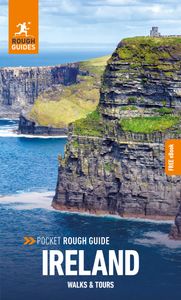
Find even more inspiration here

Planning your own trip? Prepare for your trip
Use Rough Guides' trusted partners for great rates
written by Rough Guides Editors
updated 06.06.2021
Ready to travel and discover Ireland?
Get support from our local experts for stress-free planning & worry-free travels.
- Travel advice
- Where to stay
TTC family of brands
My Trafalgar
Destinations
Get Inspired
866 513 1995
Northern Ireland

See All Northern Ireland Tours
Trending Northern Ireland tours
Save up to $562
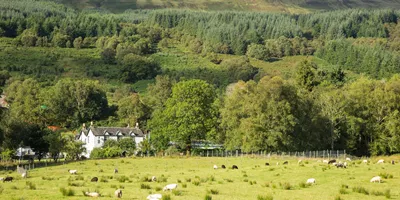
Best of Ireland and Scotland
21 Locations
3 Countries
Travel to see the very Best of Ireland and Scotland, from delicate Waterford Crystal to the golfing greats of St. Andrews. Kiss the Blarney Stone and you’ll be sharing tales from Giant’s Causeway, the Ring of Kerry and the Scottish Highlands for years to come.
Save up to $365
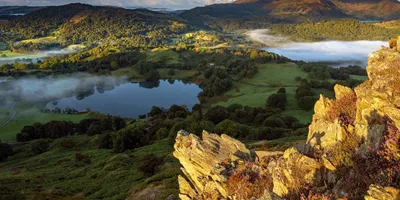
Britain and Ireland Highlights
15 Locations
5 Countries
Short on travel time but want to see all the Britain and Ireland highlights? This trip delivers the genius of Shakespeare, Waterford crystal creations in Ireland and a hearty Welsh dinner at a local vineyard, with a side of ancient history, in just 10 days.
Save up to $543
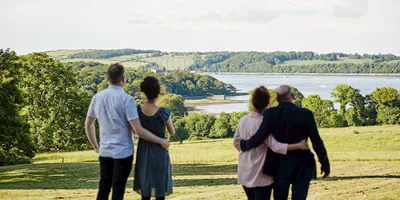
Irish Experience
2 Countries
Explore all the best the Emerald Isle has to offer on your trip filled with tales of mythical creatures and the troubled history of an island split in two. Beyond soul-stirring landscapes, there’s time with a local ‘Cabbie’ who’ll guide you through Belfast.
Save up to $506
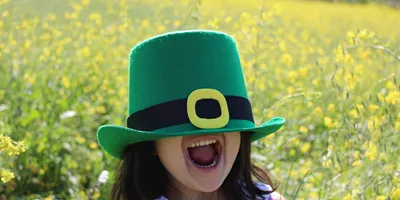
Shamrocks and Leprechauns
13 Locations
A favorite Ireland trip for families combining happy travels with the luck of the Irish. Find your own pot of gold at the end of the rainbow, cuddling sheep on the Wild Atlantic Way. Ever wondered if boats can fly? See it firsthand in Foynes, all with no schoolbooks in sight.
See More Ireland Trips
5 million happy guests and counting
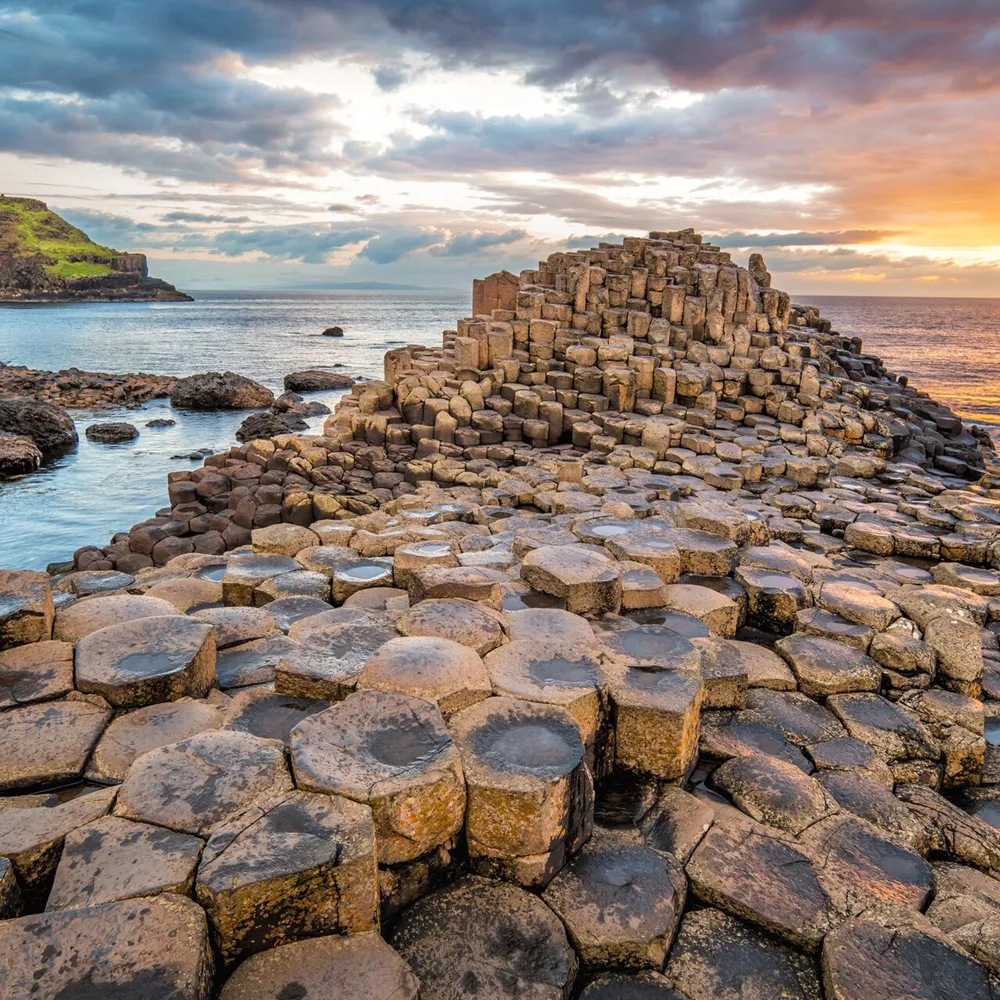
Pound sterling
Capital City
Good morning
Good Morning
Good evening
Good Evening
"From the stunning, secluded lakes of Fermanagh to the monumental steps of the Giant's Causeway, Northern Ireland affords luscious green scenery, charming countryside, vital cities and friendly locals"
Emma, Travel Director

See the City Hall in Belfast
Originally built to celebrate Belfast’s new status as a city, the City Hall is one of the most beloved Belfast tourist attractions. We’ll show you around this grand monument to history, or you can relax on the grassy grounds, with the Belfast Wheel in the background.
Walk on the Derry City Walls
We’ll take you on a journey through history to the Derry City Walls, one of the most historically important places to visit in Northern Ireland. Surrounding the old city center of Derry, the city walls are a 17th-century fortification with panoramic views of the region. Incredibly, most of the original structure is still standing.
Feel the Irish Spirit at St George's Market
Completed in 1896, St George’s Market is the last surviving Victorian market in Belfast and one of the oldest Belfast attractions. There are markets every Friday and Sunday and you can explore local produce, secondhand treasures, traditional arts and crafts, Irish homewares, and live music in this beautiful building.
Explore the town of Donegal
With its wild mountains, sandy beaches and glittering lakes, Donegal is one of the most remarkable places in Europe. The scenic highlight of any Northern Ireland travel experience, we’ll take you through pretty Donegal Town, with a serene harbor, the 15th-century Donegal Abbey and the ancient Donegal Castle.
Admire 40,000 basalt columns at Giant's Causeway
Take a drive with Trafalgar up the gorgeous Antrim coastal road to the Giant’s Causeway, where you can see the natural spectacle of 40,000 interlocking basalt columns. It’s one of the most iconic things to do in Northern Ireland, and your trip will also ‘Make a Difference' by helping to preserve this natural wonder.
Our top 5 things to do in Northern Ireland
We show you the best things to do in Belfast and beyond, from the ancient Derry City Walls to the spectacular natural columns of the Giant’s Causeway.
Ulster Museum
Located in the Botanic Gardens in Belfast, the Ulster Museum is a vast display of fine art, botany, geology, culture and local and European history. It’s the largest museum in Northern Ireland with everything from dinosaur skeletons to an ancient Egyptian mummy.
The Titanic Belfast is an incredible museum, dedicated to telling the story of the Titanic, from her design and construction in Belfast in the early 1900s to her disastrous voyage. Located in the Belfast docklands, where the original Titanic was launched, you can explore over nine interactive galleries.
Downpatrick
Down County Museum
We’ll take you back through 9,000 years of history at the Down County Museum, a former prison now dedicated to documenting the history of Downpatrick. You can visit the original cells used to house prisoners in the early 1800s, and learn the legendary history of St Patrick, the patron saint of Ireland.
Best museums in Northern Ireland
Our Belfast tours take in the best museums and galleries in Northern Ireland. See an ancient Egyptian mummy at the Botanic gardens and discover the vivid history of the Titanic.
Ardglass potted herring
This classic Northern Irish dish consists of Ardglass herrings rolled in a dish with vinegar, spice berries, raw onions, salt and pepper. It’s baked until the top of the fish becomes crispy, then served with crusty bread and butter to mop up the tasty juices.
One of the most well-loved dishes in Northern Ireland, Ulster fry is a traditional cooked breakfast with griddle breads (potato bread and soda bread fried until golden), small pancakes, bacon, eggs, sausages, tomatoes and mushrooms, served with tea and toast.
Traditionally found in the north midlands such as Fermanagh and Donegal, Boxty is a Northern Irish potato pancake made with a blend of grated raw potatoes and cooked mashed potatoes with flour and buttermilk. Served with a smear of butter, this is a delicious favorite.
Best food in Northern Ireland
Our trips will let you in on the best places to try Northern Irish cuisine, filled with grilled bread, potato pancakes, bacon and sausages, and generous dollops of creamy butter.
What to pack for Northern Ireland

Water and windproof jacket
Northern Ireland is one of the wettest and windiest regions in Europe, with temperatures averaging just 15°C (59°F) in summer. Stay cosy with a sturdy jacket and warm layers.
A big appetite
With a hearty cuisine filled with delicious breads, meats, pancakes and potatoes in every form, you’ll need to bring your appetite for a tour of Northern Ireland.
Although the Republic of Ireland (the southern partition of Ireland) uses the Euro, Northern Ireland uses the Pound sterling, so you’ll need to change currencies at the border.
An adaptor plug
Voltage in Northern Ireland is 230V, and the sockets are of Type G, with standard British 3-pin plugs.
Northern Ireland is undoubtedly one of the most beautiful places in the world, and you’ll want to bring a camera to capture all of this wild beauty.
Pack for sustainable travel
Consider your environmental impact when you next take a trip and go single-use-plastic-free by packing a reusable water bottle, a steel straw, your own shopping bags and reusable toiletry bottles.
Our Europe & Britain destinations
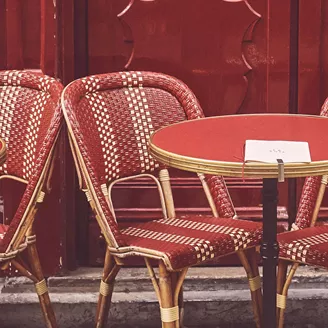
Bosnia Herzegovina
Czech Republic
Liechtenstein
North Macedonia
Netherlands
Switzerland
Other worldwide regions we visit
Africa the Middle East
Australia and New Zealand
North and Central America
South America
Get your free brochure
Find your next escape with the world's leading travel brand
Request A Brochure
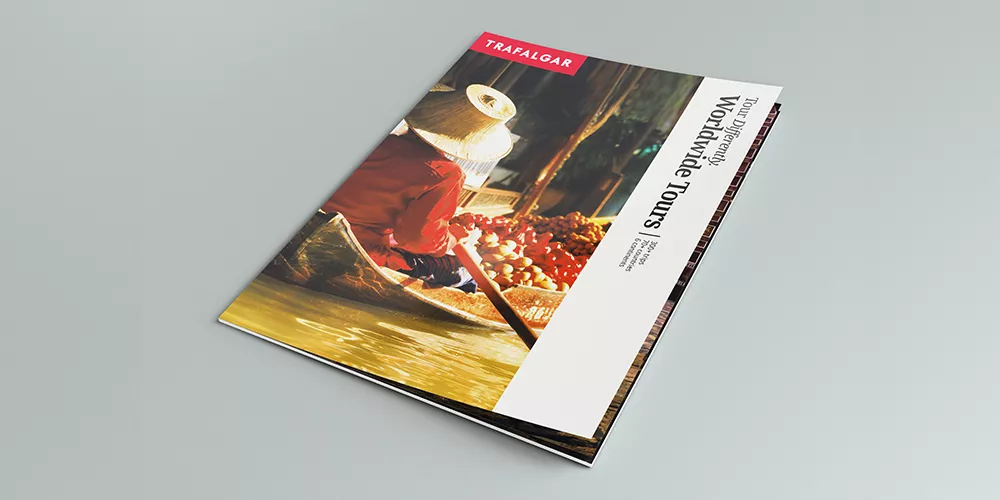
Award winning tours
Every year, we're proud to win some of the most prestigious travel accolades around the world - from the Travel Globes to the Agent's Choice Awards
Search Our Tours
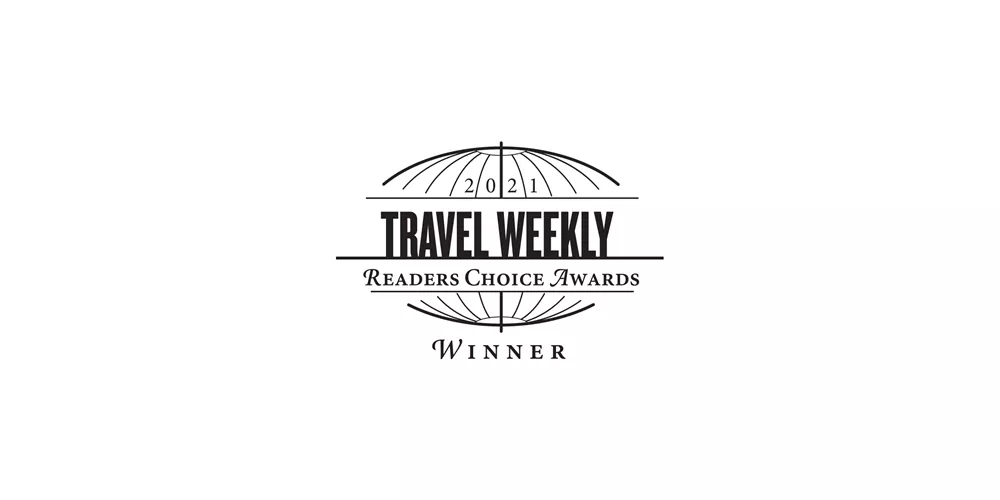
Help & Info
WE MAKE TRAVEL MATTER®
Unedited Reviews
Our Destination Management Companies
Frequently Asked Questions
Travel Updates
Do Not Sell or Share My Personal Information
Travel Planning
Get Your Free Brochure
Travel Insurance
Booking Conditions
Trip Deposit Level
Recommendations
Trafalgar Tours Limited is a proud member of The Travel Corporation family of companies.
#SimplyTrafalgar
Travel House, Rue du Manoir St Peter Port, Guernsey, GY1 2JH
Selected Region
United States
United Kingdom
New Zealand
South Africa
Copyright 2024 Trafalgar. All rights reserved.
Terms and Conditions
Privacy Policy
Cookie Policy
- Search Please fill out this field.
- Manage Your Subscription
- Give a Gift Subscription
- Newsletters
- Sweepstakes
- Destinations
Why Now Is the Time to Visit Northern Ireland — Plus Where to Eat, What Do, and Places to Stay
Nearly 25 years after the Troubles, Northern Ireland’s scars are finally beginning to heal. Here's a guide to the best of the country right now.
:max_bytes(150000):strip_icc():format(webp)/Boris-Fishman-2000-0e85f853c1404294976e26ef90c2ee43.jpg)
Northern Ireland. What do those words bring to mind? Recently, I put the question to two American friends. “The Troubles,” said the first. “The Troubles,” said the other.
They were referring to the sectarian violence between largely pro-Britain, Protestant Unionists and largely pro-Ireland, Catholic Republicans that made Belfast a deadly place from the 1960s to the 90s. Riots, bombings, clashes between paramilitary forces, and attacks by the British army killed more than 3,500 before the 1998 Good Friday Agreement brought a tentative peace.
Having been born in the former Soviet Union, I’ve always been drawn to places known more for political headlines than for tourism. There, I’ve often discovered underappreciated destinations rather than security problems. Over the past few years, I had been hearing that things were changing in Ulster. I began to wonder if Northern Ireland was another of these secret marvels, waiting for the world to notice how outdated our assumptions about it had become. So I decided to plan a trip.
Simon Watson
My first stop in Belfast was the resplendently Victorian Merchant Hotel , a former bank with a soaring lobby that now survives as the Great Room, the restaurant where my eggs and croissants vanished under the beatific gaze of golden-faced cherubs mounted on colonnades. The Merchant’s conversion, in 2006, into a world-class hotel epitomizes the transformation of Belfast’s Cathedral Quarter, the elegant, cobblestoned heart of downtown. During the Troubles — when the threat of bombing, particularly in densely populated areas, was constant — the Quarter was all but deserted, a testament to former glory. Today, it is an international destination for dining and design.
As I met artists, farmers, lords, chefs, and Troubles survivors, the Northern Irish character came to feel like a glorious paradox: the warmest and least sentimental people I’d ever met.
But this cosmopolitanism hasn’t rubbed the edge off what makes the Quarter so different. The poetry, surely, is part of it. Northern Ireland gave the world the poets Seamus Heaney, Paul Muldoon, and Louis MacNeice, and I navigated the Quarter’s uneven stones surrounded not by international retailers, as in so many other European capitals, but by doorways and railings adorned with poems stenciled onto metal panels. The unsanitized view of the Troubles presented in the ubiquitous political murals — interrogations, protest marches, the bloody aftermath of a bombing — amplifies the sense of having wandered into a tourist district from a very different kind of brochure.
As I walked around, I came to a wall emblazoned with a poem by the early-20th-century Northern Irish writer Raymond Calvert, about a gentleman driven to such insanity by his “curse” of a wife that he slashes her throat, but then, in remorse, hangs himself with a sheet. “But the strangest turn to the whole concern/Is only just beginning,” the last stanza declares. “He went to Hell but his wife got well/And she’s still alive and sinning./For the razor blade was German made/But the sheet was Belfast linen.”
A Northern Irish accent, during the Troubles, “would make people edge away from you on the London Tube,” Kieran Gilmore, a cultural organizer, told me. That sense of inferiority has given way to the unapologetic pride, leavened by gallows humor, epitomized by Calvert’s comic poem. As I met artists, farmers, lords, chefs, and Troubles survivors, the Northern Irish character came to feel like a glorious paradox: the warmest and least sentimental people I’d ever met.
Belfast is small, and visitors don’t have to walk far for the Quarter and its polish to give way to areas with less evolved views on the Troubles. I took that walk with a guide named Colm McBrierty . As a musician during the Troubles, McBrierty, who has a recognizably Catholic surname, listed himself as Colin Smith so he could play in bars in Protestant areas. In 1972, his mother missed a weekly lunch date at the Abercorn Restaurant in the city center and, by doing so, avoided a bomb that killed two and injured 130.
More Trip Ideas : 8 Most Scenic Train Rides In the U.K.
A walk through West Belfast, where you need the eyes of a native to understand that you’ve crossed from a Unionist street to a Republican one, is a bracing reminder of how intimate the sense of violence must have been. McBrierty and I stopped by a “peace wall” set up by the British government — a euphemism for a barrier between the communities. The Unionist side features quotes by the Dalai Lama and work by local artists. The Republican side has nothing but barracks-green paint. In both Unionist and Republican areas, we saw murals commemorating victims, but also murderers. (In one, thanks to a chilling visual effect, the muzzles of rifles held by two painted men in balaclavas seemed to follow us as we drove past.) But we saw just as many murals by community groups urging reconciliation.
McBrierty suggested that neither side had sole claim to the truth. “There are two cultures on this island, and both have to be respected — that’s the short of it,” he said. He was both clear-eyed and optimistic. “These disagreements won’t end for a couple of generations,” he said. “People died too recently. But we’ve come a very long way.” McBrierty and his wife, a Protestant, sent their children to an “integrated” school. “People say, ‘Are you Catholic or Protestant?’ ” McBrierty said. “I say I’m an Ulster man.”
I thought of McBrierty’s unvarnished eloquence when I had dinner at Wine & Brine , in the village of Moira, in County Armagh, a 20-minute drive southwest of Belfast. Chris McGowan, the chef, cooked in London for 20 years before deciding to return to Northern Ireland with his family in 2014. “We came back for the people,” McGowan said. “People here are so genuine. They’ve gone through so much. And it’s such an exciting food scene at the moment.”
Wine & Brine is a family affair in multiple ways: McGowan’s wife, Davina, manages the front of the house, and the restaurant draws as many couples on dates as multigenerational family outings and retirees on weekly lunch engagements, giving the place an easygoing quality that belies the ambition of the cooking. (That day, the chef was serving pig’s-head doughnuts with malt vinegar and smoked eel from Lough Neagh, just west of Moira.)
The feeling is similar at Noble , a dark-walled 26-seat restaurant with a kitchen the size of a phone booth, in Holywood, just outside Belfast. Chef Pearson Morris raids the fields and waters that make the Northern Irish larder so bountiful: I had a tartare of local beef with gribiche sauce; lamb shoulder with curry oil and mint raita; and a weightless halibut with chanterelles in a roasted-bone sauce. But it was co-owner Saul McConnell’s service — warm and unobtrusive, but with a sense of occasion — that made the evening. Noble was the recipient of the Michelin Guide’s 2021 Welcome & Service Award. Belfast has three Michelin-starred restaurants, but the best meals I had were at restaurants like Wine & Brine and Noble, which cook for the neighborhood as if it were a global stage.
McGowan and McConnell are part of a growing number of entrepreneurs creating things the country hasn’t seen before. For instance, the creative director Ryan Crown had a thriving career in Brooklyn when he came home for a visit at the start of the pandemic. He encountered a Belfast transformed, with so much demand in his field that he stayed. One of his earliest endeavors was Hill Street Hatch, a Cathedral Quarter incubator that was set up to help local entrepreneurs with marketing and branding. Its first project was the Toast Office , a grilled-cheese shop whimsically designed to resemble an old British post office. It became an Instagram sensation.
A deep feeling for the land is, perhaps, one of the few things that unites virtually every soul in the country. No trip to the countryside would be complete without a glimpse of the legendarily beautiful North Coast .
Around the corner on Donegall Street, Richie Stokes and Gareth Young run Never Never , a shop for skater fashions created on the counterintuitive premise that the city’s young people prefer to buy their hoodies from human beings instead of algorithms. On Little Donegall Street, Mike Thomson slings farmstead cheese from small Irish and Northern Irish producers at a shop whose name, Mike’s Fancy Cheese, sends up in classic Irish fashion the solemnity with which certain shops sell artisanal goods.
To experience the unassuming creativity of Belfast’s young entrepreneurs is to rediscover some of the wonder we’ve lost in places where creativity has become commodified. That they live in a city that remains affordable enough for them to lease commercial spaces downtown is essential to that ferment. So is the fact that they borrow equally from British and Irish influence. As Colm McBrierty suggested, perhaps the right answer to the question “Britain or Ireland?” is: “Both.”
Midway through my stay in town, I relocated to the Titanic Hotel Belfast , a 25-minute walk east of downtown. Against all odds, this theme hotel is a thoughtful, stylish place of pewter accents and floor-to-ceiling windows that give out onto the shipyard where the Titanic was built. The hotel is next to the Titanic Belfast museum , opened in 2012, whose striking exterior of massive shimmering panels is home to impressively curated, immersive exhibits that manage to reclaim the story from Hollywood. But perhaps my favorite thing about the Titanic Quarter was the walk it required from the action downtown, across the river Lagan, which bisects the city before emptying into the Belfast Lough and the Irish Sea. Belfast’s intimate size and mash-up of Victorian and postindustrial spaces make it a flaneur’s delight. The British side of its charm includes Black English taxis. I never took one.
Related : The Best Time to Visit Ireland
Unlike those places where the capital city siphons off the best of the provinces, Northern Ireland’s transformation has also reached deep into the countryside. In the seaside town of Bangor, a half-hour’s drive east of the city, I met the cultural organizers Alison Gordon and Kieran Gilmore. The couple returned home from London after the Good Friday Agreement because they wanted to use the arts to help create a “new, shared Northern Ireland,” Gilmore told me. As they walked me around, sea brine in our lungs, they showed me what two decades of peace had allowed them to achieve.
Gordon and Gilmore pointed out murals by artists they’ve hosted (in one, the London artist Irony had given a crab the chef’s knife), performance spaces for a music festival they organize every year, and an abandoned courthouse that they are transforming into an arts center. “Dereliction is an opportunity,” Gordon said. “It’s not the end — it’s the beginning.”
If towns like Bangor have looked to the arts, the Northern Irish countryside owes its revival to the same elements that have sustained it since the beginning of time: rain and soil. In County Armagh, southwest of Belfast, entrepreneur Susie Hamilton Stubber of Burren Balsamics welcomed me into the country kitchen of my dreams, where the air was thick with the smell of the wheaten bread, a type of soda bread, that she had baked for our lunch. Here, Stubber and her business partner, the chef Bob McDonald, infuse vinegars, chutneys, marmalades, and piccalillis with local bounty as well as imports from Britain’s erstwhile empire: beets and cocoa nibs, Irish cherry, blood orange and cardamom.
The encounter of the Irish Sea and the North Atlantic nearby, Woods said, made for some of the best waves in Europe, still a relative secret among the Continent’s surfers.
McDonald spent 45 years cooking for the officers’ mess in the British army. (British officers eat well, he said — the cuisine was fit for a Michelin-starred restaurant.) For lunch, he finished a saddle of local venison, cooked sous-vide, by searing it in butter and some of Stubber’s garden thyme, as well as a stock of Pinot Noir reduced with a vinegar infused with blackberry and thyme. This arrived alongside a miniature lamb pie, foraged blackberries, white-currant jelly, and root vegetables. “It took some time,” McDonald said. “But people are beginning to realize that what we have is as good as anywhere.”
Even peers of the realm get in on the act, as I learned when I visited Ballywalter Park , a 270-acre estate where the unpretentious Lord and Lady Dunleath welcome visitors for tours. A lunch of local cheeses and Lord Dunleath’s own beet chutney culminated in a walk through the massive walled garden, which supplies some of Belfast’s best restaurants. “These are the pearly gates,” Lady Dunleath said as we approached the entrance, pheasants clearing out of our path, adding that paradise is Pashtun for walled garden. The couple grow edible calendula, black sunflowers, pinto peaches, gooseberries, Jerusalem artichokes, and more. “This was the 18th century’s supermarket,” she said. “When the newspapers are saying what they’re saying about climate change, you must look to your doorstep. The Irish Sea is 500 meters from here. I can have lobster from June to New Year’s Eve.” Ballywalter is in the process of going entirely off the grid, she told me.
A deep feeling for the land is, perhaps, one of the few things that unites virtually every soul in the country. No trip to the countryside would be complete without a glimpse of the legendarily beautiful North Coast . I explored it with the entrepreneur Portia Woods, who has turned her love of the region into a tour called Toast the Coast . As we drove along the craggy shoreline, the roar of the surf seemed to intensify instead of becoming familiar. On the sweep of Benone Strand Beach, Woods set up a picnic of soda-bread crostini, apple butter, and kelp pesto. Under a cold sun, we listened to the thundering waves on repeat: crash, hiss, repeat. The encounter of the Irish Sea and the North Atlantic nearby, Woods said, made for some of the best waves in Europe, still a relative secret among the Continent’s surfers.
Our most moving stop was the speck-sized town of Portstewart, where Woods introduced me to Stevie McCarry, who runs Native Seafood & Scran with his wife, Rebekah. Like so many in Northern Ireland, McCarry grew up without pride in the natural riches around him. “Back in the day, if you came to school with lobster in your lunch, another kid would give you their milk because they felt bad for you,” he said. As a young man, he moved to Thailand. “We all went to the far side.”
But at some point, McCarry started to understand what he’d left behind. He and Rebekah opened Native out of a frustration that Northern Ireland’s best catch was going to France rather than staying at home. Their offerings are so fresh that the shop has no microwave or freezer. As an experiment, I ordered the plainest-seeming thing on the menu: a roasted-salmon salad. Decorated by nothing save lightly dressed greens, the salmon was elementally, profoundly flavorful.
“We’re all starting to understand what we have,” McCarry said.
A Northern Irish Journey
Where to stay.
Culloden Estate & Spa : Located just outside the capital, this former bishop’s palace has views of Belfast Lough and an unmissable afternoon tea.
Galgorm : This resort, in the town of Ballymena, is home to a spa “village” with so many steam rooms, waterfalls, plunge pools, and hot tubs that it’s almost impossible not to get blissfully lost.
The Merchant Hotel : A prime example of Belfast’s Victorian splendor enlivened by a bit of contemporary style. Don’t skip its cocktail bar.
Titanic Hotel Belfast : Located by the Titanic museum and the shipyard where the ocean liner was built, this elegant hotel evokes the high style of the Gilded Age.
Where to Eat and Drink
The Duke of York: The flagship of the pubs owned by entrepreneur Willie Jack; he’ll give you a proper pint and a monologue for the ages. Stop by his whiskey shop, the Friend at Hand, around the corner.
Home : Situated on an ordinary Belfast block, Home is one of those unicorn restaurants of wild imagination and flawless technique that still manages to feel like your neighborhood bistro.
Noble: Electric cooking from a tiny kitchen and unfussy, festive service are the highlights of this low-lit restaurant in Holywood, just outside Belfast.
Wine & Brine : Chris McGowan cooked in London for 20 years before returning home to Belfast to take advantage of the glory of his native fields and waters, which can include smoked eel or turbot caught that morning.
Ballywalter Park: When they’re not lending their 270-acre estate out to film crews, Lord and Lady Dunleath host tours of their property, with its endless fields, 18th-century walled garden, and epic solarium.
Spectrum Cars: This chauffeur company offers a tour of Belfast’s Troubles that’s anything but canned, especially if Colm McBrierty is your guide.
Titanic Belfast: This immersive, informative museum in a gorgeous Modernist building provides a clear-eyed look at the famous ship’s tragic history.
Toast the Coast: The entrepreneur Portia Woods has turned her love of the North Coast into an exhilarating tour of spectacular landscapes and innovative projects by local proprietors.
Where to Shop
Armagh Cider: The only blossom-to-bottle cider operation in Northern Ireland. A three-course lunch is served to those who book a tasting of ciders, vinegars, and tonics.
Bound: A home-décor store in Belfast that showcases boundary-breaking Northern Irish and European designers.
The Bureau Belfast: Cool menswear from such indie brands as Engineered Garments and Arpenteur.
Burren Balsamics: In County Armagh, the entrepreneur Susie Hamilton Stubber and former military chef Bob McDonald infuse high-end Italian vinegars with Bramley apples, cocoa nibs, and other surprises. See if you can score a peek inside Stubber’s country kitchen.
Never Never: Undeterred by a recent fire, this skater-style shop is selling its wares online while it prepares to reopen.
How to Book
Siobhan Byrne Learat , a member of T+L’s A-List of top travel advisors, can orchestrate a journey across Northern Ireland that encompasses five-star hotels, walking tours of Belfast, and visits to the artisanal producers who are transforming the country’s culinary scene. Email: siobhan@adamsandbutler.com.
A version of this story first appeared in the December 2022/January 2023 issue of Travel + Leisure under the headline "Come One, Come All ."
Related Articles
14 Places To Visit In Northern Ireland
Categories Antrim , Londonderry , Where To Go
Over the years, Northern Ireland has slowly emerged as a fascinating tourist destination. That’s with the help of the new Titanic Museum , and being featured as a setting in the hit fantasy series, Game of Thrones .
Northern Ireland is a small country and it’s part of the United Kingdom. Still, it is never lacking in things to see and do.
A lot of its attractions are pretty extraordinary, too.
From charming medieval towns to lake islands, stunning castles and dramatic coastal landscapes— these are some of the places to visit in Northern Ireland.
Things you'll find in this article
14 Places To Visit In Northern Ireland
1. giant’s causeway, co. antrim, 2. causeway coastal route, northern ireland, 3. carrick-a-rede rope bridge, co. antrim, 4. dunluce castle, co. antrim, 5. the glens of antrim, northern ireland, 6. the dark hedges, northern ireland, 7. mussenden temple, co. derry, 8. londonderry, northern ireland, 9. belfast, northern ireland, 10. titanic museum, 11. carrickfergus castle , 12. newcastle, northern ireland, 13. lough erne, northern ireland, 14. the ulster folk and transport museum.

Giant Causeway, Image by Christine Rogador
Exquisite, dramatic, awe-inspiring. It’s easy to run out of ways to describe the Giant’s Causeway , but one will always find more reasons to go back.
Comprised of 40,000 polygonal basalt rock columns, this stunning natural wonder stretches along the coastline like giant stepping stones. These were created by a volcanic eruption that took place 60 million years ago.
These layered basalts are known around the world and are the prime focus of a designated Area of Outstanding Natural Beauty.
The Giant’s Causeway is also the only UNESCO World Heritage Site in Northern Ireland.
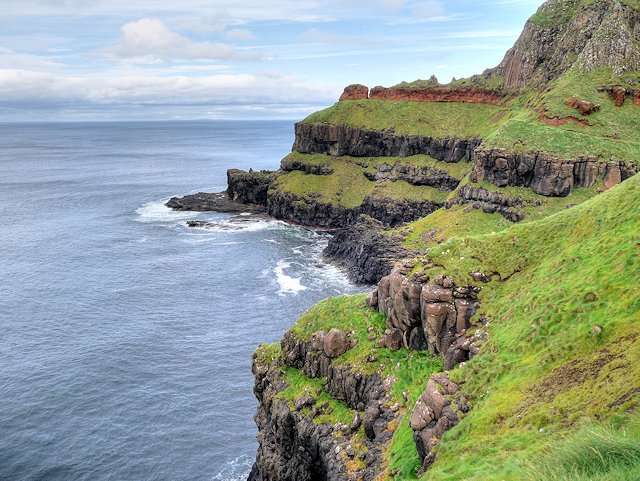
The Causeway Coastal route is easily one of the most scenic drives in Ireland.
This is essentially the surrounding coastline to the Giant’s Causeway, an extraordinary experience that you shouldn’t miss. The drive only takes ten minutes, but you can always slow down as you take in the sights.
The stunning beaches , the sand dunes, the rolling waves as you pass Portrush and Portstewart. This drive is stunning any time of the day, but it’s best to do it at sunset as the sights are particularly breathtaking.

Carrick A Rede, Image by Christine Rogador
If you’re in for an adventure that also lets you enjoy the stunning views, cross the Carrick-a-Rede Rope Bridge.
Found in County Antrim, this rope bridge links the mainland to the island of Carrickarede. The bridge spans 66 feet and about 98 feet above the rocks below.
The Carrick-a-Rede Rope Bridge is mainly a tourist attraction and not an official means to get to and from an island.
It’s quite a thrilling adventure to cross it and a must experience when in Northern Ireland. It is also one of the best day trips from Belfast .

Dunluce Castle, Image by Christine Rogador
Located in the North Antrim Coast is the brooding and dramatic Dunluce Castle . It is situated close to a headland and used to be the headquarter of the McDonnell clan.
This medieval castle maybe mostly ruins but at least we know now that a village used to surround the castle. This village was destroyed by fire in 1641. Dunluce Castle was featured in ‘Game of Thrones’ as the castle of Greyjoy.
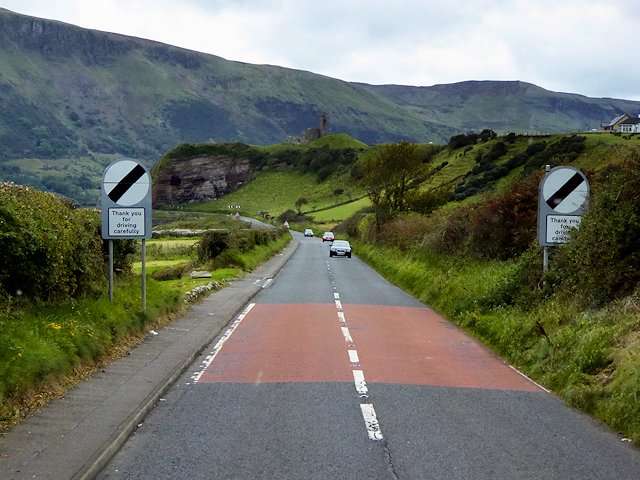
The North Antrim may have some stunning otherworldly sights, but its nine glens are not to be upstaged.
These are among the most breathtaking places you’ll ever see. These nine glens even exude a unique individual charm that you simply lust to spend time here when you visit.
A great way to see the glens is by driving along the main A2 coastal road, where you get to enjoy a closer look at the lakes, waterfalls , rolling hills and forest trails.
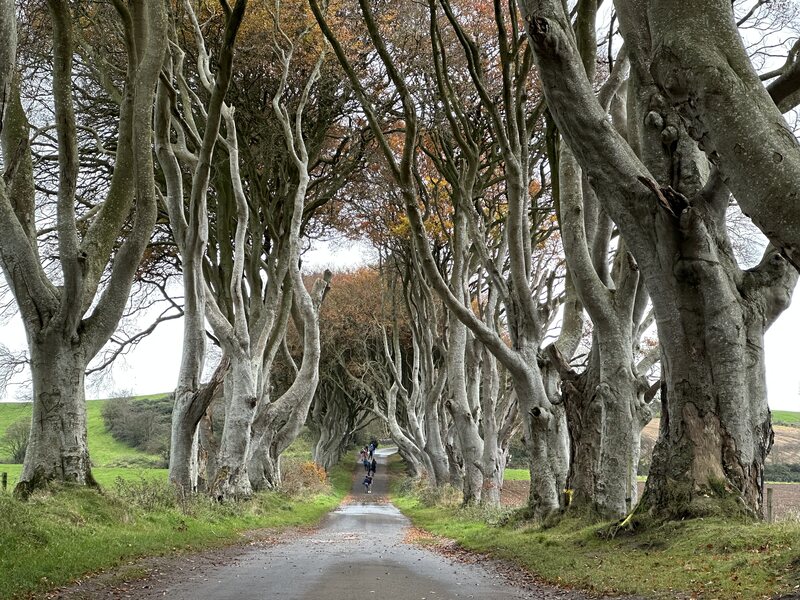
Dark Hedges, Image by Christine Rogador
The Dark Hedges is undoubtedly one of the most photographed and truly iconic sights in Northern Ireland. This natural attraction was featured in a few episodes the hit fantasy TV series ‘Game of Thrones as the road to King’s landing.
The best time to go here is in the morning, preferably before eight in the morning to avoid the crowds.
Aside from being a popular photography subject and tourist attraction, the Dark Hedges is also now a favorite location for wedding photographs.

The beautiful and dramatic location of Mussenden Temple made it an ideal setting for a rather horrifying scene in ‘Game of Thrones’.
Perched 120 feet high on a rugged clifftop, the temple overlooks the Atlantic as well as the Downhill Strand towards Magilligan Point. The views from here are spectacular, a definite must-visit when in Northern Ireland.
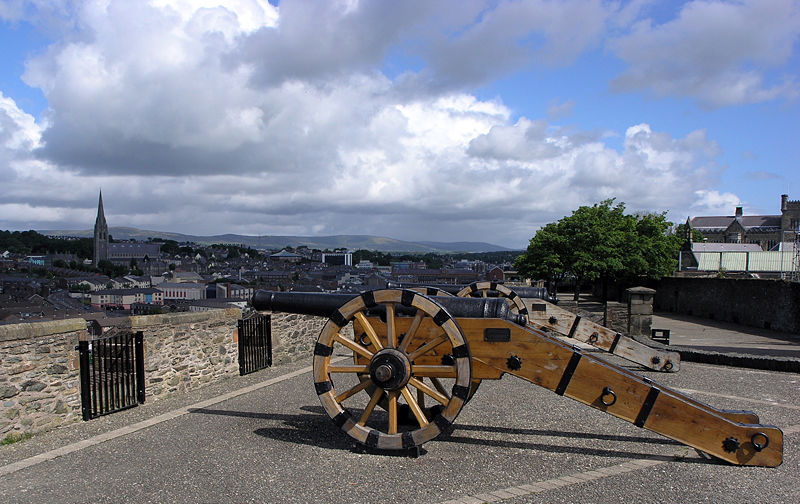
Londonderry or simply Derry is the second city in Northern Ireland. It is located where the River Foyle opens out into the sea-lough of the same name.
Derry is known to have brilliantly preserved medieval walls as well as some interesting old buildings. It is now an important port and industrial center. Its main industries include textiles and ceramics.
The town’s gorgeous surroundings also make it an ideal base to explore the Inishowen Peninsula and Donegal in the Republic of Ireland. Both places are known to be ideal sights for chasing the northern lights

Exploring Belfast is a definite must when in Northern Ireland.
There’s just a lot to see and do here — from the Titanic Museum and HMS Caroline to a hike up a castle on a hill.
Other places that should be in your Belfast itinerary are the Belfast Cathedral, the Belfast City Hall, the Botanical Gardens and the Crumlin Road Gaol,

Titanic Museum in Belfast, Image by Christine Rogador
This place is in Belfast but deserves a separate post. One should definitely devote ample time to visiting this stunning museum. It opened in 2012 during the centennial of the sinking of the Titanic, but the building is already an iconic Belfast landmark .
Located in the middle of the Titanic Quarter, the museum features extensive displays and collections on everything Titanic. They’re all interactive, too.
A visit here is a great way to learn more about this intriguing part of Northern Ireland’s history.
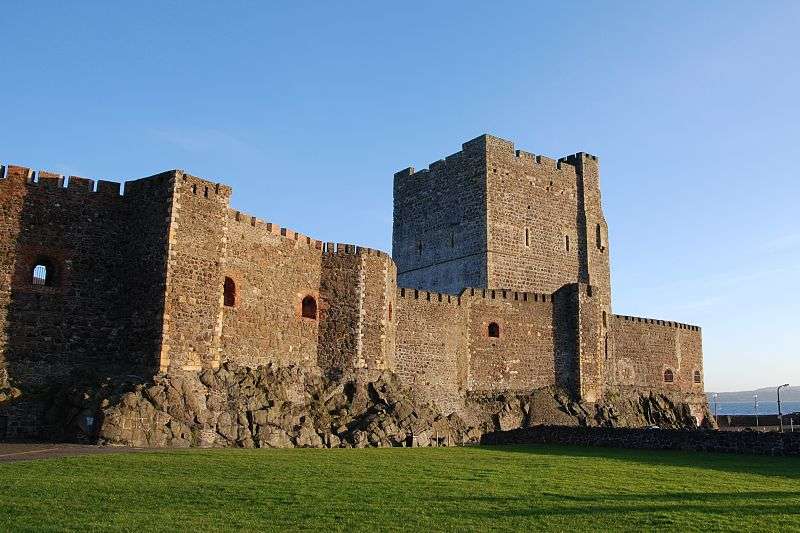
The imposing Carrickfergus Castle is one of the best-preserved medieval structures in Ireland.
Constructed over eight hundred years ago, it has been a witness and a target during war, conflict, and revolutions. It is nestled near the shore and still mostly intact.
The facade of the church set against its interesting location is already a treat in itself. Its namesake town is also a lovely place to explore.
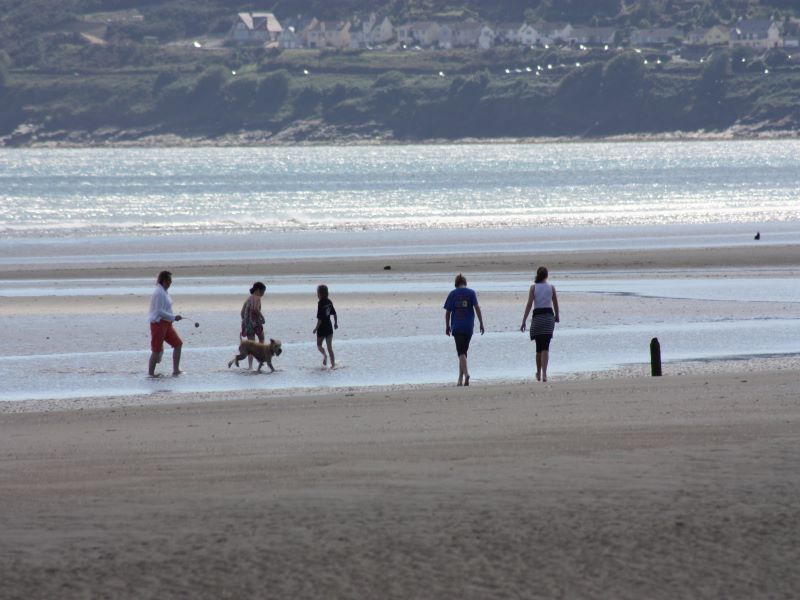
The charming town of Newcastle in County Down is a perfect seaside escape. The water may be colder than usual but the pristine beach is worth a leisurely stroll.
Or you can check out the incredible sand dunes at Murlough Beach. The seafront is lined with quaint shops and restaurants that serve up delicious local and international cuisine.
Newcastle also has the beautiful Mourne Mountains, which is a relatively manageable hike. This small town is also known to have the best golf course in all of Northern Ireland .
Get in for a few swings, or if you know nothing about golf, try the crazy version instead.
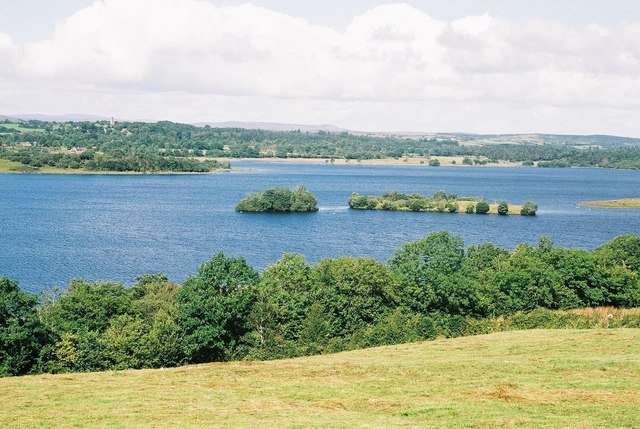
Lough Erne might as well be a living museum. Comprised of two connected lakes and islands, this part of County Fermanagh is a must-see.
See the castles and manor houses spread along the shore. See the 12th century round tower in one of the islands. Or how about some Celtic art?
Head on to White Island and Boa Island and see the carved stone figures done over a thousand years ago.
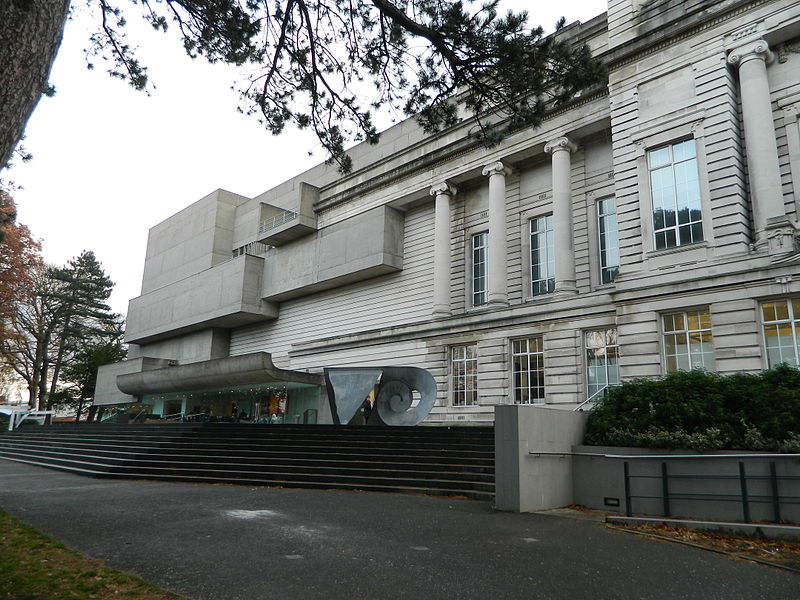
The Ulster Museum is easily accessible within a fifteen-minute drive from Belfast city center. This is a living museum that showcases the fascinating Ulster life more than 100 tears ago. Being here is like being sent back in a bygone era.
You get to walk around a village, explore a parkland or even get on steam locomotives. This place is an amazing glimpse at a life that we only read about in books.
Seeing them up close is a Northern Ireland experience that one shouldn’t pass up.
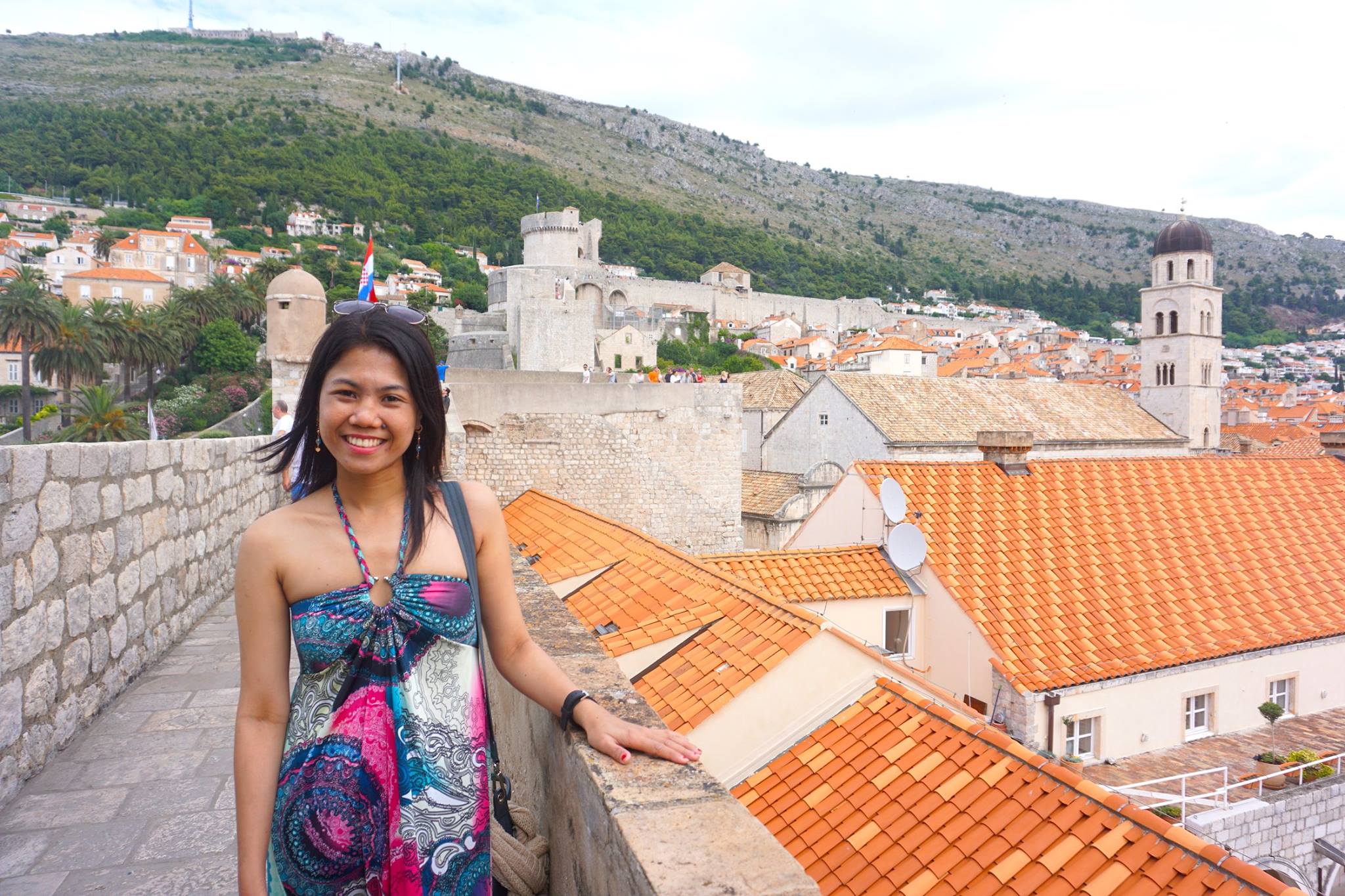
Hi, I’m Christine – a full-time traveler and career woman. Although I’m from the Philippines, my location independent career took me to over 40 countries for the past 8 years. I also lived in 3 continents – from the Caribbean, South East Asia to Africa. But despite living in several countries, my love for Ireland remains the same. A country that had been a part of my life since I was 14 because of my love for Irish music and bands. Ireland Travel Guides was born because of this passion and hopefully, in some little ways, this website will be able to help you on your next trip to Ireland.
Counties of Ireland Guide And Map - Ireland Travel Guides
Sunday 19th of September 2021
[…] divisions used, along with its boroughs. The Republic of Ireland is divided into 26 counties while Northern Ireland comprises 6 […]
Facts About Ireland - 25 Interesting Things About Ireland - Ireland Travel Guides
Monday 14th of June 2021
[…] only one ‘isle of Ireland’ but it is divided into two parts: Northern Ireland and the Republic of Ireland. Northern Ireland is under the United Kingdom, while the Republic of […]

Northern Ireland Travel Guide: 24 Things to Do in Northern Ireland!

I’m excited to share with you my Northern Ireland Travel Guide! It features 24 incredible things to do for every hour of the day.
I recently travelled to Northern Ireland with the sole purpose of tracking down 24 amazing moments travellers can experience …one for each hour of the day.
My very first trip a few years back had been spent exploring Belfast and venturing up to the Causeway Coast on a day trip , but I had left barely scratching the surface. That’s why I was thrilled to be coming back to Northern Ireland, this time with plenty of time to spare and an itinerary that would take me across the country.
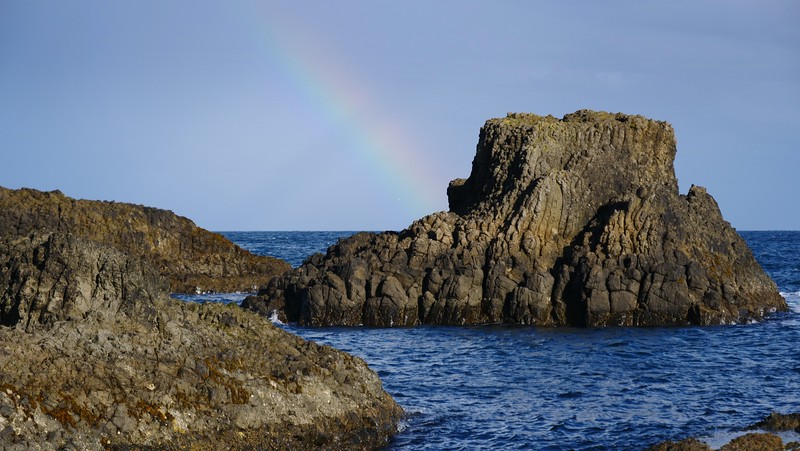
So, why do travelers love visiting Northern Ireland? It’s a combination of breathtaking landscapes, rich history, warm people, thrilling adventures, and, of course, the delicious food. But what truly makes Northern Ireland stand out are its people. Warm, witty, and always ready with a story, they make you feel at home.
From food tours to Game of Thrones experiences , and coastal walks to haunted castle visits, here’s a little taste of things to do and what I experienced in this Northern Ireland travel guide.
Things to do in Northern Ireland: 24 Amazing Experiences!
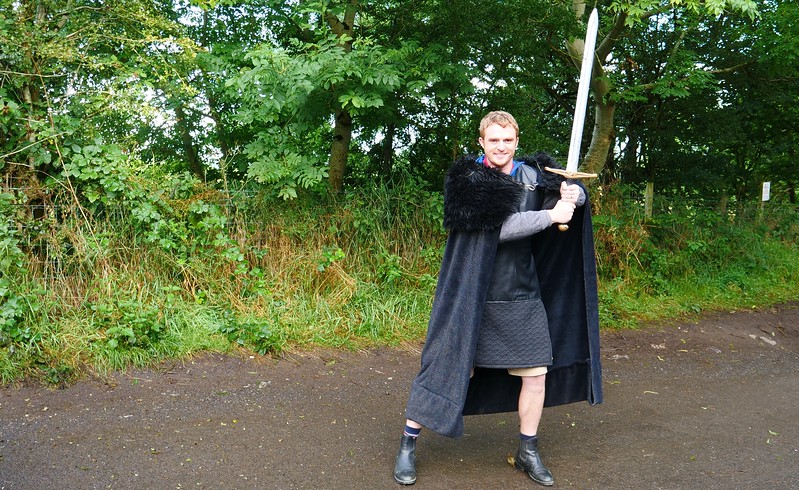
#1 01:00 – Have cocktails at The Merchant Hotel
One of my things to do in Belfast was having a cocktail at The Merchant Hotel. With an elegant and classy atmosphere that isn’t pretentious, and a jaw-dropping selection of cocktails, it’s easy to see why this cocktail bar was voted best in the world by Tales of the Cocktail. It’s a fun spot to either end the evening or kickstart the night depending on your style.
The Merchant Hotel whispers tales of its storied past from every corner. Originally built as a bank in the 19th century, its transformation into a luxury hotel has been nothing short of spectacular. The architecture alone is a feast for the eyes. It features a stunning façade and exquisite interiors that pay homage to its heritage. Think grandiose marble, soaring ceilings, and opulent decor that transport you to a bygone era.
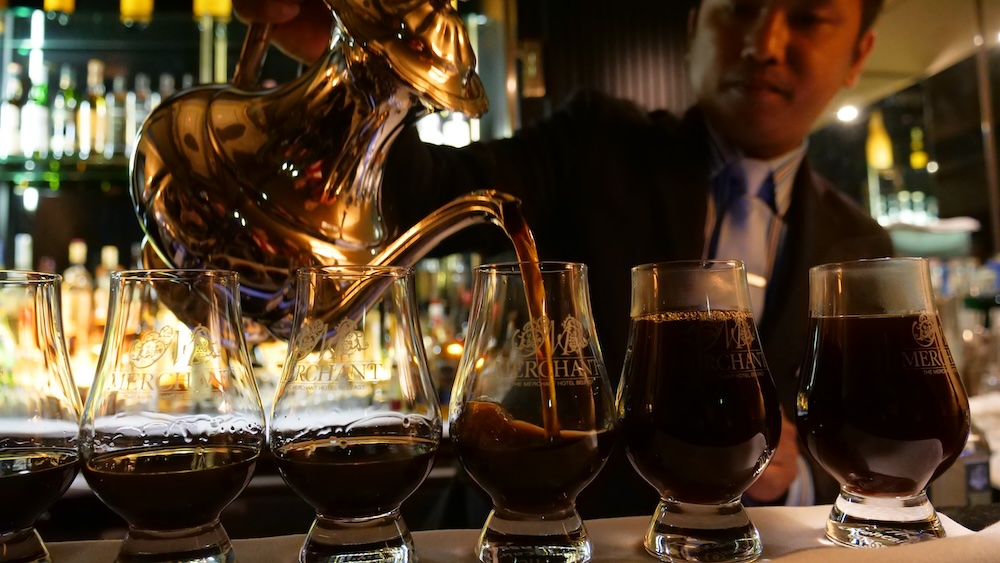
Location, location, location – the Merchant Hotel boasts an enviable one. Situated in the Cathedral Quarter, it’s the perfect base to explore Belfast’s rich tapestry of culture, history, and entertainment. Cobblestone streets, buzzing pubs, galleries, and shops are just steps away.
What truly sets the Merchant Hotel apart, though, is its unparalleled service. I felt like I was treated like royalty. The staff goes above and beyond to ensure you feel right at home whilst sipping on your cocktail.
Location: Merchant Hotel – Address: 16 Skipper Street, Belfast
#2 02:00 – Enjoy the nightlife at The Bullitt Hotel
Additionally, Belfast has legendary nightlife and after hitting up a few pubs I finished the night at Bullitt Hotel where there was a live DJ set. This was another lively spot with great cocktails, so come thirsty!

When the sun dips below the horizon in Belfast, the city doesn’t sleep; it comes alive for travelers and locals alike! There’s something absolutely magical about the atmosphere of Belfast’s nightlife. I would describe it as vibrant, diverse, and, frankly, a lot of fun. You’ve got pubs. You’ve got discos. And everything else in between.
Whether you’re in the mood for a quiet pint, a night of dancing, or simply soaking in the ambiance of this lively city, Belfast delivers. It’s not just the places or the activities; it’s the feeling of being welcomed into a community, of experiencing the city’s heartbeat at its most vibrant. That’s why travelers find themselves falling in love with Belfast after dark, time and time again.
Location: Bullitt Hotel – 40a Church Lane, Belfast
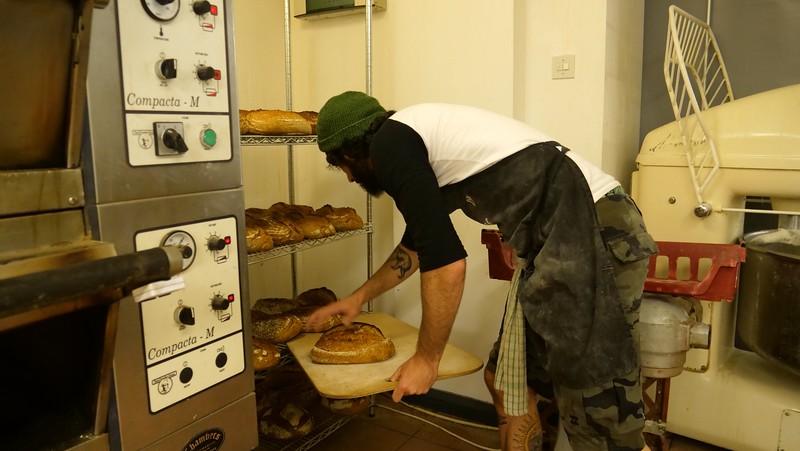
#3 03:00 – Bake some sourdough bread
Now for a rather unusual activity: if you’re an early bird, how about baking some sourdough bread?
I joined Dara at the Ursa Minor Bakehouse, where he is up at 3 am daily to make his famous sourdough bread. Furthermore, his bread picked up awards at the World Bread Awards in 2016, so even if you can’t rise early, swing by for a fresh loaf later in the morning to see what it’s all about.
There’s just something about Irish sourdough bread that tickled my tastebuds from the very first bite. It’s a bit like Ireland itself—rustic, hearty, and delightful. It is made with only the essential ingredients—flour, water, salt, and the all-important sourdough starter. The process, relying on natural fermentation, gives it that distinctive tangy flavor and chewy texture. I just love the irresistible contrast—the play between the crunchy exterior and the pillowy interior.
Whether it’s slathered with rich, creamy Irish butter, topped with smoked salmon, or dipped into a hearty bowl of stew, sourdough complements a wide array of Irish dishes. It’s common to be greeted with freshly baked sourdough in homes, B&Bs, and cafes across the country. I don’t know what else to say! You’ve gotta try it!
Location: Ursa Minor Bakery – 45 Ann Street, Ballycastle [10am to 4pm (Tue-Sat)]
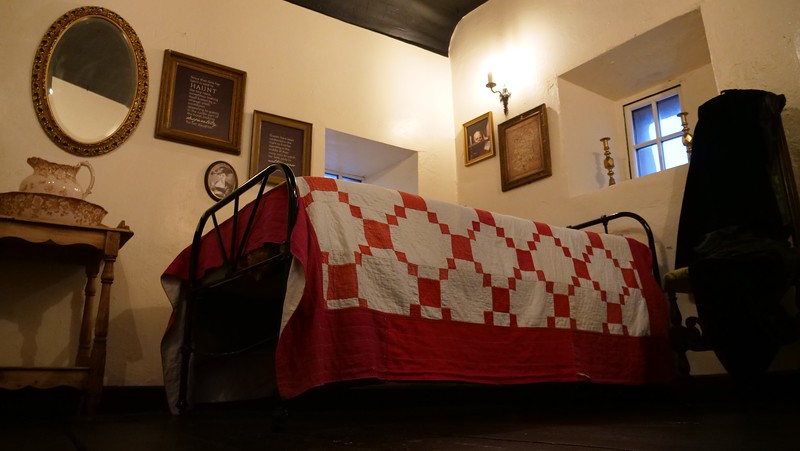
#4 04:00 – Sleep in a Haunted Castle
If you dare muster up the courage, consider visiting the haunted room located at Ballygally Castle, which is home to the ghost of Lady Isobel Shaw.
The story of Lady Isabella is one of those tales that linger with you, long after you’ve heard it. The story goes that after being locked in her room and starved by her husband, she fell to her death from the window. This story isn’t just a ghost tale; it’s a mother’s heartbreaking story, woven into the very fabric of Ballygally Castle. Guests often report encounters with a gentle spirit, a soft presence that seems to be searching, always searching… perhaps for the child she never got to hold.
Mediums have been invited to spend the night at the castle and they’ve reported that there are more ghosts than actual guests.
Would you spend the night here?
Location: Ballygally Castle – Coast Road, Ballygally
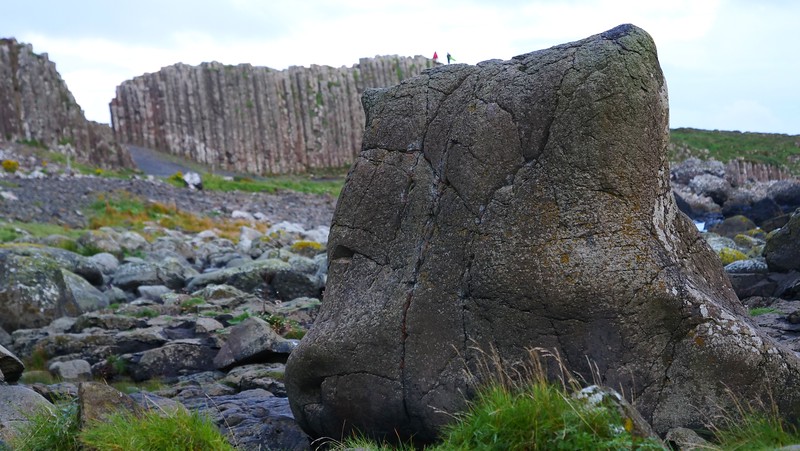
#5 05:00 – Watch sunrise at Giant’s Causeway
This was my second time visiting Giant’s Causeway, but this time around, I beat the crowds. Hence, if you don’t mind setting an alarm while on holiday, it’s worth getting up early and visiting for sunrise .
The Giant’s Causeway, with its interlocking basalt columns, is a feast for the eyes. Its 40,000 hexagonal columns stretch out into the sea, as if a giant had indeed paved his way across the waters. Walking on these stones, formed by volcanic eruptions 60 million years ago, feels like stepping back in time as you visit this UNESCO Heritage site. It’s a visual spectacle that defies words; it made me ponder the incredible forces that shaped our world.
But what’s beauty without a story? The Giant’s Causeway is steeped in legends, most famously the tale of Finn McCool, the giant who built this causeway to walk to Scotland to challenge his rival. When you visit this place for sunrise, it’s easy to imagine these tales to be true.
Indeed, the Giant’s Causeway is more than just a great place to visit—it’s a treasure of the natural world. In my opinion, it’s an absolute must to add to your itinerary!
Location: Giant’s Causeway – 44 Causeway Road, Bushmills
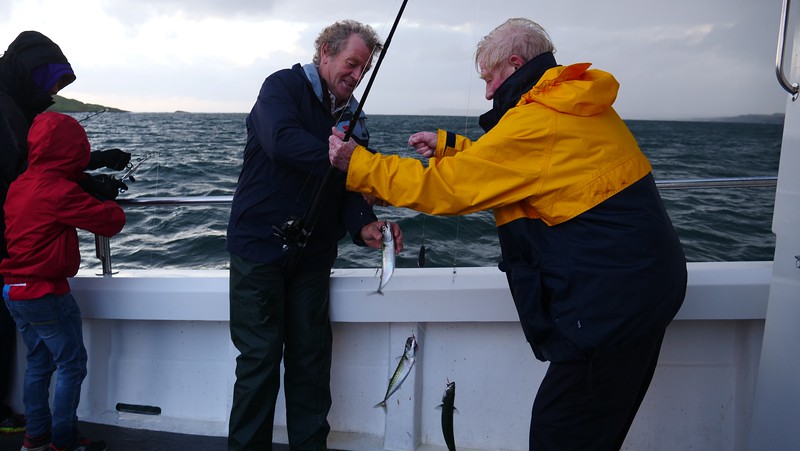
#6 06:00 – Take the Catch & Sea Tour
Did you arrive in Northern Ireland with your sea legs? If so, you can join the Catch & Sea Tour with experienced fishermen for their early morning catch.
Not only do you get to experience the dramatic coastline of the Causeway Coast; however, you can even catch your own breakfast.
Also, once you make it back to land, the catch is cooked up for breakfast along with a lovely assortment of baked bread, cheeses, chutney, butter and freshly brewed coffee. The perfect way to start the morning !
I’ll warn you though…it can be pretty rough out on the seas!
If you’re okay with that then proceed. Otherwise, it’s possibly wise to consider another activity.
Location: Babushka – S Pier, Portrush

#7 07:00 – Visit the Dark Hedges
Any Game Of Thrones fans out there?
Eat your heart out at the Dark Hedges where you’ll find the famous tree-lined avenue with an opportunity to dress up in costume while wielding a sword on horseback.
Ensure that you bring extra batteries for your camera. The atmospheric tunnel is a major tourist attraction so arrive early to beat the crowds.
The Dark Hedges gained worldwide fame as the Kingsroad in the beloved “Game of Thrones” series. Fans will instantly recognize this hauntingly beautiful road as the backdrop for Arya Stark’s escape from King’s Landing. Walking down this road, it’s easy to feel transported into the world of Westeros. You’re half expecting to catch a glimpse of a direwolf in the shadows. Or maybe you’ll hear the clatter of approaching knights.
But The Dark Hedges aren’t just for “Game of Thrones” diehards. This place holds its own charm. Planted in the 18th century, the trees were meant to impress visitors approaching the entrance to Gracehill House. Today, they impress the world. There’s just a timeless beauty that is hard to capture in words. It’s a photographer’s dream. And a nature lover’s paradise.
Location: Dark Hedges – Bregagh Rd, Stranocum, Ballymoney
Contact: Sheans Horse Farm – Armoy, 38 Coolkeeran Rd, Ballymoney
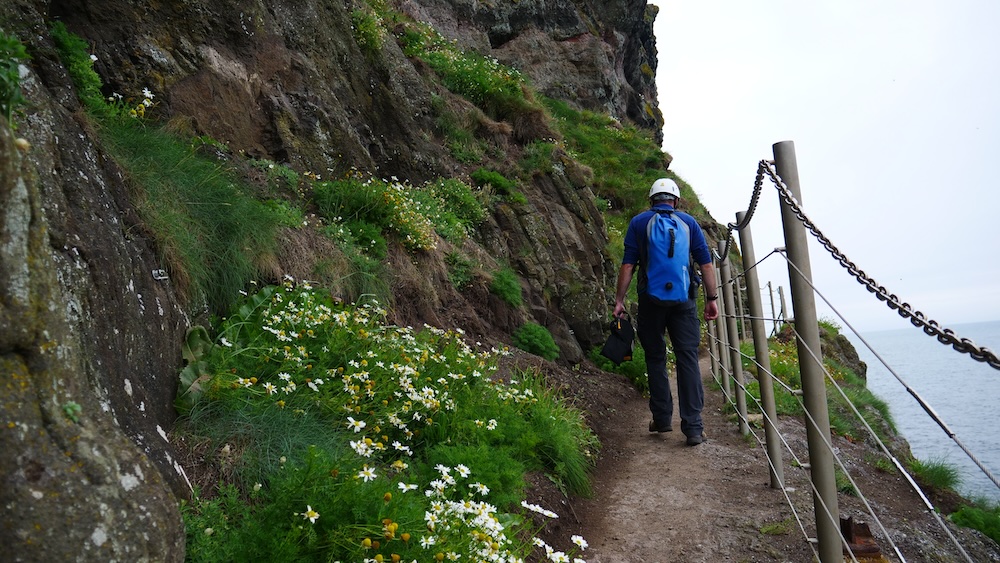
#8 08:00 – Walk the Gobbins Cliff Path
To experience the best of rugged Northern Ireland, you can walk the Gobbins Cliff Path.
Perched on the rugged coast of County Antrim, the Gobbins Cliff Path is not your average scenic stroll. This is a walk that takes you on the very edge of the land. Here the sea meets the sky. Every step reveals a new vista. Engineered marvelously along the basalt cliffs, the path includes bridges, tunnels, and stairways that made me feel like I was part of an epic saga.
The roar of the Atlantic below, the smell of salt in the air, the touch of ancient rock beneath your fingers—it’s all here. Birdwatchers are in for a treat. You’ll have a distinct chance to spot puffins, kittiwakes, and other seabirds nesting along the cliffs.
This unique combination of natural beauty and human ingenuity is what makes the path a must-visit attraction.
This is a complete sensory experience where you can hear the churning of the sea, feel the cool breeze blowing on your face, and admire the native seabirds that call this place home. There are some incredible views to be had here.
Bring a windbreaker because it can really pick up here!
Location: The Gobbins – 77-83 Gobbins Road, Larne

#9 09:00 – Cross Carrick-A-Rede Rope Bridge
Bring your hiking shoes and a pinch (or gigantic heap) of courage to cross Carrick-A-Rede Rope Bridge, which links the mainland to the small island of Carraig a’ Ráid (Rock of the Casting).
Imagine a place where the sea roars below you. And the wind whispers tales of old. Suspended nearly 100 feet above the crashing waves of the Atlantic, the Carrick-a-Rede Rope Bridge challenges you to step out over the open sea as slink your way towards the tiny island of Carrickarede. The experience of crossing is nothing short of exhilarating. It’s the perfect blend of fear and excitement. However, I’m leaning more towards the fear camp.
It was once used by salmon fishermen to access their catch. Now it’s a major tourist attraction. Go figure.
Be warned that this is not for the faint-hearted as there have been instances where visitors have had to be taken off the island by boat because of intense fear of walking back across the bridge.
The suspension bridge, made of Douglas fir and wire, offers some of the best vantage points for landscape photos .
My one tip: keep your eyes fixed straight ahead.
Location: Carrick-a-Rede Rope Bridge – 119a Whitepark Rd, Ballycastle
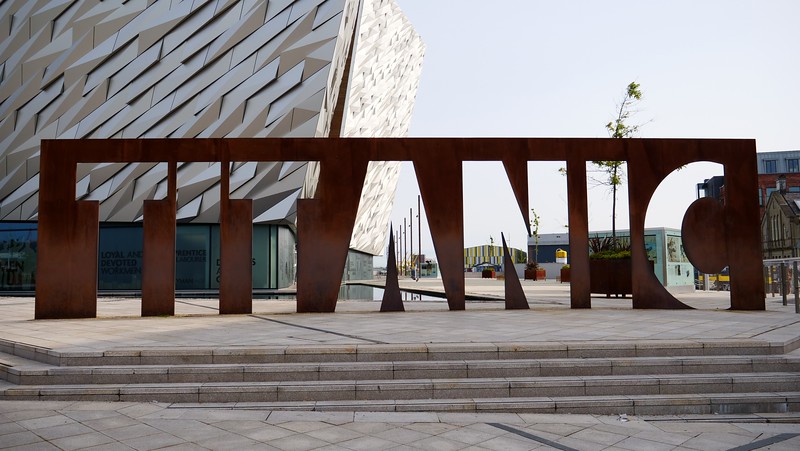
#10 10:00 – Titanic Belfast (Belfast)
If for some reason you only have time for one major attraction in Belfast, without any hesitation visit Titanic Belfast. Its proudly situated on the very slipways where she was built.
Voted the World’s Best Tourist Attraction at the World Travel Awards in 2016, the iconic building shaped like the bow of a ship, offers mesmerizing interactive experiences where you learn about the lives of the workers who built the Titanic along with the passengers and crew who made the fateful voyage.
Visiting is to embark on a journey back in time. Through nine interactive galleries, you’ll follow the Titanic from conception to tragic end. The experience is totally immersive. You’ll notice full-scale reconstructions, interactive displays, and haunting underwater footage of the wreck. It’s both educational and profoundly moving.
Its location is in the Titanic Quarter, a testament to Belfast’s shipbuilding heritage. You’ll gain insight into the city at the turn of the 20th century at the Harland and Wolff shipyard. This is where thousands of workers who built the Titanic.
The building itself is a sight to behold. Its design was inspired by the Titanic’s hull Its shimmering aluminum panels reflect the water and sky, changing with the weather and time of day. Inside, the atrium mirrors the Titanic’s grand staircase. You’ll gain an appreciation of its sense of scale and luxury. This attraction, more than any other, symbolizes Belfast’s regeneration and innovation.
Let’s continue our Northern Ireland travel guide by moving on to #11.
Location: Titanic Belfast – 1 Olympic Way, Queens Road, Belfast (10 am to 5 pm daily)
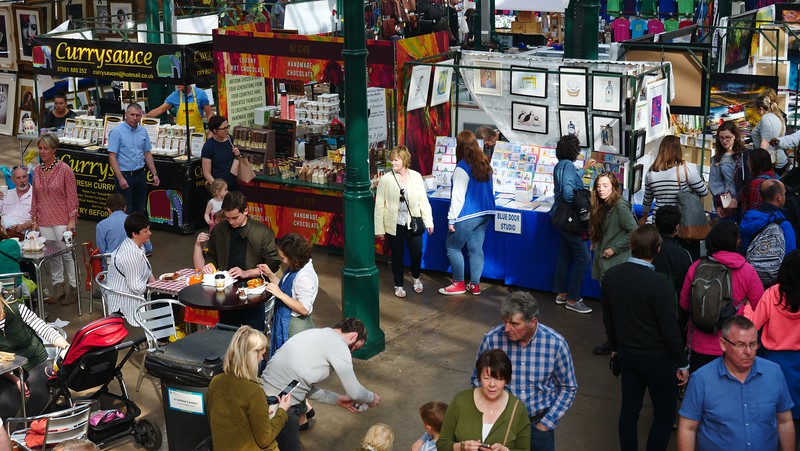
#11 11:00 – Have an Ulster Fry at St George’s Market
Whether you’re looking for a great local food experience or a tasty souvenir to take back home to friends, St George’s Market in Belfast is your best bet.
Come in the morning and have an Ulster Fry for brunch featuring soda bread, potato bread, back bacon, fried eggs, fried mushrooms, sausages, baked beans, hash browns and toast.
It’s a hearty, comforting dish that’ a piece of Northern Irish tradition. Each component is cooked in the same pan. This results in a symphony of flavors. You’ll find it both satisfying and soul-warming.
Boy oh boy, you’ll be satisfied afterwards. Maybe even a bit stuffed, if I’m being perfectly honest. You’ll most likely want to skip lunch! 😉
My tip? Share a table with locals. You’ll hear stories, receive recommendations, and perhaps even glean secrets to making the perfect Ulster Fry.
Location: St George’s Market – 12-20 East Bridge St, Belfast (Fri to Sun various hours)
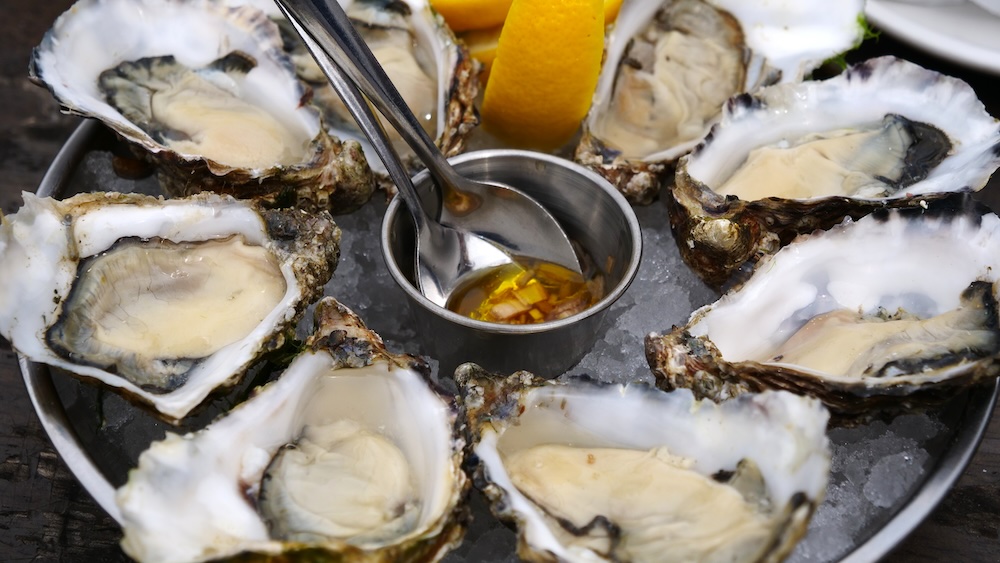
#12 12:00 – Take the Belfast Food Tour
With a burgeoning food scene that is impossible to conquer in mere days, the Belfast Food Tour is a great way to sample some of the best bites and drinks the city has to offer.
Their 4-hour guided walk takes you to some top food and drink spots around Belfast City Centre, plus they also offer gin and whisky tours if boozy tours are more your thing!
It’s not just about the food. You’ll cover a decent amount of Belfast in the process.
And to be perfectly honest, I can’t think of a better way to get acquainted than to nibble my away around a city.
Location: Taste and Tour NI – A1.01 Portview Trade Centre, 310 Newtownards Road, Belfast
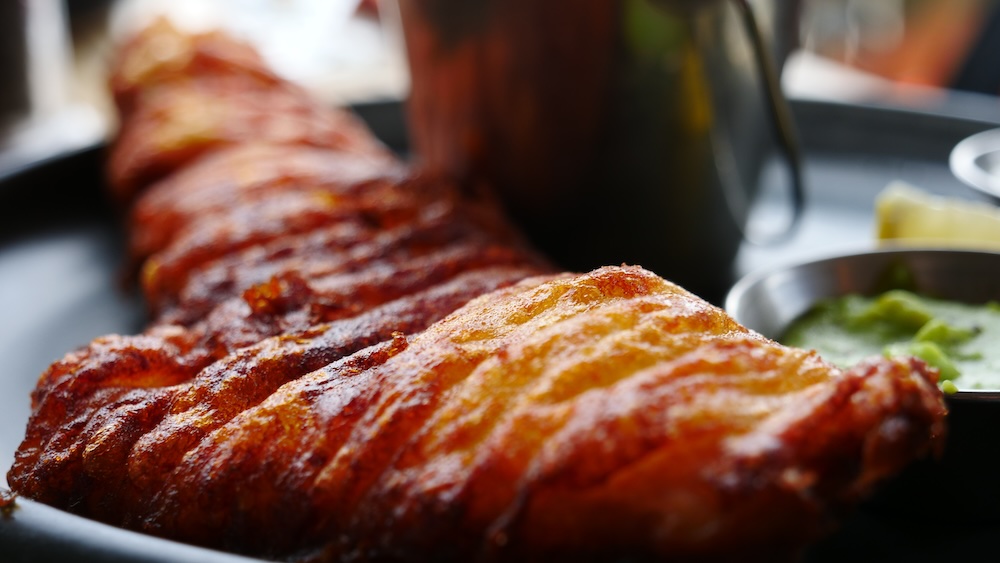
#13 13:00 – Have the fish at Harry’s Shack
Located on the beach, Harry’s Shack is THE spot for local seafood and fish . I had a hankering for fish and chips and it was the best I’ve had in Northern Ireland. Come for the food but consider the views, atmosphere and friendly service the cherry on top.
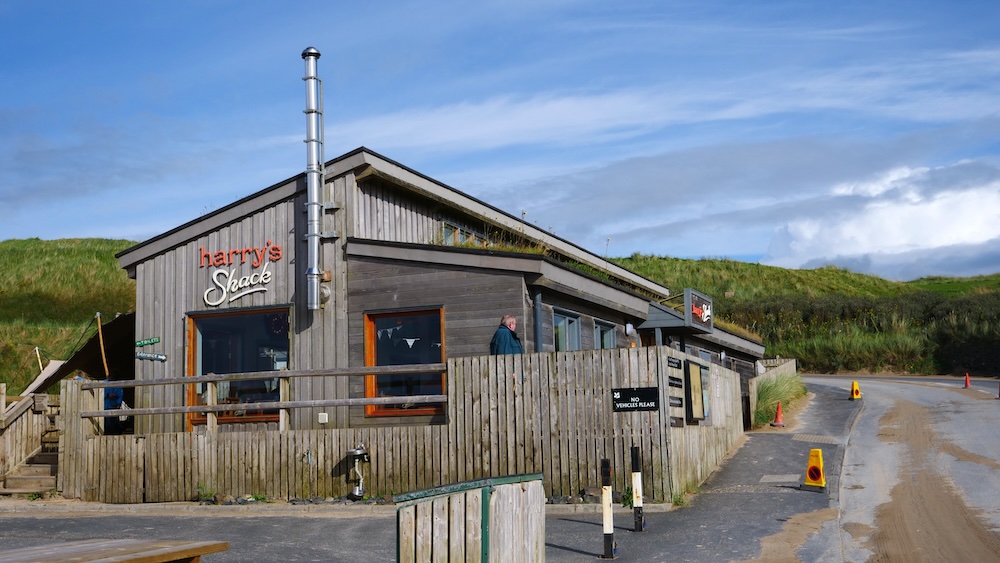
Its nestled on the sandy shores of Portstewart. It’s all about savoring the freshest fish. And with each bite you’ll be mesmerized by the sound of waves as your backdrop. Here you’ll gain a window into Northern Irish coastal life.
My only regret is that I didn’t have a chance to come back! That’s how good the food was.
Location: Harry’s Shack – 116 Strand Rd, Portstewart (Lunch & dinner hours vary Tues-Sun)
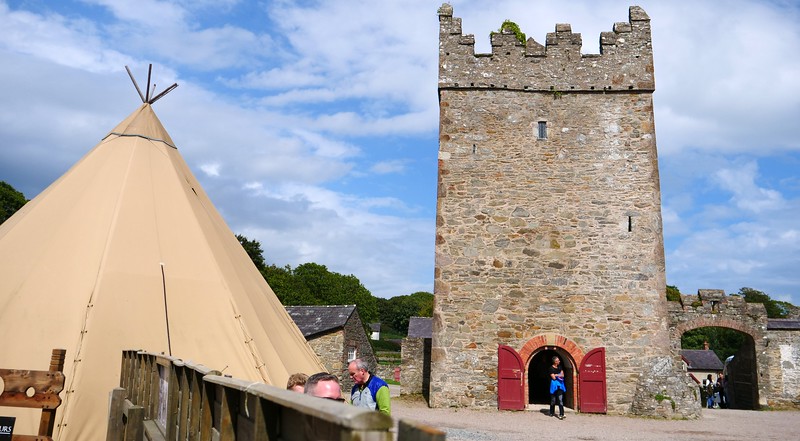
#14 14:00 – Winterfell GOT Experience
The Dark Hedges wasn’t the only GOT destination I visited. Game Of Thrones fans will be glad to know that you can visit Castle Ward to experience Winterfell by dressing up in costume and putting those archery skills to the test.
It’s an immersive journey through the iconic Northern stronghold of the Stark family. And a bucket-list adventure for fans and newcomers to the Seven Kingdoms. Here you walk through the very courtyards and along the paths where Jon Snow, Arya, Sansa, and Bran plotted, trained, and lived.
The attention to detail in recreating the sets is most impressive. From the towering walls of Winterfell to the intimate corners where pivotal scenes unfolded, it’s attention to detail. You’ll get a chance to try your hand at archery. This is the very spot where Jon Snow taught Bran the art. Guided tours reveal the secrets behind the filming. You’ll gain a deeper appreciation for the show’s groundbreaking achievement.
Location: Winterfell Castle & Demesne, Old Castle Ward, Park Road, Downpatrick
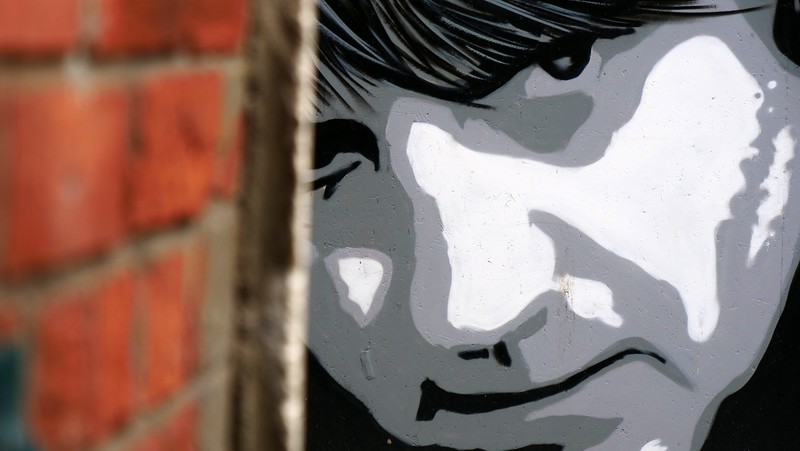
#15 15:00 – Belfast Street Art Tour
I’ve visited many cities around the world with fascinating street art but nothing quite compares to Belfast. Join a tour with a local artist to discover the significance and meaning of various works of art as you stroll around Cathedral Quarter.
It’s impossible not to be drawn into its world. One of color, creativity, and expression that adorns its walls. However, street art in Belfast is not just decoration. It’s a dialogue with the city’s past, present, and future. It offers traveler’s a chance to understand the character, struggles, and spirit of Belfast.
Murals memorialize moments of conflict and celebrate figures of unity. Often they’re about distinct social and political currents that have shaped the city. Local and international artists contribute to this ever-evolving canvas. You’ll notice a range of styles from graffiti to elaborate murals.
Perhaps the most striking aspect of Belfast’s street art is its role as a voice for the community. Murals often arise from collaboration between artists and local residents. They reflect shared hopes, fears, and dreams. This community engagement ensures that the art remains relevant. This is far removed from the typical tourist trail. Walking these streets, you’ll gain an appreciation for the resilience and transformation of Belfast.
Location: Visit Belfast – 9 Donegall Square N, Belfast
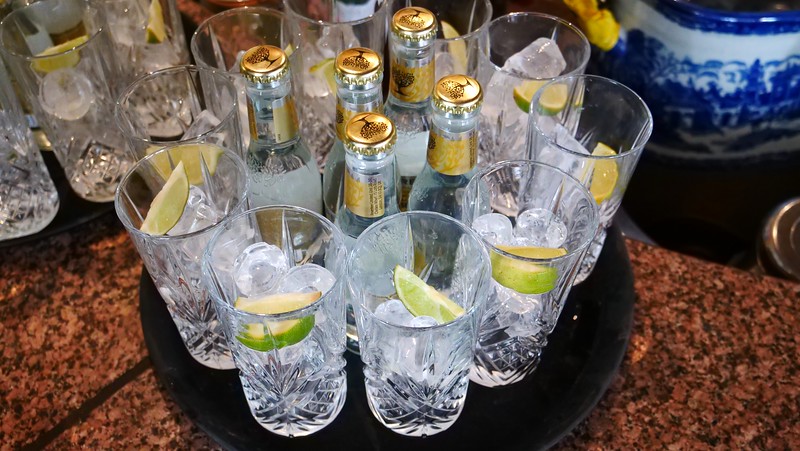
#16 16:00 – Belfast Gin Gaunt
I’ve become a big fan of gin in recent years and if you want to tickle your tastebuds, I’d suggest taking the Belfast Gin Gaunt to work your way around some of the best bars and pubs in the city.
In total, you visit 5 spots sampling 7 different gins including 3 that are locally made.
What makes gin such an important part of Belfast?
It’s about discovering the craft, stories, and people behind Belfast’s burgeoning gin scene. You’ll get the opportunity understand the distillation process. From selecting the perfect botanicals to the final pour. This makes it an educational experience that goes beyond the average tasting. It’s an opportunity to see, smell, and understand the process up close.
Of course, the highlight of any gin tour is the tasting session. Belfast’s gins are known for their unique profiles. Think distinct local botanicals. By taking a tour, you’ll leave with a greater appreciation for the spirit. So, raise your glass to Belfast whilst discovering its gin-making heritage.
Location: Taste and Tour NI – A1.01 Portview Trade Centre, 310 Newtownards Road, Belfast (Mon-Fri 9 am to 5 pm)

#17 17:00 – Boom Board Tour (Derry)
Ever heard of boom boarding before? I hadn’t until visiting Derry.
Long-boarding originated in Hawaii when surfers wanted to take to the streets on wheels; today it’s also a fun way to tour Derry.
The 2-hour tour starts with a lesson in St Columb’s Park and then takes you to the streets and winds up at the famous Walled City Brewery where you can sample local brews coming out of the microdistillery.
So, what exactly is boom boarding?
Boom boarding involves using a longboard—a longer, more stable version of a skateboard—allowing for smoother ride. The “boom” denotes the sound of the wheels hitting the pavement. One of the best things about boom boarding is its accessibility to beginners. You’ll receive a brief training sessions to get you comfortable on the board. Although, If I’m being perfectly honest, I never felt that comfortable on it.
This type of experience offers unique perspective on the city’s sights. Gliding just above the ground you’ll experience the city in a vastly different manner from a typical walking or bus tour. An added bonus is that the tour leaves no carbon footprint. I hope you enjoy it more than I did. I spent most of my time trying not to face-plant.
Location: Far and Wild – St Columb’s Park House, 4 Limavady Rd, Londonderry
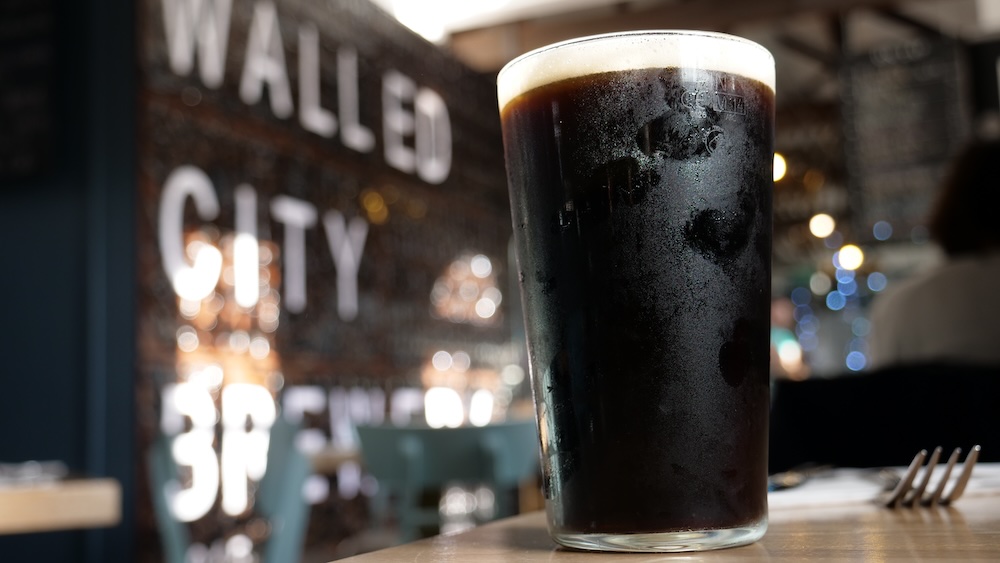
#18 18:00 – Enjoy a craft beer tasting
If you’ve done even a quarter of what I’ve suggested in this article you’ll have worked up a ridiculous appetite at some point. To satisfy your hunger I suggest heading over to the Walled City Brewery in Derry for burgers and craft beers.
The setting of this place is most impressive. Located in a converted army barracks within sight of Derry’s historic walls, the brewery marries the past and the present in its ambiance. The interior pays homage to the building’s heritage. But yet it also has a welcoming aesthetic. It’s a place where the weight of history complements the spirit of innovation.
You’ll discover a range from hoppy IPAs to potent stouts. The burgers also are legendary! Come hungry. Or else you’ll be undoing your belt buckle.
Location: Walled City Brewery – Ebrington Square & Parade Ground, 70 Ebrington Street, Derry-Londonderry BT47 6FA, UK (+44 28 7134 3336)
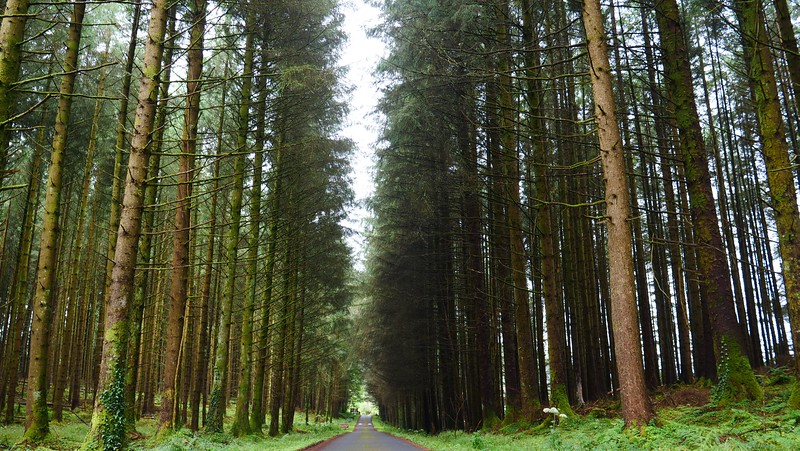
#19 19:00 – Visit Lough Navar Viewpoint
For a walk in the woods check out Lough Navar Forest where you’ll find numerous points of interest including views over Lower Lough Erne, Sperrin Mounts and the west coast of Donegal.
The Lough Navar Viewpoint stands as a testament to nature’s artistry. This hidden gem in Northern Ireland offers more than just a simple walk in the woods. You’ll get to experience the rugged beauty of Donegal’s west coast. It’s where winding paths lead you through a tapestry of green. Whilst its ancient trees whisper stories of the past. You’re invited to slow down and soak in the tranquility.
How about the views?
The panoramic views are simply unmatched. You’re treated to a sweeping outlook over Lower Lough Erne and the Sperrin Mountains. The grandeur of nature is on full display here. Behind the lens, the ever-changing light and vast landscapes present endless opportunities to capture the magic of the Irish countryside.
Let’s move on to the top 20 thing to do in Northern Ireland.
Location: Lough Navar Forest – Glennasheevar Rd, Derrygonnelly, Enniskillen
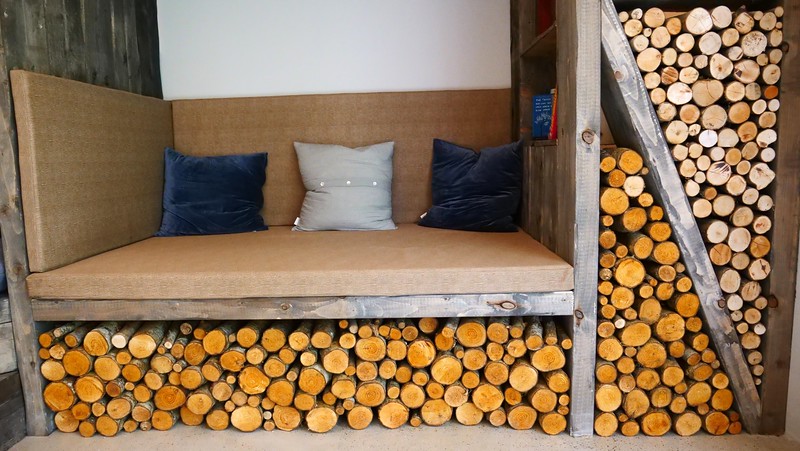
#20 20:00 – Relax with an Outdoor Spa Experience
After that action-packed schedule, I was feeling ready to unwind and Finn Lough Resort proved to be the perfect spot. You can’t go wrong with a natural outdoor spa in a scenic backdrop.
I found myself in a deep state of relaxation. If you’ve been ticking off attractions like a madman use this as an opportunity to slow down. I sure did. And it helped me recharge for other activities.
Location: Finn Lough Resort – Letter Road, Leggs, Enniskillen BT93 2BB, UK ( +44 28 6838 0360)
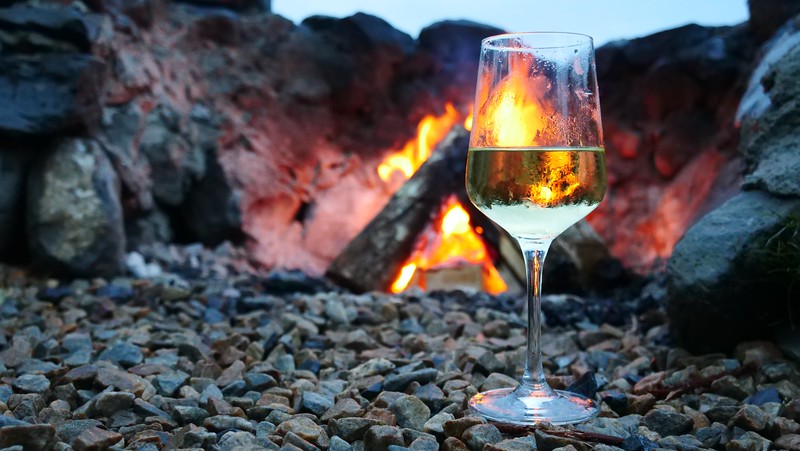
#21 21:00 – Watch sunset over Lough Erne
After my spa experience, I went over to Lough Erne where I enjoyed nightfall over the lake, warmed up my toes over the fire pit, and munched on cheese whilst sipping on wine. It was a magic moment to wind down the day.
What makes Lough Erne so special?
One of Lough Erne’s most mesmerizing features is its collection of over 150 islands. For instance, there is a mysterious monastic site on Devenish Island. Or the wild beauty of White Island with its ancient stone figures. These islands offer a glimpse into both the natural and historical richness of the area.
Lough Erne is a sanctuary for wildlife and nature enthusiasts. The lake’s clean waters and surrounding habitats are home to an abundance of birds, otters, and even the elusive pine marten. Visitors can witness the vibrant ecosystem of Lough Erne up close. It’s a place where the hustle of the outside world fades away.

#22 22:00 – Go to Cathedral Quarter for nightlife
The cobbled streets of Cathedral Quarter in Belfast are your best for nightlife when the plethora of bars and pubs become packed on a weekend night. Here you can party the night away while enjoying live music on the streets and raising a pint with friendly locals.
What makes Cathedral Quarter an epic nightlife experience and a top thing to do in Northern Ireland?
Cathedral Quarter brims with an eclectic mix of bars, pubs, and venues. Here you’ll find traditional Irish pubs where the music spills out onto the streets. And if you’re feeling a little bit fancy, contemporary bars serve up innovative cocktails. There’s just an energy here that’s infectious. It draws you in with promises of fun and distinct memories.
Live Music and Entertainment?
A highlight of Cathedral Quarter’s nightlife is its live music scene. Whether you’re into indie, rock, traditional Irish, or jazz, you’re covered. You’ve got intimate gigs in cozy pubs to vibrant performances on larger stages. Cathedral Quarter is also a haven for foodies looking for late-night bites. You’ll find everything from gourmet to street food nibbles.
However, what truly sets the Cathedral Quarter apart is the unmistakable warmth of Northern Irish hospitality. Here, strangers quickly become friends. You’ll feel like you’re at home.
Location: Royal Avenue and the Dunbar Link
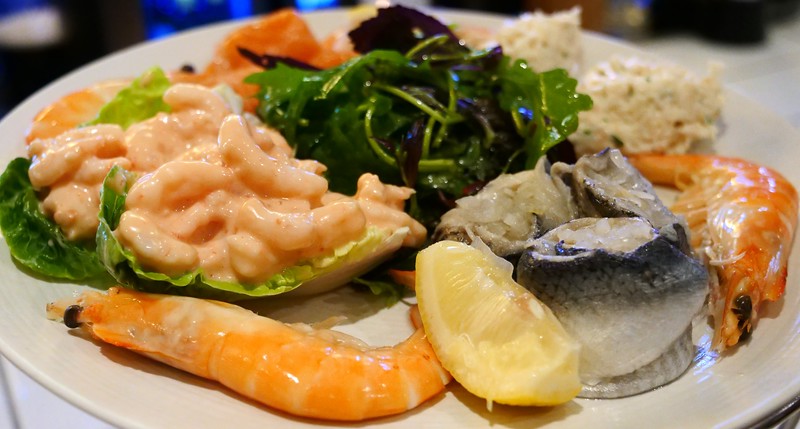
#23 23:00 – Have a late night dinner at Love Fish
For a seafood feast of feasts, head over to Deanes Love Fish which serves a seafood platter for the ages. How could any Northern Ireland travel guide be compete without savouring coastal delights?
My plate was loaded with tasty bites from the sea and I couldn’t help but indulge in a little bit of everything.
In my opinion, there’s something magical about tucking into a late-night dinner. Especially, if it involves seafood. My seafood platter was so abundant and diverse, I felt like ocean at my fingertips. Imagine a plate brimming with a diverse range of fresh delicious seafood. Truly a celebration of the sea’s rich offerings!
Located on Howard Street, the restaurant offers a cozy yet sophisticated ambiance. I couldn’t recommend it more!
Location: Deanes Love Fish – 30-36 Howard Street , Belfast
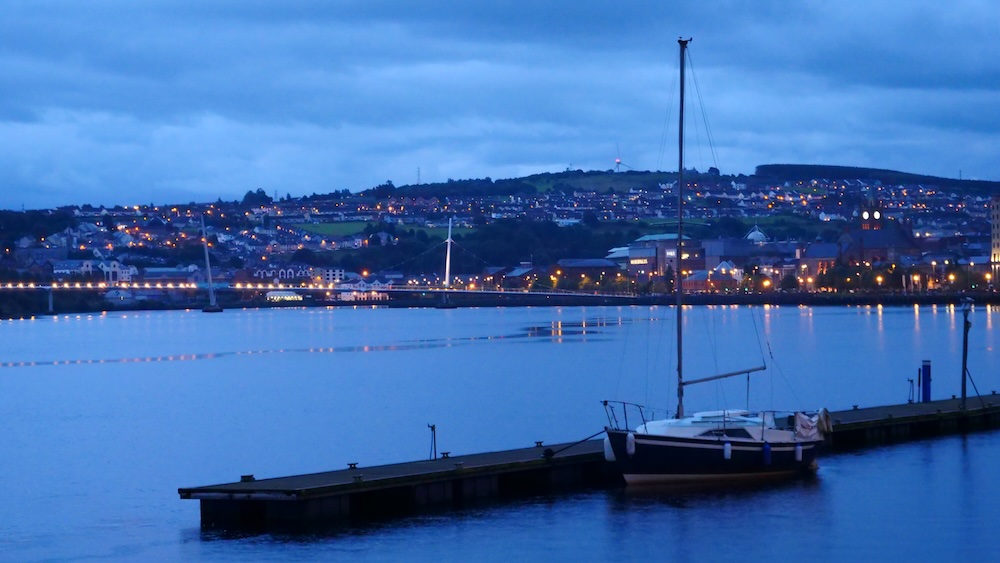
#24 24:00 – Moonlight Kayaking (Derry)
Last but not least, to wrap up this Northern Ireland travel guide, consider a moonlight kayaking experience. Not only is it a good workout but you’ll also have an opportunity to spot wildlife you wouldn’t otherwise see during the day. Some of the highlights include Peace Bridge in Derry, Magilligan Fort and the Roe River under the Binevenagh Mountain.
What makes this experience worth doing?
It’s an extraoridinary adventure. This unique experience combines kayaking with the enchanting atmosphere of the night. Kayaking under the moonlight offers a completely different perspective on some of Derry’s most iconic landmarks. Imagine paddling near the Peace Bridge. Its structure illuminated against the night sky. Or gliding past the historic Magilligan Fort. You get to experience the gentle flows of the Roe River under the shadow of Binevenagh Mountain.
You may even be lucky enough to spot nocturnal creatures going about their nightly routines. The stillness of the night, combined with the minimal disturbance from the kayaks, makes this an ideal way to observe it all. It’s no doubt one of the most adventurous things to do in Northern Ireland.
Final Thoughts: Epic Journey Through Northern Ireland
It’s hard to believe our journey is over. It’s the best of Northern Ireland with 24 amazing things to do!
From the rugged cliffs that have stood the test of time to the warm smiles that greet you in every town, Northern Ireland is a crowd pleaser. Savour each experience. Whether it’s standing atop the Giant’s Causeway, exploring the haunting beauty of the Dark Hedges, or simply enjoying a pint with new friends.
Northern Ireland is a storyteller’s dream. A place where you can walk in the footsteps of giants. And chase the ghosts of the past. What truly sets Northern Ireland apart is its people. The warmth of the welcome here is unmatched. Northern Ireland, with its 24 incredible things to do, is just the beginning of an adventure that continues to unfold, an invitation to return that’s impossible to resist.
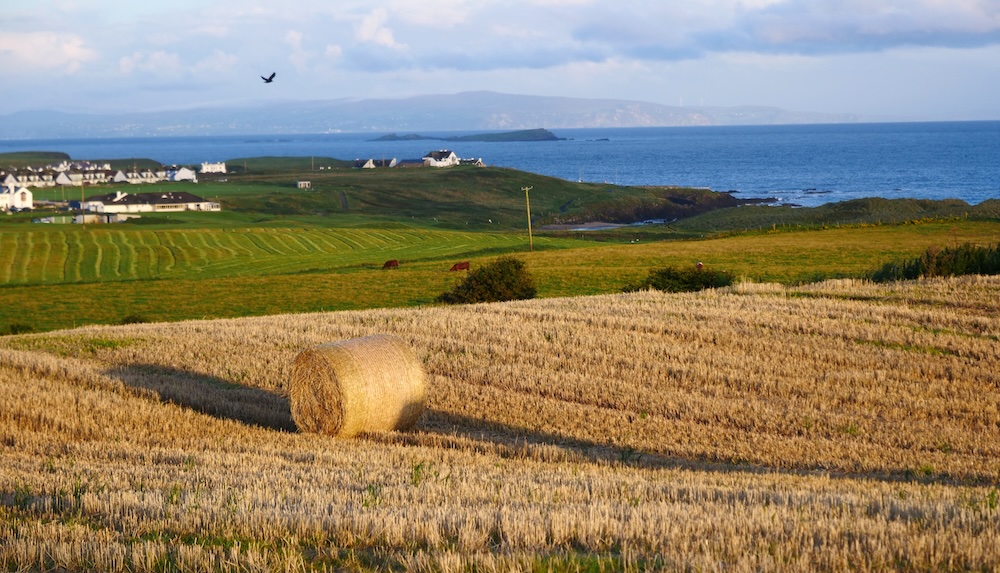
Have you been to Northern Ireland? Tell us about some of your favourite experiences there? What else should we have included in our Northern Ireland travel guide? What are some of your favourite things to do in Northern Ireland? Please let us know in the comments below!
The trip was brought to you as part of the #lovegreatbritain campaign, created and managed by iambassador in partnership with Visit Britain and Discover Northern Ireland.
You may also like

The World of Noodle Soups: Ramen, Pho, and Udon Compared
Want to Create a Successful YouTube Travel Channel? Top Secrets

Travelling Home For The Holidays? Impress With Holiday Fashions
25 Comments
Your email address will not be published. Required fields are marked *
Hi. I really loved your content. Its so informative.
thanks for sharing your experience, I’m visit Ireland very soon..
I’m really impressed on how beautiful Northern Ireland is, surely I’m visiting there some day
really interesting post, thanks. I didn’t expect Northern Ireland to be so beautiful
Ireland is already at the top of my bucket list, and I can’t wait to visit!Wow, everything appears to be very mysterious! continue to share with us
One of the highlights of a trip to Northern Ireland is to visit the Ards Peninsula (about 10 miles south of Belfast). Begin with driving or walking up Scrabo Hill just outside of Newtownards and then going up to the top of the Scrabo Tower – on a good day you can see the whole of County Down, Belfast City, across the Irish Sea to the Isle of Man and the coast of Scotland. Later a leisurely drive down the peninsula road towards the village of Portaferry, with Strangford Lough on your right hand side. It is the largest sea inlet in the British Isles, covering 150 km², full of bird life and in places seal colonies. On the left is the jewel in the crown of the National Trust – Mount Stewart (Voted as one of the top ten gardens in the world, Mount Stewart reflects a rich tapestry of design and planting artistry bearing the hallmark of its creator. Edith, Lady Londonderry’s passion for bold planting schemes coupled with the mild climate of Strangford Lough allows rare and tender plants from across the globe to thrive in this celebrated garden, and some really quirky sculptures to be seen.) Beyond Mount Stewart is the village of Greyabbey, with the ruins of a Norman Cistercian monastery at one end and a host of antique shops at the other; as well as several places to enjoy a lunch. The next village Kircubbin now boasts a new distillery called ‘Echlinville’ which can be toured. They have produced award winning gin and poitin whiskey. The final destination is the quaint village of Portaferry with its aquarium. And that is only one side of the peninsula… You can either explore the other side, the Irish Sea coastline, or cross the Lough by ferry to the historic Strangford village and explore into St Patrick’s Country and head south towards Newcastle and the world famous Mountains of Mourne. We have explored this area over several visits and believe me when I say that it is a world apart from the hustle and bustle of Belfast City.
Yes. Definitely. I’m British so Belfast isn’t that far however, there’s a slight snag since I actually live in Berlin!
The last time I went to Belfast was about 13 years ago though. Eek! I was just looking for somewhere to go over the summer, when easyJet popped up with a flight from Berlin to Belfast for €8.00!
Er. Yes please! After that, I just decided that we might as well visit the rest of Ireland, especially since my stepmum is half English / half Irish and her dad came from the “Old Country” so to speak, so off we went!
I’m a Game of Thrones freak but GOT wasn’t a thing then, more the Titanic, which I love anyway!
‘Nice one mate!
Wow, it all seems so mystical! Ireland is way up high on my bucket list already, now I’m definitely itching to go! keep sharing with us
Wow the dark hedges look amazing!! I can’t wait to go one day. Also, I didn’t even realize it was possible to sleep in a haunted castle! Though, I imagine you can’t do much sleeping….
Big Game of Thrones fan here. I would love to geek out at some of these spots. That coastal scenery is also breathtaking! Thanks for this cool guide.
Cheers for this Article! It looks as though there is a lot of exciting activities in Northern Ireland. The Giant’s Causeway would be out of this world at sunrise!
Sleeping in a haunted castle – sign me up! Definitely my cup of tea.
Absolutely stunning pictures, and the people in Ireland are friendly greeting as family when tourists go into the country. Thank you for the post.
I felt for a moment that I came back to the classic era a truly amazing journey Thanks for sharing with us
Awesome! These are all great experiences I should try someday. Thank you for sharing.
It looks like it was a real adventure! I always wanted to come here, but I did not know what kind of activities to do. Thanks for tips!
Great tips! I will try them on my Northern Island expedition!
I am soo jealous! Northern Ireland has been on my Travel List for awhile but I am still on my Asian countries list, I can’t wait to go there!
Wicked guide, I really want to hit the dark hedges and Ballygally…been meaning to get over to Ireland for ages now but I never do, even though I go to the UK every year and it’s so close. This year I really need to make it a point, and definitely going to try to hit some of these on the guide. Plus…fellow GoT nerd…so I really need to!
Hi Sam ! I really loved the way you the experience over your pictures. Very creative way to tell a story. The place looks fantastic, it was just what I was looking for. Cheers buddy!
What a spectacular adventure, Sam! This was so much fun to read! Sorry I’ve been out of touch for such a long time my friend! Hockey season is coming up! 🙂
great pics, congrats!!
I’d always thought that it would be Giant’s causeway that would get me to Northern Ireland, but, no, its going to be the food..
Wow, it all seems so mystical! Ireland is way up high on my bucket list already, now I’m definitely itching to go!
Wow! seems like you enjoyed a lot. In next summer I am planning to go to Amsterdam and Barcelona, but after reading this I am planning to go Ireland too. Thanks Samuel.


Savvy Travel Advice
Belfast Travel Guide: Top 40 Things to do in Belfast Northern Ireland
Last updated: May 21, 2024 - Written by Jessica Norah 16 Comments
Belfast is the capital and largest city in Northern Ireland, and there are so many things to do in Belfast! Belfast is probably best known for being where the RMS Titanic was built as well as for the violence and suffering here during The Troubles in the later part of the 20th century.
However, today the city offers a lively historic city center, the famous Titanic Quarter, fun pubs, excellent museums, hundreds of street murals, beautiful gardens and green spaces, Victorian architecture, and a growing tourism industry. Belfast is perhaps not as well-known as Dublin to international travelers, but the reward of visiting here is a less crowded city where experiences feel more authentic.
We’ll share our guide to Belfast attractions, highlighting all the top things to do in Belfast, from central Belfast to the surrounding area. We’ll also share information about how to get there, when to go, public transport options, where to stay, day trip ideas, and other travel information.
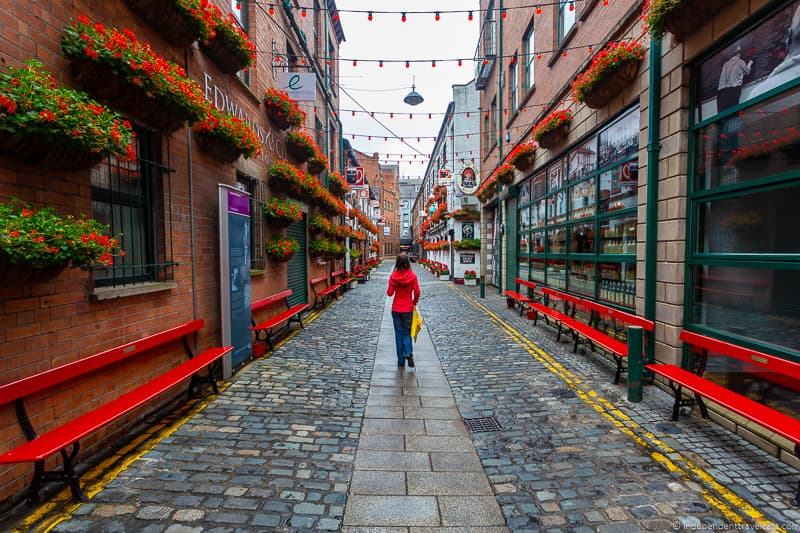
Table of Contents:
Basic Info on Visiting Belfast
Before we share all the things to do and see in Belfast, we wanted to give you all the basic information you’ll need to plan your trip including how to get to Belfast, best times of year to visit, and where to stay.
Where is Belfast?
Belfast is the capital and largest city in Northern Ireland within the United Kingdom. It is situated alongside the River Lagan on the northeast coast of the island of Ireland.
Note that politically the island of Ireland is divided between the Republic of Ireland and Northern Ireland. Northern Ireland is part of the United Kingdom whereas the Republic of Ireland is not and is a separate country.
Getting to Belfast
There are multiple options for getting to Belfast.
By Plane. Belfast has two airports, Belfast International Airport and George Best City Airport , both of which have flights from a number of domestic and international destinations, primarily within the UK and western Europe. If there is no direct flight, you can get connecting flights from other cities in the UK such as London, Manchester, Edinburgh, or Glasgow.
If you fly into Belfast International Airport, the airport is a short shuttle bus ( Airport 300 service ), taxi ride , Uber, or private transfer from Belfast.
If you fly into George Best City Airport, you can take a short shuttle bus ( Airport Express 600 Service ), train ride (it is about a 12 minute walk to the station or you can take the airport shuttle to Sydenham train station), taxi ride , Uber, or private transfer into the city.
Alternatively, you can fly into Dublin Airport which has a lot more international connections and then get a bus or train or drive to Belfast. It takes about 2 hours by car or 2.5 hours by bus from the airport. If you are in Dublin, you can also take a train from Dublin to Belfast which takes about 2 hours 15 minutes.
By Train. Belfast can be reached by train from within the island of Ireland, including the cities of Dublin, Cork, Limerick, and Galway. You can save money on fares by booking train tickets in advance. Check routes, fares, and schedules on Irish Rail .
By Bus. If you are in the UK or Ireland, there are daily coach connections to Belfast from a number of cities. Routes from England, Scotland, and Wales all include ferry transport. You can check Translink and National Express for coach connections.
By Car. For drivers, Belfast is about 70 miles from Derry/Londonderry (about 1 hour, 30 minutes), 105 miles from Dublin (about 2 hours), 260 miles from Cork (about 4 hours, 15 minutes). If you are coming from England, Scotland, Wales, or continental Europe, you’ll need to get a ferry to reach Belfast.
By Ferry. Ferries to Belfast regularly depart from Liverpool (England), Cairnryan (Scotland), and the Isle of Man. The main ferry company we recommend is Stena Line . Check out their ferry routes and schedules here .
Getting around Belfast
Belfast has a good public bus transport system run by Translink . Metro is the name of the main bus service for all of Belfast.
Driving in and around the city is also fairly easy although finding parking in the central area can be difficult at times although there are several paid public parking structures. Walking or using a bus is recommended for reaching central locations.
There are also, of course, taxis and Uber (mostly operates to and from airport). Taxi tours are also very popular ways to see the city with a driver guide.
Bikes are available to rent through the city’s bike share program , and kiosks are available in many popular tourist areas.
There’s also the City Sightseeing Bus which is a hop-on, hop-off bus that will take you to all the highlights in the city and provides commentary so you can learn a bit more about the city and the sites you see. It stops near most of Belfast’s major attractions including the Titanic Belfast museum, St. George’s Market, Botanic Gardens, and the Shankill Road wall murals.
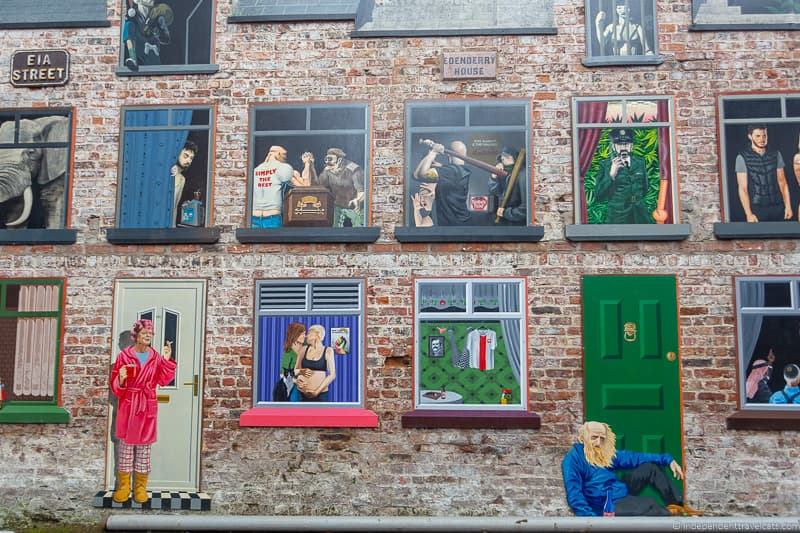
Currency Used in Belfast?
Belfast is part of the United Kingdom so the pound sterling (GBP) is the legal currency. This is the same currency used throughout the rest of the United Kingdom (England, Wales, Scotland).
Note that if you travel south and visit the Republic of Ireland (e.g., Dublin), you will need to get euros as the euro is the official currency of the Republic of Ireland. Northern Ireland is part of the United Kingdom whereas the Republic of Ireland is not.
Best time of year to visit Belfast?
The best time of year to visit depends a lot on what you want to do. If you are looking for the warmest weather, you’ll want to travel in summer between June and August. April is often the month with the least chance of rain, humidity, and crowds.
Our favorite times of year to travel in Northern Ireland are May, June, and September. The weather is generally decent, the days are long, and the attractions are not too crowded.
Although note that most attractions in Belfast are rarely that crowded. The exception is the attractions in the Titanic Quarter which can be pretty crowded in summer and during holidays and school breaks. Other popular sites in Northern Ireland like the Giant’s Causeway are also very busy in the summer months.
If you want to go to a certain event or festival (e.g., concert, Christmas markets, Belfast International Arts Festival ), then we’d recommend you can check the events calendar and plan around those dates!
However, any time of the year is a good time to visit Belfast as most attractions are open year round. Generally, it will be warmer in summer and colder in winter, but predicting the weather is impossible as it can be sunny in January or cool and raining in August.
We’d suggest just checking the weather forecast before you visit, and be prepared for variable weather by bringing plenty of layers and rain gear no matter when you plan to visit.
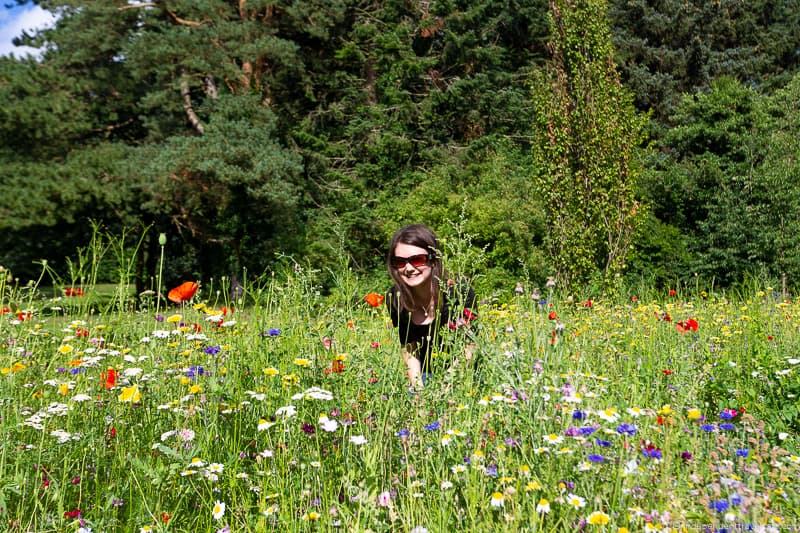
How many Days should I Spend in Belfast?
This depends primarily on how much time you have and what you want to do. But I would recommend spending at least 2 full days and nights in Belfast to get a good taste of the city. You can see our 2 day Belfast itinerary for ideas.
If you just have a day, you’ll still be able to see a few of the city’s highlights. Just be sure to plan your time ahead or join a tour to mae the most of your time.
If you are visiting Belfast because of an interest in the RMS Titanic , then we recommend checking our Belfast Titanic attractions guide . This article includes a suggested 2 day itinerary that includes all the city’s main Titanic and maritime attractions.
For those who have more than a couple of days, there are also several excellent day trips you can take from Belfast as well and we’ll highlight a few of these at the end of the article. If you have longer than a couple of days, you can easily spend a week here and not run out of things to do.
To figure out how many days to spend in Belfast, I would suggest using this post which lists all the main highlights and things do in Belfast to create a list of places you want to visit. I would then figure out how many days it will take you to see all the Belfast attractions you want (e.g. 3-5 attractions per day), and that should give you a good answer.
Discount Passes in Belfast?
There is no must-have pass for Belfast but there are a couple of discount passes that may help you save money, depending on what you want to do and how you plan to get around Belfast.
Belfast Visitor Pass
Belfast does have a city Visitor Pass which offers free public transport around the city, which includes unlimited travel on all Metro buses, NI Railways, and Ulsterbus services. It also includes the Airport Express 600 services to and from George Best Belfast City Airport (but not the Airport 300 service to Belfast International Airport). You can buy a pass valid for 1, 2, or 3 days.
The pass also includes discount offers on a number of restaurants, attractions, and shops in Belfast. Currently with the pass you can discounts on entry to Titanic Belfast, Crumlin Road Goal, Ulster Folk Museum, Ulster Transport Museum, Titanic Distillers tours, Belfast Zoo, and Belfast City Tours. You can check out the latest discount offers here to decide if it is a good pass for you.
You can purchase the Belfast Visitor Pass in person from Visit Belfast Welcome Centre (9 Donegall Square North), Belfast airport tourist information desk (at both airports), or at any Translink station in Belfast. Or you can purchase it online before your trip.
National Trust Touring Pass
If you plan to travel throughout the UK and visit several historical or cultural attractions, you might save money with a National Trust Touring Pass which allows for free entry to over 300 stately homes, gardens, castles, and historical attractions in the UK. The pass is good for a select amount of days and includes sites across England, Wales, and Northern Ireland.
A few of the most popular sites covered by the pass in Northern Ireland are Carrick-a-Rede, Castle Ward, the Giant’s Causeway, and Downhill Demesne and Hezlett House.
Accessibility in Belfast
If you or a travel companion has reduced mobility or is traveling in a wheelchair or mobility scooter, check out the accessibility page on the Visit Belfast website. It provides information on accessible public transport, attractions with step-free access and wheelchair accessibility, wheelchair hire, locations of accessible public toilets, etc.
Safety Issues in Belfast?
Northern Ireland is generally considered a safe place to travel, and we haven’t had any safety concerns during our visits.
However, it is no secret that not too long ago, Belfast resembled a bit of a war zone and was not a place many tourists had on the top of their list from the 1960’s to the end of the 1990’s. The Troubles brought a lot of division, hardship, and violence to Belfast and much of the rest of Northern Ireland. Those scars remain today and there are still divisions, but sectarian violence is now rare.
However, rioting does occasionally break out over political and religious issues as it has recently in March and April 2021 . Although most marches and protests are peaceful, we recommend just avoiding any protests, gatherings, or marches if you see them taking place.
As with any place, we always recommend protecting your valuables, protecting yourself against pickpockets, and being aware of your surroundings at all times. Take the normal precautions you would in any other city.
Where to Stay in Belfast?
Belfast has many lodging options, ranging from budget to upscale, and you should not have a problem finding an option that suits your style and budget. Belfast’s tourism industry is also growing rapidly and there are several new hotels planned to open in the next year or two, and lots of good deals.
If you are looking for lodging, then we’d recommend you check out the Belfast accommodation listings on Booking.com which lists a large variety of hotels , apartments , guesthouses , and hostels .
We recommend staying in a central location, especially if you have limited time in the city, so you are within walking distance (or a short bus ride) from the city center.
Alternatively, if the Belfast Titanic museum and other Titanic Quarter sites are your prime reason for visiting, then you might want to stay in the Titanic Quarter so you can easily walk to all the sites in this area. Although you can walk to the Titanic Quarter from central Belfast, it can take 25 to 35 minutes depending on where you are located.
If you don’t mind staying a little bit out of the city center and are looking for a nice bed and breakfast, we can recommend the highly-rated James Clow B&B along the waterfront. it is about a 25 minute walk to the Belfast city center and a 35 minute walk to the Belfast Titanic.
Here are some specific hotel recommendations:
Accommodation in City Centre / Cathedral Quarter Area
- Bullitt Hotel – This lively centrally-located 4-star hotel offers 3 room types to suit almost any budget. The hotel also has a bar, a cafe, a restaurant, a popular rooftop bar area, and 24-hour desk service. It is a 2 minute walk to the Cathedral Quarter and about a 8 minute walk to St. Georges market or the Belfast City Hall. We spent 4 nights here and can definitely recommend it if you are looking for a central hotel!
- The Merchant Hotel – If you are looking for a 5-star historical luxury hotel, The Merchant, located in a beautiful 1860 building, should definitely be high on your list. Centrally located in the Cathedral Quarter, the hotel offers all the luxury amenities you would expect, including a restaurant, bar and lounge, spa, hot tub, and a rooftop gymnasium.
- Fitzwilliam Hotel – This 5-star hotel is a more modern one (built in 2009) with understated contemporary decor and all the modern amenities. Offers a restaurant, cocktail bar, 24-hour front desk, fitness center, and valet parking. Located next to the Grand Opera House and a 5 minute walk from Ulster Hall.
- Leonardo Hotel (formerly the Jurys Inn) – This 4-star hotel offers spacious rooms, breakfast buffet, bar, and restaurant. This hotel chain usually provides good value for the money. Located near Belfast City Hall and the Opera House, it is just a 5 minute walk from the Great Victoria Street rail station.
- Ramada – This well-rated 3-star hotel is located in the Cathedral Quarter. The budget hotel offers an informal restaurant and bar, 24-hour front desk, and free Wifi. Located near Belfast Cathedral and The MAC.
- Belfast International Youth Hostel – This hostel offers the best location if you are looking for a centrally located hostel. Hostel offers both private shared and private dormitory rooms, an on-site cafe, linens, a communal kitchen, a breakfast menu, self-service laundry, and even free parking.
Accommodation in Titanic Quarter
- Titanic Hotel – This 4-star hotel sits within a historical building that was once the Harland and Wolff headquarters and drawing offices (the company that designed and built the RMS Titanic !). A beautiful historical property that offers Art Deco themed rooms, Titanic memorabilia, bar, restaurant, and room service. We’ve had a lovely 3-night stay here. Only a 2 minute walk to the Titanic Belfast museum.
- Premier Inn – This 3-star hotel offers king sized beds and an on-site bar and grill. It is a 7 minute walk to the Titanic Belfast museum. This no-frills budget chain also offers two other Belfast locations around the city center.
- CK Serviced Apartments – These well-reviewed serviced apartments are great for those looking for a self-catering option in the Titanic Quarter. There is an on-site restaurant, grocery store, cafe, and private parking available. They are only a 7 minute walk away from the Titanic Belfast.
- The Bullitt Hotel , AC Hotel , and the Hilton (next to the waterfront) are across the river but are both within a 25 minute walk (or 12 minute bus ride) of Titanic Belfast. These can be good hotels for reaching both the city center and Titanic Quarter if you don’t mind the walk.
We’ve also stayed in an apartment in Belfast during our first visit to Belfast which was great value for money. You can see the local listings on Vrbo here .
You can also take a look at this list of Airbnb alternatives for more apartment rental options.

Where to find more Information?
If you are looking for a good sample Belfast itinerary, check out our 48 hour Belfast itinerary which should help give you a good starting point. We also have a suggested 2 day Belfast Titanic itinerary for those interested primarily in Titanic and maritime-related attractions.
Belfast makes an excellent base for exploring Northern Ireland, and you can see our guide to the best day trips from Belfast for some inspiration. If you are looking for a drive along the coast, see our guide to a suggested Causeway coastal route road trip .
Game of Thrones fans will love exploring the filming locations for the show in Northern Ireland. You can read about many more filming locations in our guide to Game of Thrones filming locations in Northern Ireland here . We also have a detailed guide to visiting the Dark Hedges .
If you are looking for a printed (or digital) guidebook, there are few that just focus on Belfast and Northern Ireland, such as this one by Rick Steves and this one by Lonely Planet , but most cover the whole island of Ireland, such as these ones . Just be sure to get a recent edition.
If you are also heading to Dublin, you can check out our 2 Day itinerary and 3 Day Dublin itinerary as well as our Dublin street art guide and Dublin Pass review .
Once in Belfast, you can get information from local experts, pick up maps and brochures, and make bookings at the Visit Belfast Welcome Centre located at 9 Donegall Square North. This is also a visitor center for Northern Ireland so has information for Belfast as well as the rest of the country. You can also call them at +44(0)28 9024 6609 or email them at [email protected].
If you are looking for additional information about planning your trip to Belfast, you can check out the official Belfast city’s tourism website and the Discover Northern Ireland tourism website . If your travels are taking you further afield into Ireland, we also recommend the official Ireland tourism website which covers the entire island of Ireland.
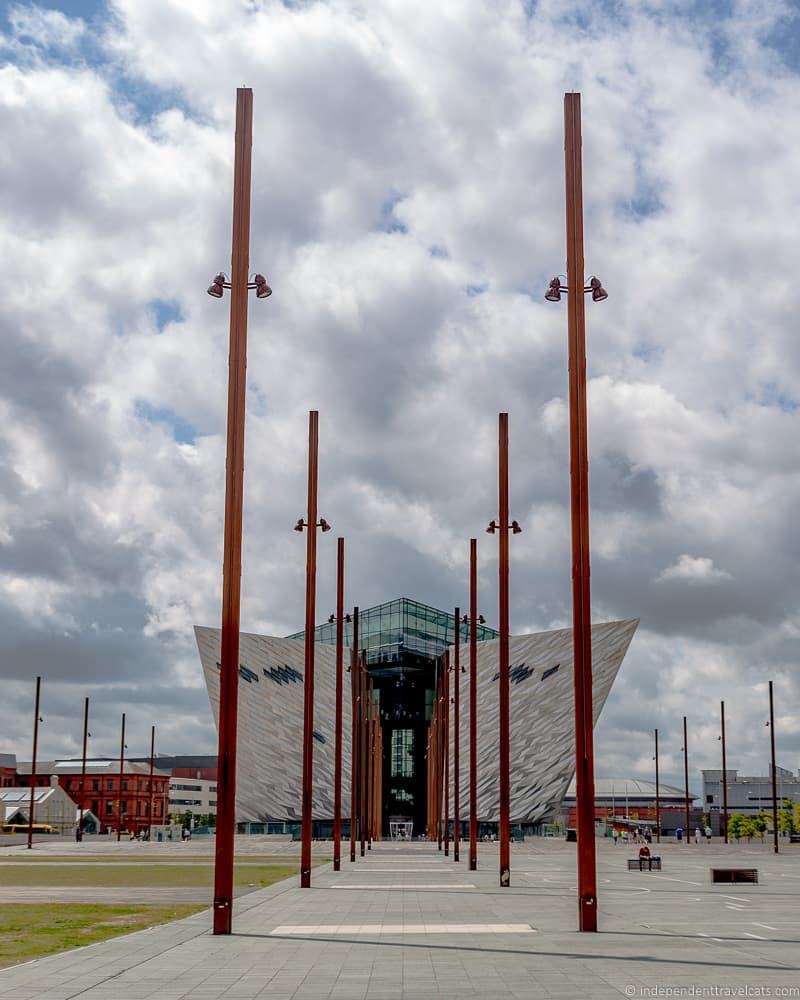
Top Things to do in Belfast: Central Belfast
There are many things to do in Belfast and many are conveniently located within central Belfast. We are roughly categorizing central Belfast as encompassing the areas that are often referred to as Belfast City Centre, the Cathedral Quarter, and the Linen Quarter. Once here, you can reach anything within this general area within a 20 minute walk or less.
The Belfast City Hall is the center point of the city and nearby is the Visit Belfast Welcome Centre, which is a great place to start your tour of the city. The Cathedral Quarter, named for St. Anne’s Cathedral, is the city’s historic trading quarter and is packed with Victorian architecture, cobbled streets, and quirky pubs and restaurants. The Linen Quarter is the area south of Belfast City Hall and was an area once dominated by the linen industry in the 19th century and includes a lot of old architecture, restaurants, and the Grand Opera House.
We are also including the Titanic Quarter, the former shipbuilding area formerly known as Queen’s Island where the RMS Titanic was built, within this section since most visitors plan to visit the Titanic Belfast museum. The Titanic Belfast can be reached by walking via a 30 minute walk across the bridge from the Belfast city center area. All of the attractions in the Titanic Quarter can be reached within a 45 minute walk, a 20 minute public bus ride, or by the hop-on hop-off sightseeing buses.
All the attractions in this first section are located within a 25 minute public bus ride from Belfast City Hall (Donegall Square) although most are within a 10 to 20 minute walk.
Use this list of things to do in Belfast to choose the attractions of interest to you and put together your own personalized Belfast itinerary!
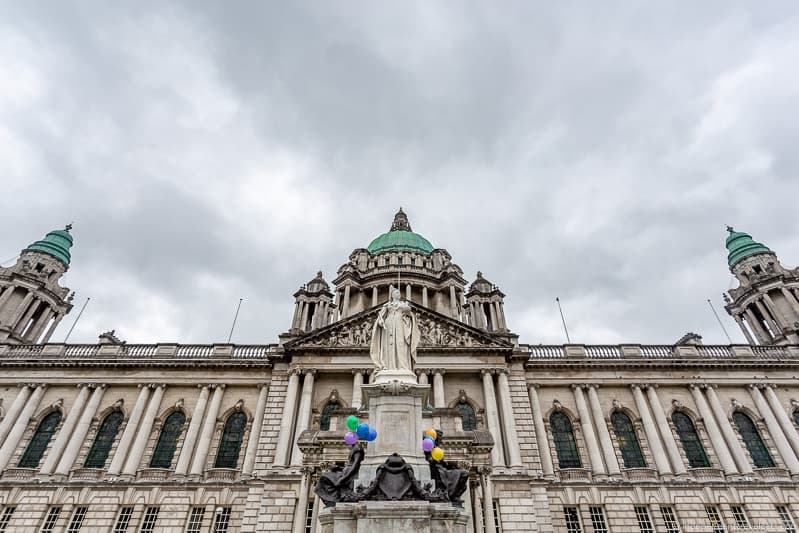
Sightseeing Bus or Walking Tour
A walking tour or sightseeing bus is always a good way to get a feel for a city and see some of its highlights. We often like to do these on our first day in a new city. Most of these start from the city center area.
Walking tours are a great way to explore a certain area of the city or focus on a specific topic. Available tours focus on highlights, the Titanic Quarter, architecture, whiskey, Queen’s University, the Troubles, and other topics. You can see a list of walking tours here and more walking tours here .
Bike tours around the city are also possible, such as these ones , and even these beer bike tours where you can bring your own alcoholic drinks to enjoy while pedaling a 16-set bike and listing to guide.
For food and drink tours also see Taste and Tour which offers gin, whiskey, beer, and food walking tours around central Belfast.
There are two hop-on hop-off sightseeing buses in Belfast, the City Sightseeing buses and the City Tours buses. These buses each stop at 20 to 30 different places and make it easy to reach and visit many of the city’s most popular attractions.
In Belfast, you also have Black Cab tours which are a popular way to see the city and most of these tours focus on the political history of Belfast and its street murals. We cover these tours in greater detail later in the article.
If you prefer boat tours, you might consider this boat sightseeing tour which takes you past the Titanic Quarter.
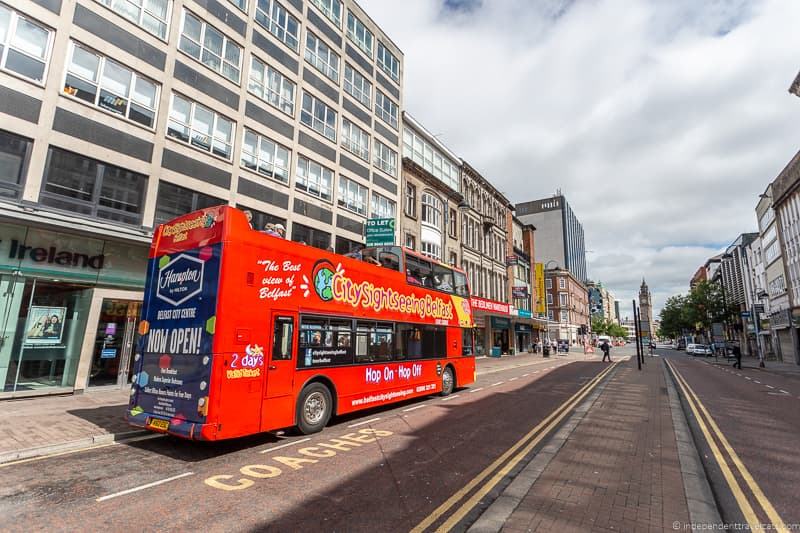
Belfast City Hall
Belfast’s City Hall was built after Queen Victoria granted Belfast city status in 1888 to reflect its growth in terms of population, economy, and industry. The building, which sits in the center of Donegall Square, was designed by Irish architect Alfred Brumwell Thomas in the Baroque Revival Style and it was completed in 1906. The City Hall is a great centerpiece for the city as well as a functioning government building that serves as the headquarters of the Belfast City Council.
Inside the building, there is a free public exhibition space that you can visit. The exhibition was much larger than we expected and currently encompasses 16 different rooms! It tells the history of Belfast through information, photos, and artifacts, and it explores the city’s government, people, famous events, industries, diversity, festivities, and much more.
It is also possible to take a free guided tour of City Hall. A guided tour includes information about the history and government of Belfast and visits to many of the grandest and most important areas and rooms in the building, including the Grand Staircase, Principal Rooms, the Reception Room, and the Chamber. One of the interesting features of the building is the large number of stained glass windows, most of which are original to the building and date to 1906.
Tours are given on a first come, first serve basis and you need to register for them at least 10 to 15 minutes before the stated tour time. So we’d recommend going at least 20 to 30 minutes before the tour time to get a spot. The guided tours of City Hall last around 1 hour, and run at various times throughout the day, depending on the time of year. You can see the tour times on the official website here .
Outside, there is a large park and gardens area around the building that is a popular place for people to meet and gather. During our last visit, it was being used for a family event and outdoor cinema screenings.
There are also a number of statues and memorials worth seeing around the City Hall building, including the grand 11-foot statue of Queen Victoria, the Belfast Cenotaph , and a 9/11 plaque. You’ll also find the Titanic Memorial Gardens here, which includes a memorial statue as well as a list of all those who perished in the disaster.
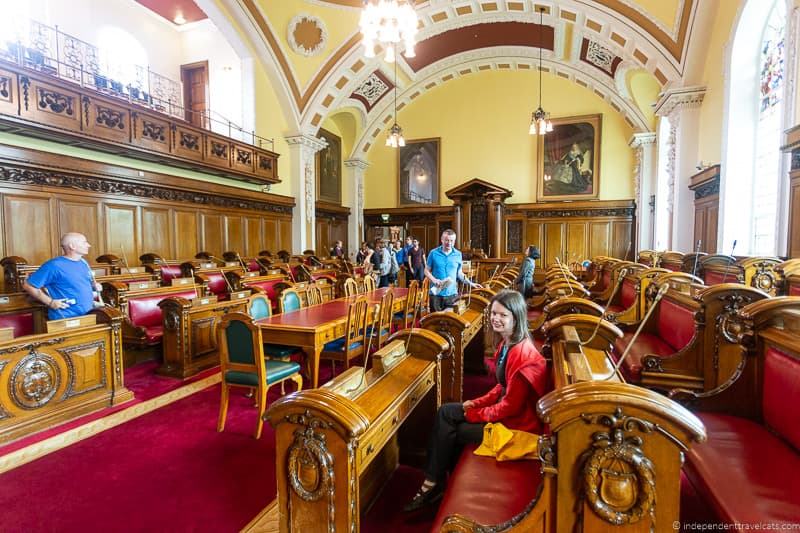
St. Anne’s Cathedral
St Anne’s Cathedral , also known as Belfast Cathedral, is an Episcopalian (Anglican) cathedral and one of the best known churches in Belfast. It was consecrated in 1904 and serves two separate dioceses with two Bishop’s Seats.
A former smaller church, consecrated in 1776, was also called St. Anne’s and stood here until the new and much larger cathedral was built. The old St. Anne’s had become too small to accommodate the large number of people moving to Belfast during the Industrial Revolution and a second Anglican church, St. George’s Church (located on High Street), was completed in 1816. It too was not enough and so a new St. Anne’s was built.
The church’s foundation stone was laid in 1899, but the church was rebuilt and expanded a number of times over the next 100 years to reach its present day form. The most interesting recent development was the addition of a stainless steel spire, called the Spire of Hope, to the church in 2007. A church spire was not originally added to the church because the church could not support the weight. The spire is usually illuminated at night.
Inside the church there are a number of elements you can check out if you decide to explore the church. These include the Good Samaritan Window (the only remaining piece of the 1776 St. Anne’s Church), mosaics on the roof of the baptistery and Chapel of the Holy Spirit (St. Patrick is depicted), and the Titanic funeral pall.
There is only one tomb in the cathedral, which is the tomb of Lord Edward Carson , an important 20th century unionist political leader in Ireland. He is one of only a few non-royal people to ever receive a British state funeral.
There is a small fee to visit as a tourist. Visits are self-guided but guided tours can be arranged in advance. Belfast Cathedral is an active church and there are regular worship services and events.
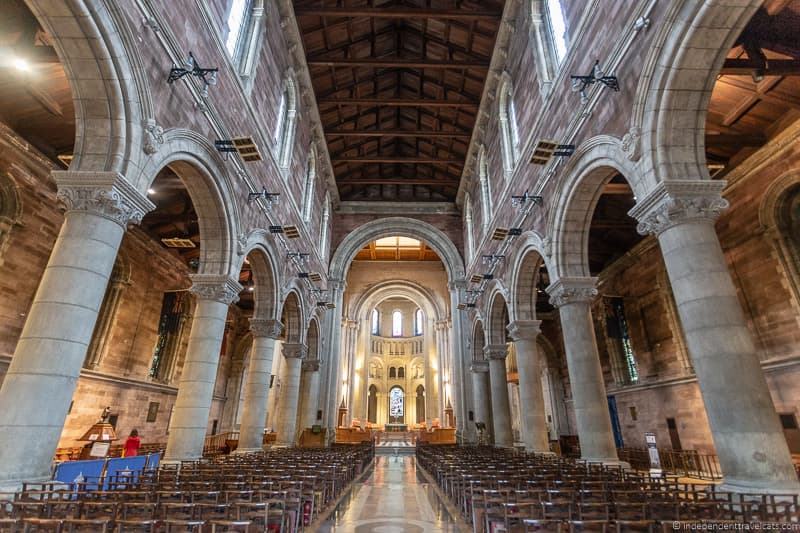
St. George’s Market
St. George’s Market is one of Belfast’s oldest attractions, and it is believed that a weekly market has been held in this location since 1604. The current Victorian building was built between 1890 and 1896, and today it holds markets each Friday, Saturday, and Sunday. Since its refurbishment in 1997, it has won a number of awards in the UK and Ireland.
The market vendors include fresh produce and food stuff, arts and crafts, souvenirs, spices, clothing, books, jewelry, and more. The market is particularly well-known for its number of fish and seafood vendors. The market also has food stalls selling prepared food, sandwiches, coffee, and snacks. On most days, there is live music from local artists and bands. The market is a popular and lively place to go on weekends.
Markets are held on Fridays, Saturdays, and Sundays. You can find the latest hours here . A free market shuttle bus runs every 20 minutes, 11am – 3pm, to and from the market from locations in central Belfast (Friday and Saturday only).
The market changes each day it is open with different vendors, although some are there all three days. The venue is also used to host a range of events throughout the year, including musical performances and charity events.
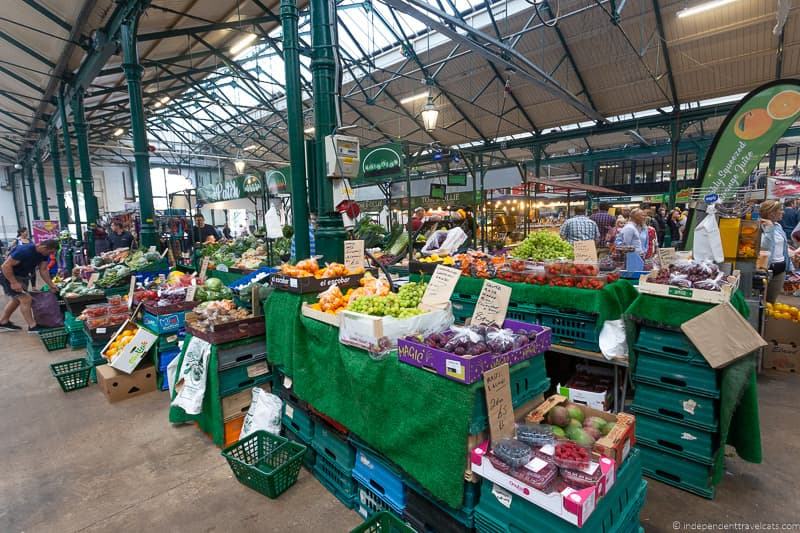
Grand Opera House
The Grand Opera House was built in 1895 by famous English theater architect Frank Matcham . The Grand Opera House has become a city landmark and is well-known for its beautiful interior. It is the only Victorian theater still remaining in Northern Ireland.
Originally, the theatre could seat over 2,500 guests and it hosted a number of operas, plays, musicals, and pantomimes. It was later used for variety shows throughout the early 20th century. In the 1950’s it was converted into a cinema and then in 1972, it closed. The building was almost demolished in the 1970’s during The Troubles, but was saved and reopened as a theater in 1980.
Today, the Grand Opera House is still running as a theater although today it only seats 1,000 people. Current performances include musicals, plays, dances, family shows, recitals, ballets, pantomimes, operas, and educational talks.
You can also book a theatre tour of the Grand Opera House. Guided tours include a behind-the-scenes tour of the Grand Opera House to learn about the history, day-to-day life of the staff and actors, and to tour the various rooms and areas of the theatre. Tours last about 1 hour, and are normally given on weekends about twice a month.
If you book an opera tour, it is a good idea to show up a little early to explore the self-guided Heritage Exhibition that can be accessed by tour participants.
You can check the performance schedule, check tour times, and book tickets here .
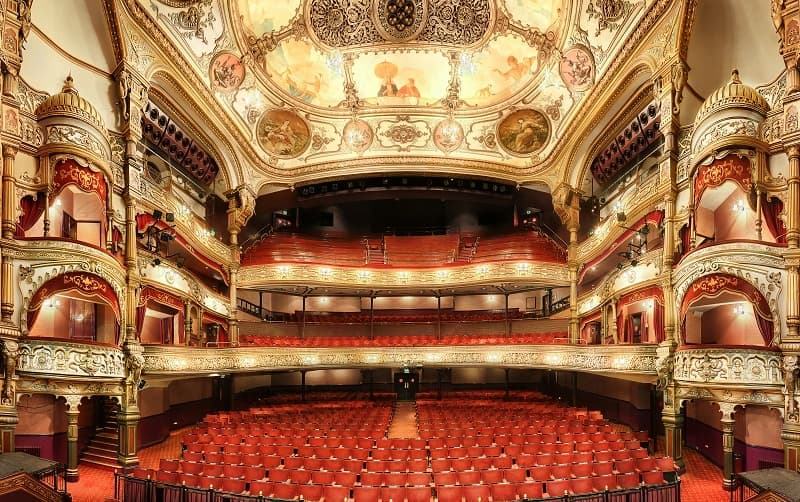
Albert Memorial Clock
The Albert Memorial Clock is a sandstone clock tower that was built as a memorial to Prince Albert, the husband of Queen Victoria. It is located at Queen’s Square in the center of Belfast and was built by Irish architect W.J. Barre and completed in 1869. Today, the Albert Memorial Clock is a popular local landmark in Belfast
The clock tower is 113 feet high and includes a number of intricate carvings. The main feature is a statue of Prince Albert wearing his Knight of the Garter robes. The clock’s bell weighs 2 tonnes. The clock tower has sustained damage by both German WW2 bombs and IRA bombs.
It is Belfast’s own “leaning tower of Pisa” as the tower leans due to being built on reclaimed marshy land. The clock tower started to lean soon after it was built and the tilt has worsened over time. In 2002, a restoration project was undertaken by the city to try to strengthen the foundation and to clean and restore the leaning monument.
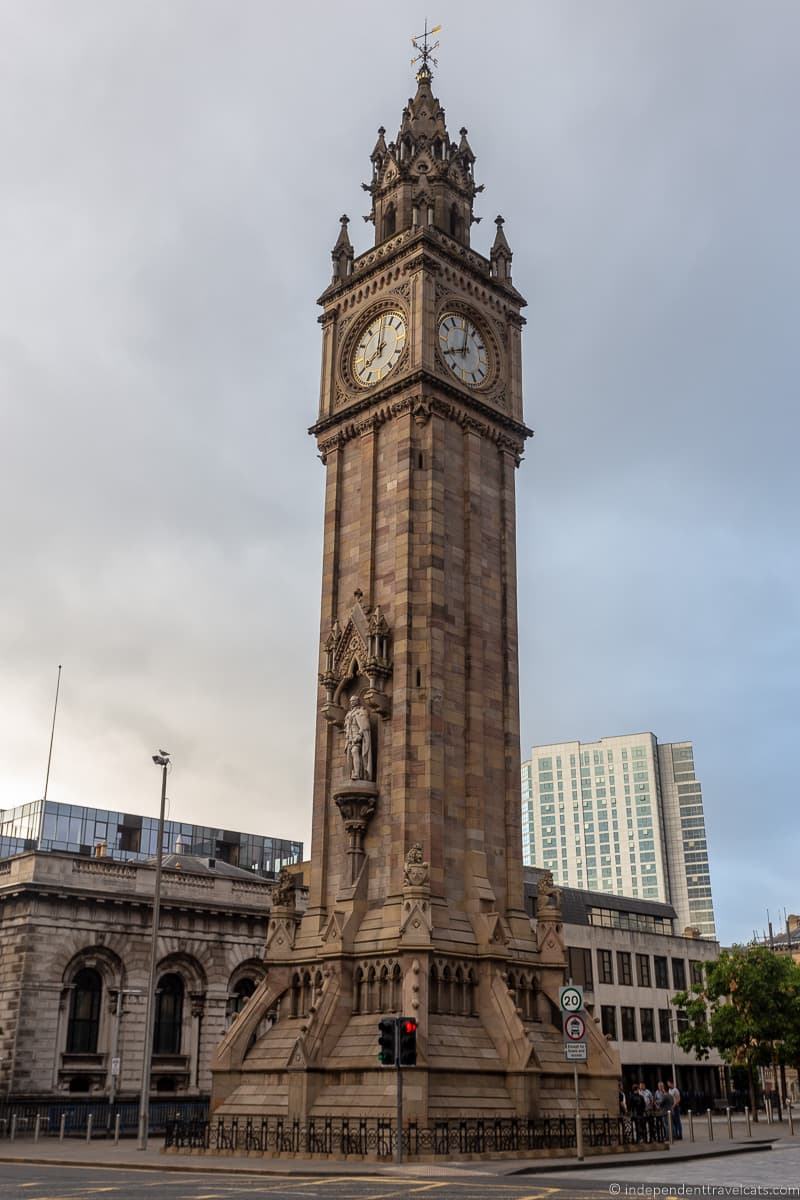
Metropolitan Arts Centre (The MAC)
The MAC, Belfast’s Metropolitan Arts Centre, was opened in 2012 and is a public art center that includes three major art galleries. The exhibitions vary throughout the year and most are free to visit, but some do have a fee.
The focus of the art is generally modern, contemporary, and experimental pieces and performances. You can see what’s on during your visit by visiting the art exhibition page .
The MAC also regularly has events and workshops, including art classes, art shows, performances, talks, and family-friendly activities. You can see the full event listing here .
The MAC has a café bar serving coffee, tea, snacks, hot meals, and alcoholic drinks.
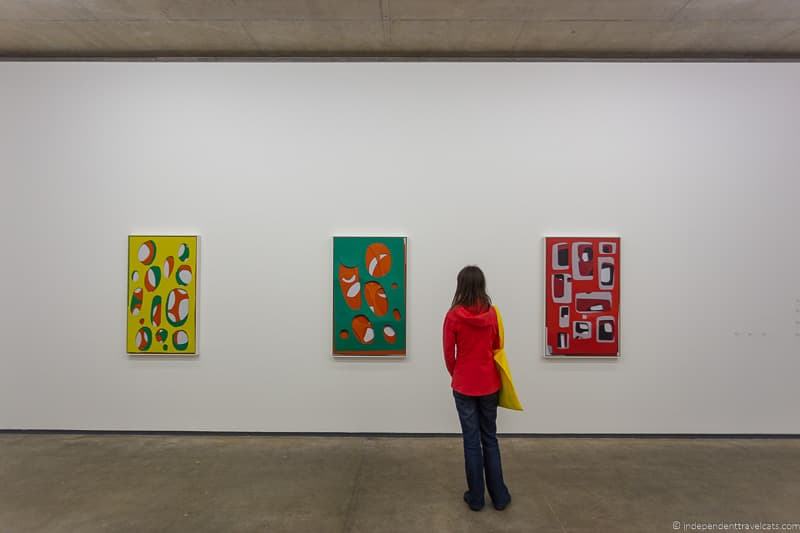
North Ireland War Memorial Museum
The Northern Ireland War Memorial Museum is a small museum that covers Northern Ireland’s involvement in World War II. The informational exhibits cover the Belfast Blitz, the roles of women during the war, the Ulster Home Guard, and the presence of a large number of American forces in the area. There are uniforms and medals on display as well as a memorial screen.
It is a small museum fit into one large room, but it is thoughtfully done and well-organized and primarily run by local volunteers. We really enjoyed our visit. Highlights were listening to some of the recordings by people who lived during the war, the lovely stained glass window, and learning more about the Belfast Blitz of 1941.
Belfast was initially thought to be out of the range of Nazi bombers so the military and residents were unprepared for air attacks when they first started happening, resulting in a lot of damage and deaths.
The Northern Ireland War Memorial Museum is free to visit although donations are greatly appreciated. It is centrally located in the Cathedral Quarter near St. Anne’s Cathedral.

Crown Liquor Saloon
The Crown Liquor Saloon, better known as the Crown Bar, is the most famous pub in Belfast. The pub was opened around 1826 by Felix O’Hanlon as The Railway Tavern but it would be its renovation and renaming in 1885 by the Flanagan family that would turn it into the pub we know today. It was known as one of the most beautiful Victorian era gin palaces in the world.
It is ornately decorated and still retains many of its original fixtures and decorations (most of which have been restored) including tiled mosaics, original gas lamp features, stained glass, a granite bar top, snugs, heated footrests behind bar, and carved wooden ceiling. It is now owned by the National Trust who helps protect it but it is run as a pub by Mitchells & Butlers.
The place is a very popular stop for tourists and the bar attracts a number of famous visitors. Famous visitors have included Brad Pitt, Prince Harry and Meghan Markle, and most of the cast of Game of Thrones .
The pub has a full bar menu and serves both lunch and dinner. There is also an upstairs dining area. It is a popular place so if you plan to stop and eat here, I’d recommend booking a table in advance. You can see the menus and contact info here .
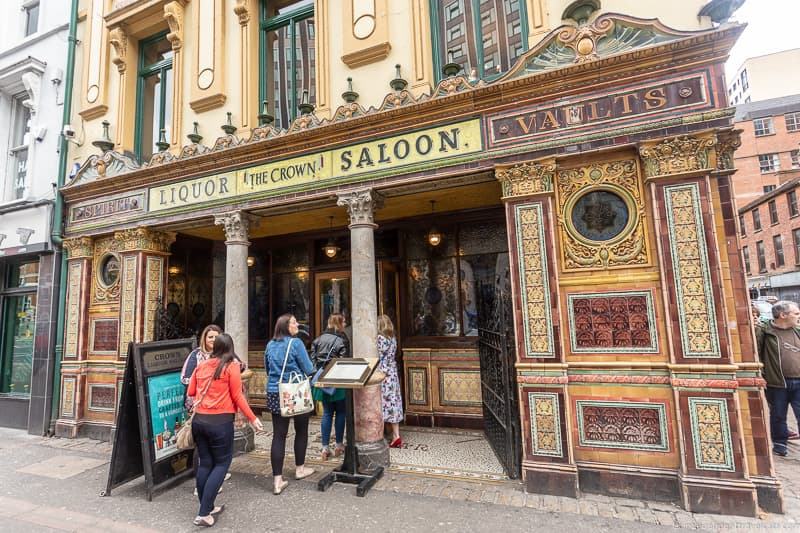
Belfast Black Cab Tours
The Black Cab tours of Belfast are one of the most popular things to do in Belfast for tourists. The use of taxis in Belfast grew during The Troubles when the cabs were used to transport locals and visitors during the Troubles as they were considered much safer than city buses which were sometimes bombed or attacked by snipers. Also many buses were stolen, burned, and used for barricades in certain parts of the city, resulting in limited public transit.
So more taxi drivers were needed during this period. Many drove defunct bus routes and most drivers operated only in Loyalist/Unionist/Protestant neighborhoods or only in Republican/Nationalist/Catholic areas. For the most part, Protestant drivers picked up Protestant passengers and Catholic drivers picked up Catholic passengers. Both used the same London black taxi models. Following the Good Friday agreement in 1998, the need for taxi services by locals decreased as public transit became safer and more available.
Today, many of the now iconic black taxis are still used to give visitors tours of the city. Most of the cab tours focus on the political history, the Troubles, and the political murals so this is one of the best ways to find out more about the political struggles in Belfast. However, you can also do tours that also include general neighborhood tours and those that focus on general history and culture.
Some of the Troubles focused tours may also stop at places like the Eileen Hickey Irish Republican History Museum and/or the Shankill Bombing Memorial, which are both located not far from the Peace Wall. If these are sites of interest, let your driver know.
Most drivers were also drivers during the Troubles and can share stories about what it was like during that time. Drivers try to provide objective and neutral information; however, as you can imagine this is a difficult thing since many were on one side or the other of the struggle. Most people in Belfast lost family and/or friends during the Troubles. There are many “versions of the truth” about certain events out there.
We did a black cab tour with Touring Around Belfast and had the pleasure of having one of the best known Belfast black cab drivers Billy Scott as our driver guide. Billy is a Blue Badge guide (highest qualification in UK) and was friendly, informative, and made the tour fun. He would stop often and join us in the back seat to give us history and information about places and share relevant stories. He knows so much about Belfast, the Troubles, and the city’s attractions, and is a man that is always up for some great craic.
We had a 2 hour tour scheduled with Billy, and he let us decide what parts of the city we wanted to visit and what we wanted to see and learn about. We asked for a tour that was equally focused on politics as well as general history/culture. We also didn’t know the city well so asked to see some of the highlights of the main city neighborhoods.
It was a great introduction to Belfast, its main neighborhood and attractions, and the Troubles. We saw parts of several neighborhoods including Cathedral Quarter, Queen’s Quarter, the Linen Quarter, Sailortown, and the Titanic Quarter. We also visited the Peace Wall and saw a large number of political murals in both traditionally Loyalist and Republican neighborhoods, including along Falls and Shankill Roads. Most of the tour was in the cab but we were also given the opportunity to get out and walk around a bit at a few of the stops.
We definitely recommend considering a black taxi tour if this is your first time to Belfast or if you want to learn more about the Troubles. It is best to book a cab tour in advance.
We booked with Touring Around Belfast , but there are also several other options including this tour focused on the political murals and these cab tours .
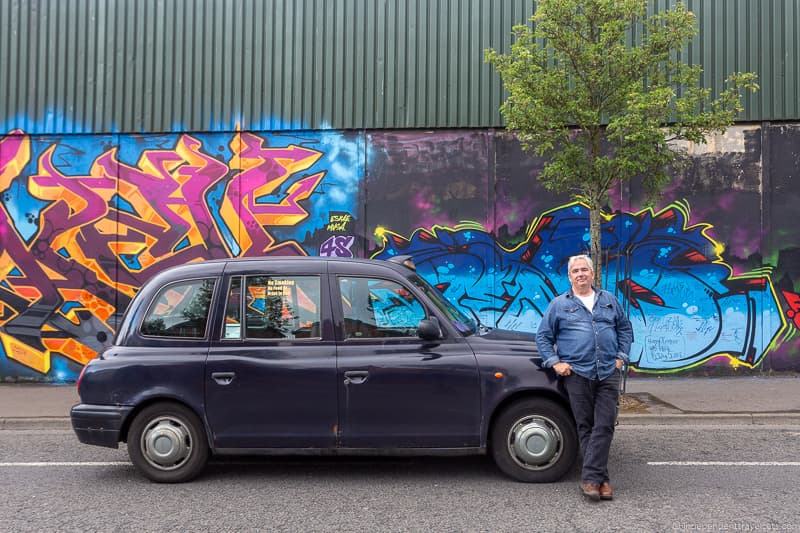
Victoria Square Shopping Centre
Victoria Square is a centrally located public square and the area is a popular place for shopping and dining. The Victoria Square Shopping Centre is a 4-storey shopping mall and leisure complex opened in 2008. It contains a number of stores, restaurants, a spa, and a cinema. There is also a viewing platform within the central glass dome that offers a good panoramic view of the city.
Outside on Victoria Square is the Jaffe Memorial Fountain that was erected in 1874 by Otto Jaffe as a memorial to his father Daniel Joseph Jaffe. Otto Jaffe was Belfast’s first Jewish Lord Mayor and his father had been a local linen merchant who had helped fund the building of Belfast’s first synagogue at Great Victoria Street.
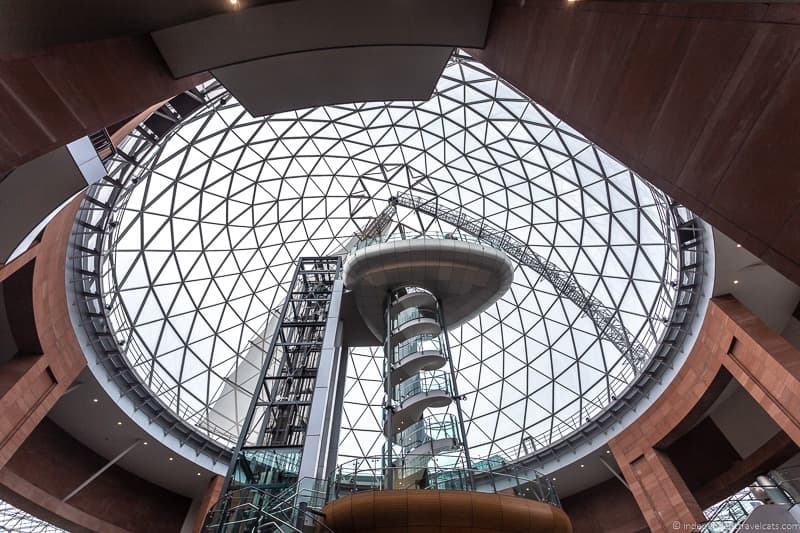
Explore the Waterfront Area
The waterfront area is located along the River Lagan. Here you’ll find a number of sculptures, bridges, Sinclair Seaman’s Church, the old Customs House, the Barge Museum, and Waterfront Hall (a large entertainment venue).
If you have some time to explore this area, we’d suggest walking the Maritime Mile, which is an outdoor trail that is about 1 mile long, connecting a number of maritime sites. There are information panels along the way. It starts at the City Quays and then continues along across the river to the Titanic Quarter, ending at the HMS Caroline and Titanic Dock . You can find out more about it here .
A pedestrian footbridge, built in 2015, crosses the River Lagan and connects the Waterfront area to the Titanic Quarter.
At the Belfast Harbour offices in Corporation Square, you can stop to visit the Heritage Room exhibition at the Belfast Harbour offices in Corporation Square. The exhibition focuses on Belfast’s maritime history and includes artifacts and artwork.
Outside the AC Hotel is the first of the six Games of Thrones large stained glass windows that were placed here in 2019 to celebrate 10 years of the show’s filming. Each depicts an iconic scene from the show. You can see all 6 by following the Maritime Mile trail along the waterfront.
If you just have a short time, two of our favorite things to stop and see here are the Salmon of Knowledge and the Beacon of Hope.
Salmon of Knowledge
The Salmon of Knowledge, better known as the Big Fish, is a large sculpture of a salmon along the waterfront. It was made by local artists John Kindness. It is located at the meeting point of Belfast’s two major rivers, the River Farset (from which Belfast gets its name) and the River Lagan.
The Salmon of Knowledge is a mythical creature figuring in the Fenian Cycle of Irish mythology. It is said that the Salmon of Knowledge gained all the world’s knowledge after it ate hazelnuts from a holy tree. If caught it could grant universal knowledge to whoever eats it. In one story, it is eaten by Fionn mac Cumhaill who gains universal wisdom.
The Big Fish sculpture is covered in printed ceramic tiles, and each one tells a different story related to the city’s history. Tiles include all types of information and images, from historical images to drawings from local school children.
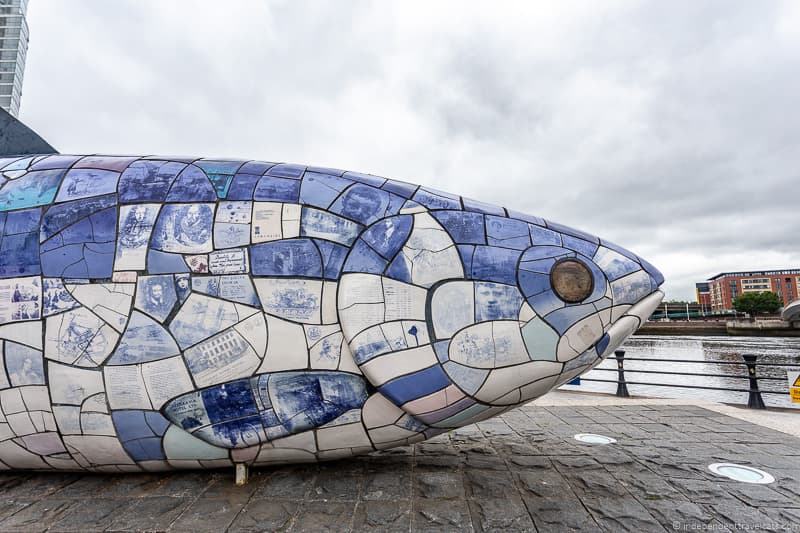
Beacon of Hope
The Beacon of Hope, or Thanksgiving Square Beacon, is a large stainless steel and bronze sculpture of a lady holding a large ring, which is meant to symbolize thanksgiving. The woman has a globe at her feet which celebrates peace and harmony, and which is marked with the global cities that have been significantly associated with the people and industries of Belfast.
It sits within Thanksgiving Square near the entrance to the Victorian era Queen’s Bridge. It was made by artist Andy Scott in 2006.
Belfast Barge Museum
The Belfast Barge Museum is a small museum set on a barge that tells the story of Belfast’s industrial heritage and maritime history.
The MV Confiance is a former cargo barge that was purchased in 2006 and sailed to Belfast, and turned into a museum, event space, and a café. It is moored in the River Lagan in Belfast’s waterfront area.
There is a small fee to visit the Belfast Barge Museum. You can find out more information here .
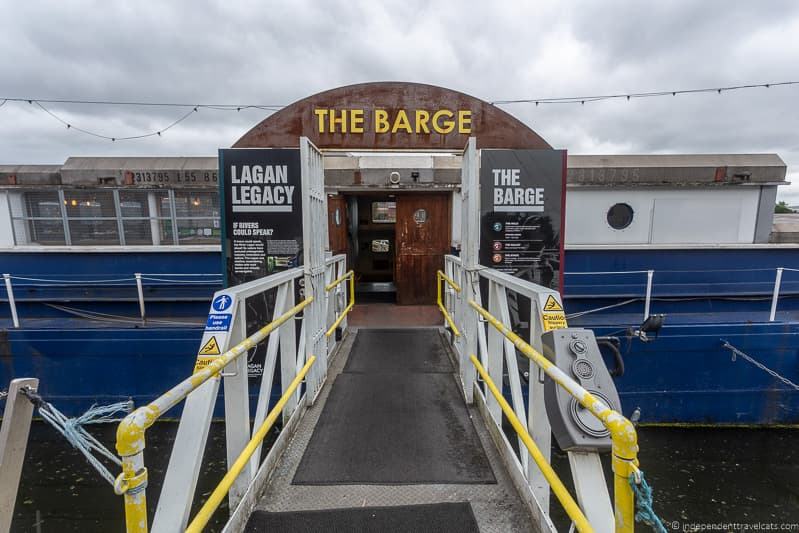
Titanic Belfast Museum
The Titanic Belfast is the most popular attraction in Belfast and a must-see for most visitors. It is a huge attraction where visitors are self-guided through a series of galleries to learn the history of the RMS Titanic .
Belfast was chosen as the site for the Titanic visitor attraction because the RMS Titanic was built in Belfast’s dockyards by local shipbuilding firm Harland & Wolff . Other famous ships built here include the RMS Olympic and HMS Belfast (currently docked as a museum ship in London). The shipyard continued to build ships until 2003 and today is focused on making offshore wind turbines.
When you visit the museum, you follow a self-guided path (audioguides are available to rent for a small fee) that begins with information about Belfast in the 20th century. Then you continue to follow a path that takes you through a series of galleries that tells you about shipbuilding in Belfast, the building of the RMS Titanic , the launch of the Titanic , its maiden voyage, its sinking, and the aftermath of the tragedy.
There are lots of informational panels, models, photographs, replica interiors of the Titanic , artifacts, and interactive exhibits to enhance the experience. One of the galleries is explored while on a mini-car ride. There are of course references to James Cameron’s famous 1997 film Titanic as well. The final room allows visitors to see video footage and photographs of the Titanic as she now lies at the bottom of the ocean.
If you have any interest in the RMS Titanic or shipbuilding, we highly recommend a visit here. Visitors often spend 1.5 to 2 hours exploring the museum, but leave more time if you are a huge Titanic fan and/or if you plan to eat here.
There is a large gift shop, a grab-and-go cafe, and a restaurant on site. There is also the Hickson’s Point pub located just outside the building.
The Belfast Titanic museum operates a timed ticketing system, with entrances every 15 minutes from opening time. At last check, pre-booked timed tickets were required due to the COVID-19 pandemic safety precautions.
Of all the things to do in Belfast, this is the most popular attraction so we recommend you get your ticket in advance here to avoid standing in and line, and coming early to avoid the crowds. Tickets bought online also include your entrance to the SS Nomadic , which is located next to the Titanic Museum.
If you are planning to visit here, we recommend checking out our Titanic sites in Belfast guide as it covers visiting the Titanic Belfast and several other attractions in and near Belfast.
We also recommend leaving some time to explore the area just outside of the Titanic Belfast building. You can see the Titanic and Olympic slipways and the Titanic sculpture by Rowan Gillespie, both are located next to the building. Also next door is the Titanic Hotel which occupies the former Harland & Wolff Headquarters and Drawing Offices where the designs for Titanic were completed.
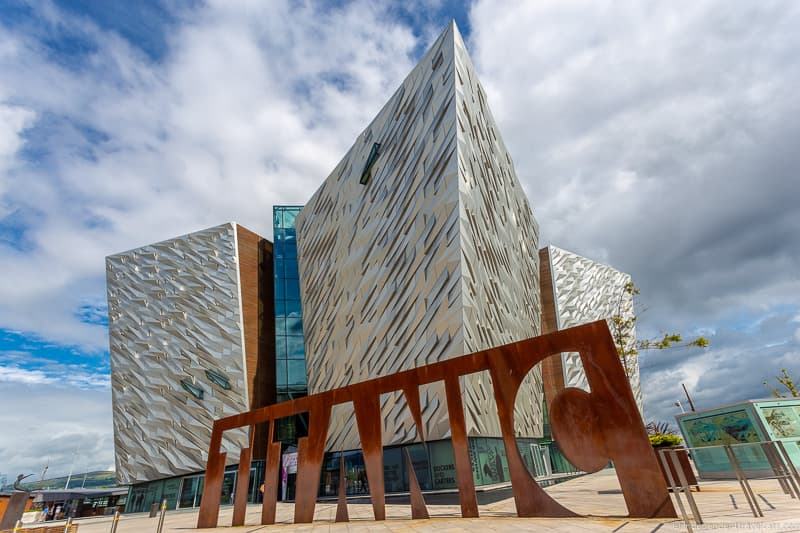
The SS Nomadic was built by Harland & Wolff in Belfast as a tender boat to serve White Star Line passenger ships such as the RMS Titanic and the RMS Olympic in places where the ships were too large to dock. The ship launched in April 1911, and the SS Nomadic is now the last surviving White Star Line ship in the world.
On April 10, 1912, the SS Nomadic was used to ferry first and second class passengers, their luggage, and ship supplies onto the RMS Titanic from Cherbourg Harbor in France. Many of the most famous passengers sailed on the SS Nomadic to reach the Titanic, included John Jacob Astor IV and his wife, Margaret Brown, and Benjamin Guggenheim.
The SS Nomadic was also used as a passenger ship tender for the RMS Olympic and later for Cunard ocean liners. During WWI and WW2, the ship was used as a minesweeper and troop transport ship. She was retired from service in 1968, and later was used as a floating restaurant ship on the Seine River in Paris for almost 30 years.
In 2006, the Northern Ireland government purchased the SS Nomadic and brought the ship back to Belfast to be restored and turned into a ship museum. Following extensive restoration, the SS Nomadic was opened to visitors in June 2013.
Today, you can tour the beautifully restored ship and learn all about its construction, uses, restoration, and history. The SS Nomadic was built by the same company at the same time as the Titanic so is the closest you can get to having a sense of what it was like on the grand ill-fated ship.
We’d recommend visiting this in conjunction with the Belfast Titanic museum, as you can purchase an entry ticket that will get you access to both the Titanic Belfast and SS Nomadic on the same day. The two attractions are only a short walk apart.
If you plan to only visit the SS Nomadic , you can normally also book a ticket online on their website or purchase one in person at the ship. However, these individual tickets have not been available since the start of the COVID-19 pandemic and it is unclear when and if they will be sold again. So for the time being you need to purchase a combination ticket if you want to visit.
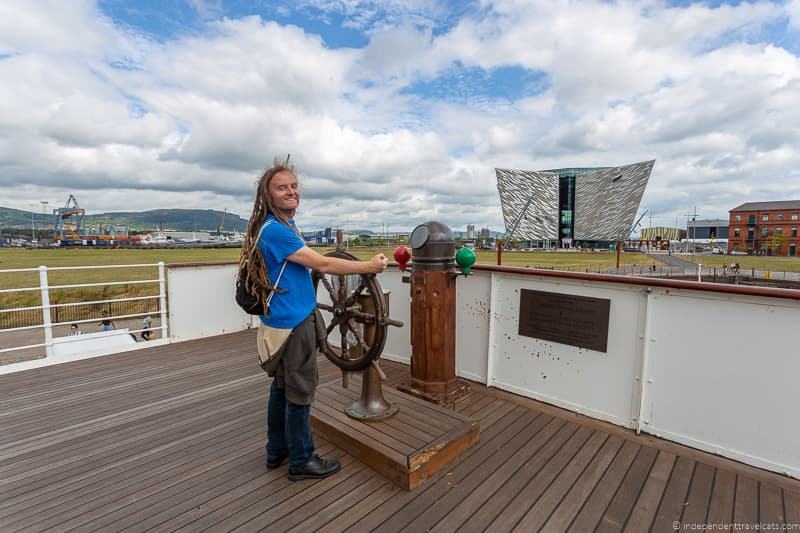
W5 Science & Discovery Centre
The W5 Science & Discovery Centre is an interactive science center that is designed to inform and entertain children and families. It contains over 250 interactive exhibits spread across four exhibition areas that are designed for children to be able to be active and engage in hands-on learning and discovery. There is also a daily program of live science demonstrations, talks, and shows.
There is a coffee shop on-site serving sandwiches, soup, snacks, coffee, and drinks.
There is a fee to enter the W5 Science and Discovery Centre. Tickets can be purchased on-site or online in advance.
The W5 is located within the larger Odyssey Pavillion within the Titanic Quarter. There is parking on-site, or you can get here via public bus or the hop-on hop-off sightseeing buses. The W5 is about a 25 minute walk from Belfast city center or a 10 minute walk away from the Titanic Belfast museum.
In addition to the W5, the Odyssey Pavillion is also home to the SSE Arena which is home to the Belfast Giants (ice hockey team), a multi-plex cinema, a bowling alley, a sports bar, a pizza place, a Segway company, and a coffee shop.

HMS Caroline
The HMS Caroline was a light cruiser built in Birkenhead, England in 1914 for the British Royal Navy. She served during WWI, including during the Battle of Jutland , which was the largest naval battle of the war, and is now the sole survivor from that battle.
In 1924, the HMS Caroline was moved to Belfast Docks to form the headquarters for the Ulster Division of the Royal Naval Volunteer Reserve. She would serve as a depot ship and strategic operations base for convoy protection during WWII.
The HMS Caroline would serve as part of the Ulster Division of the Royal Navy reserve until 2009 and was decommissioned in 2011. The ship was restored and opened as a ship museum in Belfast’s Titanic Quarter in 2016.
Today, you can do a self-guided tour of the HMS Caroline and learn about her construction, history, and the living and working conditions on board through exhibits, films, recreated historic spaces, and interactive touch screen displays. Start at the Dockside Museum (small museum next to the ship) to learn about the people who served on the ship and then board the ship. There are also nice views of the harbor from the decks of the ship.
There is a small café and a gift shop on the ship. You can purchase tickets on-site or in advance online. You can save a little money by booking your tickets in advance .
The HMS Caroline sits in the Alexandra Graving Dock right next to the Titanic Pump House. It is about a 15 minute walk away from the Titanic Belfast museum. There is parking located here for visitors, and you can also reach it via public bus or the hop-on hop-off sightseeing buses.
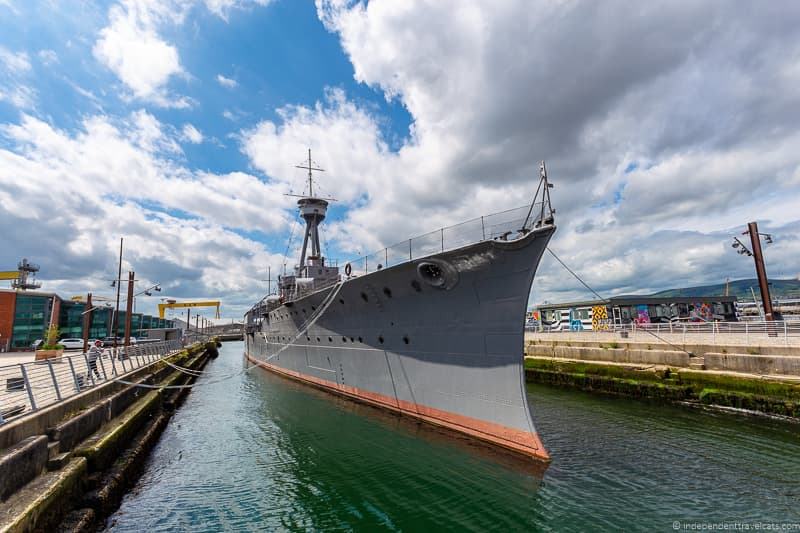
Samson & Goliath Cranes
Samson and Goliath are two large shipbuilding cranes owned by Harland and Wolff, and they are situated within the Titanic Quarter in the Harland & Wolff shipyard. They were built in 1969 and 1974 at a time when Harland & Wolff was still one of the largest shipbuilders in the world. They were named after the Biblical figures of the same name.
These were obviously not used in the construction of the Titanic. However, an enormous steel gantry, called the Arrol Gantry, was created in 1908 over the slipways for the Olympic and Titanic. It was also a dominant feature in the Belfast skyline for decades and was in use until the 1960’s.
You can’t get too close to the cranes as they are in an active and private industrial area, but they are easy to spot. The two yellow cranes with the H&W logo dominate the skyline and can be seen from many parts of the city.
Although Harland & Wolff are not much involved in shipbuilding and the two cranes are rarely used today, they have remained as they have become popular symbols of the city of Belfast. They are now sort of protected by the Northern Ireland Environment Agency, and it is hoped they will continue to remain in Belfast.
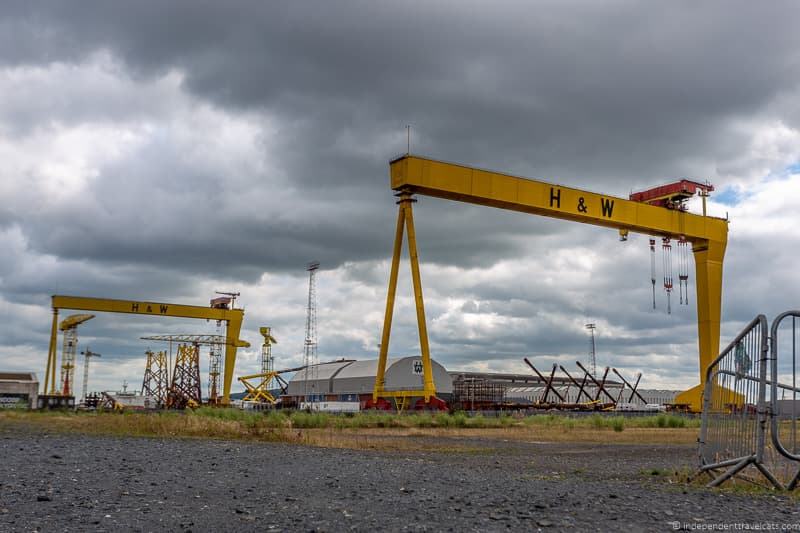
Titanic Walkway
The Titanic Walkway is a 500 meter (0.3 mile) walkway on Victoria Wharf which connects the Titanic Slipways to the HMS Caroline . The maritime walkway was first opened in 2018 as a way to make it easier for pedestrians to visit some of the popular attractions within the Titanic Quarter.
The walkway goes along the water and docks. Notable attractions along the route include the Titanic Belfast, Titanic and Olympic Slipways, Mew Light, public art (including a couple of the Games of Thrones windows), the HMS Caroline , and the Titanic Dock and Pump House.
From the walkway, you can also see the Titanic Exhibition Center (giant conference center) and Titanic Studios (filming studios where Games of Thornes was filmed). You’ll also see the Samson & Goliath cranes in the distance.
The Mew Light, or the Great Light, is the world’s first and largest hyper-radial Fresnes lighthouse lens. It was first used at Tory Island Lighthouse in 1887 and later moved to Mew Island in 1928. It was removed from Mew Island in 2014, and has been restored and situated along the Titanic Walkway. Panels around the light tells about its history and how it works.
The Titanic Walkway is a great way to connect a visit to the Belfast Titanic to either the HMS Caroline and/or the Titanic Pump Room & Dock. To start the walk, just head outside the Titanic Belfast museum and head towards the water to visit the Olympic and Titanic Slipways, then head northeast along the walkway towards the HMS Caroline .
If you want a different perspective of the Titanic Quarter, consider a River Lagan boat cruise which allows you to see all the Titanic Quarter sites from the water with onboard commentary. In the summer, there is also the chance to see seals.
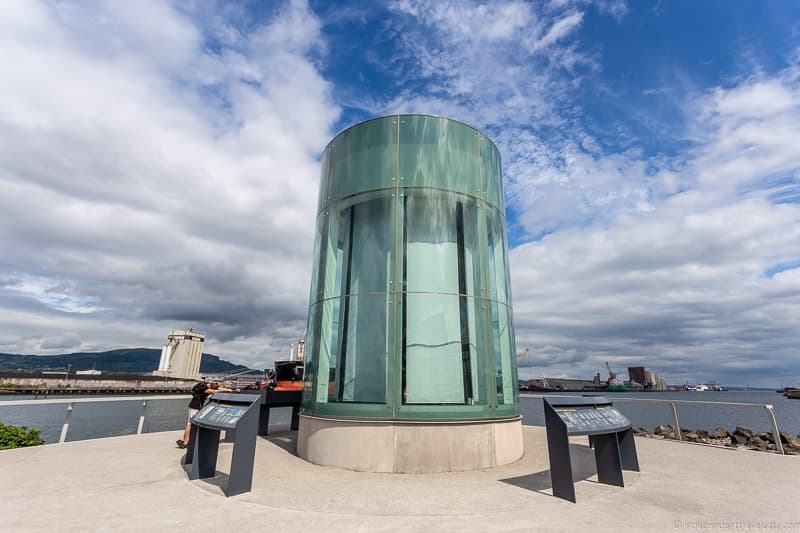
Titanic Dock & Pump House
The Titanic Dock and Pump House is a great place to visit to get a better sense of the large scale of the RMS Titanic. This was where the Titanic sat in dry dock before her sea trials and maiden voyage in April 1912.
The White Star liners RMS Olympic and RMS Titanic were the largest ocean liners ever built at the time, and so larger dry docks had to be built for them. This is where the ships were fitted out and completed in dry dock after being constructed at the slipways across from the Titanic Belfast museum.
Construction on the Titanic began in 1909 and took 3 years. The Thompson Graving Dock, often now called the Titanic Dock, was where the Titanic was fitted out and completed in 1912. The adjacent dock pump house, now called the Titanic Pump House, was used to pump out water from the Thompson Graving Dock as well as the Alexandra Graving Dock (where the HMS Caroline now sits).
Visitors can do a self-guided tour of the Titanic Pump House as well as the Titanic Dock. Walking around and climbing down into the Thompson Graving Dock gives you a good sense of the massive size of these ocean liners as the whole footprint of the graving dock would have been the size of the ship’s hull. Informational placards tell you about its construction, fitting out, the lives of the dock workers, and how the pump room worked.
There is a small fee to visit the Titanic Pump Room & Titanic Dock, payable in Cafe 1404 which is also where you can access the sites. If you’d rather have a guided experience, you can book a guided tour of the dock and pump room or join a walking tour which includes the visit here.
The Titanic Pump House and Dock is located about a 1 minute walk from the HMS Caroline and a 10 minute walk from the Titanic Museum.

Check out the Street Murals
The street murals in Belfast are well-known worldwide and it is a popular city for street art enthusiasts. Even if you are not interested in street art, you are bound to run into some of the city’s street murals as they are everywhere.
Initially, most of the street murals were political and related to The Troubles in Northern Ireland, and were created by people with a variety of perspectives from both sides. Most of the more politically focused murals are further from the city center with many located around the Peace Wall.
There are still a large number of political street murals that you can see and these are the primary focus of many Black Cab and street art tours in Belfast. Some serve as memorials to people who were killed or incarcerated during the Troubles. We saw a number of these murals on our Black Cab tour, which a great way to explore them as they are spread apart.
Within the city center, there is still a lot of street art to see but the majority is not strongly political or religious in nature. Although some do tackle serious topics, you’ll also find street murals of dogs, famous people, fairies, local landmarks, dragons, and monkeys. Some are created by relatively unknown local artists and some are by more famous artists like Smug, and there have been local initiatives that have helped fund legal street art in Belfast.
We did a street art walking tour that primarily focused on the non-political murals with Seedhead Arts . But there are a variety of street mural tours in Belfast including walking tours such as this one and Black cab tours such as this one .
See our guide to street art in Belfast for more information about finding and appreciating Belfast’s and a photo essay of some of the popular murals.
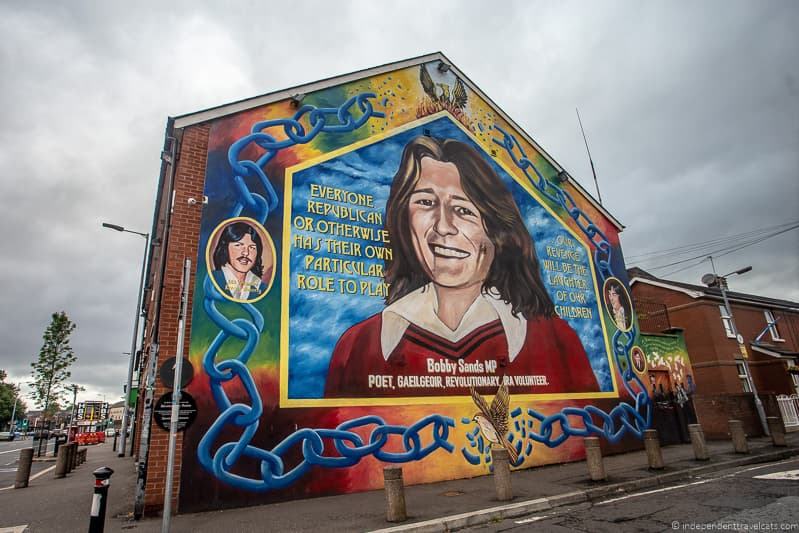
Check out some Evening Entertainment
There is always something going on in Belfast and whether you are looking for a play, stand up comedy act, art exhibit, or just a local band at a pub, you’ll likely find something happening in Belfast. You can find out what’s happening by asking around, visiting the Visitor Center, checking a local newspaper, and/or checking out this page and this website .
We already mentioned the Grand Opera House earlier, but two of Belfast’s others main centrally-located concert and entertainment spaces are the Ulster Hall and Waterfront Hall. If you are looking for a concert, play, comedy show, or festival, I’d check out what’s happening at each of these venues during your visit.
Opened in 1862, Ulster Hall was by designed by William J. Barre. A wide variety of notable performances and events have been held here from readings by Charles Dickens to rock concerts by AC/DC and Iron Maiden to political talks by Lord Randolph Churchill and Lord Carson. Ulster Hall underwent a larger restoration in 2007, and it houses one of the few surviving functioning classic English pipe organs.
Belfast Waterfront is a multi-purpose entertainment and conference center located on the waterfront. It opened in 1997 and is used for a number of purposes, including concerts, theatre shows, stand-up comedy, business conferences, and other events. It is a key venue for Belfast International Arts Festival events.
You can see what’s on during your visit at both Waterfront Hall and Ulster Hall here .

Try the Local Drinks in Belfast
Belfast is a great place to have a drink. The city is probably best known for beer and whiskey, but gin is currently a very popular spirit in the city as well. Craft breweries and new distilleries are opening up around Northern Ireland and it is an exciting time to sample some of these new arrivals.
If you are looking for craft beers on tap, a few brewery names to look out for are Hilden, Sheelin, Hercules Brewing (known for their Yardsman beers), Whitewater, and Farmageddon. Northern Irish gins include Shortcross, Jawbox, and Copeland.
The most popular Northern Irish whiskey brand is Bushmills, but Echlinville and Rademon Estate also produce whiskey. Head to The Friend at Hand whiskey shop in the Cathedral Quarter to learn more about Irish whiskey and purchase a bottle, the store says it has the largest collection of Irish whiskey.
We actually did a really fun gin tour around central Belfast with a company called Taste and Tour that included 7 generous drinks and some nibbles in several locations. Gins included famous international brands as well as local ones. The company also does whiskey walks, beer crawls, and food tours around Belfast.
If you are looking for a few suggestions for a place to drink, here are several places we’ve been:
- The Crown Bar – An elaborately decorated Victorian era gin palace that is a local landmark and popular tourist stop. Full bar and restaurant. Reservations recommended if you want to sit and eat.
- Muriel’s Cafe Bar – Muriel’s is the place all the locals tell you to go if you want a cocktail. But you can get everything at the small quirky bar from a traditional pint to a range of craft gins. Also serves food.
- John Hewitt Bar – A traditional style bar with live music and full range of drinks. Owned and operated by the Belfast Unemployed Resource Centre.
- The Duke of York – This traditional pub has been a staple of the Cathedral Quarter for over 200 years. It was rebuilt after being flattened by a bomb in 1972 during the Troubles. The pub is a local institution and is popular with tourists. It has interesting furniture and decorations and is filled with local memorabilia related to brewing and distilling. It also has colorful outdoor murals.
- Sweet Afton Bar & Brewery – A bar and restaurant in the Linen Quarter serving classic favorites and local craft beers. They also serve a few American craft beers.
- Sunflower Public House – If you are looking for a simple pub, the Sunflower Public House may be your spot. The corner pub is probably best known for keeping its security cage around its front door which became a common occurrence during The Troubles. Good place for a pint and often has live music.
- Babel Bar: If you’re looking for a rooftop bar, the Babel Bar in the Bullitt Hotel is a great choice. One of the few rooftop bars in Belfast. Also a second bar located in the hotel courtyard. Full range of drinks and cocktails.
- The Cocktail Bar – If you are looking for a classy bar and don’t mind the higher price of drinks, The Cocktail Bar at The Merchant Hotel is likely the place for you. This Victorian era luxury hotel is a beautiful setting for a drink. Hotel also has a jazz bar, a classic pub, a champagne lounge, and other dining spots.
- Whites Tavern : If you like old historical taverns, Whites Tavern may be the place for you. This tavern has been serving drinks since 1630. Serves hearty pub food and regularly has live music.
- Bittles Bar. Found near Victoria Square, this curiously shaped pub is not dissimilar to the Flat Iron building in New York. Built in 1868 and has been service great beer ever since.
If you are looking to experience a local brewery, we’d recommend a trip just outside Belfast to Lisburn (10 miles away) where you can visit Hilden Brewery , Ireland’s oldest independent brewery. Hilden is a well-known craft brewery and you can sample the beers, take a tour of the distillery, and eat in their restaurant.
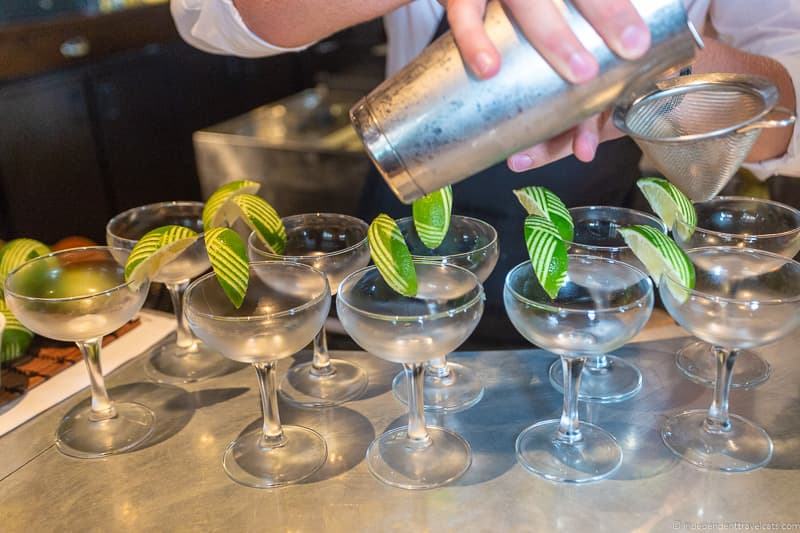
Sample the Irish Food
The dish most associated with Northern Ireland is Ulster fry. An Ulster fry is the Northern Irish version of the British “full breakfast” that you’ll find throughout the UK and Ireland. It normally includes fried eggs, sausage, back bacon, soda farl, tomato, black pudding, and potato bread. White pudding, hashbrowns, fried mushrooms, and baked beans are also normal accompaniments. Served with tea or coffee and eaten in the morning for breakfast.
You’ll find many of the dishes common throughout Ireland and the UK in Northern Ireland so dishes like Irish stew, bangers and mash, Sunday roasts, and fish and chips are common. Potatoes have long been important to Ireland so you’ll find potato dishes like colcannon (mashed potatoes with cabbage or kale), potato bread, boxty (potato pancake), and champ (mashed potatoes with spring onion, cheese, and butter). Seafood dishes are common particularly fried eel and salmon.
Agriculture is a major industry in Northern Ireland and you can find a lot of locally grown, raised, and produced food products. These are easy to find at St. George’s Market as well as in local grocery stores and on the menus of local restaurants in Belfast. Some to look out for are dairy products (Abernethy butter, milk, cheese, ice cream), local seafood (salmon, eels, oysters), breads (soda bread and potato bread in particular), Bramley apples (as well as apple juice, jam, and cider), and locally raised meats (beef, pork, venison).
If you have a sweet tooth, a popular Northern Irish candy is Yellowman which is a chewy honeycomb toffee-like candy. Aunt Sandra’s Candy Factory is a popular local spot to buy handmade candies, chocolates, and fudge.

Things to do in Belfast: Beyond Central Belfast
If you have more than a day or two in Belfast, you may have time to explore beyond central Belfast and the Titanic Quarter. Your choices of things to do in Belfast beyond the central area are varied and include museums, gardens, parks, a zoo, political sites, and a Victorian prison.
We particularly recommend the Queen’s Quarter area which includes Queen’s University, the Ulster Museum, and the Botanic Gardens. The Crumlin Road Gaol will appeal to those who enjoy touring old prisons. The Cave Hill Country Park includes hiking trails, the Belfast Zoo, Belfast Castle, and a children’s playground. The Peace Wall is a popular stop for seeing the political murals, usually during a Black Cab tour. There are also plenty of green places around Belfast for hiking, walks, and even wildlife viewing.
Most of these attractions are located within the city of Belfast but some lie in areas just outside Belfast. Most can be reached by public bus within 30 to 40 minutes, and some can be visited using the hop-on hop-off sightseeing buses. All are located within a 30 minute drive fo the city center, and some are less than a 10 minute drive from the city center.
The first physical divides or peace lines were built in 1969 after the outbreak of riots in Northern Ireland and the beginning of the Troubles. The walls, fences, and other barriers were used to divide predominately Ulster/Protestant/Unionist areas of a neighborhood from predominately Loyalist/Catholic/Nationalist areas of a neighborhood.
The initial walls were meant to be temporary measures to help protect people on both sides, but they became bigger, longer, and more sturdy over time. Today there are over 40 wall structures, called peace lines or peace walls, stretching for miles in Belfast. These are primarily in the residential areas in the northwest areas of Belfast. They also exist in a few other towns and cities in Northern Ireland such as Londonderry/Derry.
Interestingly, the number of Peace Walls has not decreased since the Good Friday Agreement in 1998, but have actually increased. Some of the walls have gates which allow access during daylight hours but these gates are closed after dark. They are sometimes policed, but not so much these days. Sectarian violence has significantly decreased, but many residents still find the walls comforting and many people in these neighborhoods have grown up with the walls.
In recent years, the walls and political murals painted along or near the walls have become tourist attractions. Most black cab tours stop here as ours did. Visitors have the opportunity to write their own message on the Peace Wall, which has been covered in murals, as well as signed by famous people including the Dalai Lama and former U.S. President Bill Clinton.
There is a large movement to remove the Peace Walls in the near future, and the government hopes the walls will be removed by 2023 in cooperation with people on both sides of the wall.
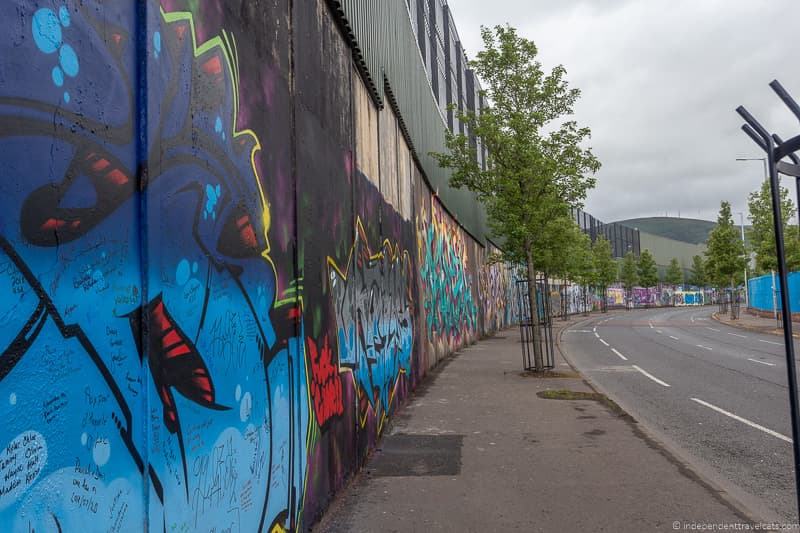
Crumlin Road Goal
The HMP Crumlin, better known as the Crumlin Road Gaol , is a former prison that opened in Belfast in 1846. For over 150 years, it was one of Northern Ireland’s main prisons, and is today the only surviving Victorian era prison in Northern Ireland.
At the time the prison was built, it was one of the most up-to-date prisons of its time and was designed to house up to 500 prisoners. However, in later years, during the Troubles, there were so many people sent to prison that it was forced to hold many more than this, resulting in cramped conditions. The Crumlin Road Gaol closed in 1996 as a prison, and following an extensive restoration project, was opened as a visitor attraction in 2012.
Visits are timed and guided. Guides lead you through the major parts of the prison and explain the entry process for new inmates. The tour includes a visit to the cell blocks, the tunnel which linked the prison with the courthouse over the road, and the execution chamber. Seventeen prisoners were executed on site by hanging, with the last execution taking place in 1961.
The knowledgeable guides on the tour share lots of information about the history of the prison, its architecture, and notable inmates. The regular tours lasts about 75 to 90 minutes. There are also sometimes specialty tours offered such as paranormal tours and night tours of the prison.
There is a fee to tour the prison, and tour times can be booked in advance online or on site. It’s definitely worth booking your tour in advance, as this is both cheaper and will also guarantee the time you want. Tours run about every 30 minutes.
There is a gift shop and an on-site coffee shop where you can get sandwiches and drinks.
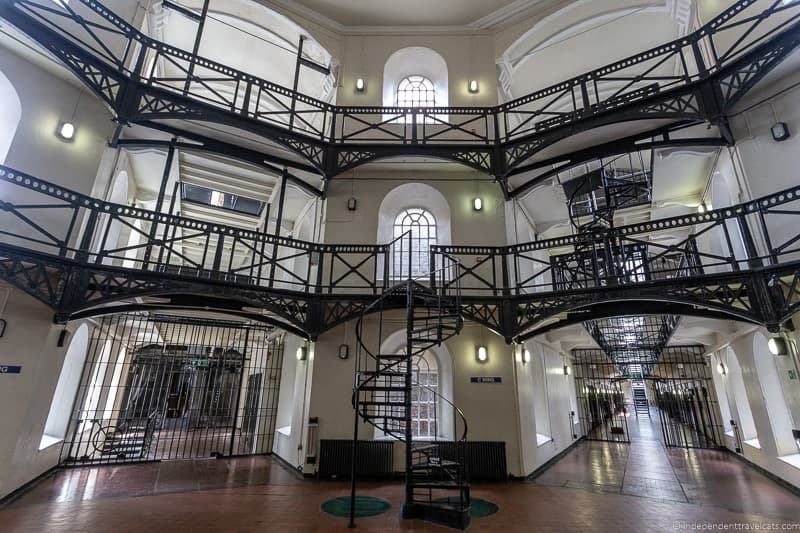
Stormont Estate – Northern Ireland Parliament
The Northern Ireland Parliament buildings are located on the Stormont Estate. The Northern Ireland Assembly, the legislative body for Northern Ireland, was established under the Belfast Agreement 1998 (Good Friday Agreement). Before being used for government purposes, the estate belong to Reverend John Cleland.
The main Northern Ireland Assembly building was designed by Sir Arnold Thornely and is 365 feet wide (one for each day of the year) with six floors and six front pillars (one for each NI county). It was completed in 1932.
The public can visit the Parliament buildings during most of the year, Monday to Friday. Tours are free and last about 1 hour. The tours include stops to learn about the history and architecture of the buildings and to see the Great Hall, the Senate Chamber, and the Assembly Chamber. The public can also sit in on Assembly debates and committee meetings. See latest tour times here .
Outside, you can admire the building and wander along some of the walking nature paths around the parkland. There are several statues and memorials, and there is also a picnic area, fitness area, and children’s play area.
There is a coffee shop and gift shop within the main building. The Members’ Dining Rooms are also open to the public for meals and afternoon tea, reservations are recommended.
The Stormont Estate has parking and can also be visited by public bus or by using the hop-on hop-off sightseeing bus. There is no fee for visiting the Stormont Estate or Parliament Buildings; however, you will need to go through a security check at the gate and airport-style security to gain entrance to the building.
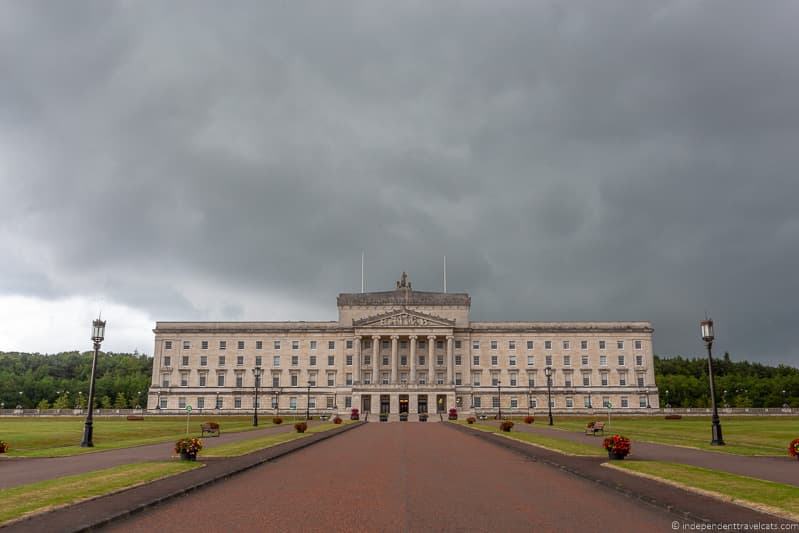
C.S. Lewis Square
The C.S. Lewis Square is a square located in East Belfast dedicated to the Belfast author Clive Staples Lewis . C.S. Lewis is most famous for his children’s fantasy book series The Chronicles of Narnia series as well as his Christian apologetic adult nonfiction books such as Mere Christianity .
The square contains a number of large bronze sculptures depicting characters from The Lion, the Witch, and the Wardrobe including Aslan, The Beavers, and The White Witch. The sculptures were made by Northern Irish artist Maurice Harron and are situated in a place not too far from Lewis’s birthplace. This is a fun place to bring any fan of the Narnia series!
Fans of C.S. Lewis may also want to see other sites related to Lewis in the area, including this birthplace on Dundela Avenue (Blue Plaque marks spot), Little Lea (family home on Circular drive), St Mark’s Church (where he was baptized and grandfather was rector), Holywood Arches Library (“The Searcher” statue), Belmont Tower, and Campbell College. You can follow a self-guided trail or book a local tour guide.
Next to C. S. Lewis Square is the EastSide Visitor Centre which is a great place to stop to learn more about the city’s attractions and things to do in East Belfast, including self-guided walking trails and walking tours. The local Greenways (walking and cycling routes on disused railway lines) also run right past here. The Centre also has a coffee bar called JACK Coffee Bar which features locally sourced food, products, and artwork.
The square is can be reached by public bus about 20 minute from center. There is parking available nearby.
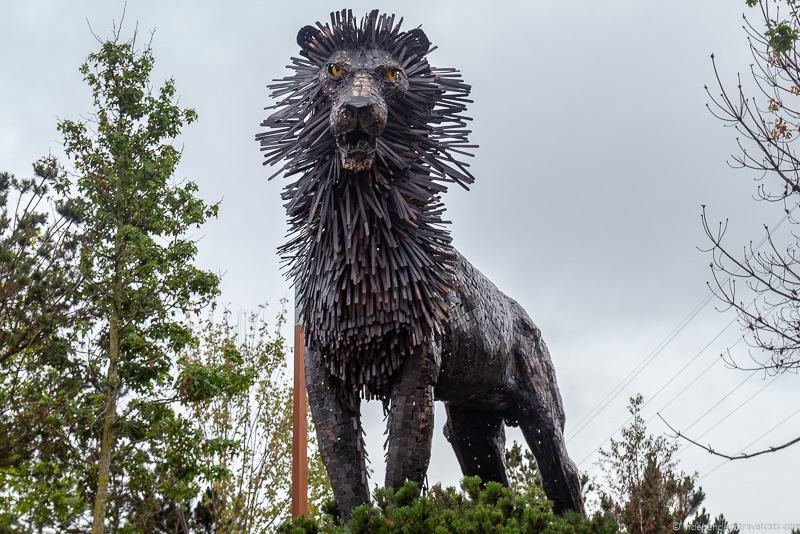
Queen’s University
Queen’s University was chartered in 1845 and opened in Belfast in 1849. It was built to encourage university education for Catholics and Presbyterians at the time as Trinity College in Dublin was at that time an Anglican university.
There are some beautiful buildings in terms of architecture on the Queen’s University campus, particularly the Lanyon building designed by English architect Charles Lanyon. You can check out the Naughton Gallery , an art gallery with both permanent and temporary exhibitions, which offers free public admission. You might also want to see what’s playing at the Queen’s Film Theatre , a popular independent cinema.
Queen’s University is situated next to the Botanic Gardens in Queen’s Quarter, which is a lovely area of Belfast. It is a university student area with lots of coffee shops, independent retail stores, small entertainment venues, and the excellent Ulster Museum. A great place to wander around and explore.
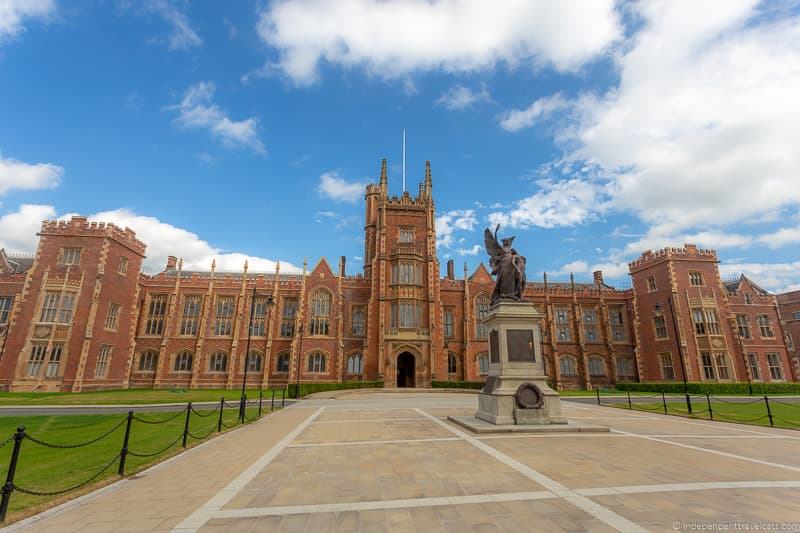
Botanic Gardens
The Botanic Gardens are located in south Belfast within the Queen’s Quarter near Queen’s University. The gardens were originally started as a private park in 1828 but became a public park in 1895. The gardens were one of the most popular Belfast attractions in the Victorian era, and structures in the garden have recently undergone major renovations.
Two of the main features of the gardens are the Palm House conservatory and the Tropical Ravine House. The Pam House is a curvilinear cast iron Victorian glasshouse designed by Charles Lanyon and built by Richard Turner, and display a range of tropical plants. The Tropical Ravine features a sunken ravine and includes a number of the oldest seed plants around today, as well as banana, cinnamon, bromeliad, and orchid plants. There is also a rose garden.
The Botanic Gardens is an important venue for concerts, festivals, and other local events, The Ulster Museum which sits near the main entrance to the gardens. The gardens are a popular place for students of next door Queen’s University to take walks and study.
The Botanic Gardens are open to the public during daylight hours and free to visit. The Palm House and Tropical Ravine have more limited hours.

Ulster Museum
The Ulster Museum is Belfast’s largest museum and one we highly recommend taking the time to visit. The museum has over 1 million objects in its collection which include items related to art, history, and natural science. The museum is located near the main entrance to the Botanic Gardens.
We really enjoyed our time in this museum as there is a bit of everything so just about everyone can find a section of the museum to enjoy. There were dinosaur bones, Neolithic stone axes, jewels, fine art, meteorites, and history exhibits detailing ancient and recent history including the partition of Ireland and the Troubles. If you want relative objectivity in relation to Belfast history, this is probably the best place to find it.
The museum has a number of permanent exhibitions, but also has changing temporary exhibitions. When we visited one of the exhibitions was a massive Game of Thrones Irish linen tapestry that tells the full story of the TV series and sewed locally. The GoT linen is not currently on display but you can see it and learn more about it here .
The museum has an on-site coffee shop which serves hot food and drinks. There is also a cloakroom with lockers that can be rented for £1.
The museum is free to visit, although donations are greatly appreciated.
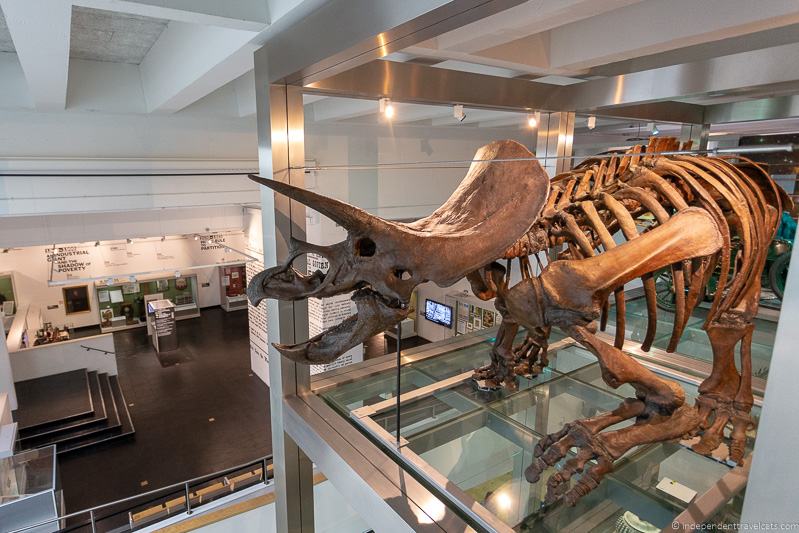
Museum of Orange Heritage
The Museum of Orange Heritage is a museum and interpretive center that covers the history, culture, and traditions of the Orange Order, also known as the Loyal Orange Association. If you want to learn more about the Orange Order, this is a good place to do it. However, it is a good idea to be aware of the religious, cultural, and political significance of the order before you choose to visit.
If you are not familiar with the Orange Order , they are a Protestant fraternal organization that is strongly associated with the Ulster loyalists and British unionism. The main stated goal of the order is to protect and promote Protestantism, although opponents have criticized the group for being anti-Catholic. The group is probably best known for their marches and parades, known as Orange walks, particularly those that take place on July 12th. Some of these walks have been controversial.
Their history dates back to 1795 and it is from King William III, the Prince of Orange, that the organization gets its name. King William III was a Protestant king who defeated the Catholic king James II in the Williamite-Jacobite War in Ireland in the 17th century. The first Orange Order societies formed to commemorate King William III’s victory at the Battle of the Boyne in July 1690.
The museum includes informational and interactive exhibits, and includes artifacts including items owned by King William II. Obviously, the information is going to have a pro-Loyalist bias given its being presented by the society. A good counterpoint if you are planning to visit is the Eileen Hickey Irish Republican History Museum.
The center also has a research and genealogy facility for those wanting to research their family history within the Orange Order.
The museum is located at Schomerg House in the Castlereagh area of Belfast and is generally open Monday through Saturday. It is a 15 to 20 minute bus ride from the town center.
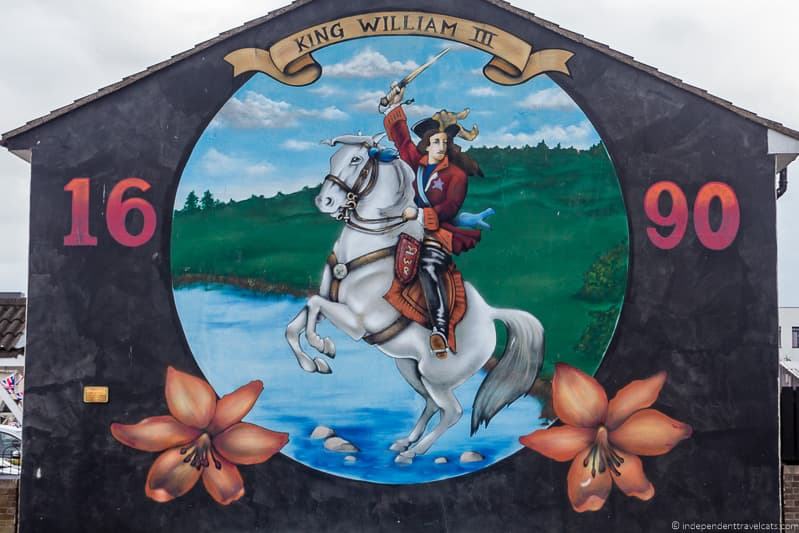
Eileen Hickey Irish Republican History Museum
The Eileen Hickey Irish Republican History Museum is a small museum in West Belfast dedicated to the history of the Republicans in Ireland since the 1960’s. It is situated in the Conways Mill Complex and the mill dates back to 1842. The museum focuses a lot on internment and imprisonment experiences during the Troubles.
The museum is named after Eileen Hickey, a woman who herself was imprisoned in Armagh in the 1970s, and a large portion of the artifacts were collected by her. The museum includes informational exhibits and a number of objects related to the Troubles, particularly related to internment during that time.
The Eileen Hickey Irish Republican History Museum obviously has a Republican (Nationalist / Catholic) bias and focuses on the more positive aspects of the Republican side. But it does have some inclusive information and objects as well. So just know this when you visit and it can be a good counterpoint to a visit to the Museum of Orange Heritage.
The museum is free to visit although donations are greatly appreciated. Some black cab tours stop here.
There are several parking spaces here for drivers. You can also get here by public bus but there is no bus stop super close by (10 to 15 minute walk away). I would recommend stopping here as part of a Black Cab tour or Troubles related tour as it is not far from the Peace Wall.
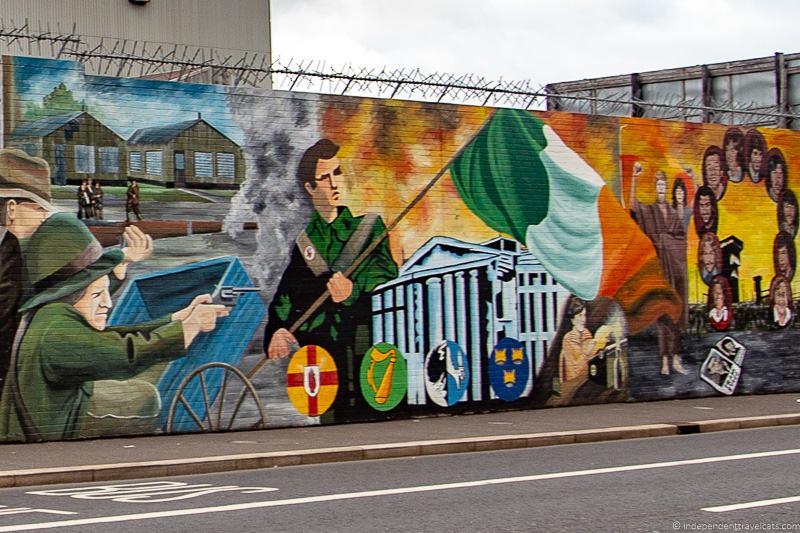
RSPB Window on Wildlife (Belfast Lough Reserve)
The Belfast Lough Reserve is an area of grassland, lagoon, and mudflats that is considered a special place for local wildlife. It is protected and maintained by the Royal Society for the Protection of Birds (RSPB), a bird charity in the UK. There are four components of the reserve: Belfast’s Window on Wildlife, Harbour Meadows, Holywood Banks and Whitehouse Lagoon.
The area provides a place for local birds and wildlife as well as migrating bird species. Over 100 bird species have been observed here and species that are regularly seen include wigeons, teals, oystercatchers, Arctic terns, curlews, and godwits. There are also konik ponies and small mammals who live here.
The public can best learn about the species and have a chance to observe them by visiting the RSPB Window on Wildlife . It is a small center run by staff and volunteers that provides information on local and migrating species and an area with a large window where you can view species in the lagoon and mudflats surrounding the center. There are also a couple of hides and the staff sometimes offers guided walks during certain times of the year.
At the center, you can borrow binoculars to see more from the window and staff can help point out different birds. When we visited we saw several bird species as well as rabbits. The staff member we talked to was very friendly and this place seems a world away from downtown Belfast!
There is a small charge to visit the center and use the shelters. It is free for RSPB members.
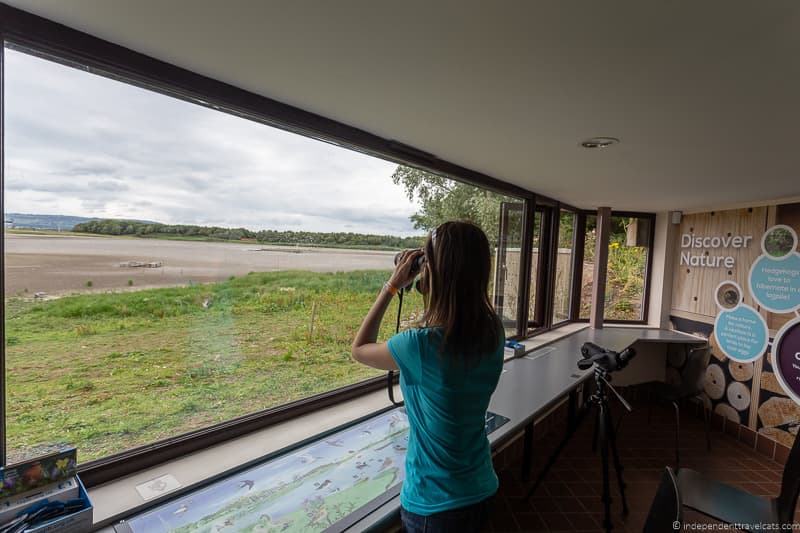
Cave Hill Country Park
Cave Hill, also written as Cavehill, is a large hill formed by basalt lava flows that overlooks Belfast. It has long been a popular spot for local and tourists, and some believe that the hill with its “Napoleon’s Nose” rock formation was the inspiration for the giant in Jonathan Swift’s famous book Gulliver’s Travels .
Cave Hill Country Park is known for its caves, rock formations, ring fort remains, walking and hiking paths, and for being the site of the Belfast Zoo, Belfast Castle, and a large playground. It is a great place if you want to get out of Belfast, do some hiking, and get some nice views over the city (you can see all the way to Scotland on clear days). Given the attractions located here, it is easy to make a whole day of it out here.
The hiking trails are well-signed and range from relatively short and easy to longer and more strenuous. The trails take you near many of the landmarks in the park, including Belfast Castle, Napoleon’s nose, caves, McArt’s fort, Devil’s Punchbowl, and Volunteer’s Well stream, and interpretive signs help point out features, geology, and history.
Cave Hill Country Park is about a 5 mile (8 km) drive out of central Belfast. You can also get here via public bus from Belfast.
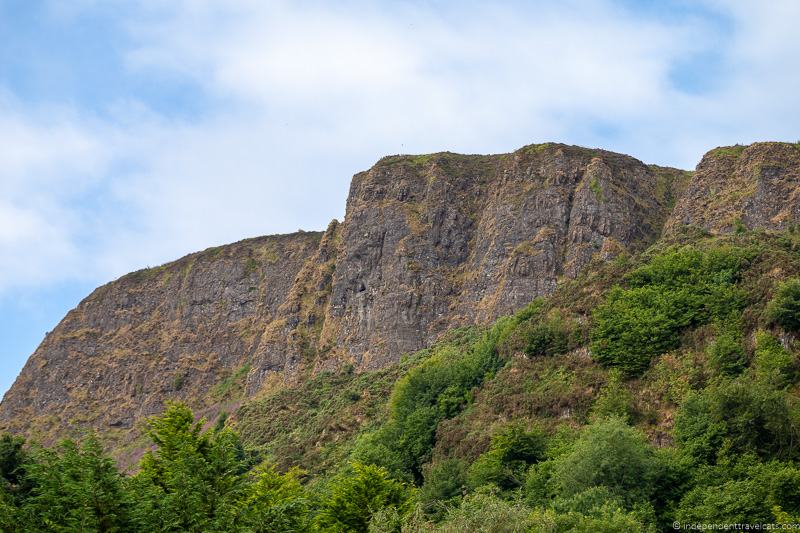
Belfast Zoo
The Belfast Zoo is located on the outskirts of Belfast on the slopes of Cavehill, encompassing 55 acres and has over 1,000 animals from over 100 different species. The zoo offers daily zookeeper talks, feeding times, and other activities.
The zoo opened in 1934 and is one of the most popular paid attractions in Belfast. It suffered a lot during the Belfast Blitz and the 2018 family-friendly film Zoo focuses on the true story of the “elephant angel” who cared for a baby elephant during WWII.
In addition to the animals, the zoo also recently opened a new children’s playground called the Adventurers’ Learning Centre. The zoo is also home to the 1930’s Art Deco Floral Hall, once a popular dance and music venue. The Floral hall was shut and became derelict during the Troubles, but there are plans to refurbish and reopen it as an event space in the future.
The zoo has two cafes on site which serve hot food and drinks as well as a picnic area. There is also a large visitor center and a gift shop.
Most of the zoo and its facilities are wheelchair accessible; however, the zoo is situated on the side of Cavehill so many parts are uphill and some of the paths are steep. There are wheelchairs for free rental and a zoo-mobile vehicle, which can be reserved in advance with the zoo.
The zoo can be reached by public bus from central Belfast, and the zoo offers free parking for visitors. You can purchase tickets on-site or in advance.

Belfast Castle
Belfast Castle was commissioned in the 19th century by George Hamilton Chichester, the 3rd Marquess of Donegall and was designed by Charles Lanyon and his son. If you’ve been to Scotland, the castle may look familiar as it was built in Scottish baronial style. There was an original Belfast Castle built in the 12th century by Normans and it sat not far from where the Belfast City Hall stands today.
Only a small portion of the castle is open to visitors today as much is used as space for offices, conference and event rooms, and dining. It is a popular wedding and conference venue today.
But if you are in visiting Cave Hill Country Park, Belfast Castle is definitely worth a stop. Can be a good place to stop before or after a hike or a visit to the nearby Belfast Zoo. Also close to the Fortwilliam Golf Club.
There is a small exhibit inside about the history of Belfast Castle worth taking a look at. There is also a restaurant and cafe where you can get a meal, coffee, or drink. Outside, the formal garden are beautiful and offer nice views over the city, and they also have cat statues!
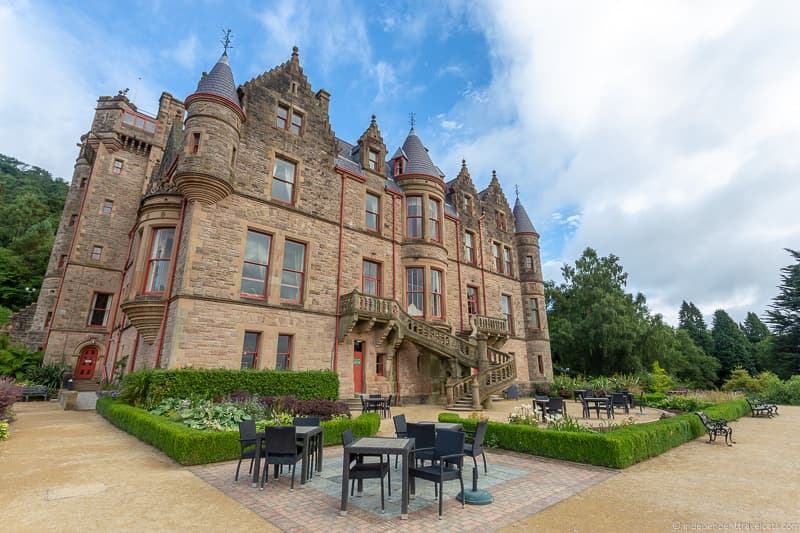
Ulster Folk Museum & Transport Museum
The Ulster Folk and Transport Museum is two separate museums with the Ulster Folk Museum and Transport Museum being located at different but adjacent sites. You can purchase admission to each museum separately, or buy a dual ticket to visit both museums.
The Ulster Folk Museum focuses on telling the story of the people and culture of Northern Ireland from the past to present, with a focus on the early 1900s. The museum is spread out across over 20 buildings set up to resemble a traditional village which includes a number of dwellings of the early 1900’s as well as replicas. These include thatched cottages, farm houses, schools, churches, shops, a mill, workshops, and more. There are also costumed guides, daily demonstrations, and activities such as open-hearth cooking, needlework, weaving, and craft demonstrations.
The Transport Museum focuses on the history of transport in Ireland from its early history to the modern era, from horse-drawn carriages to airplanes. One of the big draws to the museum is that it contains the largest railway collection in Ireland, and includes steam locomotives, passenger carriages, and a large amount of memorabilia. Other popular exhibits include pogo sticks (invited in Northern Ireland), a DeLorean DMC-12 car (the manufacturing plant was in Northern Ireland), a vertical take-off airplane, and a Titanic exhibition which includes some original artifacts.
If you plan to visit both museums, be sure to purchase the dual ticket to save money on admission fees. There is a cafe on-site in the Ulster Folk Museum which serves snacks and drinks.
The Ulster Folk Museum & Transport Museum are situated in the town of Cultra which is about 7 miles (11 km) east of Belfast. There is free parking on-site for visitors, the museums can be reached by bus from Belfast (30 to 40 minute ride), or you can take a train (nearest stop is Cultra Halt).
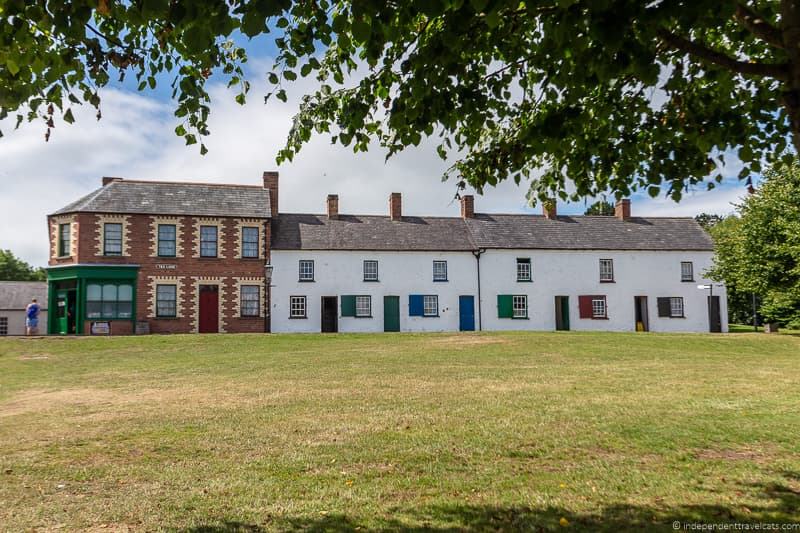
Minnowburn is a natural area of meadows and woodland around the Lagan River on the southern edge of Belfast. It is a perfect place for a walk, family picnic, or gentle hike in a bucolic setting.
Terrace Hill is a popular spot to get a view across the Lagan Valley and to have a picnic, and the trail here is dotted with sculptures and has a garden on top. The garden was built by Frederick Russell who wanted a garden to go with Terrace Hill mansion (circa 1856). The Russell family had earned their money from the linen industry and later the flour industry.
This area is now maintained by the National Trust and is a lovely place to come if you want a bit of an escape from the city. There are a few main trails and paths here that you can follow, some that run through the small village of Edenderry. It is easy to spend a few hours here on a nice day.
If you are looking for a nice gentle hike, we can recommend the Giant’s Ring trail. It is an easy 2.2 mile circular trail that takes you along the riverbank and through woodland and farmland, and past the Giant’s Ring. The Giant’s Ring is a Neolithic henge earthen monument, believed to have been constructed around 2700 BC.
Located about 4 miles outside of Belfast. No great public transit connections, although there are bus stops within a 15 minute walk of Minnowburn.
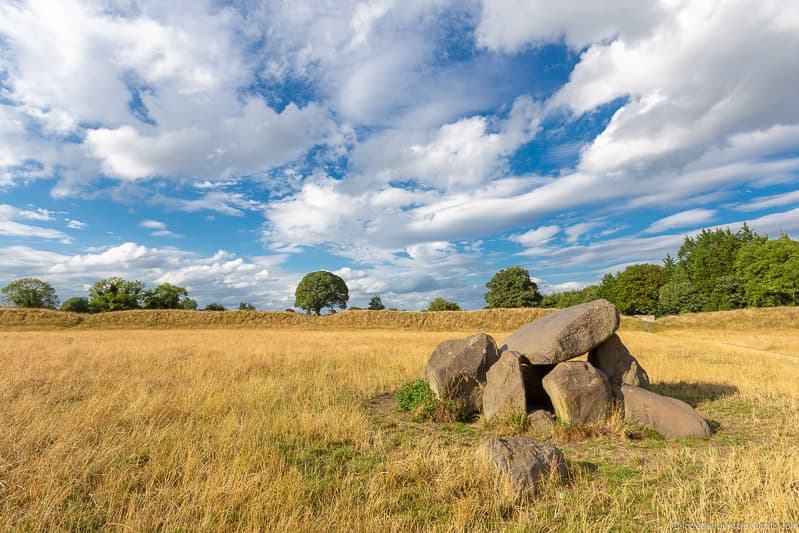
Sir Thomas & Lady Dixon Park
Sir Thomas and Lady Dixon Park is a 128 acre park located in South Belfast. The park consists of woodland, meadows, fields, a walled garden, formal rose gardens, and a Japanese garden. There is also a children’s playground and there is a coffee shop located in the former stables. The park is a popular place for local families and walkers.
The park was laid out around Wilmont House, a Victorian house originally built for James Bristow, but later purchased by Sir Thomas Dixon and Lady Edith Stewart Dixon . The Dixons would leave the house and park to the city of Belfast and it is currently maintained by the Belfast City Council.
The Sir Thomas and Lady Dixon Park is particularly known for its formal gardens and roses. Its roses are world famous and each year the roses attract thousands of visitors. The annual highlight here is Rose Week, a weeklong event where there is a flower show, games, concerts, puppet shows, family events, food vendors, and more. We attended Rose Week in 2018 and it was a lot of fun.
The park is located about 6 miles from Belfast city center and there is free parking available. You can also reach it by public bus with stops within a 5 minute walk of the park.
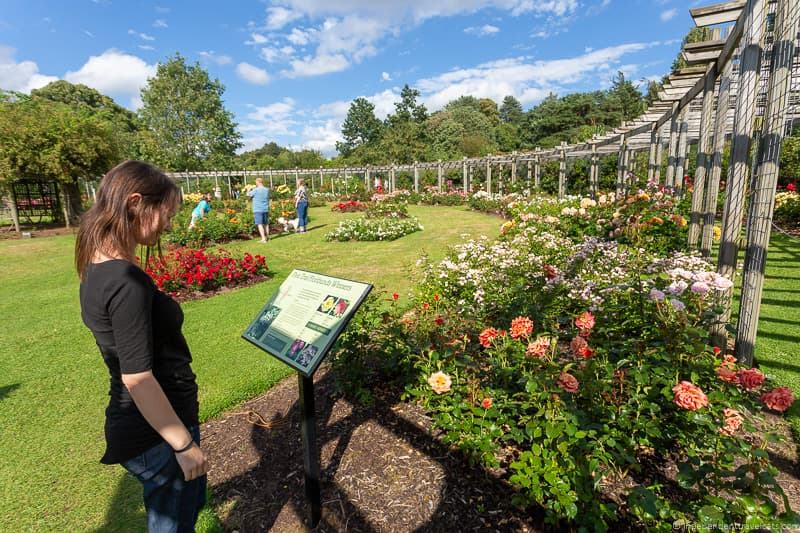
Belfast Map of Top Belfast Attractions
The map below shows the locations for each of the mentioned main things to do in Belfast, including the centrally located and nearby attractions. You can use this to help guide and plan your itinerary. We recommend trying to group together locations that are close together.
Click here or on the map below for a closer look and to see exact locations:

Things to do in Belfast: Day Trips from Belfast
Run out of things to do in Belfast? If you have more time in Northern Ireland and want to venture further afield, there are lots more things to do within a 1 hour to 2 hour drive of the city.
If you are looking for a day trip or quick overnight trip, our top recommendations depending on your interests would be to drive along a section of the Causeway Coastal Route, visit the Giant’s Causeway, do a whiskey tour, explore Saint Patrick Country, do a Game of Thrones tour of filming sites, or visit a few of the many castles and historic homes in Northern Ireland.
We have some of our favorites below, and we also have a complete guide to the best day trips from Belfast here .
Giant’s Causeway
The Giant’s Causeway is the most famous natural attraction in Northern Ireland and its only UNESCO world heritage site. The Giant’s Causeway is a geological feature, which consists of approximately 40,000 hexagonal basalt columns that form a staircase-like pathway out to sea. It has been featured in a number of films, TV commercials, and advertisements.
The site is managed by the National Trust, and there are a number of visitor services here including parking, a shuttle bus, an exhibition center, a gift shop, and a cafe. Although it is free to visit the site if you arrive on foot or by bicycle, there is a fee and ticket needed to park, visit the exhibition center, get the audioguide, use the shuttle bus etc. It is definitely worth it to get a ticket to take advantage of these services.
Entry is free for National Trust members. If you are planning on visiting both the Giant’s Causeway and Carrick-a-Rede rope bridge, you might consider investing in a National Trust Touring Pass . This will give you free access to both these attractions, as well as many other National trust properties across Northern Ireland and the UK.
You can drive (about 1 hour and 20 minute drive from Belfast), take public transit, or join a group or private tour from Belfast (or Dublin) to visit the Giant’s Causeway. You can see a number of available day tours to the Giant’s Causeway here and here .
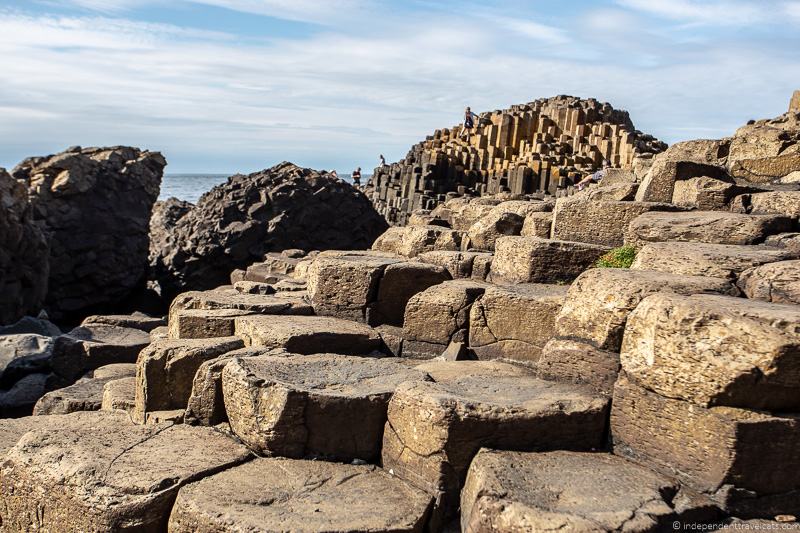
Causeway Coastal Route
The Causeway Coastal Route is a scenic tourist driving route that winds approximately 120 miles from Belfast to Londonderry (or Derry). Most of the route is along the coast with lots of scenery as well as a number of Northern Ireland’s top attractions.
Some of the most popular stops along the Causeway Coastal Route are the Giant’s Causeway , Carrick-A-Rede Rope Bridge, Dunluce Castle, and Bushmills whiskey distillery. Just off of the route are also popular stops like the Glenariff Nature Reserve, Rathlin Island, and the Dark Hedges .
Most of the route is accessible to all drivers, but there is a narrow and windy section that is not suitable for those driving in larger vehicles and campervans. Many of the attractions, depending on the time of the year, can be visited by public transit. I would not recommend this as a day trip if you want to do the full route, but you can visit a few of the highlights on a day trip.
Many people see parts of the route as part of a day tour from Belfast so they can avoid renting a car and don’t have to worry about drinking if stopping for whiskey tasting. Day tour options include tours such as this full day tour from Belfast.
We have driven the Causeway Coastal Route twice and really enjoyed it! See our guide to the highlights of the Causeway Coastal Route to help plan your own trip.
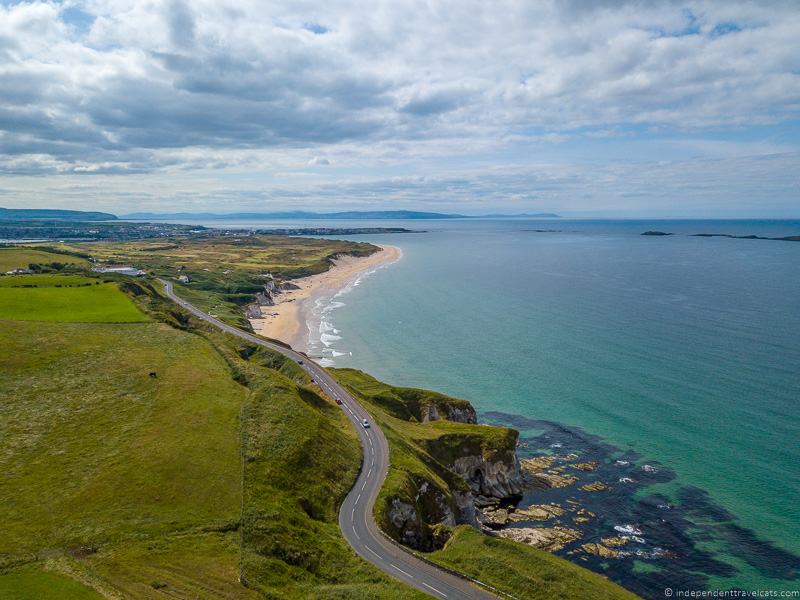
Learn about Saint Patrick
If you are interested in the history, life, and religious beliefs of Saint Patrick, there are a number of sites within Northern Ireland associated with the saint. Saint Patrick was born in Roman Britain and came to Ireland first as a slave of Irish pirates and later as a Christian missionary. He would become a bishop in Ireland during the 5th century and is often regarded as the founder of Christianity in Ireland.
St. Patrick is the patron saint of Ireland, both Northern Ireland and the Republic of Ireland. He is a venerated saint in a number of Christian religious faiths including in the Roman Catholic Church, Anglican Church, and the Lutheran Church. Saint Patrick’s Day, March 17th, is observed in Ireland (and in many other countries) as a religious and cultural holiday, celebrating his life and the arrival of Christianity into Ireland.
A few important places associated with Saint Patrick in Northern Ireland are The Saint Patrick Centre in Downpatrick (an informative and interactive exhibition about Saint Patrick’s life and legacy, a good starting point!), Down Cathedral (where Saint Patrick is believed to be buried) and Struell Wells in Downpatrick, Slemish Mountains (where Saint Patrick is believed to have been forced to work as a slave), and the two Saint Patrick’s cathedrals of Armagh.
Counties Down and Armagh are the two counties that are collectively known as Saint Patrick’s Country and have the most St. Patrick’s related sites. For more places associated with Saint Patrick, see this list of sites . Most of these places are located within a 1 hour drive of Belfast.
If you are looking for one place to go to learn more about Saint Patrick, I’d recommend heading to Downpatrick as there are several sites in and around the town associated with the saint. If you visit Downpatrick and are looking for a guide, this very good value 2-hour walking tour may be of interest.
If you are looking for a day tour, there are not many that are focused on Saint Patrick, but this group day tour from Belfast includes a visit to The Saint Patrick Centre, Down Cathedral, historic ruins of Monasterboice, and Dublin. There is also this private day tour by minivan from Belfast which focuses on Downpatrick sites and County Down.
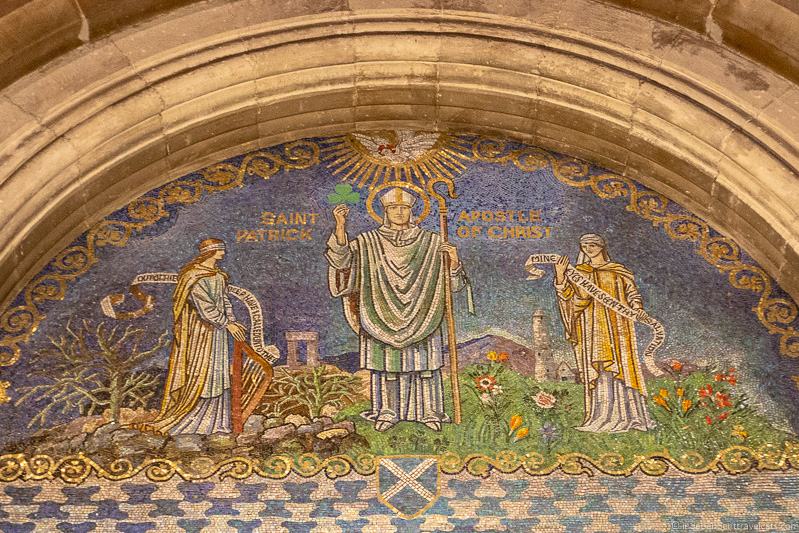
Games of Thrones Tour
The popular American HBO TV series Game of Thrones (2011-2019) was filmed primarily in Belfast at Titanic Studios, but also in a number of real-world locations around Northern Ireland. Over 20 filming locations have been used in Northern Ireland, most of them outdoors, to represent different locations such as Winterfell, Lordsport Harbour, Dothraki Grasslands, Kingsroad, Robb Stark’s camp, and the forest of the direwolves.
Note that some filming locations are on private land and are not accessible, but most are open to the public. The locations have included Tollymore Forest, Cushendun Caves, Murlough Bay, the Dark Hedges , Ballintoy Harbour, Larrybane, Castle Ward, Inch Abbey, and Downhill Strand.
You see this list of the Games of Thrones filming sites in Northern Ireland to help you plan your itinerary.
You can visit many of these locations on your own, or you can join a tour. If you want to be amongst other fans and learn more behind-the-scenes information, there are many Game of Thrones themed tours that leave from Belfast and focus on GoT sites and attractions. Many also include the chance to use props and dress up like characters from the Game of Thrones for photos. Some are even led by those who worked on the show.
Here are a few tour options to consider:
- This full day tour includes 9 stops which include Dark Hedges, Ballintoy Harbor, Larrybane, and Cushenden Caves. Also visits the Giant’s Causeway and Carrick-A-Rede rope bridge.
- This GoT day tour includes filming locations such as Dark Hedges, Carnlough Harbour, Cusheden Caves and Dunluce Castle. Tour also includes the Giant’s Causeway and a view of the Carrick-A-Rede Rope Bridge.
- This full day GoT tour includes visits to Castle Ward, Inch Abbey, and Tollymore Forest.
- This private guided day tour includes a guide who was an actors or extra in the Game of Thrones series
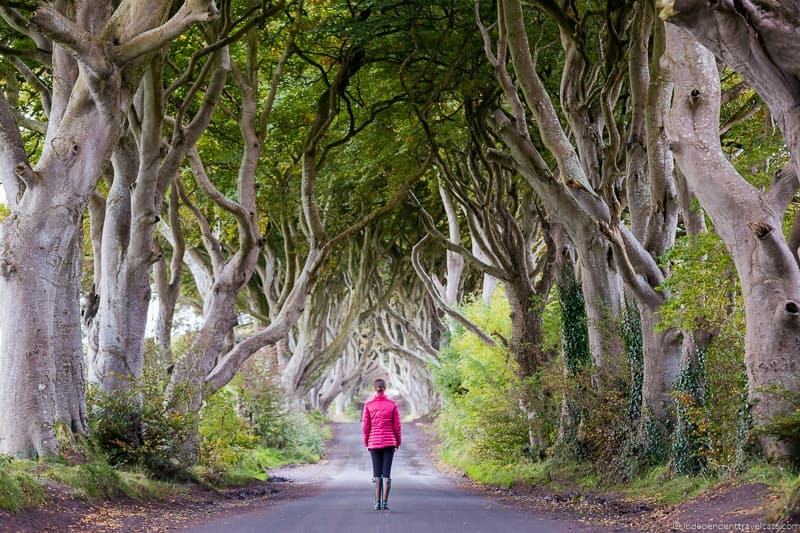
Go Whiskey Tasting
Ireland is well known for its whiskey and one of the most famous and oldest distilleries in Ireland is located in Northern Ireland. Along with Jameson in Dublin, Bushmills is one of the brands most associated with Irish whiskey worldwide.
Bushmills was established in 1784, although the first license to distill whiskey on the current site was granted back in 1608! Today, Bushmills is one of Ireland’s best selling Irish whiskey brands, offering both blended and single malt whiskeys. The whiskey is produced on the Bushmills Distillery site using water from Saint Columb’s Rill, a tributary of the River Bush.
Old Bushmills Distillery is a very popular place to visit and you can take a tour of the distillery to see how and where the whiskey is made, do a tasting, visit the gift shop, and/or have a meal here. Public tours are on a first come, first serve basis unless you are in a group of 15 or more so we recommend arriving at least 20 minutes before you want to do a tour. The distillery is about a 1.5 hour drive from Belfast city center.
Another whiskey distillery Echlinville Distillery , opened in 2013, also offers public tours and tastings. Be sure to make a reservation in advance if you wish to visit here. Echlinville was the first Northern Irish distillery to be granted a distilling license in almost 125 years! The distillery is located about a 50 minute drive from Belfast city center.
There are a number of distilleries expected to open throughout Ireland in the next several years, so if whiskey is a strong interest, I’d do some research on any recent openings. Just note that most distilleries when they first open are not offering their own whiskey yet.
If you do not have a car, you can reach Bushmills Distillery by bus or by a combo of bus and train. You can also book a private transfer or join a group tour that stops at the distillery, like this one .
Just note that most group tours only allow time for you to do a quick tasting, not a distillery tour.
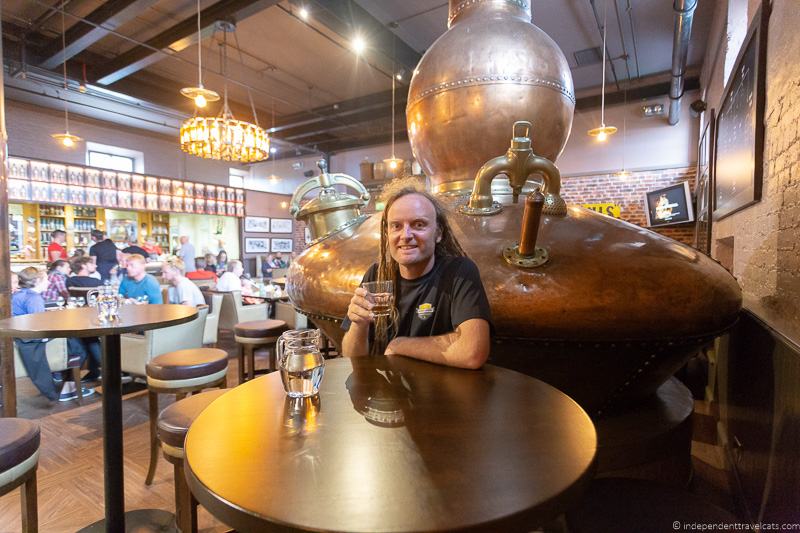
Castles, Palaces, and Country Homes
The UK is known for its many castles, palaces, and stately homes, and Northern Ireland has several that are open to the public to visit. Most are located within a 1 hour drive of Belfast. Some are only open seasonally so do check dates and hours before planning your visit.
Here are several to get you started:
- Carrickfergus Castle – A 12th century castle built for Sir John de Courcy alongside the Belfast Lough (3 sides are surrounded by water). Today it is one of the best preserved medieval buildings in Northern Ireland. This castle saw a lot of action and was besieged by the Scottish, Irish, English, and French and was used by the military until 1928. There is a fee to visit.
- Castle Coole – A 18th-century neo-classical mansion and landscape park in Enniskillen that was built for the Corry family. The property is now owned and managed by the National Trust but many of the contents of the mansion are still owned by the Earl Belmore (Corry family) who still lives on the estate. The house is open to the public in the summer months and the estate is open year-round. There is a fee to visit.
- Castle Ward – An 18th century mansion house built for Lord Bangor and his wife, known for having two different exterior architectural sides on each side (one side Palladian, one side Georgian Gothic). Estate also has a medieval tower house, farmyard, and gardens, and was home to the Ward family from 16th century until the estate was given to National Trust in 1952. Also a Game of Thrones filming location and there is a GOT archery experience offered here. There is a fee to visit.
- Dunluce Castle – A 15th century castle ruin perched alongside the sea that was lived in by the MacDonnell family until around 1690. Castle ruins are a popular stop for visitors on the Causeway Coastal route. There is a fee to visit.
- Hillsbourgh Castle – An 18th century Georgian house build for the Hill family. It is now an official government residence in Northern Ireland and managed by the Historic Royal Palaces. It is currently used as the residence of the Secretary of State for Northern Ireland and the official residence of the British Monarch and other member of the British royal family when visiting the region. Fee to visit and best to book in advance if you want to visit the house interior as tickets numbers and tour times are limited.
- Mount Stewart – A grand 19th-century neoclassical mansion house and garden in County Down built for the Marquesses of Londonderry. Now owned and managed by the National Trust. The property is well-known for its beautiful interiors, large collection of art and furniture, family memorabilia, and its world-class gardens. If you love gardens, we recommend visiting here in the late Spring or Summer months to see them in their full glory. Fee to visit.
Note that Castle Ward, Castle Coole, and Mount Stewart are all National Trust properties so members get free entrance. If you are planning to visit these, or other Trust properties in Northern Ireland such as the Giant’s Causeway or Carrick-A-Rede Rope Bridge, you may save money with a National Trust Touring Pass .
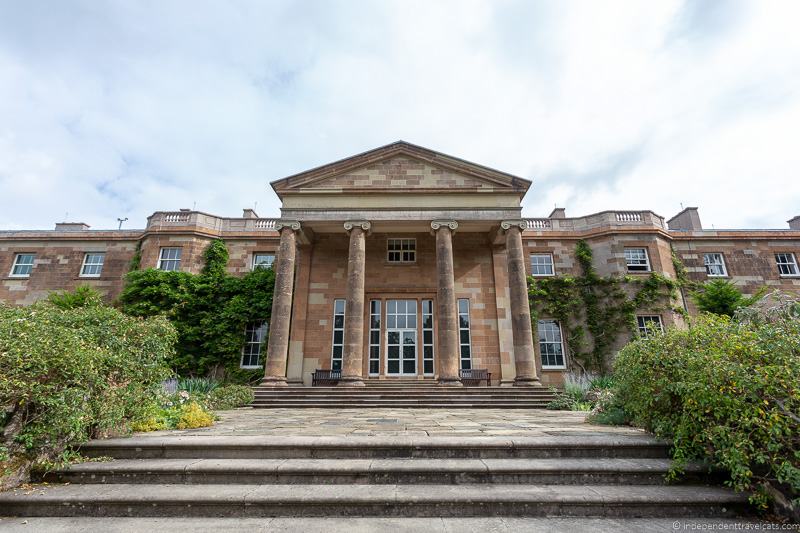
So there is our list of things to do in Belfast Northern Ireland! Have you been to Belfast? If so, any favorites among the above or places you’d add to this list? If you haven’t visited yet, which of these Belfast attractions would make it on your Belfast itinerary?
As always, feel free to ask us any questions you may have about things to do in Belfast or planning a trip to Northern Ireland!
Planning a trip to Belfast? Pin this article on Pinterest to read it later:
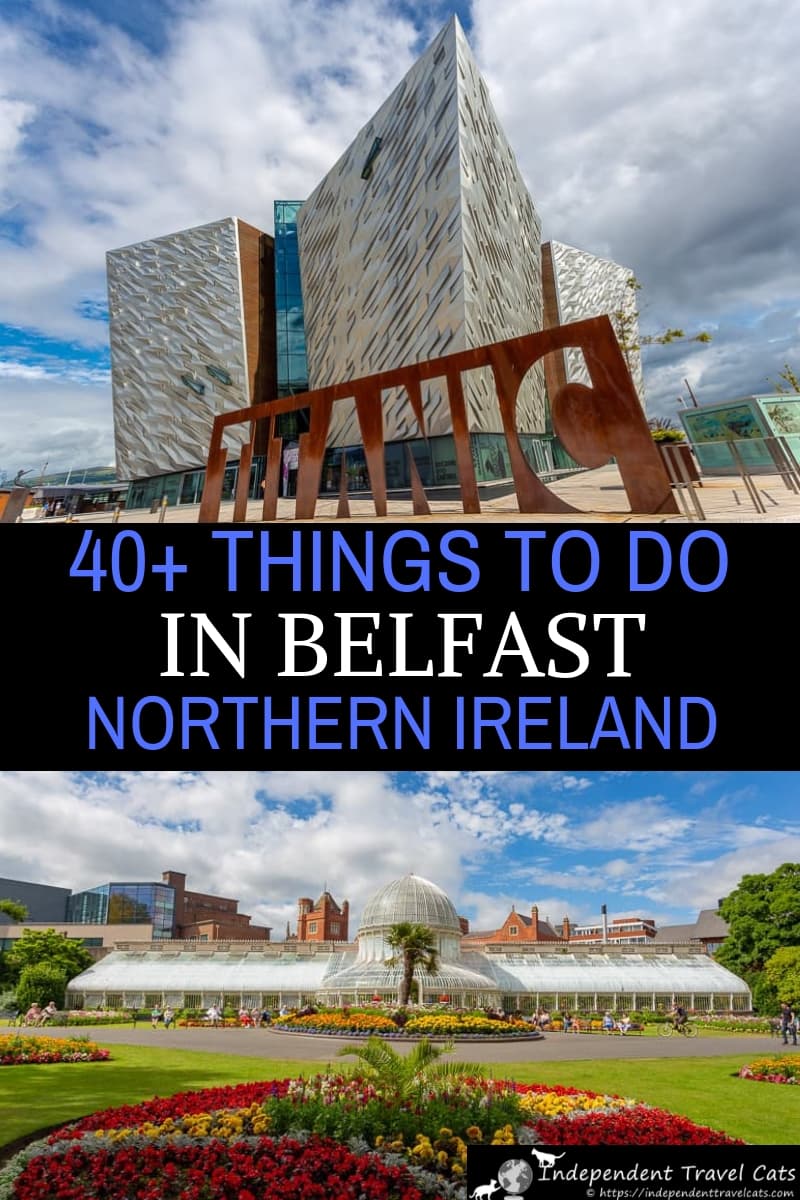
**Disclosure: We partnered with Discover Northern Ireland who helped us plan the logistics of our second trip to Belfast, and who also covered our accommodation and arranged some of our visits to local attractions in order for us to share our experiences as travel writers. However, as always, this article contains only our own honest thoughts and opinions. You can read more in our Ethics Code about how we accept work.**
Share this Post!
There are 16 comments on this post.
Please scroll to the end to leave a comment
Evie mason Post author
December 21, 2023 at 3:50 am
I stumbled upon a fantastic Belfast itinerary that highlighted the must-visit spots in the city, and it really made my trip planning a breeze. So many helpful hints and great attractions reviewed here. The mention of the Visit Belfast Welcome Centre at Donegall Square was invaluable–helped me snag some discounts for my sightseeing tours and even a bike tour around the city.
Jessica & Laurence Norah Post author
December 21, 2023 at 3:11 pm
Glad that you had such a wonderful visit to Belfast and that our Belfast Travel Guide was helpful to you in planning your trip. Sounds like you got a chance to do visit a lot of attractions and do a lot of tours, and glad you were able to find some discounts on a couple of your tours!
Best, Jessica
Janell Richison Post author
August 27, 2019 at 10:23 am
I love this site, and it is so informative, thanks so much. I am planning a trip in the very near future, after finding out my ancestry is far from what I thought it was, which I thought was just African and French, turned out to be anything but that. I did two test, and both came back with ties to England, Ireland, Scotland, and Finland, i.e. on the European side, and AMD (Age Macular Degeneration, being the only hereditary ailment, with a low risk, which is common in Ireland). In Ireland, the lineage points to Belfast, only; in Scotland, Edinburgh, Glasgow, and Fife; in England Merseyside, Manchester, Wales, Lancashire, and Country Durham. That being said, is it possible to visit all of these places from Belfast? My twin and I would love to kill three birds with one stone. Any suggestions?
August 27, 2019 at 12:41 pm
Glad you are enjoying our travel blog! It is exciting to learn more about one’s genealogy and then go visit the places where one’s ancestors lived.
So it looks like your lineage points to all four countries of the UK: England, Northern Ireland, Wales, and Scotland. Wales is its own country (not part of England), but both are part of the UK. So that’s a lot of places to try to visit. How much time do you have? I’d recommend at least 2 weeks if you are trying to visit all these places.
Also note that some places you list are cities like Edinburgh and Manchester, but others are counties or regions like Lancashire and Fife, whereas one is an entire country (Wales). So unless you have a lot of time, you would want to narrow those places down to where you’d actually want to visit. For example, maybe you want to visit St. Andrews in Fife and Liverpool in Merseyside. Maybe you want to visit Cardiff and Snowdonia National Park in Wales.
Then I’d decide how you plan to get around. Are you wanting to get around by public transportation, join a tour (or series of tours), or drive yourself? Or some combination of those?
So yes, there are ferries that you can take from Belfast to Scotland as well as England. But you could not use it as a base to visit the other places as they are too far away. But it would be a good beginning or ending point for your trip.
If you want to try to see all (or most of these places) I’d probably recommend flying into London and leaving out of Belfast. Or flying into Belfast and leaving out of London.
Happy to help more once you have an idea of how much time you have and how you’d like to travel around the UK.
Tamara W Post author
July 22, 2019 at 8:33 pm
I love your site! It is very well organized. I’ve spent some time in Northern Ireland on two separate occasions and can vouch for all you have said about the people (the best that I’ve ever met….but I must include Dubliners, as well) and how they do not know their own land as well as they would like. I would like to add that the Mourne Mountains are GORGEOUS and about an hour’s cab drive (but trains go there as well).
My favorite spot is all the way down to the border to Rostrevor for Kilbroney Nature Park overlooking Carlingford Lough. Stunning landscape and views in summer when the heather is in bloom! Beautiful hiking with very good facilities. Also, there is a LOT to do in Bangor which is a 20-minute cab drive (trains and busses also will take you there) from Belfast City Center. In Bangor you will see the marina, the excellent North Down Museum, Bangor Castle and more. Birthplace of Christianity in Ireland! For C.S. Lewis fans, the Old Inn in Crawfordsburn nearby is where many literary authors used to hang out, and where C.S. Lewis took his friends and honeymooned with his wife Helen Joy Davidman. There is a statue to Amy Carmichael, missionary to southern India and founder of Dohnavur Fellowship there, at Hamilton Road Prebyterian Church, as Amy’s family was significant in Millisle where she was from, and then Belfast as well.
In Belfast, you can see her church and mission that is still going in the Shankill district (“The Welcome Evangelical Church” and its new facility for the disabled “The Amy Carmichael Center” next door). Down the road from the Mission is a statue of the mill worker girls called “shawlies” that Amy helped and the old mill where they worked is across the street from the statue. The Welcome church was built just for the mill girls so they could go to church. There are a HOST of C.S. Lewis sites: The Shand Theatre, Campbell College, St. Mark’s (where his grandfather was rector and there is a red door with a lion door pull that played a large part of Lewis’s Aslan imaginings), his home Little Lea on Circle Street, his mural on the Hop-On-Hop-Off bus tour of Belfast, etc. I had more fun with the extremely friendly cab drivers showing them where these places are and what these Belfastians did that they were not aware of. They were happy to learn about it!
I am looking at your Dublin itinerary and will keep coming back as I am planning a third trip out to extend the trip. Glenlara Elite Travel did a WONDERFUL tour of the Antrim Coast if anyone is interested. Frances is an excellent tour guide and made our trip just amazing. Cave Hill park is one of my favorite in-town hikes. Also St. George’s Market in downtown for shopping.
July 23, 2019 at 3:50 am
Hi Tamara, So glad you are enjoying our posts on Dublin and Belfast and thanks for providing some of our favorite places in Northern Ireland. We have mainly explored Belfast and surround and then along the coast, but there is definitely much more to see in Northern Ireland and you have listed a number of places we have not been like Bangor. We will have to go there on our next visit! Yes, Cave Hill is nice place to hike in Belfast and we list a few places you might want to try next time if you haven’t been in our Belfast itinerary.
We agree that Dublin is great as well and plenty to do there and in the surrounding area! Wishing you a wonderful return to Ireland & Northern Ireland!
Bea Post author
December 31, 2018 at 2:41 am
I am very keen to visit Northern Ireland this year! Looks like I have great things to look forward to 🙂
January 1, 2019 at 1:28 pm
Hi Bea, Yes, there is lots to do and see in Belfast and the rest of Northern Ireland. Just let us know if you have any questions as you plan your trip. Best, Jessica
Anisa Post author
December 30, 2018 at 12:24 pm
I have wanted to go to Belfast for a few years now but haven’t made it yet. This is a great guide, so comprehensive as always. The Titanic Museum is top of my list, but I also want to go to Giants Causeway. Hopefully, I can find a weekend to fit it in soon. Happy New Year to you both
December 30, 2018 at 4:43 pm
Hi Anisa, Hope you can a chance to visit Belfast soon. Have a wonderful New Year’s! Best, Jessica
Lolo Post author
December 30, 2018 at 3:03 am
Quite an extensive guide to Belfast you have here! There definitely seems to be way more things to do than I originally knew about! I’m especially interested in the Opera House! Saved for later! Happy Holidays!
December 30, 2018 at 6:29 am
Hi Lolo, Yes, if you like opera houses, the Grand Opera House is the only Victorian theater remaining in Northern Ireland. It will be getting a facelift in 2020 😉 Best, Jessica
Anda Post author
December 29, 2018 at 3:53 pm
Excellent travel guide, like always! I’m going to bookmark this for our future travel plans. My husband and I always wanted to visit Ireland and if we make it there we’ll definitely want to see Belfast. Having so much useful information in one single post will make my life so much easier. I usually have to search the web for hours and hours, before I am able to put together a decent itinerary. Thanks for sharing this, Jessica. I wish you and Laurence a wonderful New Year!
December 29, 2018 at 4:57 pm
Hi Anda, Yes, I had been working on this post for a while and I actually took some places off the list that we visited as there were just so many. We were really surprised how many thing we have done there!
If you go to Ireland, I hope you get a chance to visit, there are lots of neat things to see/do in Belfast and Northern Ireland in general. All of Ireland is great of course (we still have much more to see ourselves!) but I do have some special feelings towards Belfast.
In many parts of the UK, people still look at you a bit strange if you say you are going to go spend time in Belfast as most people lived through The Troubles and you did not go to Belfast “for fun”. But we really have loved our two visits. On a few of the tours we did, we were the only people not from Ireland as so many Irish people told us that they never really had the chance to explore their own city growing up and they are excited about all the new things that are available now. It was really nice to be able to hear their stories and hear about how much they’ve seen the city change. It is great to hear about positive change and to see so many derelict buildings getting a second life.
Wishing you and your husband a wonderful 2019!!
Jill Post author
December 29, 2018 at 2:44 pm
I’m visiting Ireland for my first time next year and I’m so excited. Unfortunately, due to time constraints I won’t be visiting Northern Ireland but I am sure I will be back. I’ve heard such wonderful things about Belfast that I know I will visit it someday!
December 29, 2018 at 4:37 pm
Hi Jill, Ireland is a great country to explore and I am sure you’ll have a great trip. If you are going to Dublin, we do have a 3 day Dublin itinerary that may be useful in planning your time there. Northern Ireland will still be there next time, we’d recommend a week to see many of the highlights. Northern Ireland is easy to combine with a trip to the rest of Ireland as well as Scotland as well as there are regular daily ferries between the two 😉 Happy travels! Jessica
Leave a Reply Cancel reply
Your email address will not be published. Required fields are marked *
Notify me of replies to my comment (just replies to your comment, no other e-mails, we promise!)
Subscribe to our monthly Newsletter where we share our latest travel news and tips
We only ask for your e-mail so we can verify you are human and if requested notify you of a reply. To do this, we store the data as outlined in our privacy policy . Your e-mail will not be published or used for any other reason other than those outlined above.
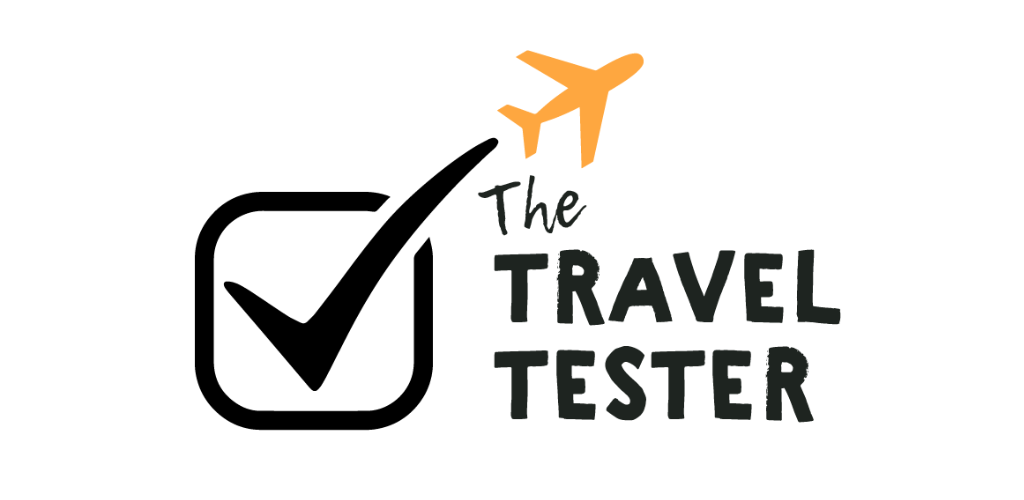
Northern Ireland Travel Guide
Fun Fact: TV-Series Game Of Thrones employed more locals in Northern Ireland than the civil service.
NORTHERN IRELAND TRAVEL PLANNING
BOOK YOUR FLIGHT BOOK YOUR HOTEL BOOK YOUR RENTAL CAR BOOK YOUR ACTIVITIES BOOK YOUR INSURANCE

ALL TRAVEL GUIDES
- Europe Travel Guides
- North America Travel Guides
- South America Travel Guides
- Asia Travel Guides
- Africa Travel Guides
- Oceania Travel Guides
RESOURCE GUIDE

11 Hands-on Travel Experiences in West Europe You Need to Know About
The Travel Tester takes you on a creative travel journey through West Europe!

Northern Ireland Game of Thrones Tour Ideas: 6 Unique Experiences You Don’t Want to Miss
Are you planning on visiting Northern Ireland for a Game of Thrones Tour? Then this is the guide for you! We list 6 unique experiences that you definitely don’t want to miss!

Brunel’s in Newcastle, Northern Ireland: A True Local’s Meal
Join The Travel Tester in search for great hotspots around the world. This week, we’ll visit Brunel’s in Newcastle, Northern Ireland!

25 Photos That Make You Want to Visit Northern Ireland Today!
The Travel Tester takes you on a coastal road trip and shows you the best scenery you don’t want to miss when you visit Northern Ireland.

Sleep in a Cloud… and Meet a Ghost at 17th Century Ballygally Castle in Northern Ireland
Join The Travel Tester in search for great accommodation around the world. This week, we’ll visit Ballygally Castle in Northern Ireland!

Game of Thrones Shooting Locations in Northern Ireland: A Complete Overview Per Episode, with Map!
The Travel Tester takes you to Northern Ireland for an epic road trip along all of the Game of Thrones Shooting Locations.

Game of Thrones Tour Belfast & Beyond: Discover the Secret Doors!
Let The Travel Tester show you all the secret doors made about Game of Thrones Season 6 and discover the story behind them

21 Ireland Travel Tips I Give Every First Time Visitor
By Author Keith O'Hara
Posted on Last updated: May 1, 2024

This guide contains Ireland travel tips that I’ve been passing on to first time visitors for 10+ years.
Many guides with tips for traveling to Ireland consist of telling you to ‘Ah, be sure to have the craic’ ….
However, in reality, the most useful travel tips for Ireland are the likes of:
- VAT refunds: Those visiting Ireland from a non-EU country are eligible
- Logical itineraries: A realistic and logical itinerary will save you time, stress and money
- Pack light layers: Ireland can get 4 seasons in 1 day. Layers are your friend
Useful Ireland travel trips

Click to enlarge
Below, you’ll find some handy Ireland travel tips that I put together based on the thousands of emails from tourists that I reply to each year.
I strongly believe that, if you take note of the below, you’ll place yourself in a better position to have a more enjoyable trip when visiting Ireland.
1. Visiting Ireland at any time comes with pros and cons, so choose wisely
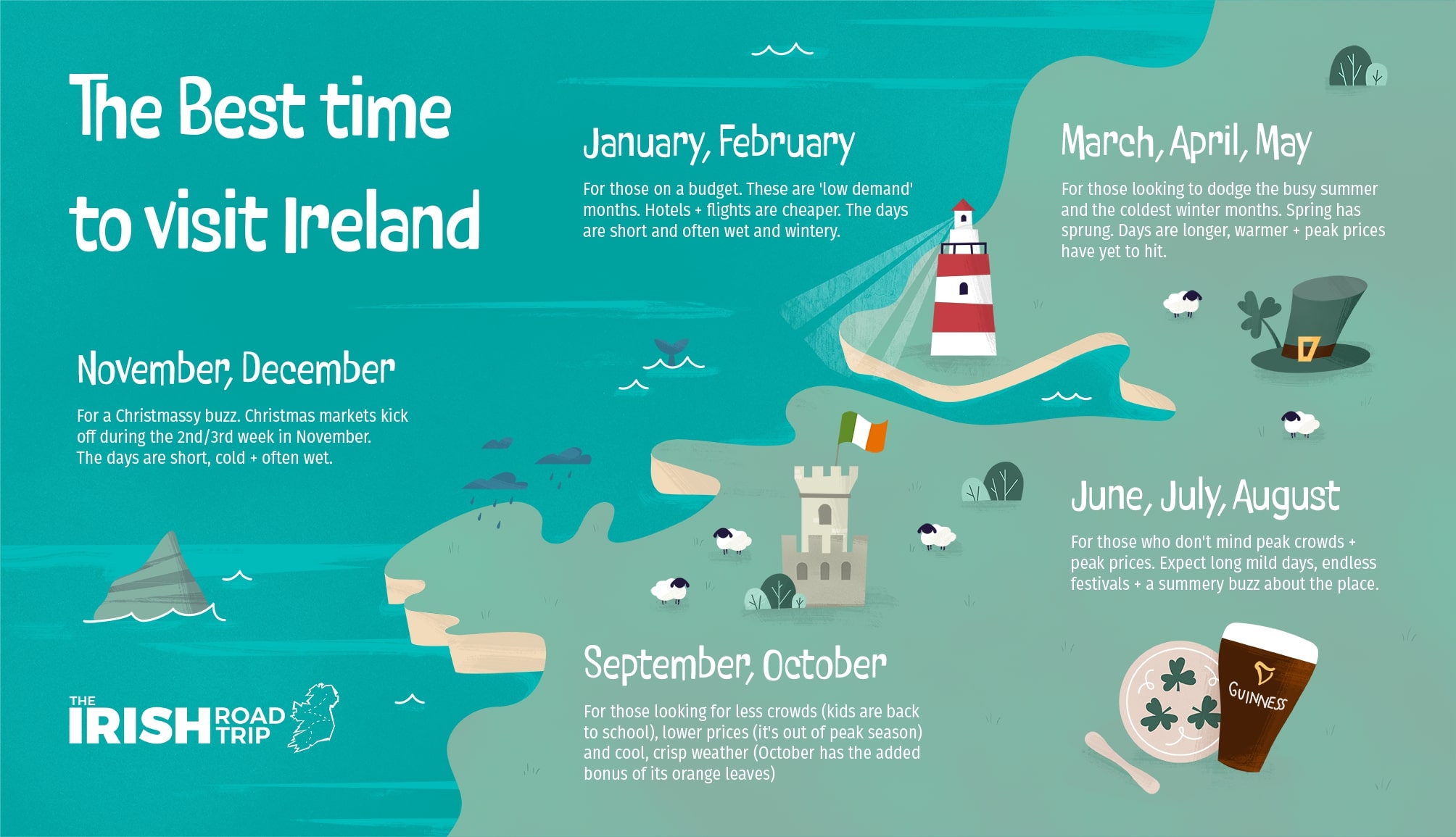
If you only take note of one of my tips for traveling to Ireland, let it be this one, as when you visit Ireland will have a massive impact on your overall experience.
The trickiest part of planning a trip to Ireland is often deciding on the best time to visit Ireland – each month has its pros and cons.
Personally, I like traveling during the ‘shoulder season’ – September, October, April and May, as its quieter and you generally get better deals on accommodation and flights.
However, you need to weigh up the pros and cons and determine the best time for you :
- Example 1: If you’re on a tight budget, the winter months (Jan in particular) will be best
- Example 2: If you’re looking for the best chance of good weather, June, July and August will be best
- Example 3: If you’re looking for long ish days, less crowds and mild temperatures, October will be best
2. Time spent mapping out your Irish road trip is worth its weight in gold
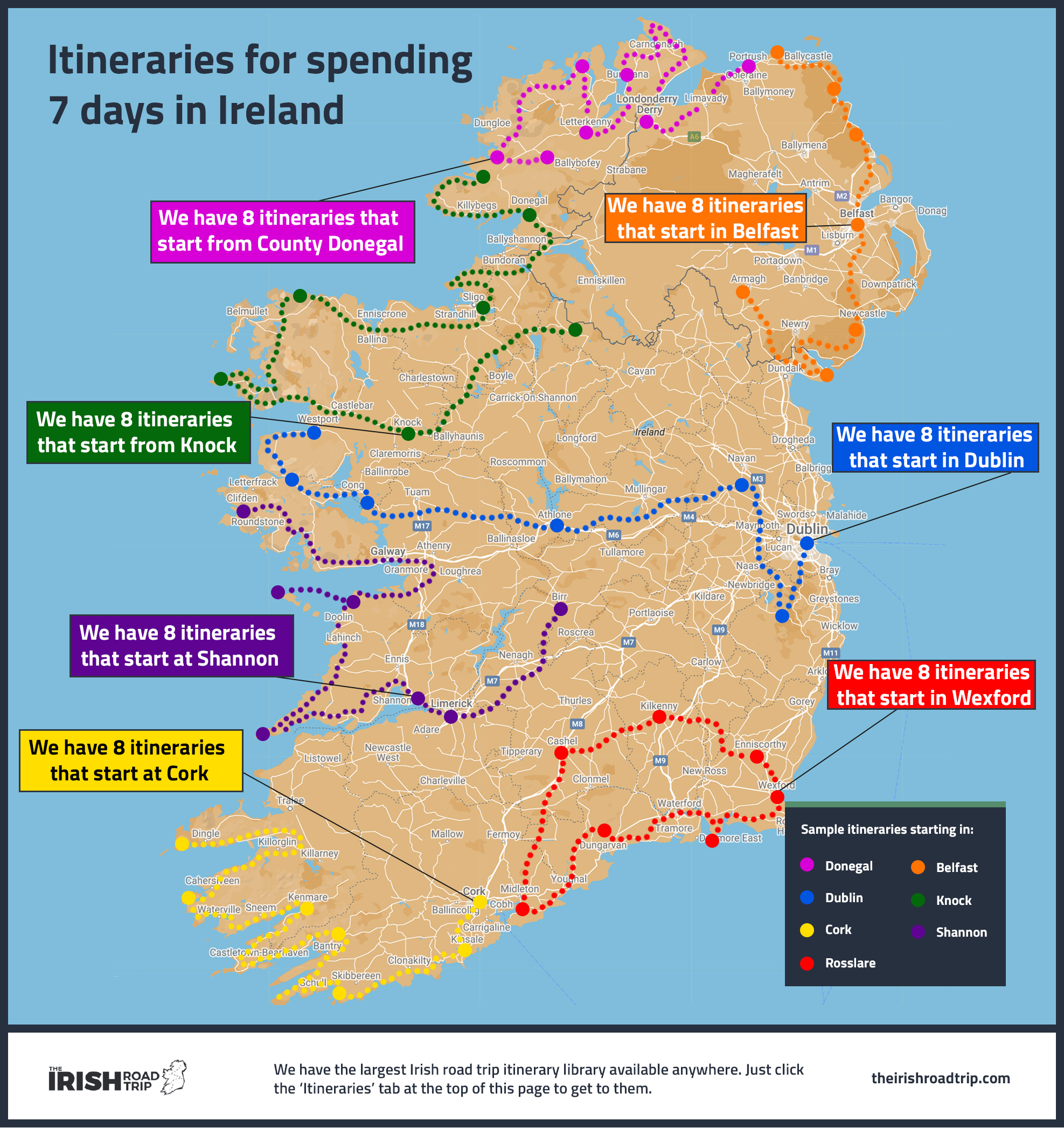
Click to enlarge map
One of the more overlooked tips for traveling to Ireland for the first time revolves around your road trip route.
It’s why, last year, I published the world’s largest Irish road trip library (you can choose your trip length, start point and much more).
Your Ireland itinerary , without exception, needs to be one:
- That you have confidence in: Before you start booking flights/hotels, you need to be comfortable and confident in your route
- That follows a logical route: It needs to follow a route that makes sense (e.g. you opt to fly into Shannon as you only plan on seeing the west)
- That is realistic: People often underestimate how long it takes to get around Ireland. The result? They pack far too much into their visit
3. You don’t have to use a car to get around Ireland

Yes, getting around Ireland without a car is very possible (in fact, I have lots of Irish road trip itineraries that only use public transport).
You can easily combine buses, trains and day tours to get around Ireland , you just need to be a bit more astute with your planning.
- The advantage: It’s cheaper than renting a car
- The disadvantage : You don’t have as much flexibility.
Note: Public transportation in Ireland is notoriously bad in places like Donegal
4. If you do rent a car, read (and re-read) the fine print
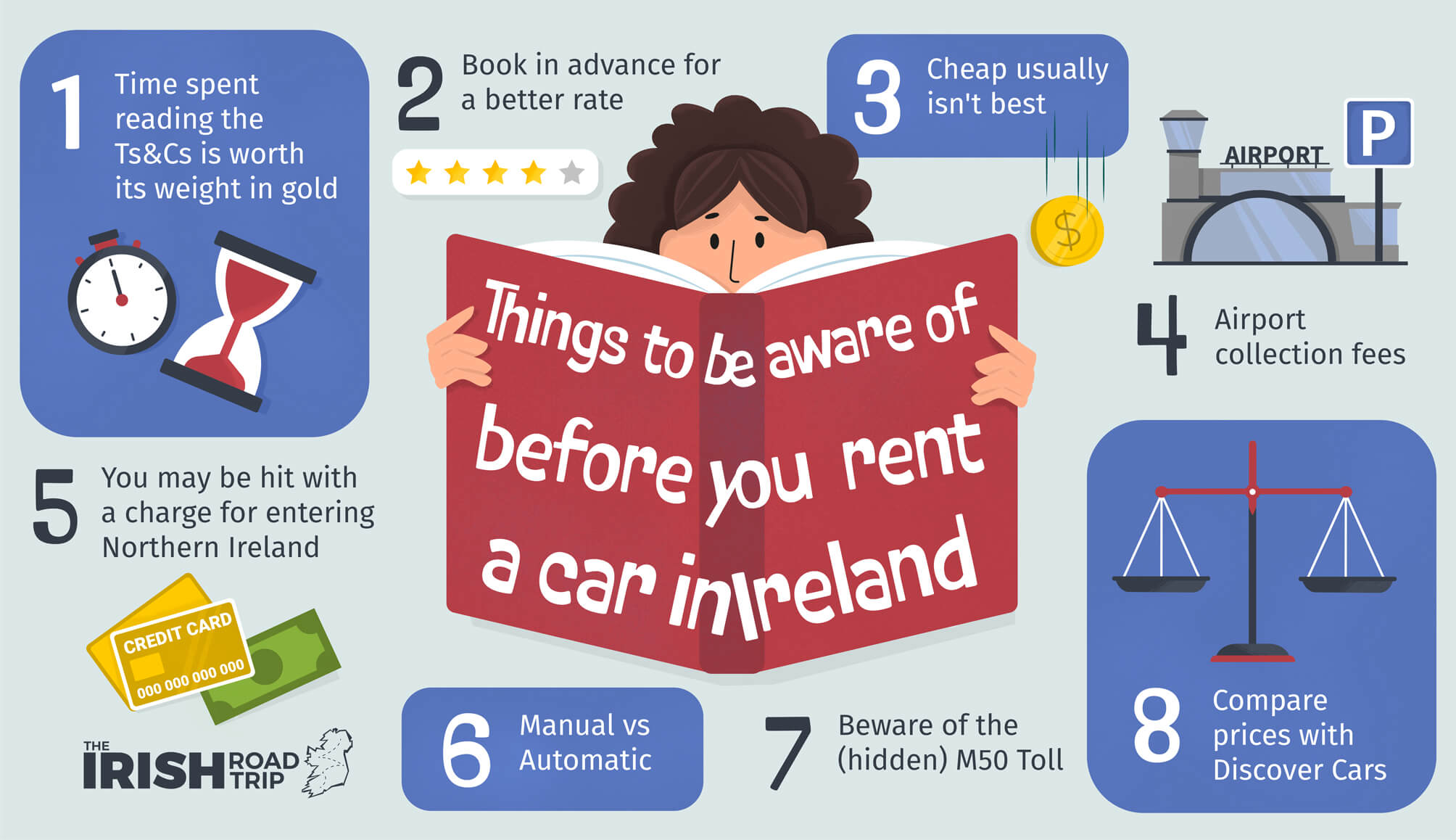
This is one of the Ireland travel tips I tend to pass on most frequently.
If you’ve rent my guide on renting a car in Ireland , you’ll see me rant… quite a bit.
Personally, I believe that the car rental industry makes renting a car as confusing as possible.
I’m not the only one to think this, either. There has been a number of consumer reports outlining the shady practices of the car rental industry in Ireland.
So, one of the things to know before traveling to Ireland that’ll save you a lot of stress is to understand what you’re agreeing to with car rental (particularly what you’ve paid and what’s left to pay).
5. Understand the differences between Ireland and Northern Ireland

One of the more confusing tips for traveling to Ireland relates to the differences between the Republic of Ireland vs Northern Ireland .
In a nutshell, the 6 counties of Northern Ireland are part of the United Kingdom.
The remaining 26 are part of the Republic of Ireland.
Now, there’s no ‘hard’ border between Ireland and Northern Ireland – you can drive from one to the other without noticing.
The main thing you need to be aware of are that the currency in Ireland is Euro and the currency in Northern Ireland is Pound Sterling.
6. Avoid talking politics

Photo by Fribbler on Wiki (CC BY-SA 3.0)
Many people visiting Ireland for the first time will, at some point, end up chatting to a ‘local’.
And the vast majority of the time those conversations will be enjoyable for both parties.
Now, what you talk about is entirely up to you , however, I’d recommend that you avoid bringing up the likes of the Troubles .
For the most part, it won’t be a welcome topic of conversation and it will, at times, stop it in its tracks.
Looking to spark an easy conversation? Talk about the weather. It’s an easy conversation starter and it’s one most Irish people will use for small talk!
7. Ireland frequently get four seasons in one day
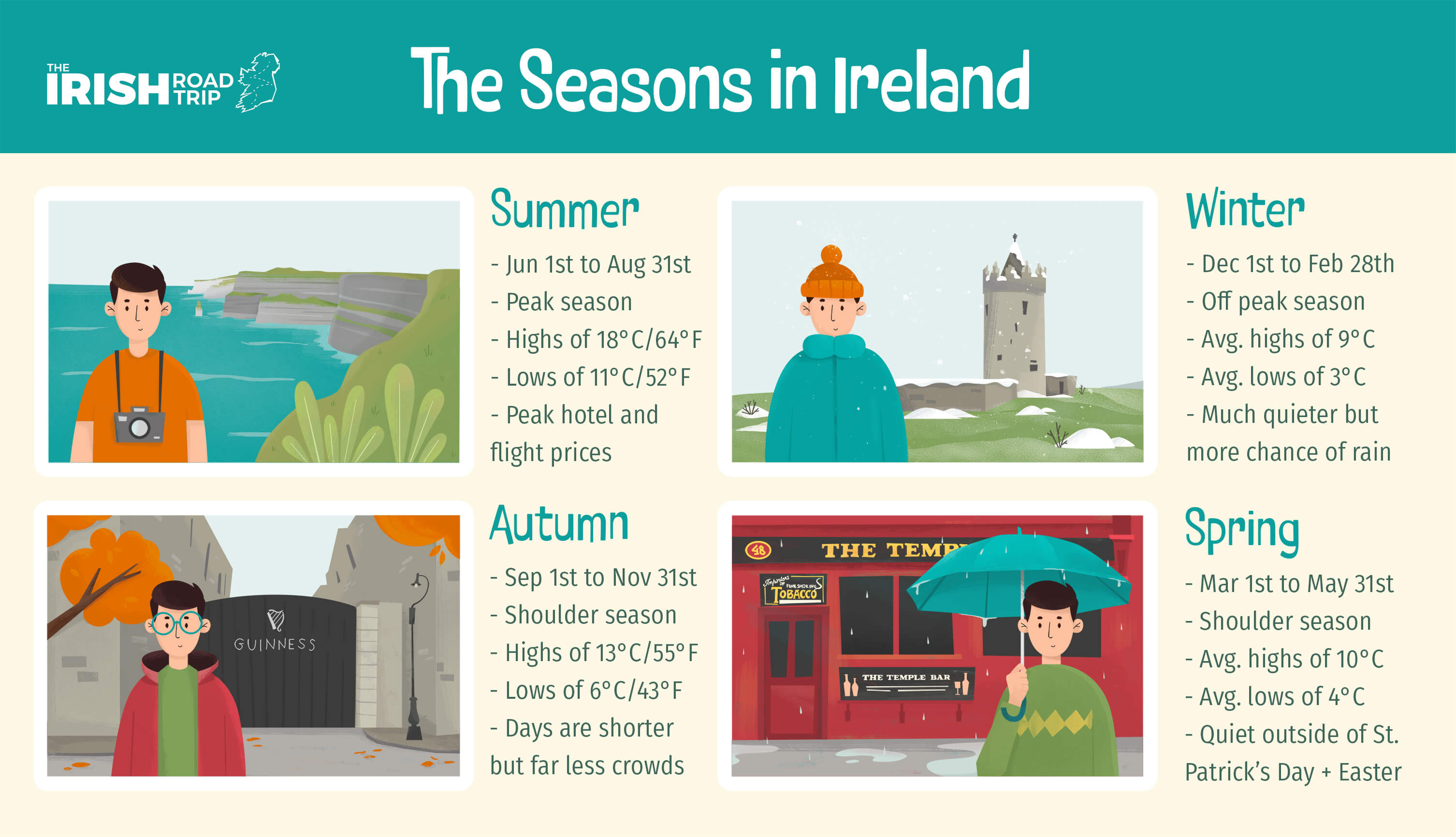
Click to enlarge image
Yes, you heard correctly – the weather in Ireland is a little bit nuts.
If you’re thinking, ‘Sure, I’m visiting in June – I’ll just pack shorts and t-shirts – it’ll be grand’ , think again.
Summer in Ireland can go from dry and toasty one minute to cold, wet and windy the next.
One of the best travel tips that I can give you if you’re visiting Ireland is to pack for every kind of weather.
If you’re traveling to Ireland during the summer months, make sure to bring summery clothes, but also pack a light rain jacket and a warm hoody or cardigan.
8. Layers are your friend
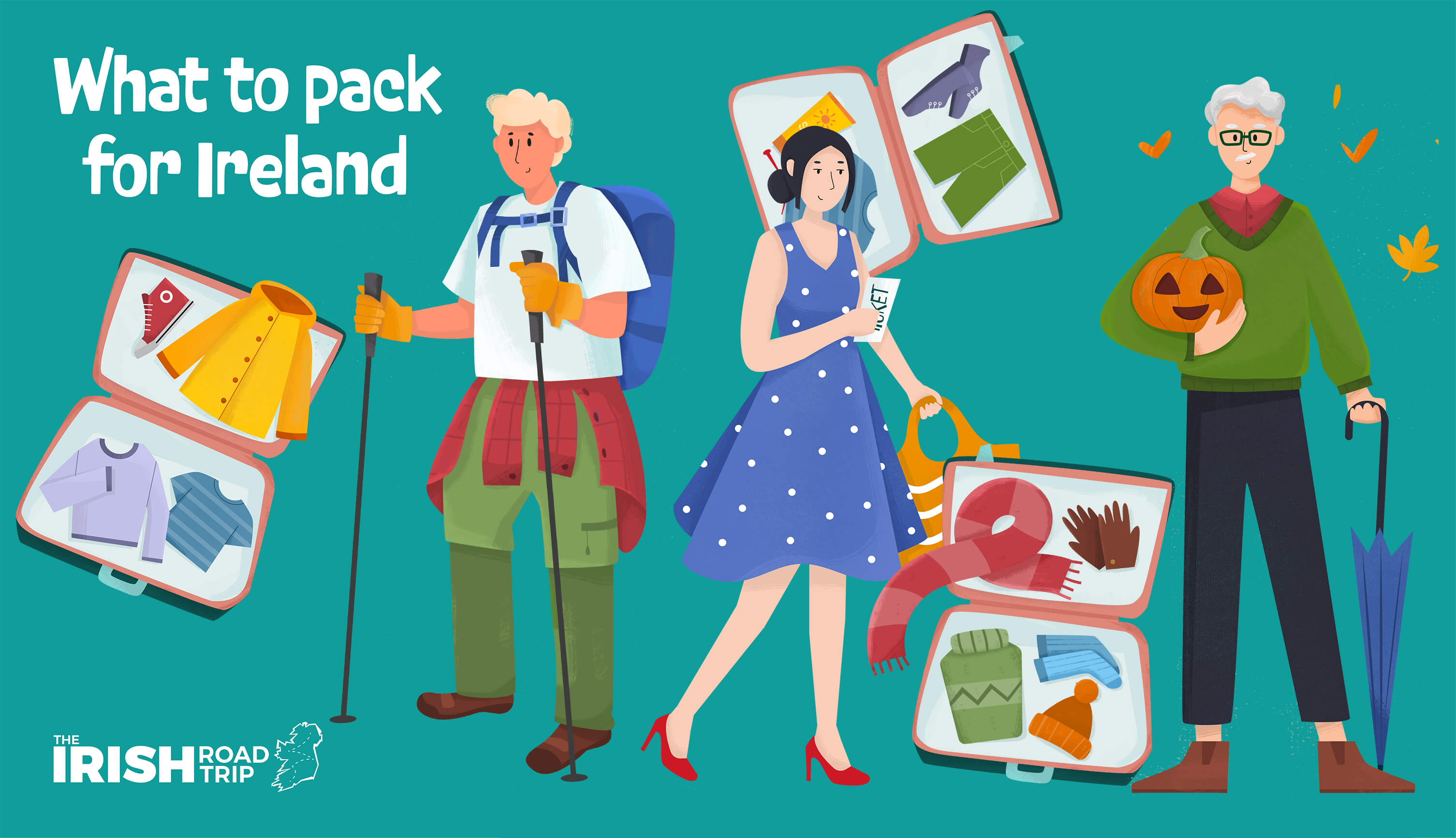
Many people visiting Ireland make the mistake of packing for the season, e.g. bringing only shorts and t-shirts during summer in Ireland .
One of the more useful what not to do in Ireland travel tips is to assumer that Irish seasons act as they should.
In our guide on what to wear in Ireland , you’ll find info on what you should bring for each season – in a nutshell, layers are always needed.
9. Some visitors can shop VAT-free
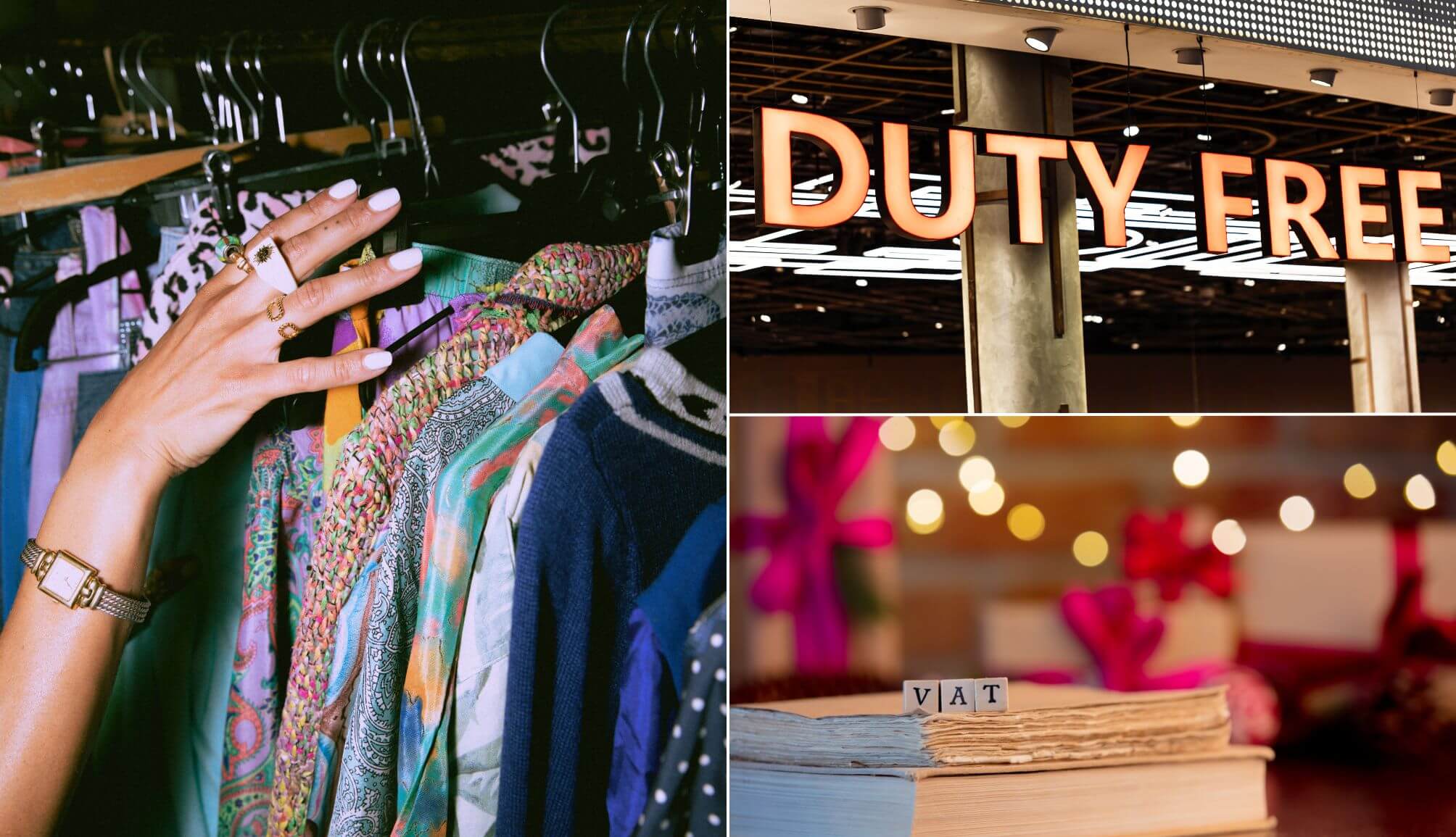
Bottom left: Massonstock. Top right: simarik. Left: Corelens (Canva)
If you’re traveling to Ireland from a non-EU country, you’re entitled to a VAT refund on eligible purchases made during your visit.
Now, it’s worth noting that this doesn’t apply to things like hotels, food or car hire.
In fact, it’s intended to only apply to items that you can carry home in your hand luggage.
In our guide to claiming a VAT refund after traveling to Ireland, you’ll find out everything you need to know.
10. Driving in Ireland requires adequate preparation
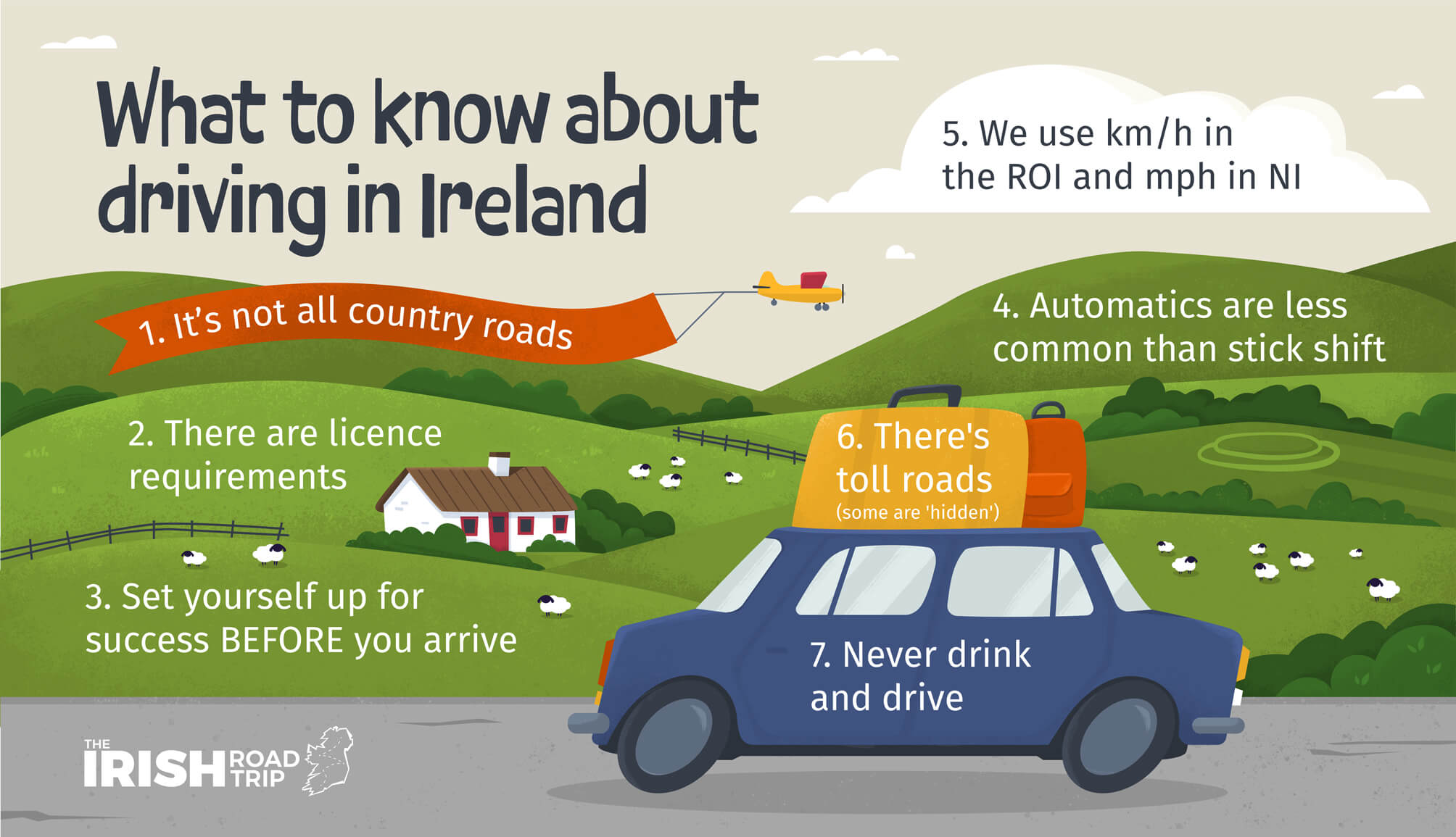
Many people driving in Ireland for the first time do absolutely zero preparation in advance of arriving.
Then they get here and panic.
Especially when they reach the likes of Conor Pass (a narrow mountain road on the Dingle Peninsula ) or sections of the Ring of Kerry .
I’d strongly recommend taking time to understand the rules of the road in Ireland along with how to navigate roundabouts.
Yes, it’s a boring task, but it’s only you’ll thank yourself for when you get behind the wheel. Few Ireland travel tips are as useful as this one.
11. Currency converting ‘stores’ generally have the worst rates
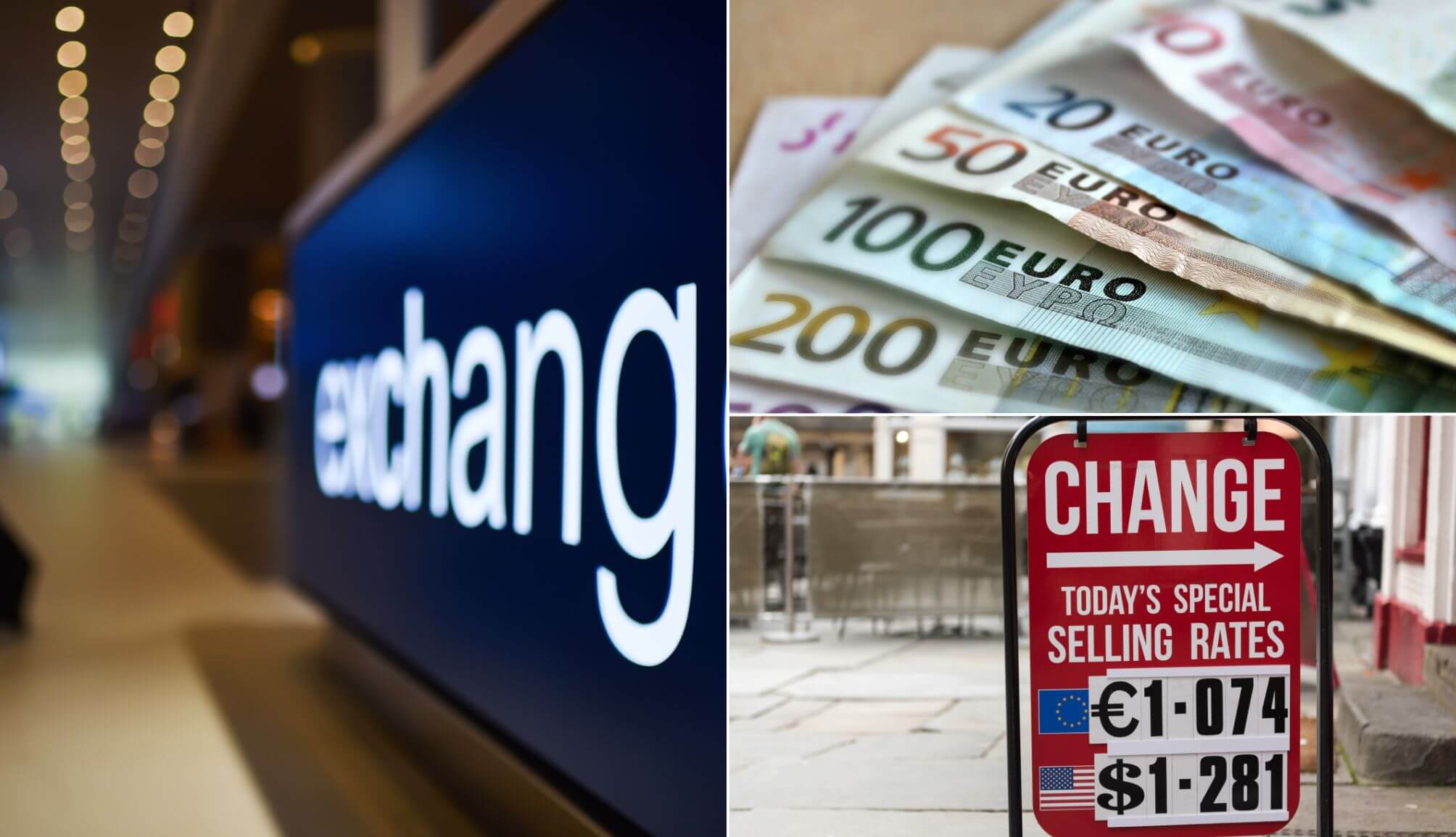
Left: Oleksandr Filon. Top right: martaposemuckel. Bottom right: 400tmax (Canva)
This is one of the more obvious visiting Ireland travel tips – if you convert money via currency exchange providers you’ll be hit with a hefty fee.
You’re generally better off just leaving the Dollars in your bank account and then withdrawing for an ATM when you arrive (there are plenty of them).
Or, if you’re using something like a Revolut or Wise credit/debit card, they tend to get you a good rate.
12. Don’t be fooled into thinking the only airport in Ireland is in Dublin
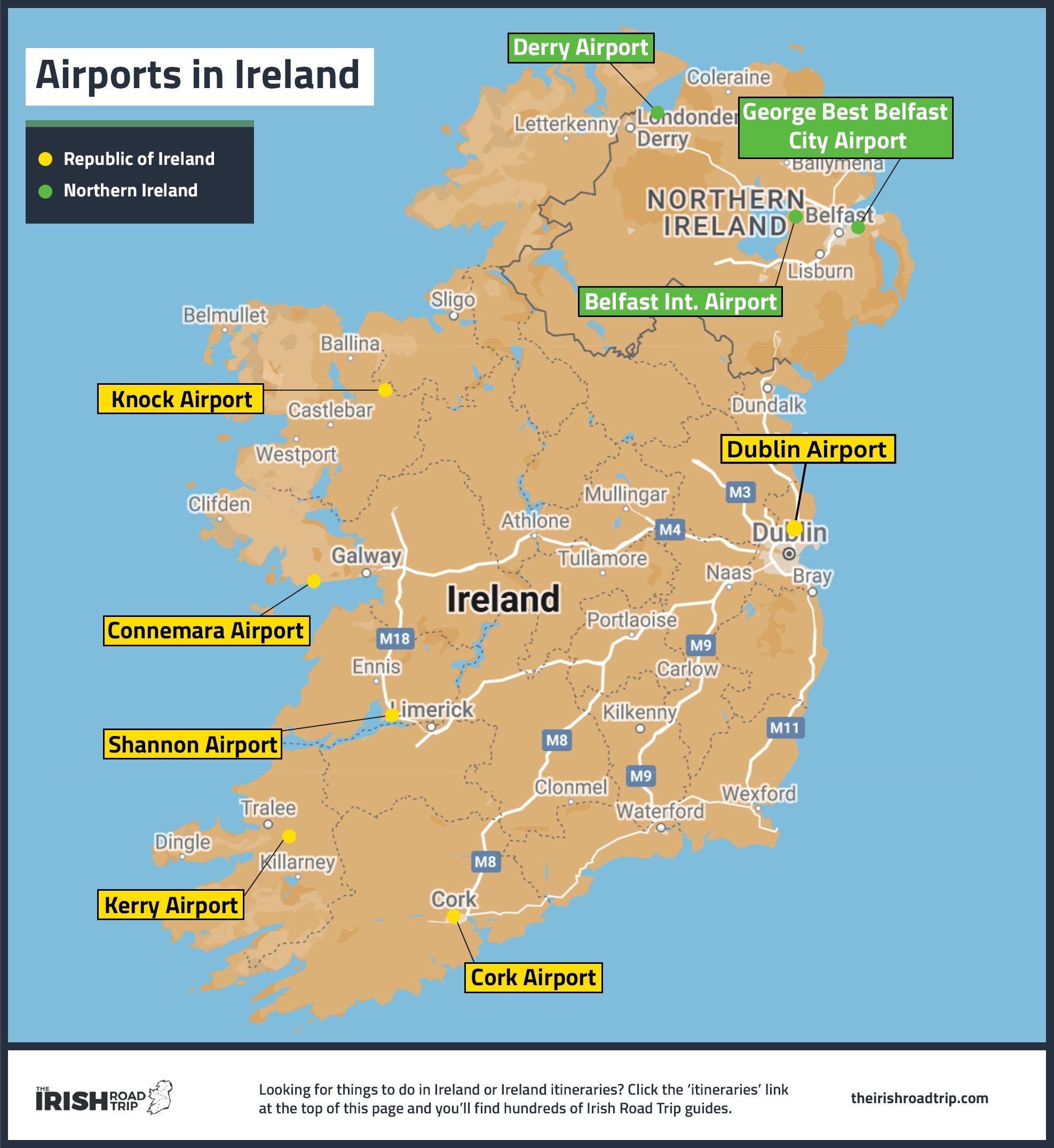
Yep, there are several airports in Ireland that you can fly into, depending on your departure point.
Now, you’ll remember that the first of our tips for traveling to Ireland was to plan your itinerary before booking anything .
One of the reasons for this is that picking what airport you fly into will have a massive effect on your itinerary.
For example, if you fly into Shannon (Clare) you’ll be finely placed to tackle the Wild Atlantic Way from the moment you leave arrivals.
If you land in Belfast, you can get onto the Antrim Coast Road in under an hour. This is another of the Ireland travel tips I find myself repeating over and over.
13. We don’t have a ‘US Style’ tipping culture in Ireland
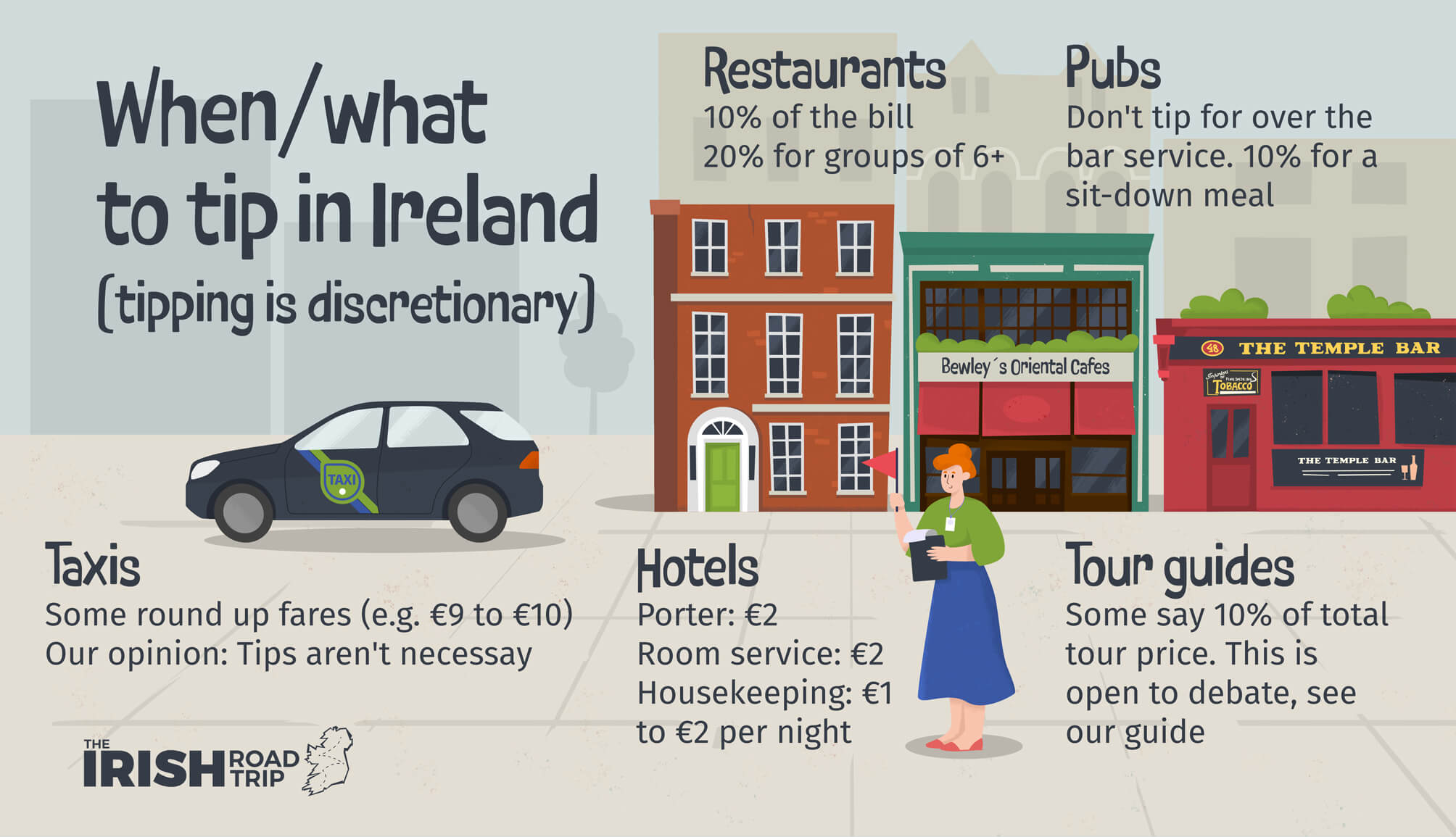
Many guides on Ireland travel tips spread wrong info about tipping in Ireland , stating that it’s seen as rude if you don’t tip everyone from the bartender to the staff in your hotel.
In Ireland, aside from in places that serve you food (table service only), tipping isn’t customary.
Is it appreciated? Sure!
However, there isn’t a tipping culture in Ireland like there is in the USA and Canada.
14. Be aware of the various laws in Ireland before you arrive
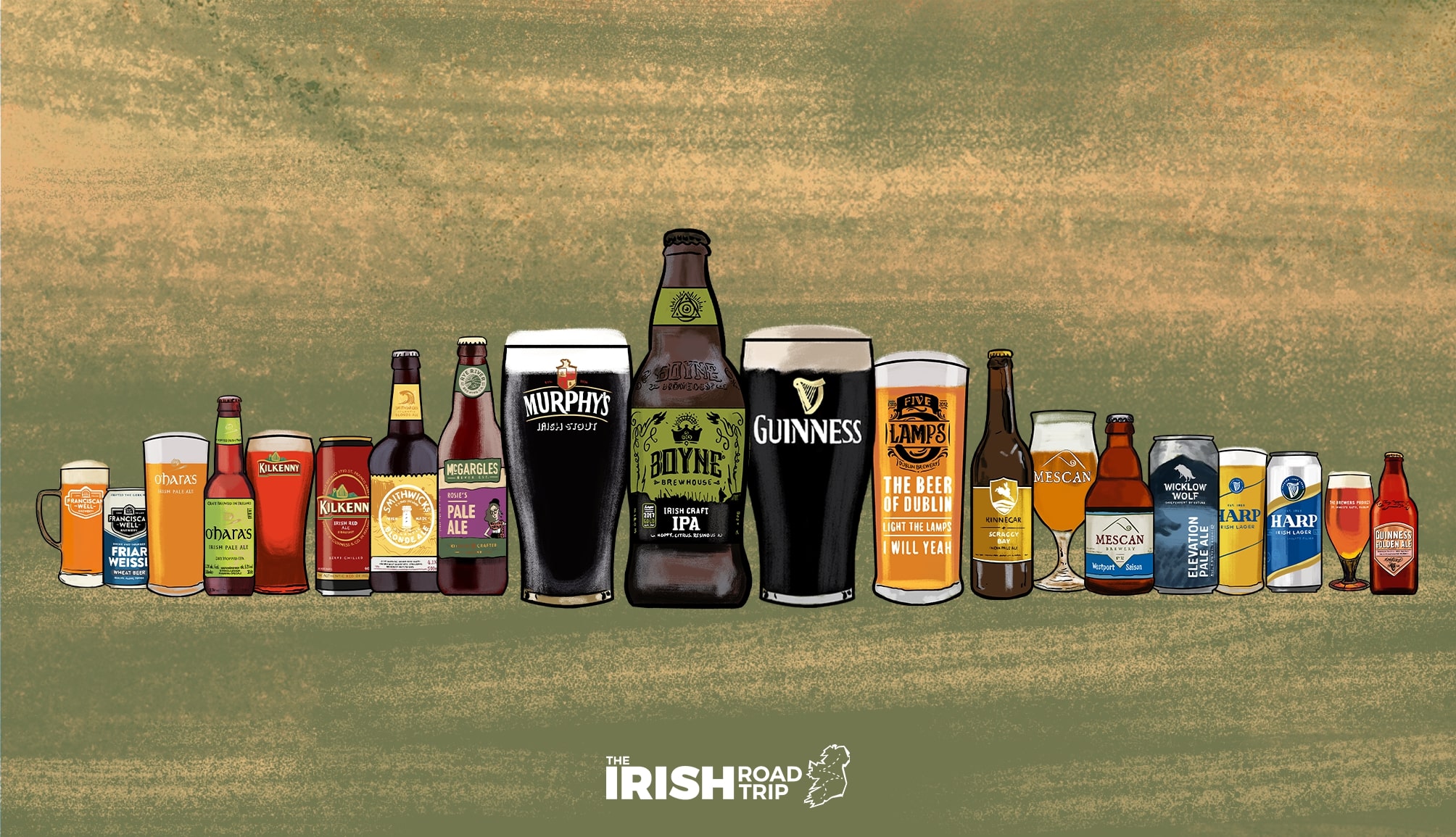
Unsurprisingly enough, there are numerous laws in Ireland that you need to be aware of in advance of your visit.
Now, most of them are common sense.
However, others, like the smoking ban, can catch people out.
That and the fact that there are many Irish drinking laws , from not drinking in public to the age that you can legally drink from.
Related read: We’ve published the world’s largest free collection of self guided driving tours of Ireland
15. It’s possible to do Ireland on a budget, but you may need to leave out certain places

The cost of a trip to Ireland has been going up-and-up in recent years.
However, doing Ireland on a budget is still possible – it just requires a lot of advanced planning.
One of the more useful tips for traveling to Ireland on a budget is to use the likes of Skyscanner to track the price of flights.
Then, when they reach a price you’re comfortable with, pounce!
You’ll also likely need to dodge some of the cities in Ireland , like Dublin, as that’s where accommodation prices have reached unreasonable levels.
16. Make a copy of your passport and bring it with you
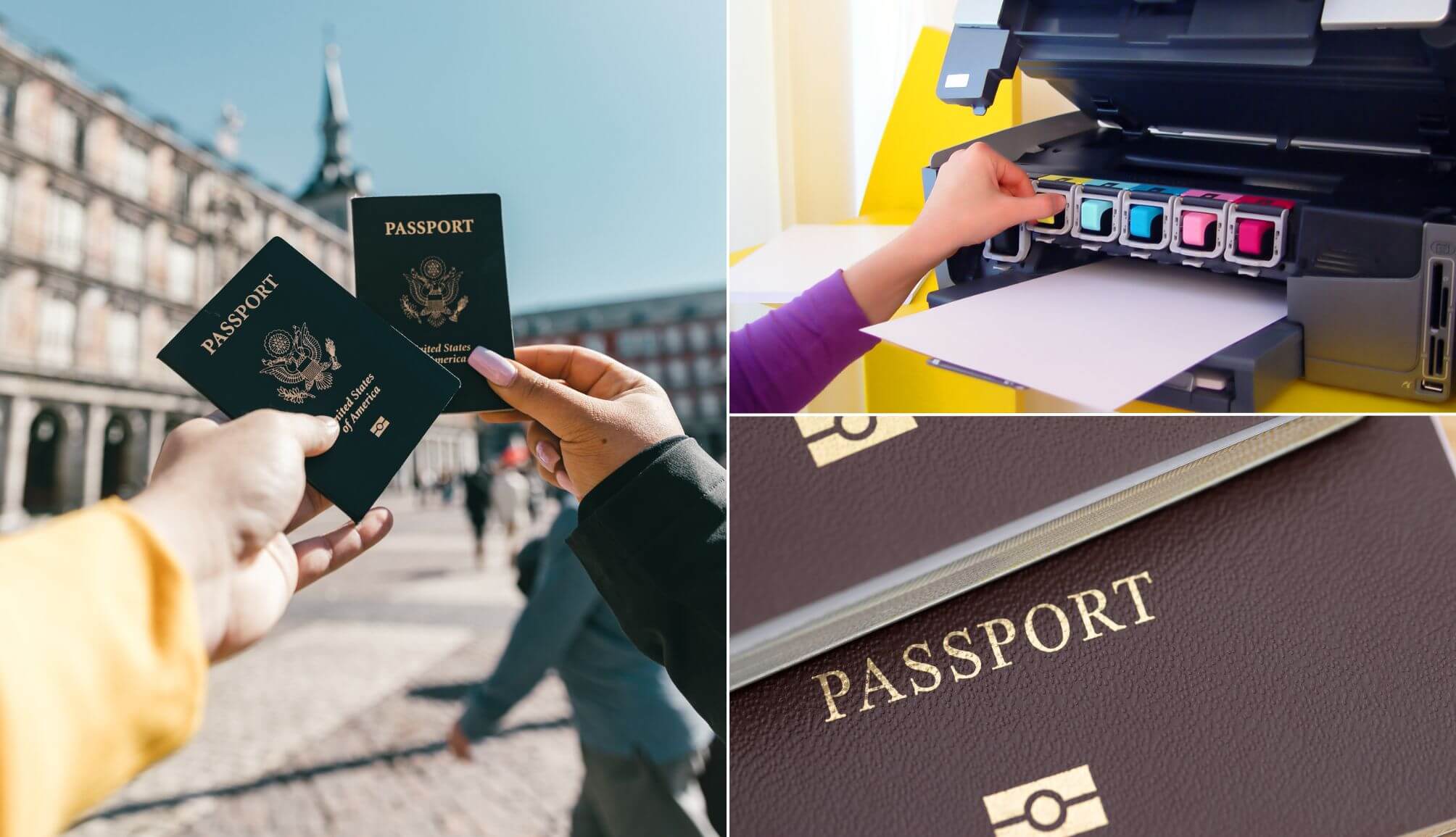
Photo left: Spencer Davis. Top right: by_nicholas (Canva)
This is one of the more basic Ireland travel tips, and you likely won’t need to use it.
However, if you ever do, you’ll thank yourself for it.
Personally, I have a digital copy of my passport stored on my phone and I have a folder with three copies of my passport that I leave in my backpack.
That way, if anything were to happen, you’ll make life an awful lot easier.
17. Irish slang and humour can be tricky to get your head around
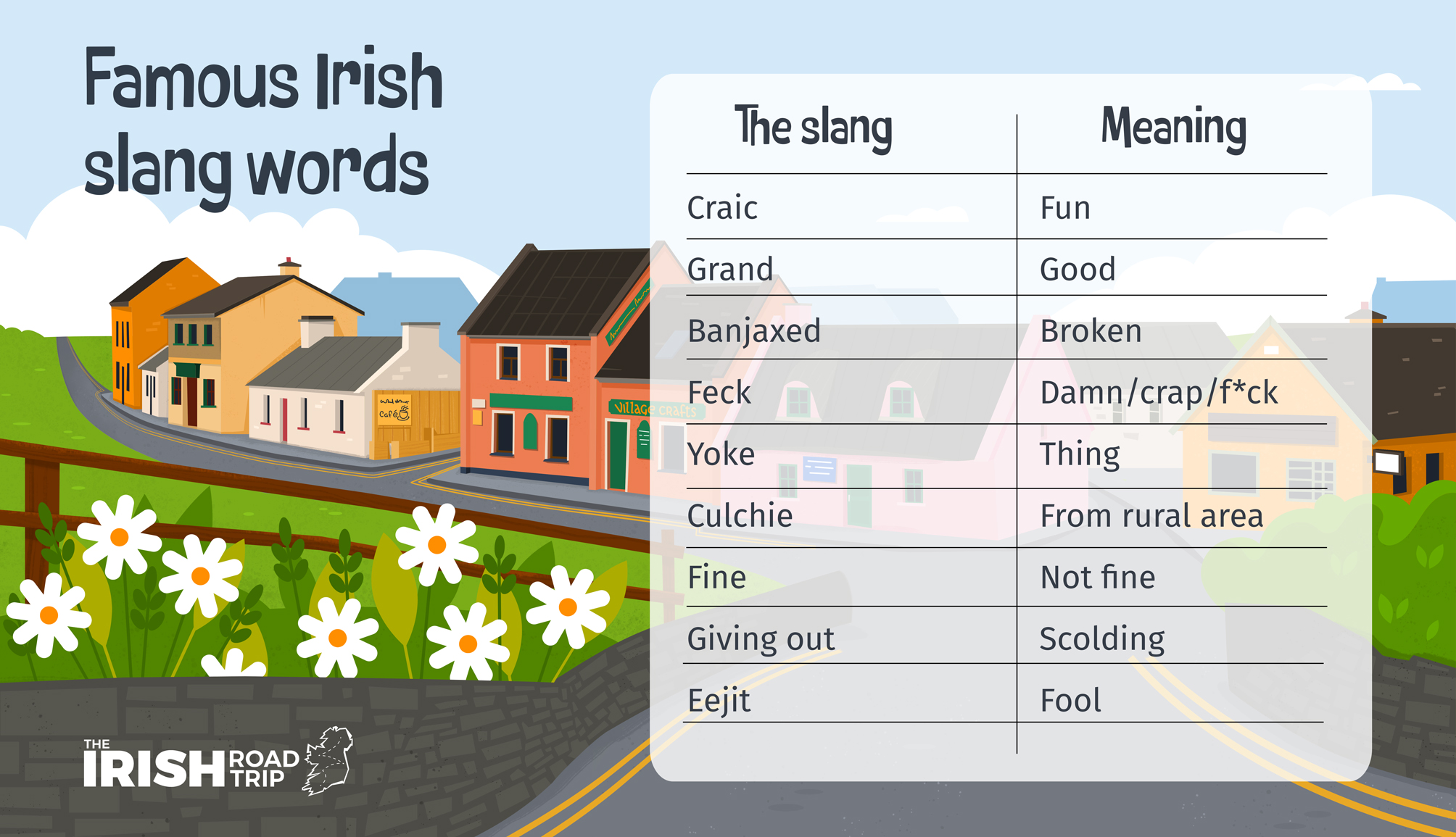
Irish slang words and Irish curses are part of everyday life in Ireland.
The tricky thing is, however, that different parts of the country have different slang terms.
There’s obvious ones, like ‘the Craic’ (i.e. ‘fun’) but there’s less obvious terms, like referring to ‘Yer one’ and ‘Yer man’.
If you’re confused during a conversation, ask the person to clarify what it is they said – it’s rare you’ll meet someone that won’t help you understand a bit of slang.
Related read: In need of a giggle? See our guide to the funniest Irish jokes
18. Always opt to visit traditional-style pubs over modern cafe bars
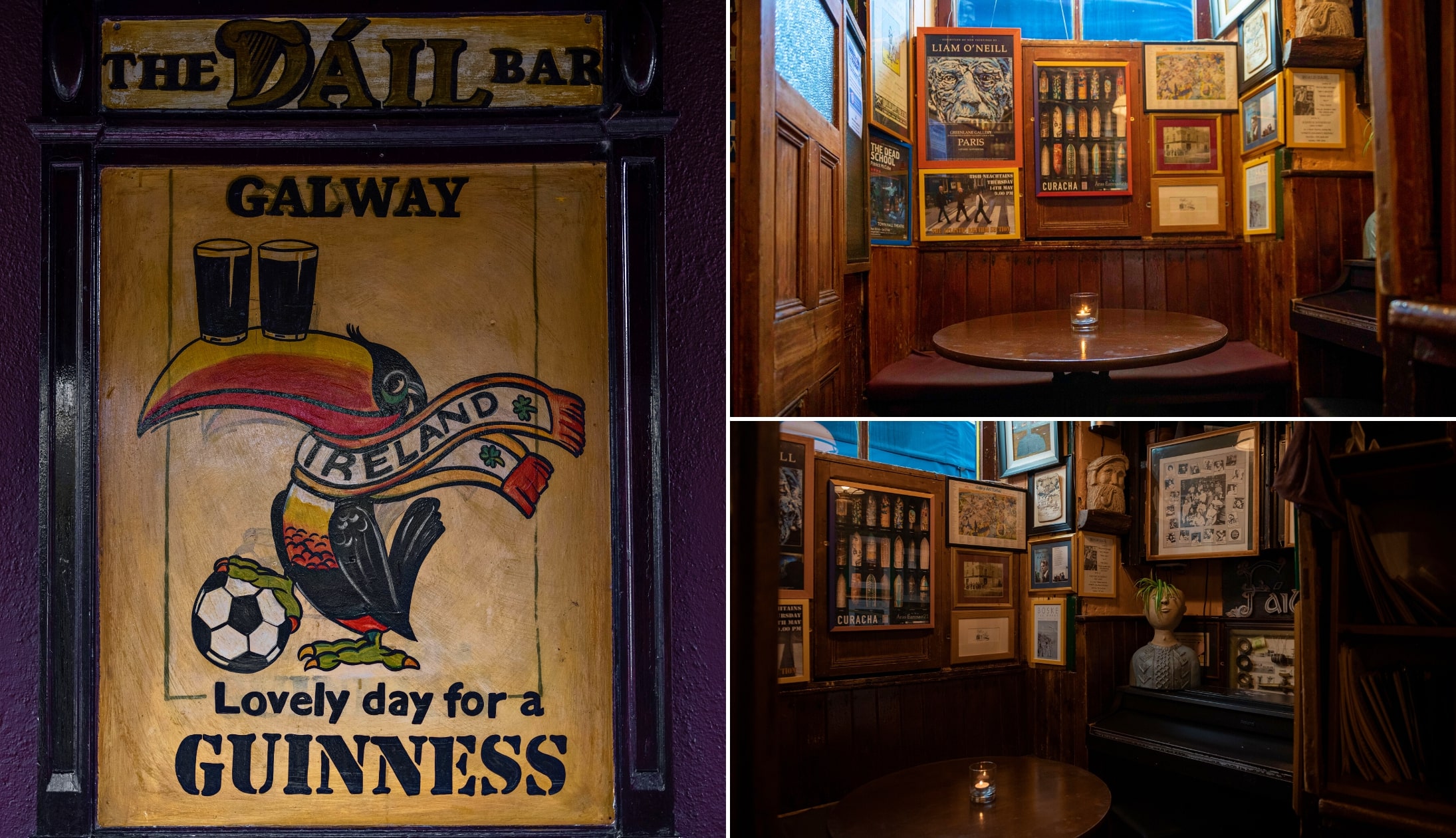
Photos courtesy Failte Ireland
There’s endless pubs in Ireland , however, not all are equal.
There’s traditional pubs and there are modern pubs and you’ll always, in our opinion, want to opt for traditional.
Traditional Irish pubs are ones that have stood the test of time and that boast a charm and character that you won’t encounter anywhere else in the world.
19. Limit the time you spend in Dublin to 2-3 days max
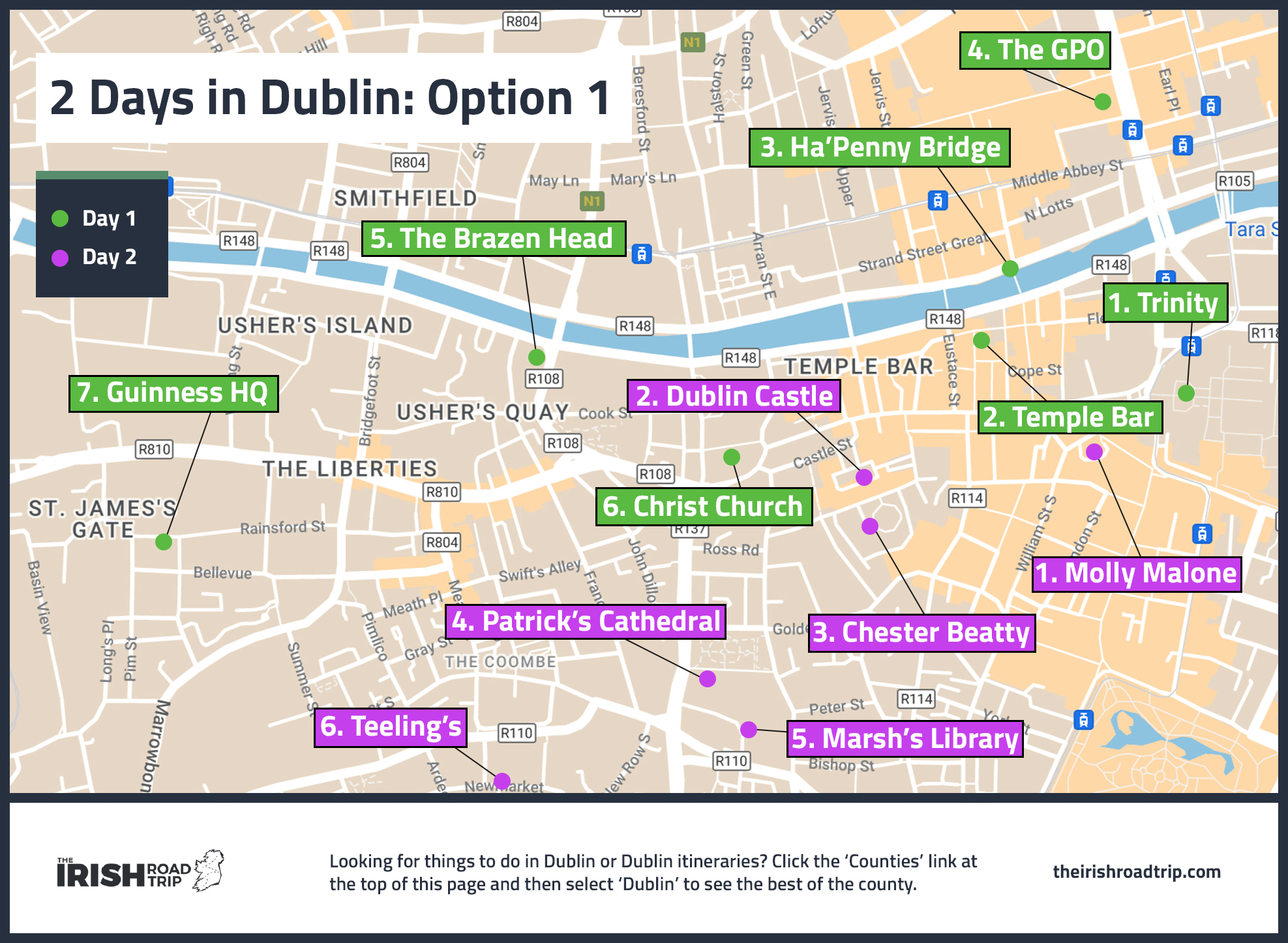
Although there’s plenty of things to do in Dublin , don’t spend more than 2-3 days max there (see our guides to 2 days in Dublin and 24 hours in Dublin ).
Many people fly into Dublin and then spend 5 days to a week there, but it’s far too much (unless you’re doing day trips to Wicklow, Meath and Kilkenny).
When visiting Dublin it’s worth using the likes of the Dublin Pass , which will save you cash if you’re visiting the main attractions, like the Guinness Storehouse and the Jameson Distillery.
Related Ireland travel tips: The Heritage Card is similar to the Dublin Pass in that it’ll get you into multiple fee-paying attractions for a single fee
20. Don’t just stick to the main tourist track

Photos via Shutterstock
Go and visit the Cliffs of Moher , the Giant’s Causeway and all of the other tourist favourites (if you want to, that is) – but make a conscious effort to step off the beaten path.
It’s only when you do this that you really start to discover how mighty our little island really is.
Places like the Beara Peninsula in Cork, the North Mayo coast and the Mourne Mountains in Down tend to get left off of many Ireland itineraries.
Which is a shame. As it’s in these lesser-known/visited corners of Ireland that you’ll discover how powerful the combination of natural beauty and peace and quiet can be.
21. There’s more to Irish culture than drink (and there’s more to tradition than Paddy’s Day)
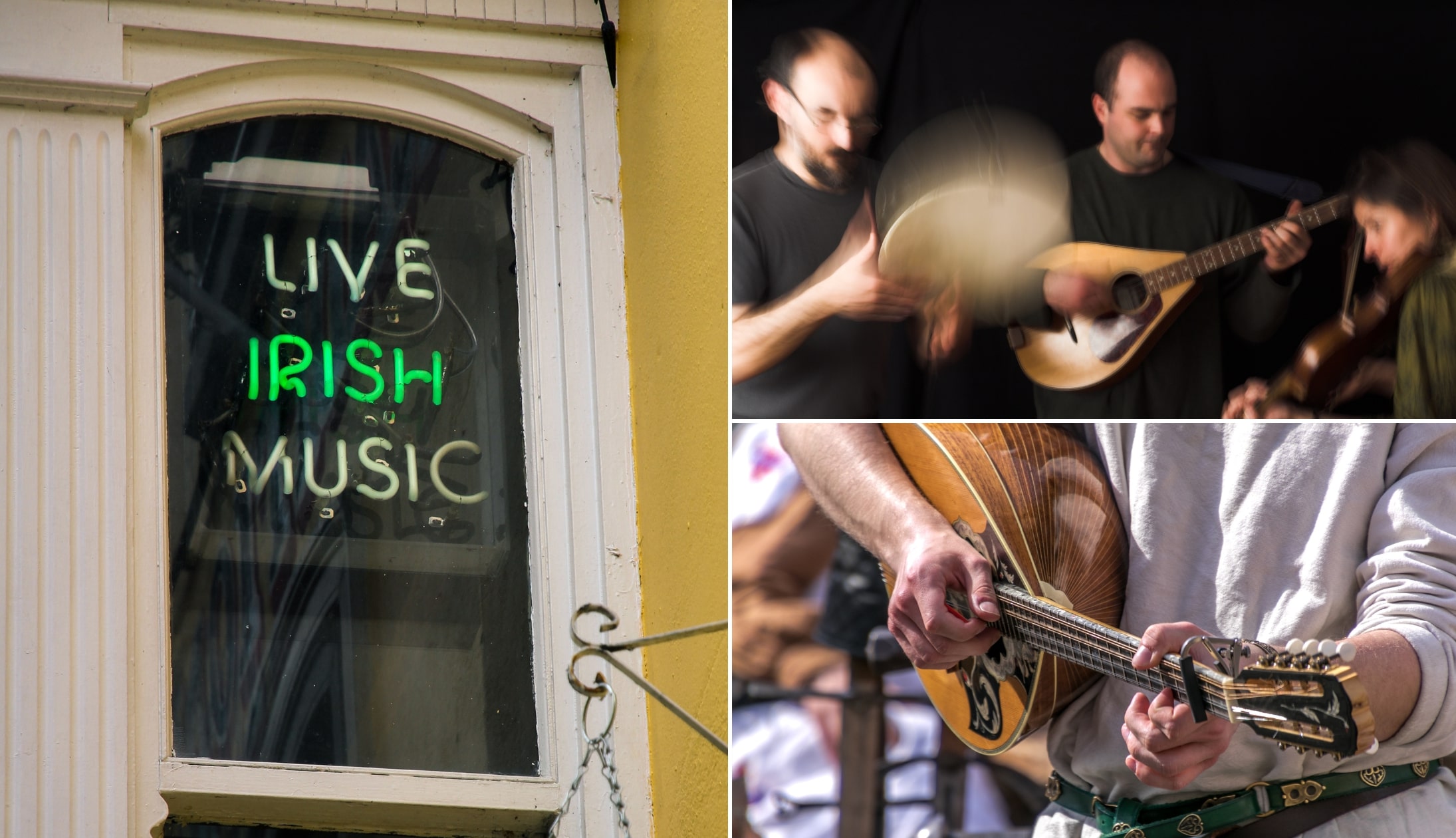
Many people looking for tips for traveling to Ireland never really ask about Irish culture or Irish traditions .
Ireland’s culture has benefited from sport, music, literature, art, language, storytelling (see our section on Irish mythology ), farming and food and you should try and experience as much of it as you can during your visit.
Similarly, traditions stem far beyond St. Patrick’s Day – there’s countless ancient festivals in Ireland , many of which take place outside of the busy summer months, that are worth a visit.
Frequently asked questions
We’ve had a lot of questions over the years asking about everything from ‘Do I need cash?’ to ‘What are no-go areas?’.
In the section below, we’ve popped in the most FAQs that we’ve received. If you have a question that we haven’t tackled, ask away in the comments section below.
What do I need to know before traveling to Ireland?
Northern Ireland and the Republic of Ireland are two separate countries on the one island (and thus have differences), the weather is a little bit crazy and a well-planned trip itinerary is worth its weight in gold.
What are some essential Ireland travel tips?
Plan your itinerary before you book anything, prepare for 4 seasons in one day, choose the right time to visit based on how you like to travel/your budget and determine what mode of transport suits your travel style.
How do I not stick out in Ireland?
Although we’d argue that there’s no fun in just ‘blending in’, if you’re looking to avoid standing out, how you dress and how you conduct yourself in public places are key.
Keith O’Hara has lived in Ireland for 35 years and has spent most of the last 10 creating what is now The Irish Road Trip guide. Over the years, the website has published thousands of meticulously researched Ireland travel guides, welcoming 30 million+ visitors along the way. In 2022, the Irish Road Trip team published the world’s largest collection of Irish Road Trip itineraries . Keith lives in Dublin with his dog Toby and finds writing in the 3rd person minus craic altogether.
This site uses Akismet to reduce spam. Learn how your comment data is processed .

Ireland Vs Northern Ireland: Which Should You Visit & Why?
Quick links, brief information about ireland, why visit ireland, what to know about northern ireland, why you should visit northern ireland.
People often mix up these two countries - Northern Ireland and Ireland. Some even use the word “Ireland” to describe both countries. This can be confusing as they are separate countries, with each offering its unique experiences. Both countries are located on one island and share a common boundary, but while Northern Ireland is part of the United Kingdom, Ireland is separated from the United Kingdom. In many ways, both countries are similar.
They have stunning natural landscapes, historic attractions, and vibrant cultures. But despite being similar in name and offerings, each still has something unique that can be a major deciding factor for travelers. Without further ado, here’s a face-off between both countries to help travelers make the best choice.
- Other Name: The Republic of Ireland
- Capital and Largest City: Dublin
- Area: 70,272 square kilometers (27,133 square miles)
- Population: Approximately 5.1 million as of 2022
- Head of State: President
- Currency: Euro (€)
The Republic of Ireland , most commonly known as Ireland, is a country in North Western Europe surrounded by the Atlantic Ocean. It is the largest and most populated of the two countries that share the Island of Ireland, and its capital Dublin is among the most beautiful capital cities in the World .
In January 1801, the Republic of Ireland came under British rule and remained under the monarchy for more than a hundred years until December 1922, when it declared its independence. Today, it is one of the wealthiest and most developed countries in the world, with one of the highest qualities of life.
There are so many reasons Ireland is worth visiting over Northern Ireland. In terms of size, it beats Northern Ireland by a wide margin which means there are more destinations to visit in this country and more amazing experiences travelers will get to make here.
Below are some more strong reasons travelers will want to visit Ireland:
- Ireland Has Strong Love For Food and Drink: Ireland is one of the best places in the world to enjoy an unforgettable food and drinking experience. There are so many delicacies to try here as well as so many drinks. Dublin - the country’s capital city, is the birthplace of the world-famous Guinness Stout and there is a Guinness storehouse in the city where one can enjoy delicious food and liquor while learning about the history of Guinness. Ireland is also one of the countries with the most pubs in the world, and that’s just one more thing reason it is the perfect destination for foodies and lovers of drinks.
- More Cities, Towns, and Villages: As the largest of the two countries, Ireland is home to more cities, towns, and villages, which therefore means it has more destinations for travelers to visit. Just a few of the country’s beautiful towns and villages are even enough to make one want to visit.
- It Is Home To Several Historic Sites: Lovers of history and archaeology will be satisfied in Ireland as the country is home to a lot of historical sites. Newgrange - one of the country’s most popular historic sites, is about 5,200 years old , which makes it older than the Great Pyramids of Giza and Stonehenge.
- Lots of Castles: Ireland is one of the countries with the most castles in the world. One can hardly travel a few miles without getting to see one or more impressive castles. Some popular castles one will find in this country include - the Rock of Cashel, Blarney Castle, Burnratty Castle, and Dublin Castle, but there are many more. Ireland even has castles that allow visitors to stay the night .
- Impressive Natural Attractions: One of the most appealing features of Ireland is the long list of natural attractions that can be found in the country. Here, one will find amazing things like - the Cliffs of Moher, the Wicklow Mountains, the Ring of Kerry, and many more. Besides being incredibly beautiful, these natural attractions also offer lots of opportunities for adventures.
Before proceeding, here are some interesting facts about Ireland that will make every traveler want to visit .
Related: Seeing Ireland Just Got Easier And More Exciting With These Tours
- Capital and Largest City: Belfast
- Area: 14,130 square kilometers (5,460 square miles)
- Population: Approximately 1.9 million as of 2021
- Head of State: King Charles III
Northern Ireland is a country on the northeastern part of the Island of Ireland. It makes up only about 16.75% of the total area of the Island of Ireland and contains about 27.1% of the island’s total population. The country was created in 1921 when Ireland was divided into two self-governing polities, and it is currently part of the United Kingdom. Unlike its sister country, Northern Ireland combines the culture of the UK and that of Ireland to make its own unique and interesting culture.
Although smaller than its sister country, Northern Ireland is no less appealing. The country has nearly everything its counterpart has and even some unique things that will make travelers visit it instead. Northern Ireland is also a little more relaxed and diverse as its culture is a combination of Scottish, English, and Irish cultures. This makes the country more open-minded and easy to blend into. The Gaelic accent in many parts of Northern Ireland is also not as thick as it is in the Republic of Ireland, which makes communication less difficult for foreigners.
Below are some more reasons why Northern Ireland is the best destination for travelers:
- It is home to so many natural wonders : Northern Ireland may not be big, but it has some of the most awe-inspiring natural wonders in the world. The Giant’s Causeway - the country’s most famous natural attraction is not just physically stunning but is also associated with a myth that makes it one of the most mythical places in the world . More natural attractions that can be found in Northern Ireland include - the Mourne Mountains.
- Lots of castles: Castles in Northern Ireland are some of the most impressive in the world. Dunluce Castle - one of the country’s most popular castles is so stunning that it has even been used in popular movies like the Game of Thrones series. Some other interesting castles worth checking out in Northern Ireland include - the beautiful Belfast Castle, Dunseverick - one of the oldest castles in the world, and the 12th-century Carrickfergus Castle.
- It is home to Derry: Derry is one of the most impressive old-walled cities in the world. The walls of the city were built in the 17th century, and they still stand to date. One more thing that makes the city even more interesting is that the walls have never been breached, and this has given rise to the city’s nickname - “the maiden city.”
Travelers fascinated by walled cities can also check out these cities in Europe that still have walls .
Related: Visit Hillsborough Castle: The Royal Residence Of Northern Ireland
So Which Should You Choose?
The answer to this question depends on the travelers involved and what their preferences are. Both countries have natural and historic attractions to offer but it is worth noting that Northern Ireland does not offer the kind of amazing eating and drinking experience that Ireland offers. Again, Ireland has twice as many destinations as Northern Ireland, which means there are more experiences to be made here.
Northern Ireland, on the other hand, is the best place for travelers who want a more diverse place where they can easily fit in and meet people from all over the UK. Its smaller size and population also make it perfect for travelers who have little time and want a more intimate Irish experience.
Remember that Northern Ireland also offers great eating and drinking experiences, and it also has natural and historic attractions like Ireland. The only difference is in the volume or quantity.
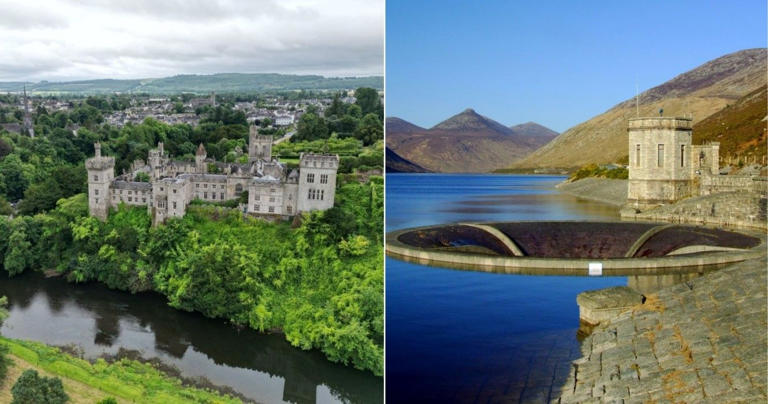
Cookies on GOV.UK
We use some essential cookies to make this website work.
We’d like to set additional cookies to understand how you use GOV.UK, remember your settings and improve government services.
We also use cookies set by other sites to help us deliver content from their services.
You have accepted additional cookies. You can change your cookie settings at any time.
You have rejected additional cookies. You can change your cookie settings at any time.
Bring photo ID to vote Check what photo ID you'll need to vote in person in the General Election on 4 July.
- Passports, travel and living abroad
- Travel abroad
Taking your pet dog, cat or ferret abroad
Travelling to an eu country or northern ireland.
When travelling to an EU country or Northern Ireland, your pet needs:
- a microchip
- a valid rabies vaccination
- an animal health certificate , or a valid pet passport that’s accepted in the country you’re travelling to
- tapeworm treatment for dogs if you’re travelling directly to Finland, Ireland, Northern Ireland, Norway or Malta
These requirements also apply to assistance dogs.
Check the rules of the country you’re travelling to for any additional restrictions or requirements before you travel.
If you have a pet passport
You cannot use a pet passport issued in Great Britain (England, Wales and Scotland).
You can only use a pet passport if the country you’re travelling to accepts passports for pets coming from Great Britain. The passport must have been issued in one of the following places:
- an EU country
- Faroe Islands
- Liechtenstein
- Northern Ireland
- Switzerland
- Vatican City State
You should check if it’s accepted before you travel and find out if you need any other supporting documents .
If it is not accepted, you’ll need an animal health certificate instead.
Travelling from Great Britain to Northern Ireland
If you have a pet passport issued in Northern Ireland, contact your vet for advice before travelling.
Read the rules about taking pets to Northern Ireland on the NIDirect website before you travel.
Arriving in an EU country or Northern Ireland
You’ll need to go through a travellers’ point of entry when you arrive in an EU country or Northern Ireland.
You may need to show your pet’s animal health certificate or a valid pet passport, containing proof of their:
- rabies vaccination
- tapeworm treatment (if required)
Repeat trips to an EU country or Northern Ireland
Your pet will need a new animal health certificate for each trip to an EU country or Northern Ireland.
Your pet will not need a repeat rabies vaccination so long as its rabies vaccinations are up to date.
Your dog will need tapeworm treatment for each trip if you’re travelling directly to Finland, Ireland, Malta, Northern Ireland or Norway.
Travelling with more than 5 pets
You cannot take more than 5 pets to an EU country or Northern Ireland unless you’re attending or training for a:
- competition
- sporting event
You’ll need written evidence of registration for the event when you travel.
All your pets must:
- be attending the event or training
- be over 6 months old
- meet all the other requirements for pet travel to that country
Exporting pets for commercial purposes
Read the Border Operating Model if you want to export pets to an EU country or Northern Ireland for commercial reasons such as change of ownership.
Related content
Is this page useful.
- Yes this page is useful
- No this page is not useful
Help us improve GOV.UK
Don’t include personal or financial information like your National Insurance number or credit card details.
To help us improve GOV.UK, we’d like to know more about your visit today. Please fill in this survey (opens in a new tab) .

IMAGES
VIDEO
COMMENTS
Tour Ireland With The Top-Rated Irish Travel Agency. Plan The Perfect, Authentic Trip To Ireland. Request Your Free Custom Itinerary Today!
Overwhelmed by vacation options? Don't waste time and money on subpar experiences. Relax and let our local experts craft your vacation in Ireland. Learn more!
Plan your next giant adventure in Northern Ireland with trip inspiration and local tips. Explore wild coastlines, rural landscapes, buzzing cities, attractions, events and more.
Learn about the differences between Northern Ireland and the Republic of Ireland, the counties of NI, and the key things to do and see here. From Belfast to the Giants Causeway, from the Mourne Mountains to the Titanic Quarter, this guide covers it all.
Discover the best things to do in Northern Ireland, from the Giant's Causeway to Titanic Belfast. Find attractions, activities, articles, guidebooks and more to plan your trip with Lonely Planet.
Getting to and around Northern Ireland is really easy. We've got international and domestic airports, a motorway network that links with the Republic of Ireland's, trains, buses, cycle paths, walking trails, canals…you get the picture, so get the inside track with our guides. Find lots of information to help you below.
Get information on Northern Ireland Travel Guide - Expert Picks for your Vacation hotels, restaurants, entertainment, shopping, sightseeing, and activities. Read the Fodor's reviews, or post your own.
Learn how to plan your trip to Northern Ireland with tips, things to see and do, and budgeting advice. Explore the stunning scenery, culture, and history of this part of the UK.
View Maps and Visitor Guides. Find the best places to visit in Northern Ireland. Antrim is famous for the ethereal Giant's Causeway and the iconic Dark Hedges. Londonderry is celebrated for its historic city walls and Halloween Festival. Down is known for the stunning Mourne Mountains, while Fermanagh boasts serene lakes and waterways.
surangaw / Getty Images. The best way to arrive in Northern Ireland for your week-long vacation is to fly directly into Belfast International Airport.Most flights arrive during the day, meaning you will have enough time to pick up your rental car and make your way to Northern Ireland's capital city, Belfast.The airport is actually located near Lough Neagh and you should expect at least 30 ...
2 Rathlin Island is Northern Ireland's only inhabited offshore island, reached by a short ferry ride. 54.166667 -6.083333. 3 Mourne Mountains are criss-crossed by tracks past woodland up to the peaks: Slieve Donard at 852 m / 2796 ft is the highest in Northern Ireland. 54.618333 -6.395278.
3, 4 or 5 Days in Northern Ireland Itinerary. Without further ado, here is how to spend 3 to 5 days exploring Northern Ireland. This route is meant to be built upon each day so if you're only seeing Northern Ireland in 3 days, then plan to spend the first 2 in Belfast before heading onto the Causeway Coast. And if you're spending 4 days, it ...
Northern Ireland is an underrated and often overlooked region that surprises visitors with its striking scenery and urban vitality. While it shares an island with the Republic of Ireland, when you cross into Northern Ireland, you're crossing an international border into the United Kingdom (where you change stamps, phone cards, and money). Its coast boasts the alligator-skin volcanic geology of ...
Discover the best of Northern Ireland, from Belfast to the Causeway Coast, with tips on things to do, where to stay and what to eat. Learn how to rent a car, explore the Giant's Causeway, visit Dunluce Castle and more.
Northern Ireland Visitor's Guide Visitor's Guide. In peace, Northern Ireland has staked its rightful claim as one of the most beautiful, memorable and cultural regions to be found anywhere on the island of Ireland. Nowhere is Ireland's recent history more strongly felt than in the North, and any visit would be incomplete without uncovering this ...
Visit Hillsborough Castle and Gardens and discover Northern Ireland's royal residence. 48 Hours in Belfast. Experience the best things to do in Belfast in 48 hours. ... From information about getting to Belfast and travelling around the city to car parking, travel tips and guides to our ...
Welcome to our Northern Ireland Travel Guide where you will find links to all the travel-related posts about Northern Ireland on the website.This includes articles about itineraries, where to visit, what to see and do, best day trips, tours and tickets, books to read and lots of practical tips, resources and inspiration for your trip.
Gone - or certainly on its way out - is the image of a conservative, introspective, rural set of nations. The infamous unrest and violence, between the Republic (Éire) and Northern Ireland (as part of the United Kingdom), have faded away. An outward-looking Ireland has stepped forward, energised by cities no longer weighed down by the Troubles.
Northern Ireland at a glance. From the captivating cliffs of Donegal, to the monumental steps of the Giant's Causeway, the beauty of Northern Ireland is truly staggering. Join your expert Trafalgar Travel Director and explore the dramatic landscapes, gorgeous villages and ancient castles of this divine slice of the Emerald Isle. Currency.
Plan your Trip. We've lots of resources to help plan your next short break, including maps of Northern Ireland, information on getting here as well as advice on travelling around. This is a compact place which manages to pack a lot in, and planning in advance can help you make the most of your time here. Explore.
How to Book. Siobhan Byrne Learat, a member of T+L's A-List of top travel advisors, can orchestrate a journey across Northern Ireland that encompasses five-star hotels, walking tours of Belfast ...
14 Places To Visit In Northern Ireland. 1. Giant's Causeway, Co. Antrim. Giant Causeway, Image by Christine Rogador. Exquisite, dramatic, awe-inspiring. It's easy to run out of ways to describe the Giant's Causeway, but one will always find more reasons to go back.
Derry sailboat at night in Northern Ireland. #24 24:00 - Moonlight Kayaking (Derry) Last but not least, to wrap up this Northern Ireland travel guide, consider a moonlight kayaking experience. Not only is it a good workout but you'll also have an opportunity to spot wildlifeyou wouldn't otherwise see during the day.
A travel guide to the top things to do in Belfast Northern Ireland as well as suggestions on getting around, where to stay, and day trip ideas. Belfast is probably best known for Belfast Titanic (Titanic museum), street murals, and The Troubles, but there is a lot to do and see in Belfast. It also has a lively historic city center, the famous Titanic Quarter, fun pubs, excellent museums ...
The Travel Tester takes you to Northern Ireland for an epic road trip along all of the Game of Thrones Shooting Locations. Read More about Game of Thrones Shooting Locations in Northern Ireland: A Complete Overview Per Episode, with Map!
This guide contains Ireland travel tips that I've been passing on to first time visitors for 10+ years. Many guides with tips for traveling to Ireland consist of telling you to 'Ah, ... Now, there's no 'hard' border between Ireland and Northern Ireland - you can drive from one to the other without noticing. ...
Enable location access to get tailored travel tips for your current location. Your location is only used to show reccomendations. ... Your portable Ireland guide. ... S51-Airsoft Northern Ireland is a team game in which participants eliminate opposing players by tagging them out of play with spherical plastic projectiles shot with mock air ...
Northern Ireland and Ireland are similar in many ways, but each still has something unique to offer that can be a major deciding factor for travelers. Travel news TheTravel
When travelling to an EU country or Northern Ireland, your pet needs:. a microchip; a valid rabies vaccination; an animal health certificate, or a valid pet passport that's accepted in the ...